Perfil do CMDR Jav Marlo > Diário

(Imperial Clipper)

DISTANT WORLDS 2 (PART 15) – EMBRACING THE SPACE MADNESS
21 APRIL 3305 Luna’s Shadow (Smootoae QY-S d3-202)
Resuming log. Well, I will be alone, but I must go on. One of the purposes of this stage of the expedition is the mapping survey of the regions called the Boreas Expanse: Boreas, Styx and the Bleak Lands. I am in the Boreas now, ready to cross the Styx, but there is a detour that could take me along a great sector of the Styx region. A huge detour.
There is a system called nowadays Rendezvous Point, that was the set for the first ever deep space encounter beyond the galactic core regions. Commander Erimus Kamzel and Commander R4nger0 met there on 16th February 3301, during a time when seldom few had reached those remote regions of the galaxy. And this system is seven thousand and five hundred light years from here. If a trace a path there and back again to Kalipheron, the following meeting point of the route, it will take me al across the Styx Region for more than fourteen thousand light years. That will be quite an exploration detour. Let’s get to work. I must hurry up if I want to make it on time for Luna’s Shadow.
Resuming log. Ahem. I keep Flying. Still one thousand light years to arrive to Rendezvous Point. This was not a good idea. I think I know now why they call this region the Styx. It is dead. For thousand of light years I have found nothing interesting, only frozen planets and some gas giants. There is no life here. All the systems I jump are barren, dark and frozen. I have been making little detours heading for the heavy mass systems of each sector. I was able to find a black hole in sector Preae Auwsy, but it was already discovered. Beyond that, nothing. The star density is quite low here and there are not many promising stars to look for. After so many jumps I am exhausted, I feel dizzy and I have started to talk with my COVAS, Archer. I chose him because I thought his British accent would be very relaxing and appropriate for an explorer vessel. Now, I find him quite annoying.
Resuming log. I have arrived to Rendezvous Point. No signals of any other vessel from the fleet. I had no expectations. I need to land and rest. The fifth planet has a landable ringed icy moon with a comfortable gravity, that will do me good. There I go.
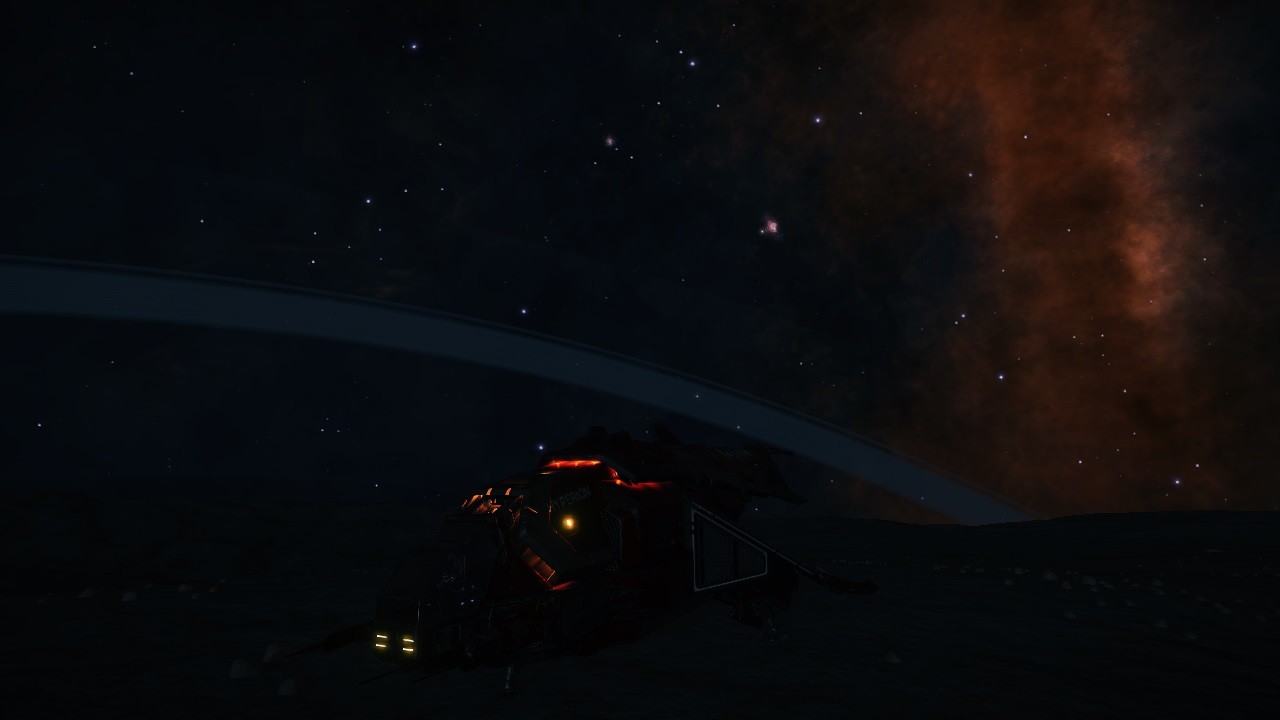
Resuming log. I am feeling better after a good sleep on a planet surface. But I must continue if I want to make on time for the final stage. There is still a huge distance to cover across the Styx. I am now more than forty three thousand light years from Sol. I wonder how Erimus Kamzel and R4nger0 felt when they found each other here, so far from civilization. There were no route plotters on that time. Commander Kamzel was returning from a mission on the Outer Galactic Rim, and Commander R4nger0 was attempting to cross the galaxy in a Sidewinder. That is madness. How they could resist the vertigo of being adrift for so long without reference points. I can not imagine.
Resuming log. The trip back to the route is being as fruitless as the way to Rendezvous Point. I have started to see strange lights while passing through witch space. I even found a waterworld, a lonely waterworld in a system with five stars. No other planets there. I scanned it and heard some weird noises. It was like if the only life bearing planet I have found on this desolated region was calling me.
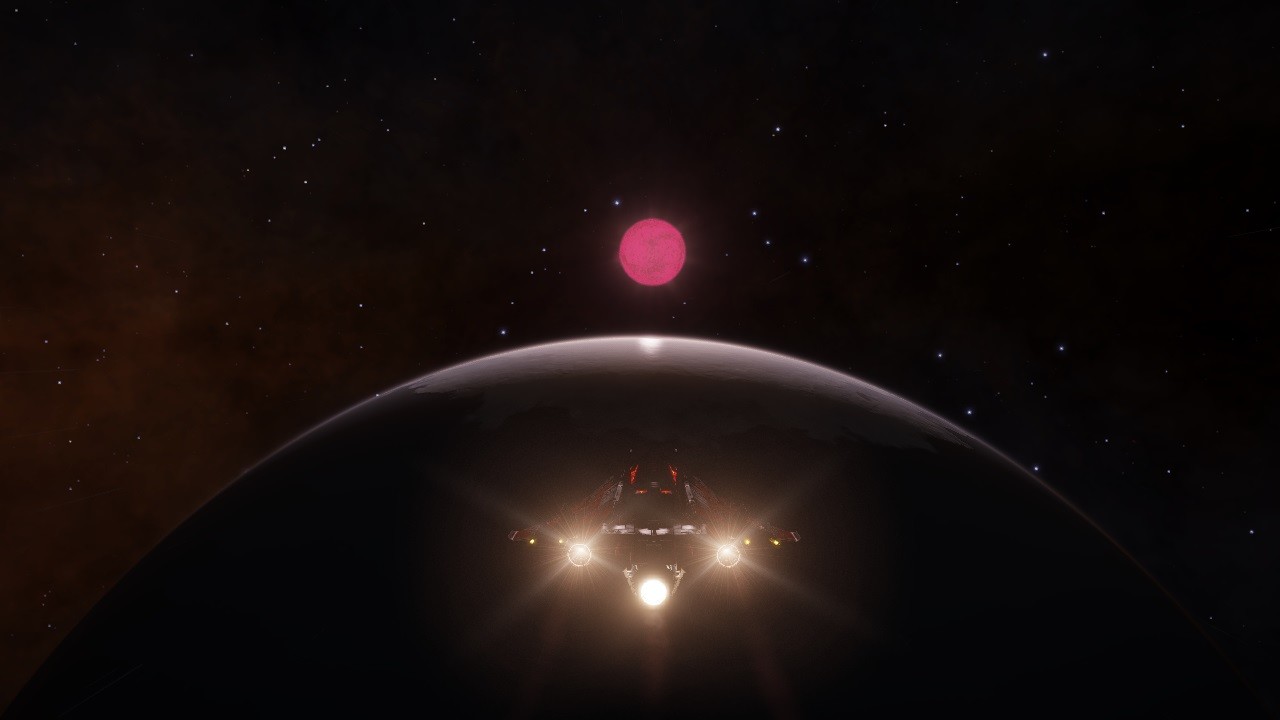
Resuming log. I have made it to system Byua Aub WO-K b36-0, Kalipheron awaits me. I would like to find someone, anyone there.
Kalipheron is a moon that is geologically active with ammonia magma, one of the rarest forms of geological phenomena so far discovered. And I am not alone this time. My scanners have caught the signal of a vessel piloted by a commander called Gimpinstars, approaching Kalipheron too.
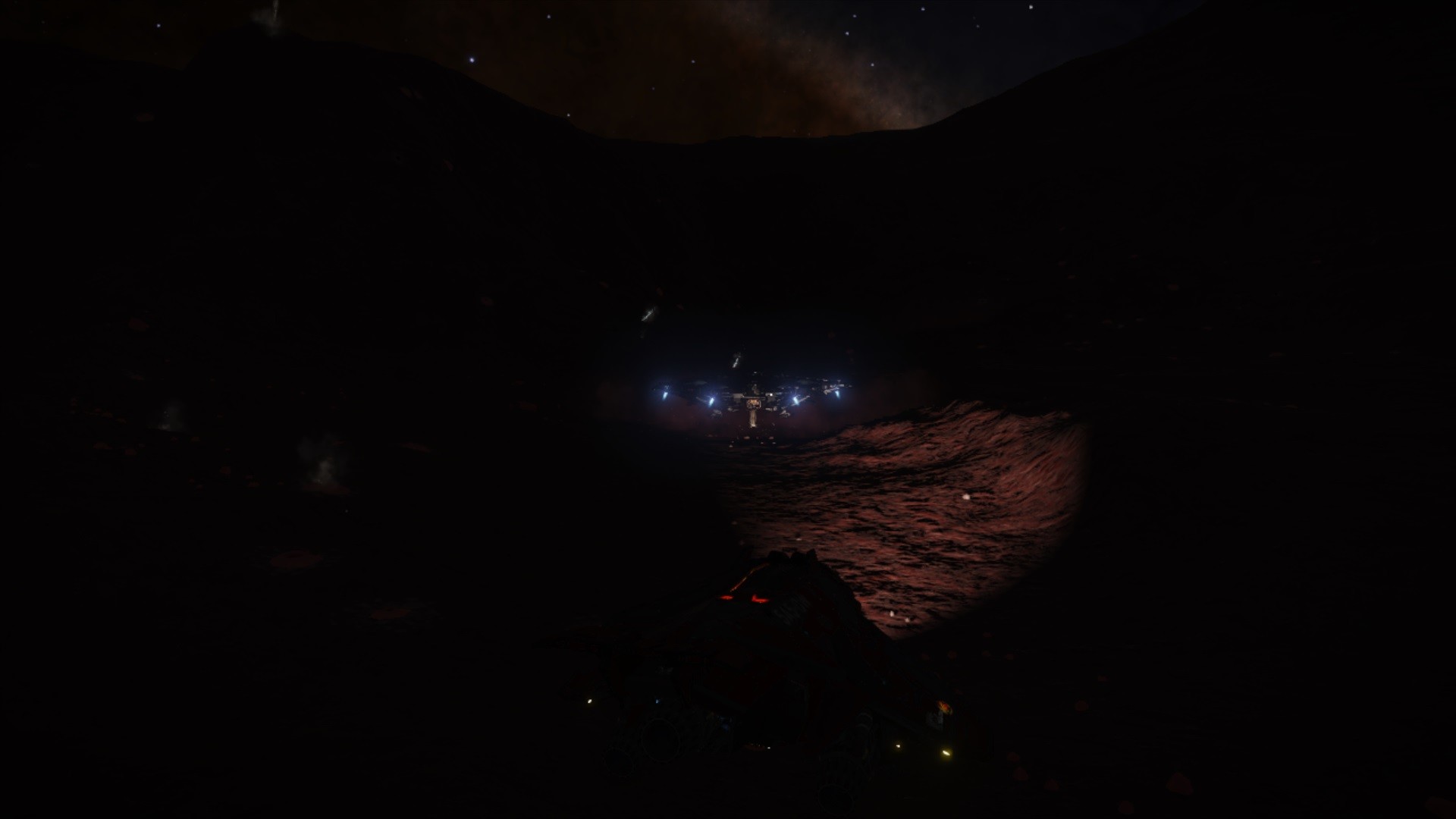
I guess I am not the only one affected by space madness. When I found Commader Gimpinstars flying over the meeting point he was reluctant to land, despite his Phantom was armed and my Diamondback Explorer not, and he demanded me about my intentions. I had to land first in order to build confidence. Space can make you paranoid. I understood him perfectly. After that, everything went smooth. We met in our SRVs and we could enjoy an animated chat, face to face.
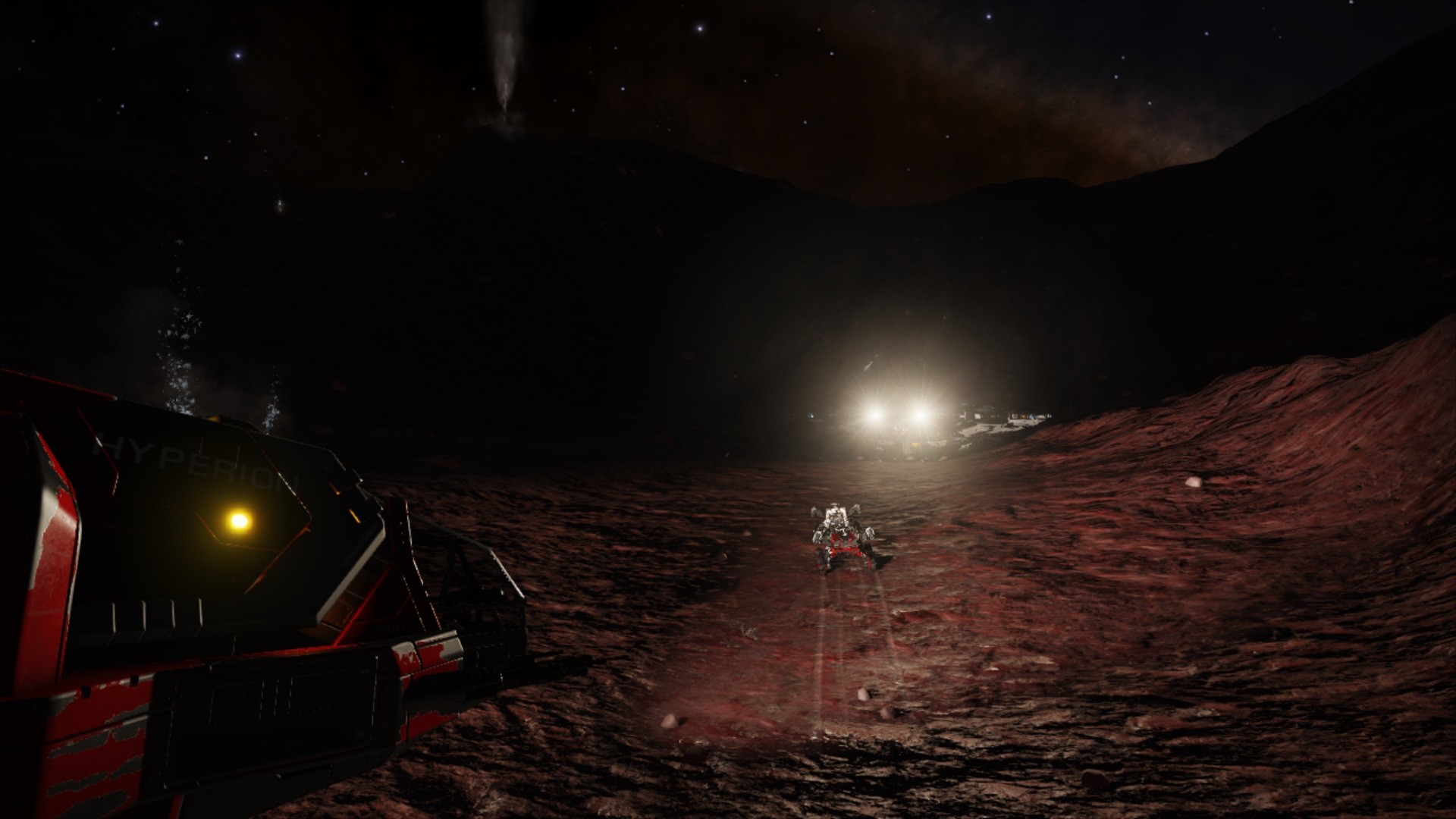
There were no one more there. We talked about the specs of our ships and we shared our experiences of the expedition. I guess that is what explorers do when they met in the other side of the galaxy. I wonder what commanders Kamzel and R4nger0 talked about in Rendezvous Point. Anyhow, our tales were quite similar, we both have been alone for a while in space during this stage of the expedition. It was nice to have company.

Resuming log. I have arrived to system Byeia Free WR-W b56-0, known for the Misty Mountains of one of its moons. It is said that the dark side of this moon is covered in a heavy mist with deep canyons. Well, it is pitch black here on the dark side and I can not see if there is mist, but these canyons look quite dangerous. I have decided not to risk the ship. Not so close to the end. I am leaving this place.

Resuming log. Just some jumps away there is this system, Striechooe HO-D c14-2, which contains a gas giant with an extremely narrow ring. They call it the Hula Hoop.
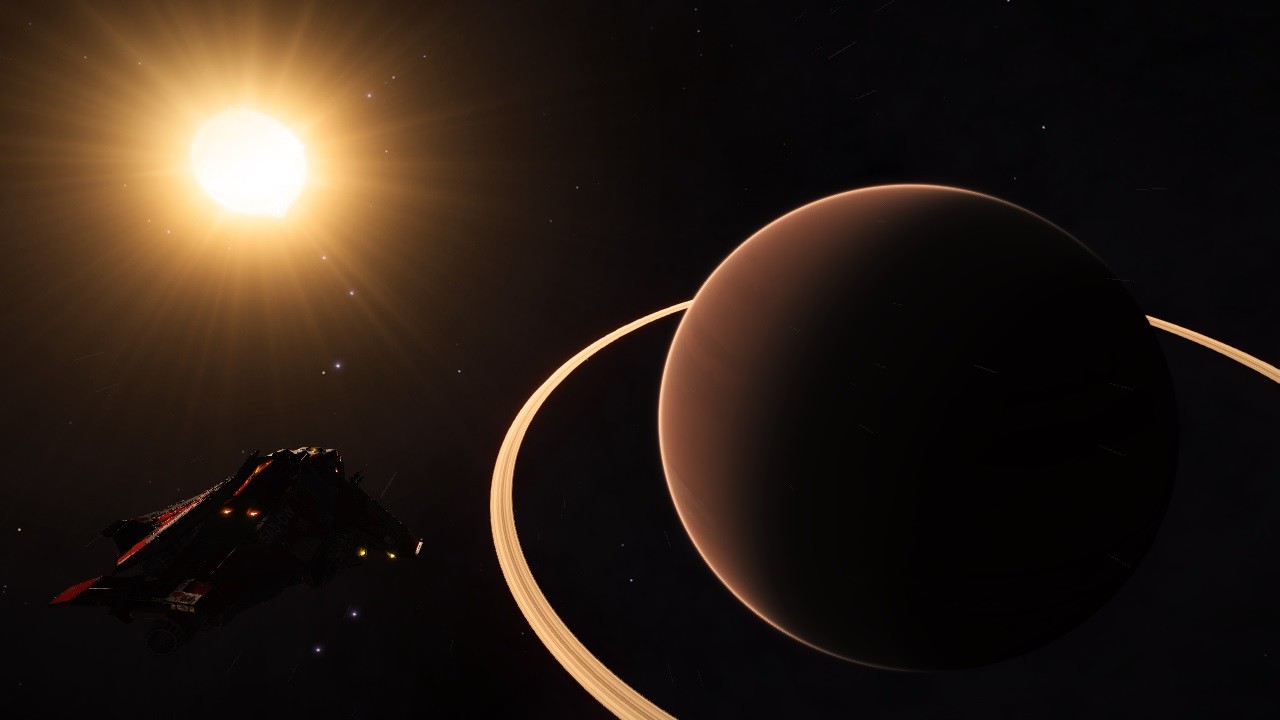
Resuming Log. I continue to look for high mass systems on the way to Luna’s Shadow, and I think I might have found something in system Swuenoi AA-A h86. The system contains two stars and many high metal content worlds. There is vulcanism activity in just one rocky body, the only moon of the first planet.
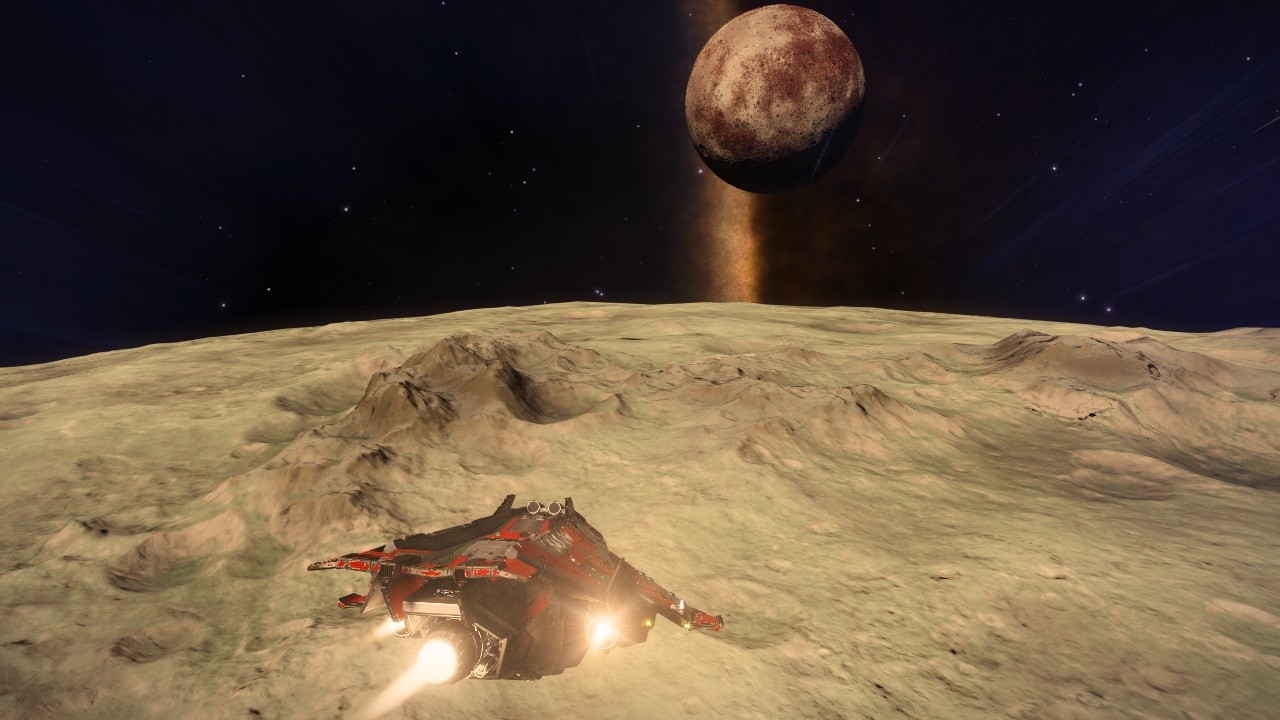
The surface of the moon is covered by very deep craters and lots of peaks and mountain ranges. I am going to land on the verge of one of these craters that has a huge peak on the other side.
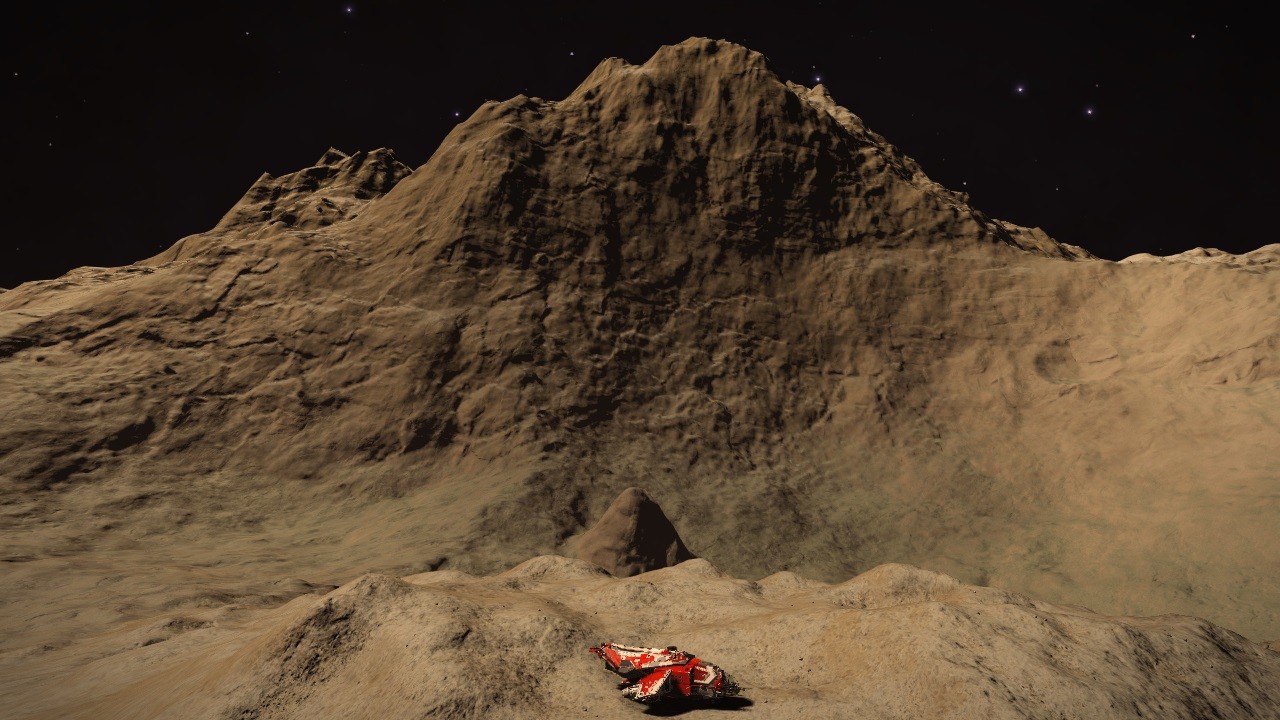
I have rested and now I feel ready to continue exploring the surface of the moon. From above I can see many lonely mountains, and one peaking above the rest.
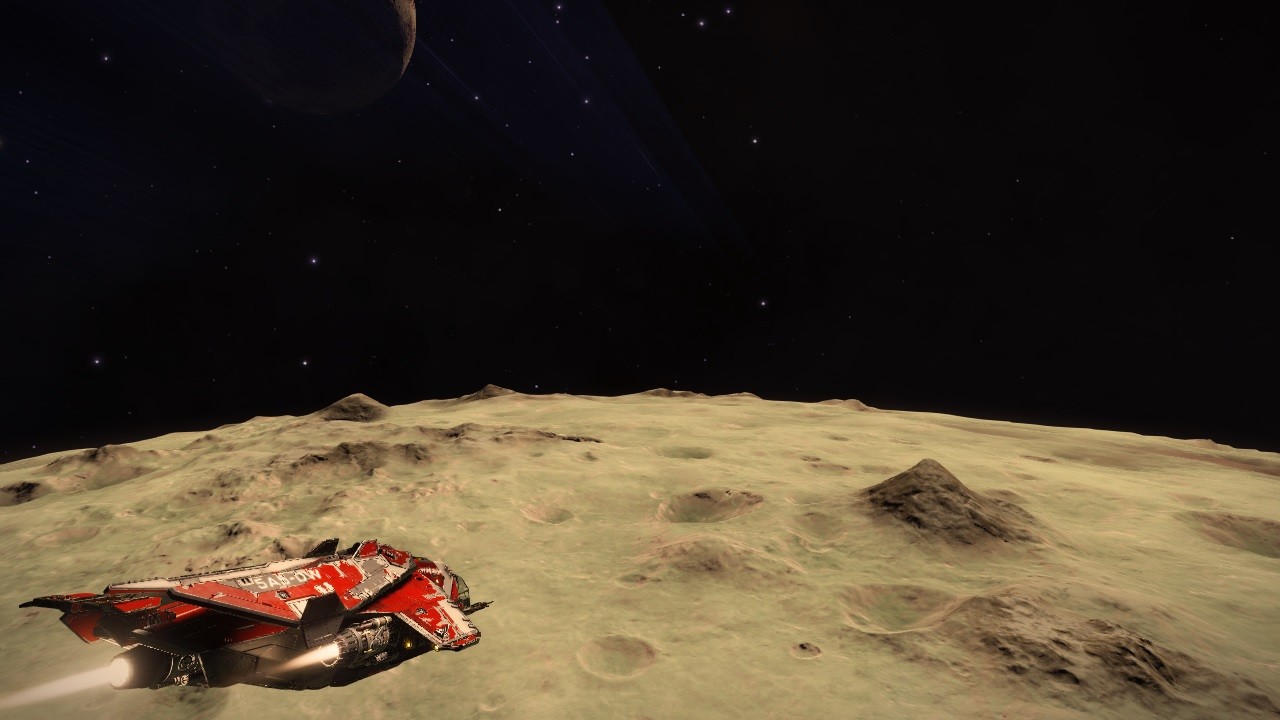
I have tried to land on the peak, but I could not do it. This system is in the region known as the Formorian Frontier. The Formorians are a supernatural race in Irish mythology. They are often portrayed as hostile and monstrous beings who come from the sea or underground. That reminds me that, according to Irish mythology, the site of the first battle fought in Ireland, that confronted the Formorians with the followers of Partholon, took place in a plain called Mag Itha. The plain of Mag Itha is said to have been devastated by Partholón's army. Three hundred Fomorians took part in the battle, and Partholón was victorious. Well, from above this mountain I feel myself like contemplating the battle field of Mag Itha and its many scars after the confrontation. I can not think of a more appropriate name for this place.
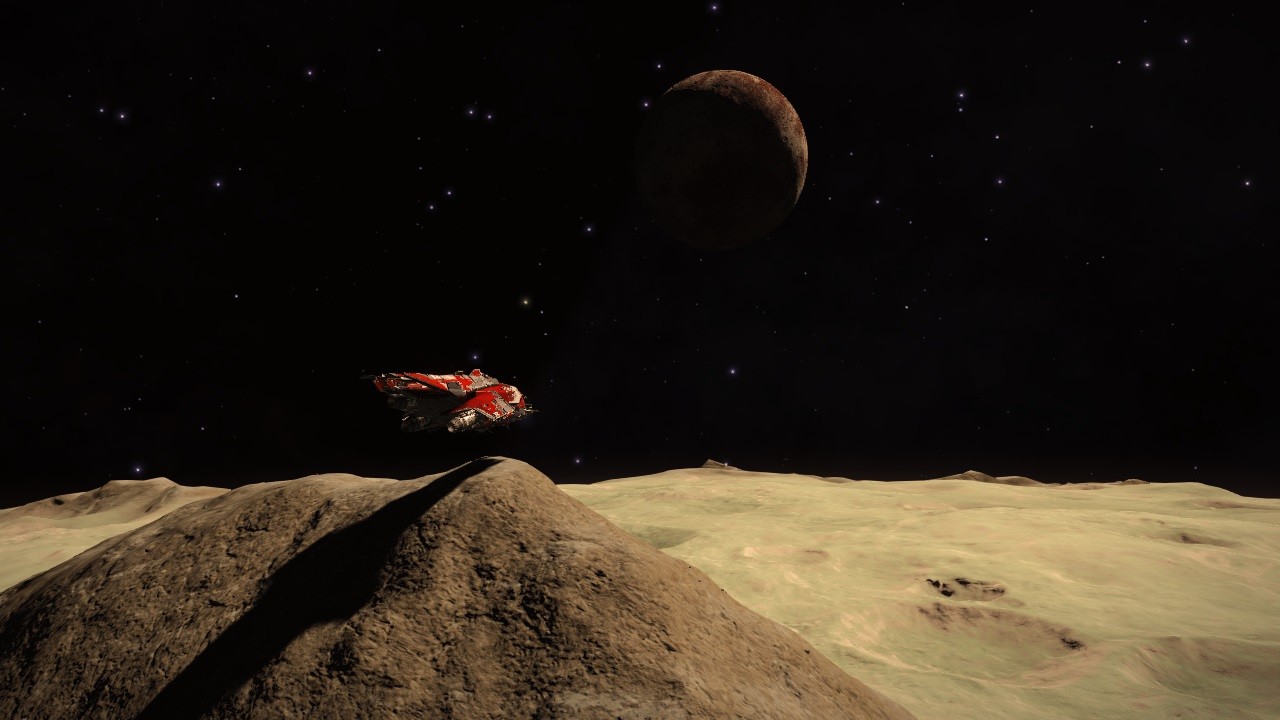
I wish I had more time to spare on this place, but I must go on.
Resuming log. I have found a black hole in system Swuenoi DL-Y G2. It is a lonely one, no more bodies in the system, but it is big, more than five solar masses.
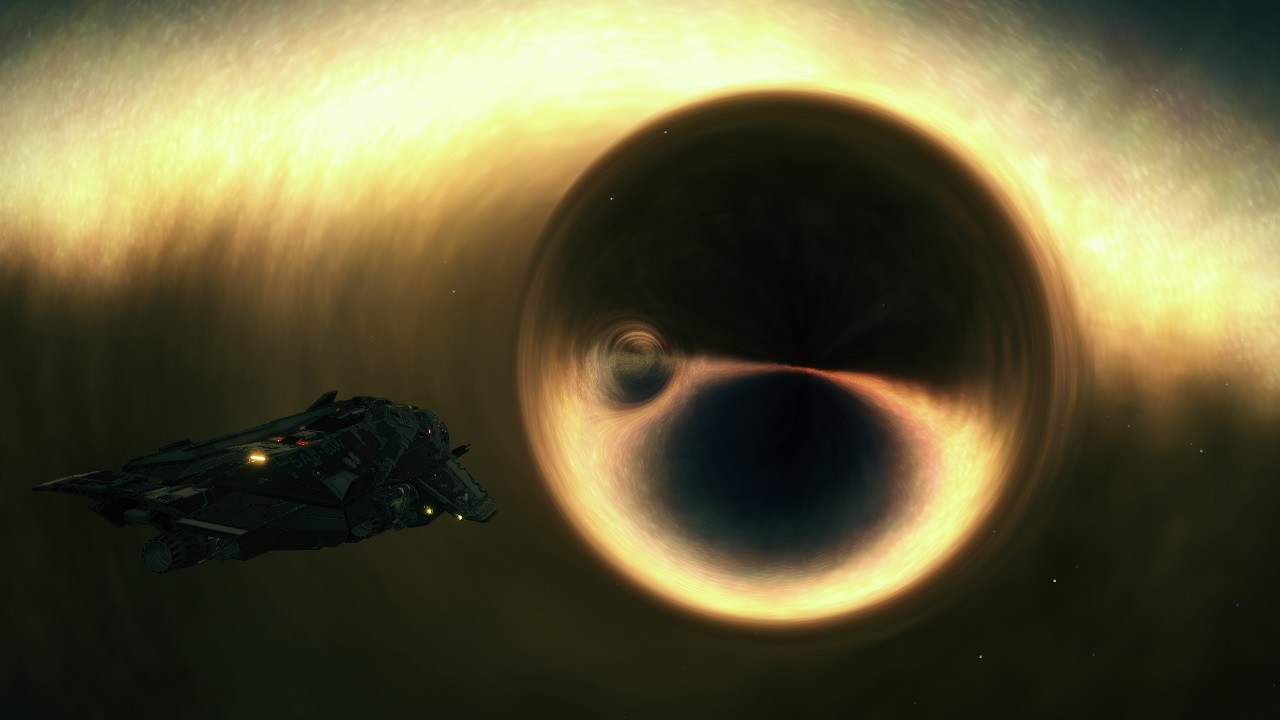
Resuming log. Finally, my luck has changed. I have found life in the middle of the Bleak Lands. There is an Earth like planet in system Auphaibs EY-J b3. It is tiny, cold and has a landable moon.
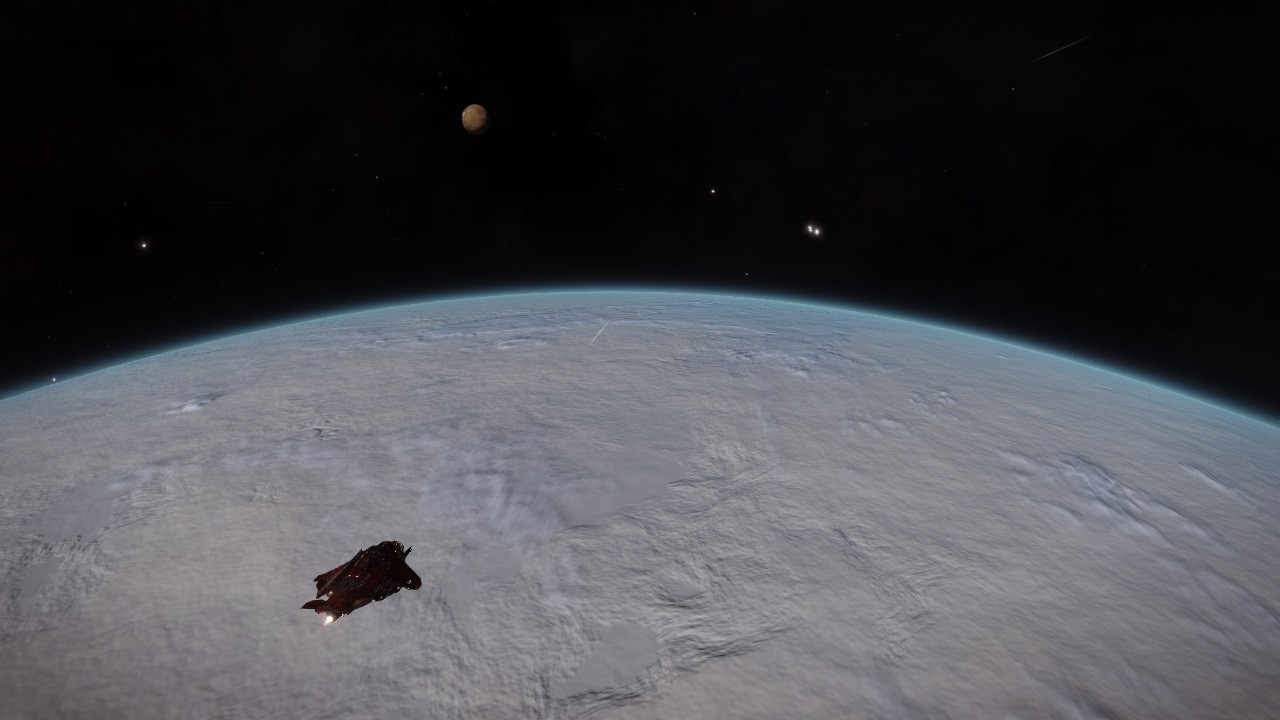
A nice camping site before arriving to Luna’s Shadow.
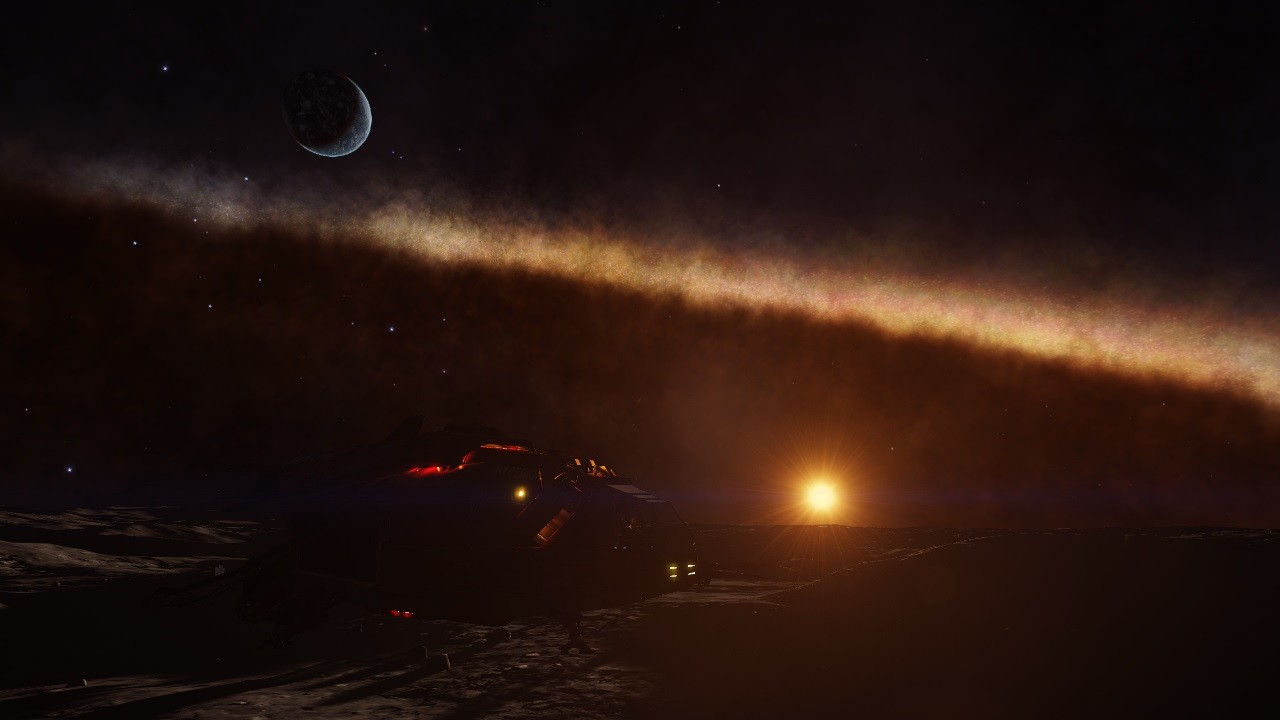
Resuming log. I have arrived to system Smootoae VE-R d4-134, also known as the Shadow Earth, because it contains and Earth like world that is situated 51,819 light years along the zero meridian line from Sol, and 25,919 light years from Sagittarius A. It is thought to be the closest Earth like world discovered to the physical antithesis of Sol on the far side of the galaxy.
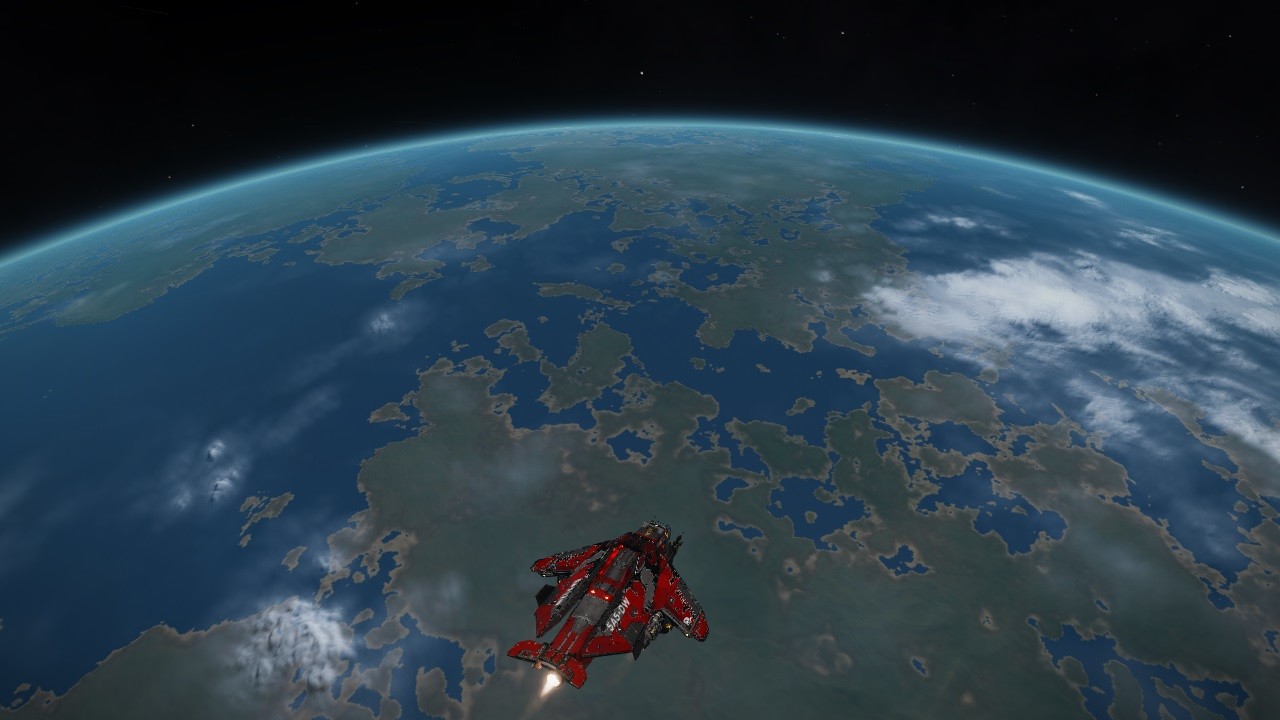
And the antithesis of Sol on the far side of the galaxy is just fifty light years away, system Smootoae QY-S d3-202, Luna’s Shadow. Situated on the galactic prime meridian, and one light year above the galactic plane, some 25,898 light years from Sagittarius A on the far side of the galaxy, this system is the physically located antithesis of Sol. Remarkably the star system also has eight major planets, the third one being a water world orbited by a moon that is strikingly similar in both appearance, size, and composition to that of the Earth's moon, on the opposite side of the galaxy from this location. This moon, nicknamed Luna's Shadow, is an ideal location for travellers to land at and collect Jumponium resources before heading out to the Abyss. And the moon has a huge crater known as the Magnificent Desolation, where the basecamp of the expedition is.
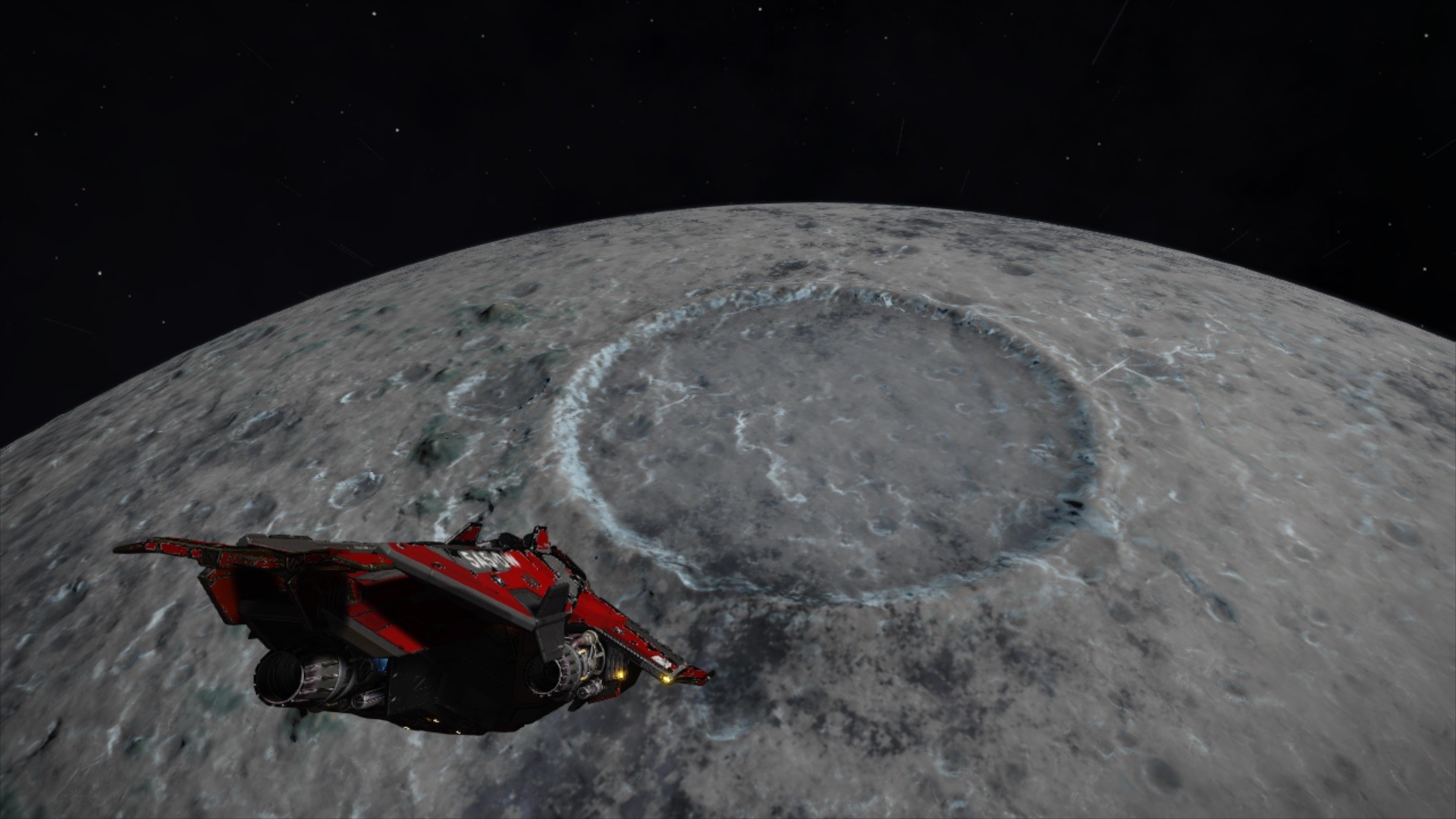
There are already some commanders landed there. I can see a Cobra a Diamondback Explorer like mine, some Anacondas and one Beluga. Huge ships. Probably with a crew of a few. I guess space madness feels different when flying one of those.
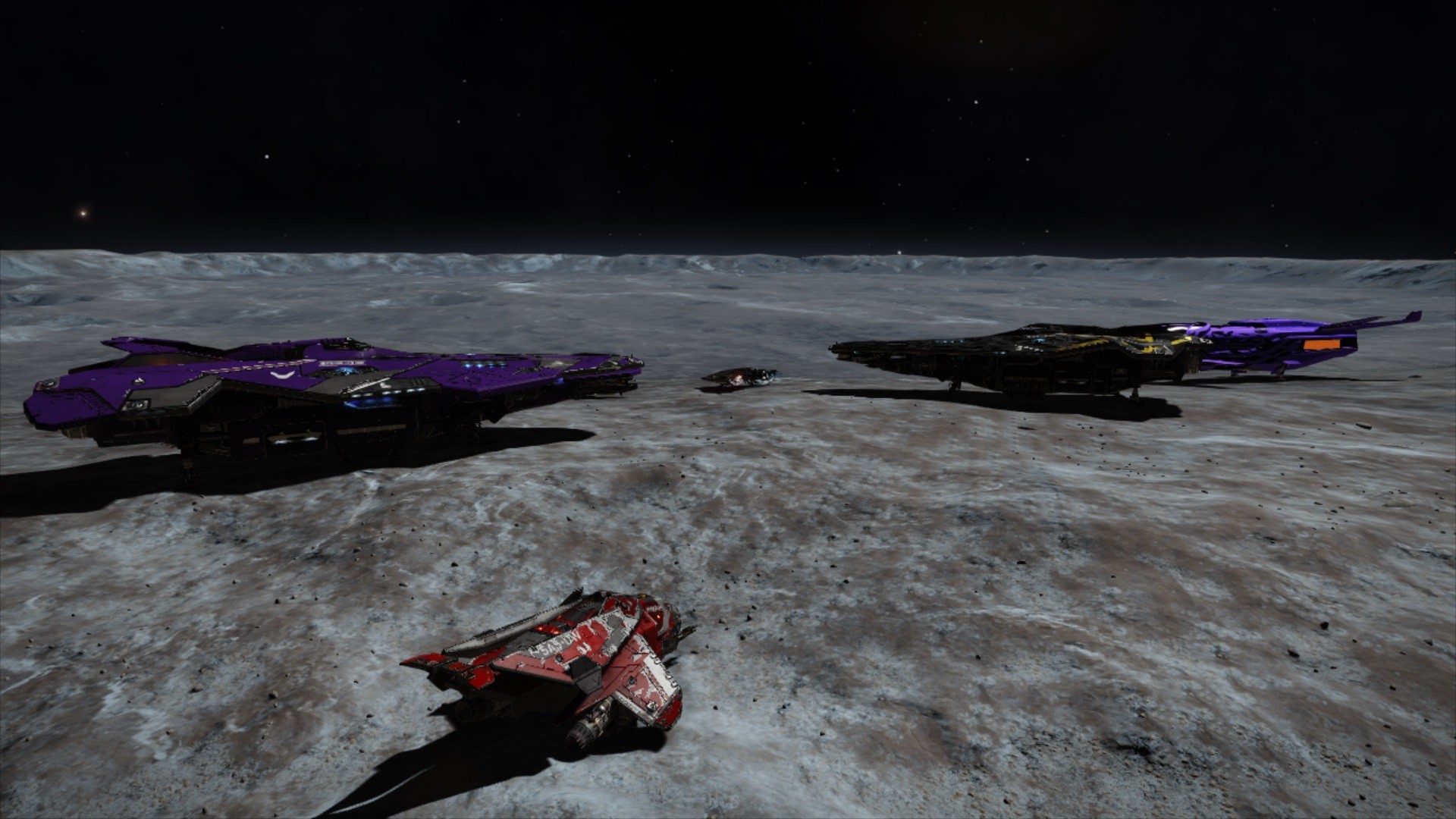
It seems that we are at least a couple of hundred commanders who have made it to here so far. And they say that a mass jump is being organized right now. I cannot believe it. I have made it on time to participate on a mass jump. One of Distant Worlds` most popular rituals. And this will be the last mass jump of Distant Worlds 2.
I quickly go back into orbit and request permission to join one of the groups that are being organized by commander Rebecca Lansing and her partners. Soon, I am invited to join the group of Commander The Sonderval, and I drop out of super cruise at her beacon. A bunch of commanders have already gathered there.
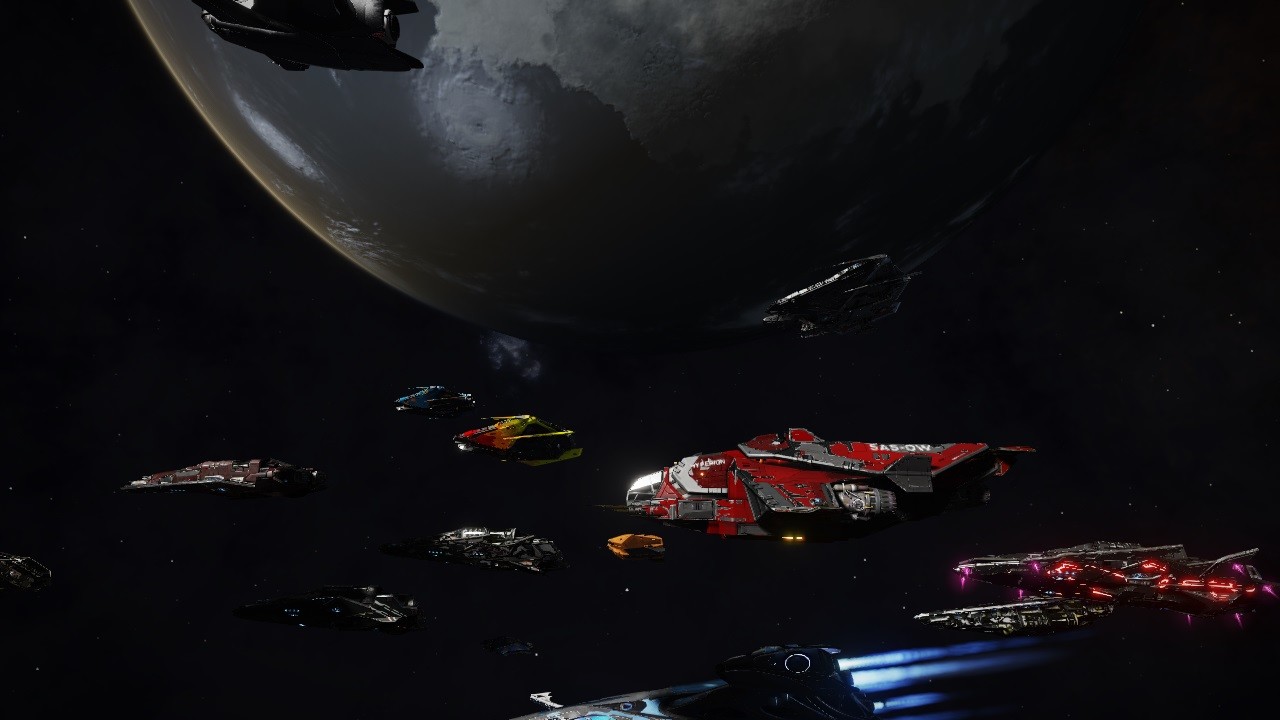
The final stage of the itinerary has been released by commander Erimus Kamzel. Everybody wishes good luck. All the vessels align themselves for the jump.
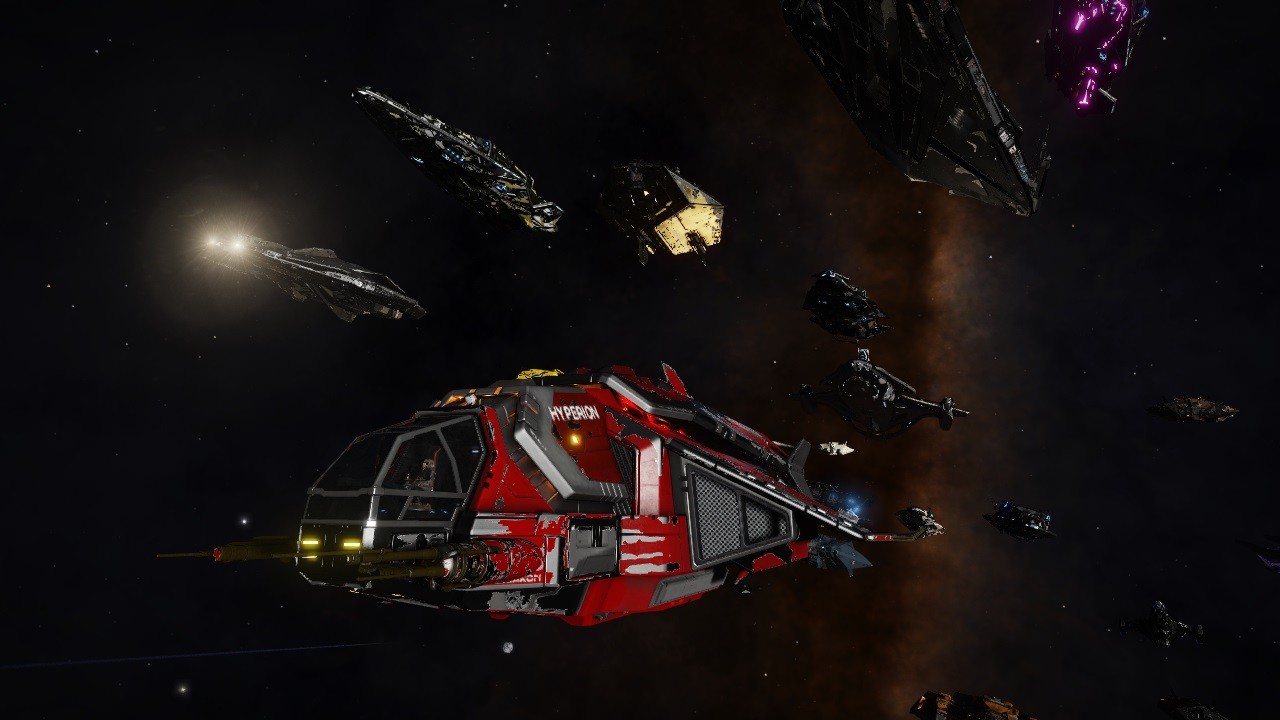
T minus five. The chaotic formation of more than fifty ships make a big honk altogether. Frame shift drives charging. Holding thrusters.
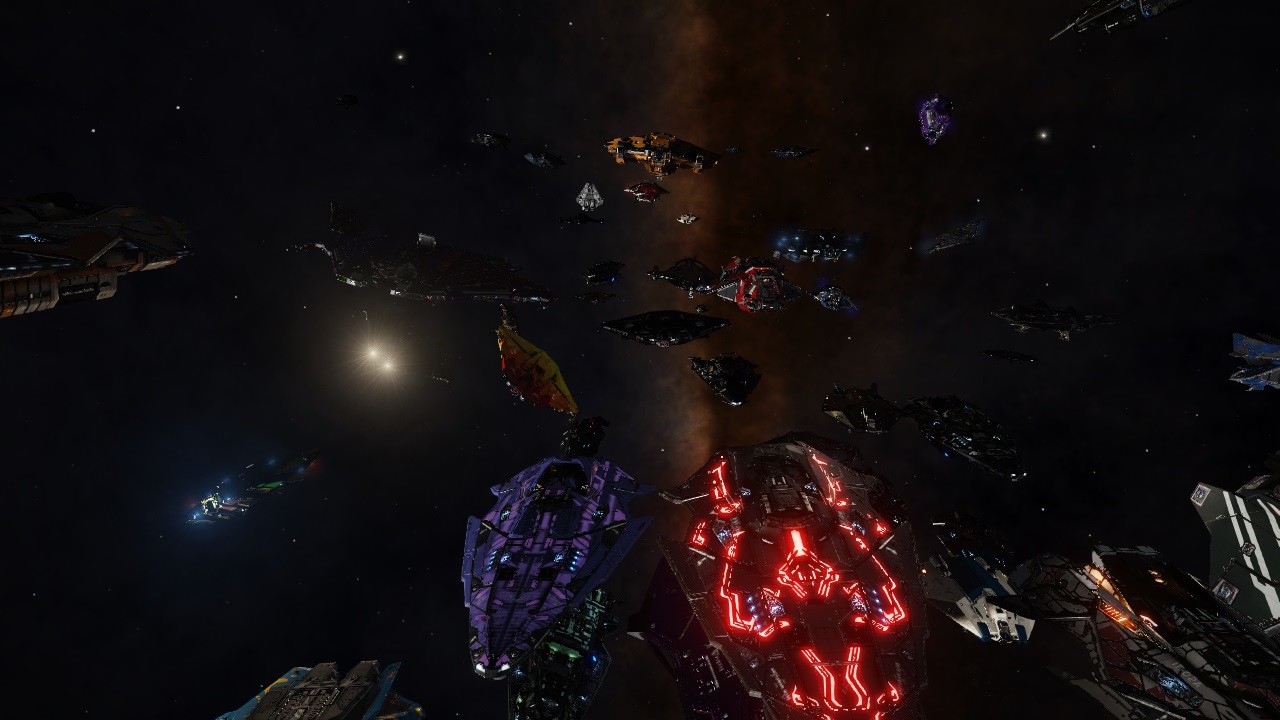
In the last two weeks I have covered more than thirty five thousand light years exploring. That is more than half the distance between Sol and Beagle Point in straight line. And the final goal is just thirteen thousand light years away. It is time. Now! Frame Shift Drive charged. Thrusters at maximum power. See you at Beagle Point. 3, 2, 1, ENGAGE.
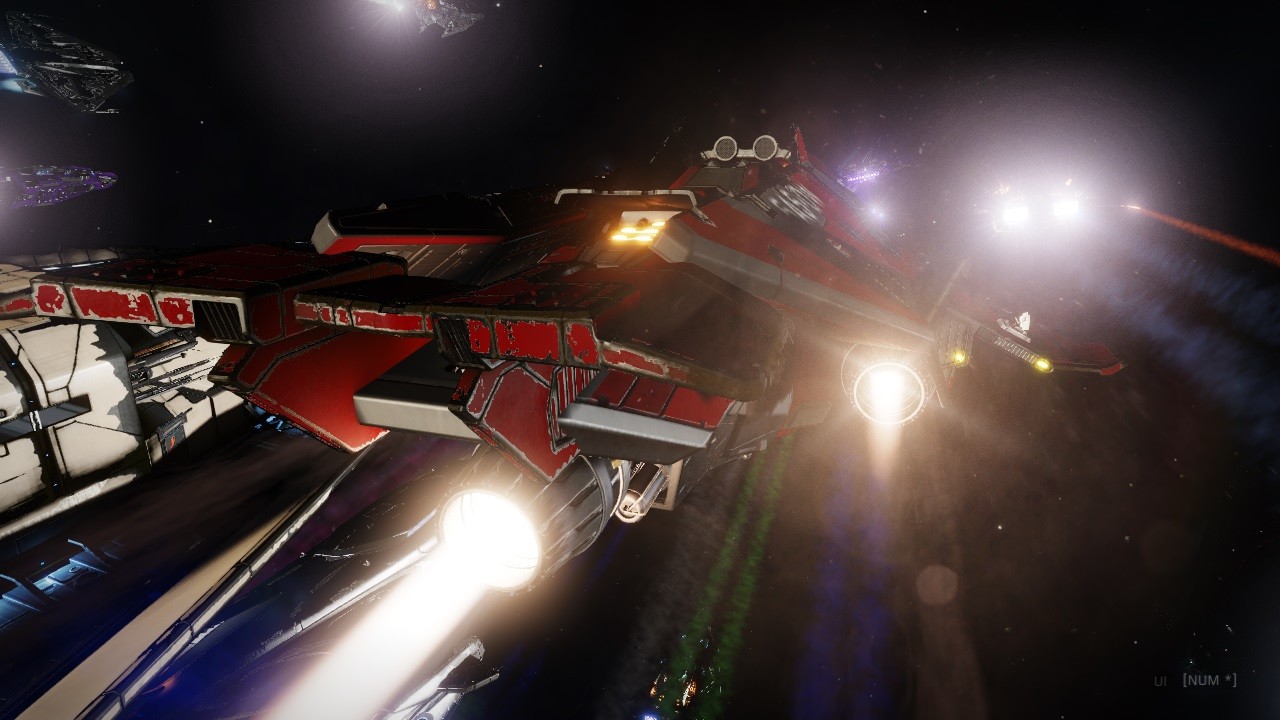
DISTANT WORLDS 2 (PART 14) – IZANAMI’S HELL
14 APRIL 3305 Distant Worlds 2 meeting point at Aristo (PRU AUB DL-P E5-35)
This is commander Jav Marlo, onboard the Hyperion, departing Mors Pit in system Bleethuae NI-B D674. The next waypoint has been released. The fleet has been asked to contribute in the mapping of the Aphelion regions, a vast stretch of the galaxy that little is known about. If we are able to discover some points of interest in these regions, that will be considered one of Distant Worlds 2 lasting legacies, commander Erimus Kamzel have said. This is too one of the longest stretches between waypoints, exceeding the mark of fourteen thousand light years distance. We have two weeks to arrive to Luna’s Shadow, in system Smootoae QY-S d3-202, from where we will confront the final stage of this expedition. After more than eighty days, the fleet attrition is very notorious now. According to the Galactic Mapping Project database, less than twenty five percent of the fleet made it to the rendezvous point in the Morphenniel Nebula. I wonder how many of us will reach the end, in Beagle Point. And then is the return trip. But let’s not think about that now. Just focus on the task ahead. I have decided to start by heading to the Phoenix Nebula.
Resuming log. Midway between the Phoenix Nebula and the Morphenniel Nebula, in the Izanami region, I have found an interesting system, Prooe Flyuae YZ-P d5-100. Its primary star is a deadly and beautiful white dwarf, that has been guarding the entrance of the system since more than ten thousand million years. If the explorer that manages to arrive here is prudent and able enough to avoid the deadly trap of the white dwarf exclusion zone, he will find himself in an incredible dark and cold, but beautiful system hiding many wonders.

There are four class I cold hydrogen rich gas giants with thirteen icy bodies orbiting them. All these icy moons are landable and there are two hundred and eleven different geological sites spread among them. The first moon in the third gas giant has forty nine geological sites. The system contains too a secondary brown dwarf star more than one hundred thousand light years away that keeps another six similar icy bodies orbiting around. None of the nineteen icy bodies in the system has a temperature above the forty kelvin degrees.
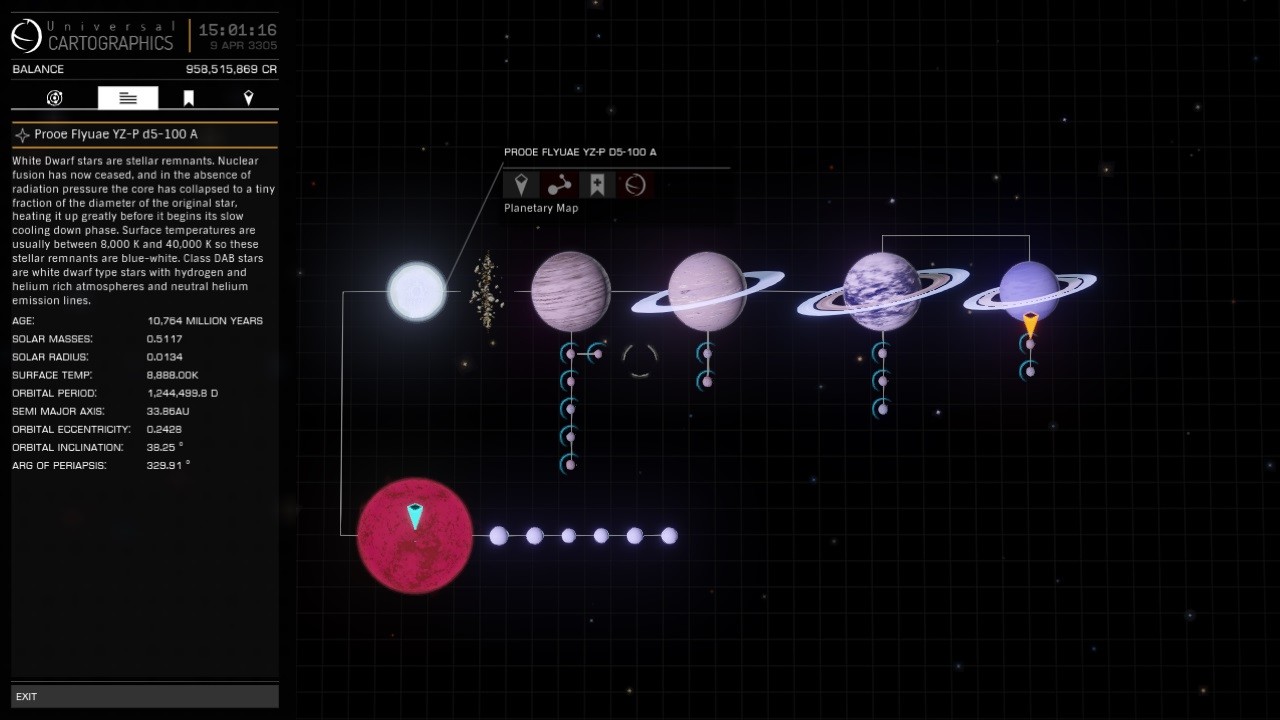
The first gas giant has a very close couple of moons that share an incredibly tight orbit.
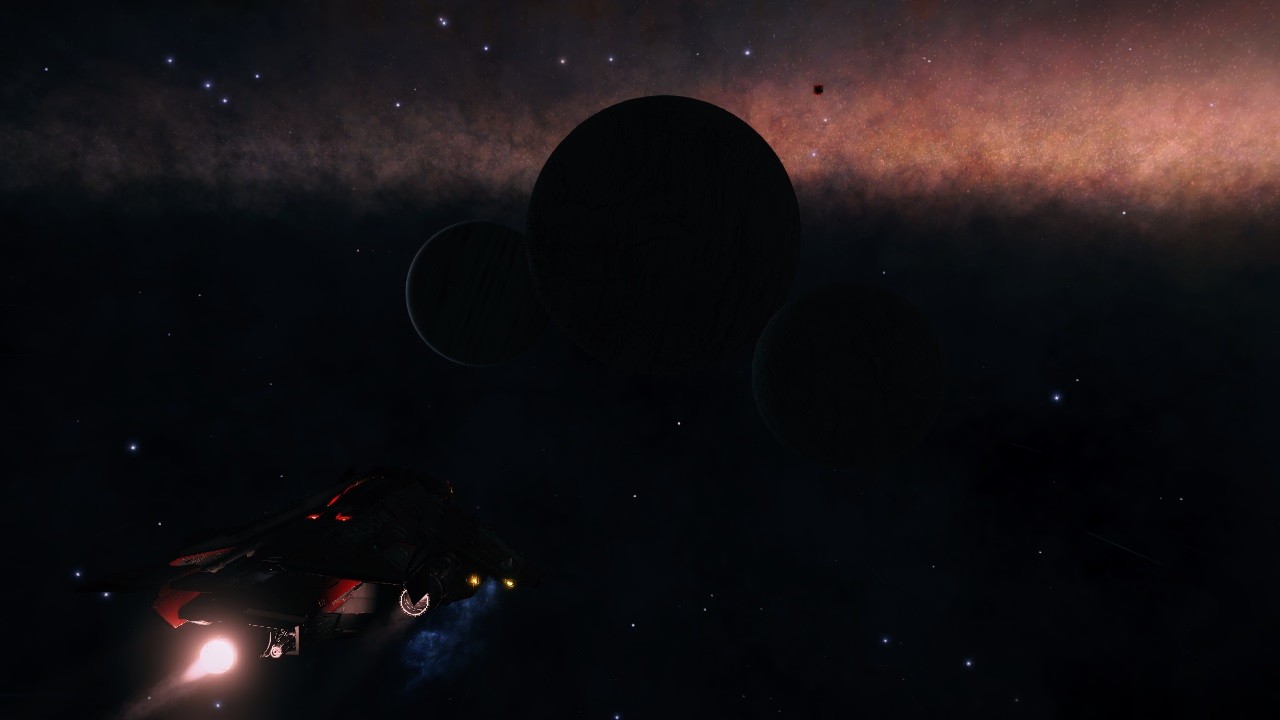
The smallest of then has deep canyons and forty five geological sites, providing incredible views of the other moon and the gas giant.
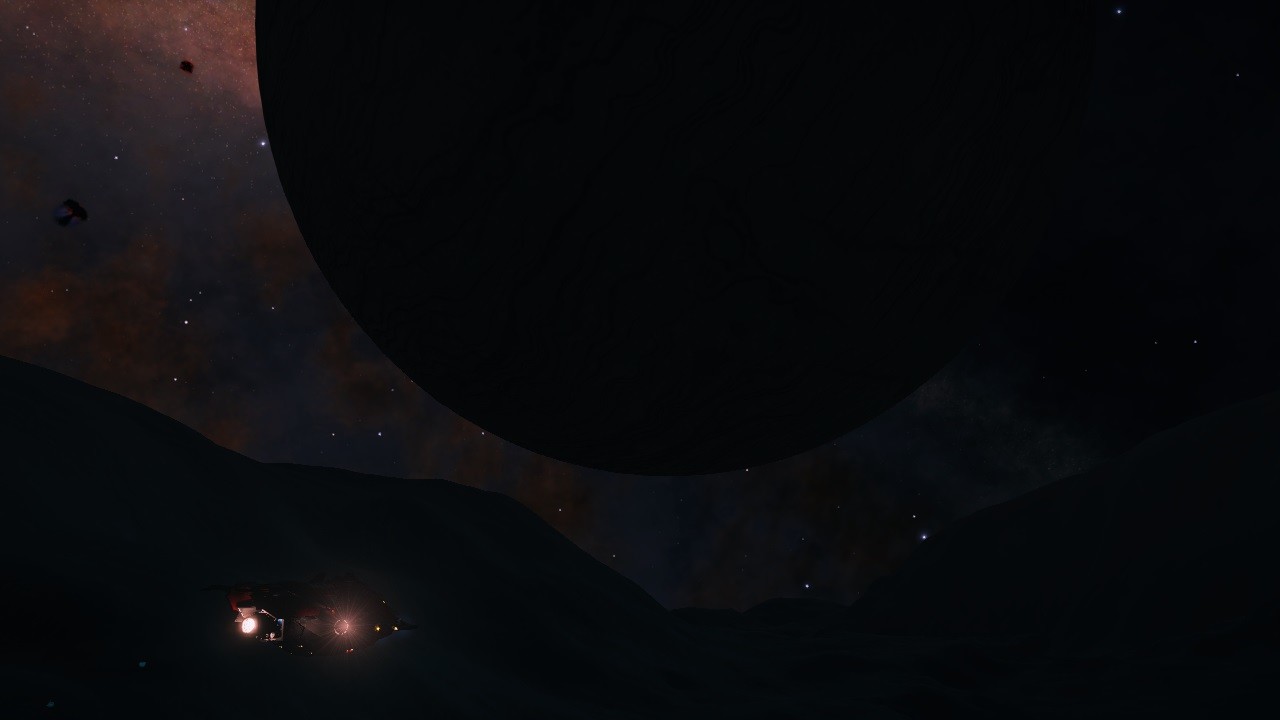
The fourth gas giant has two moons. The closer one describes an orbit that circumnavigates the ring of the planet almost touching it.
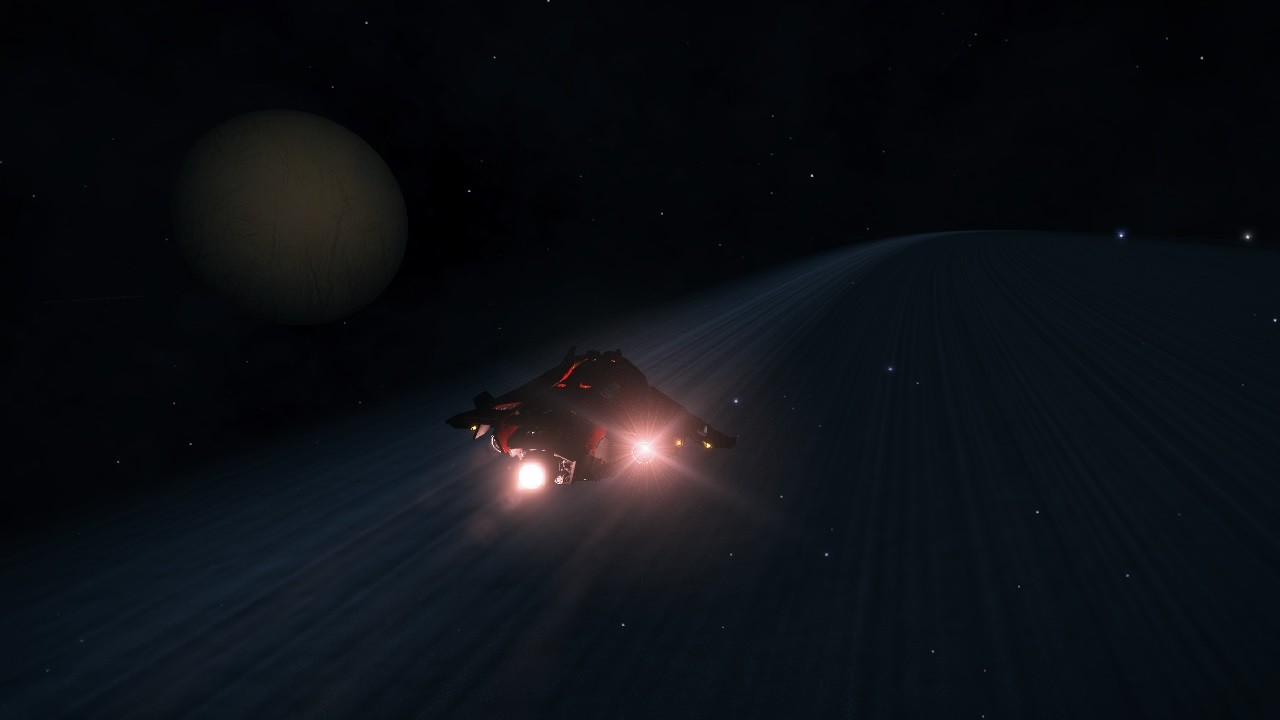
It has forty five geological sites too, providing with many potential campsites from where to behold the magnificent ring of the gas giant. The views are quite similar to those on the Silver Highway in system Phipoea HJ-D c27-5254.
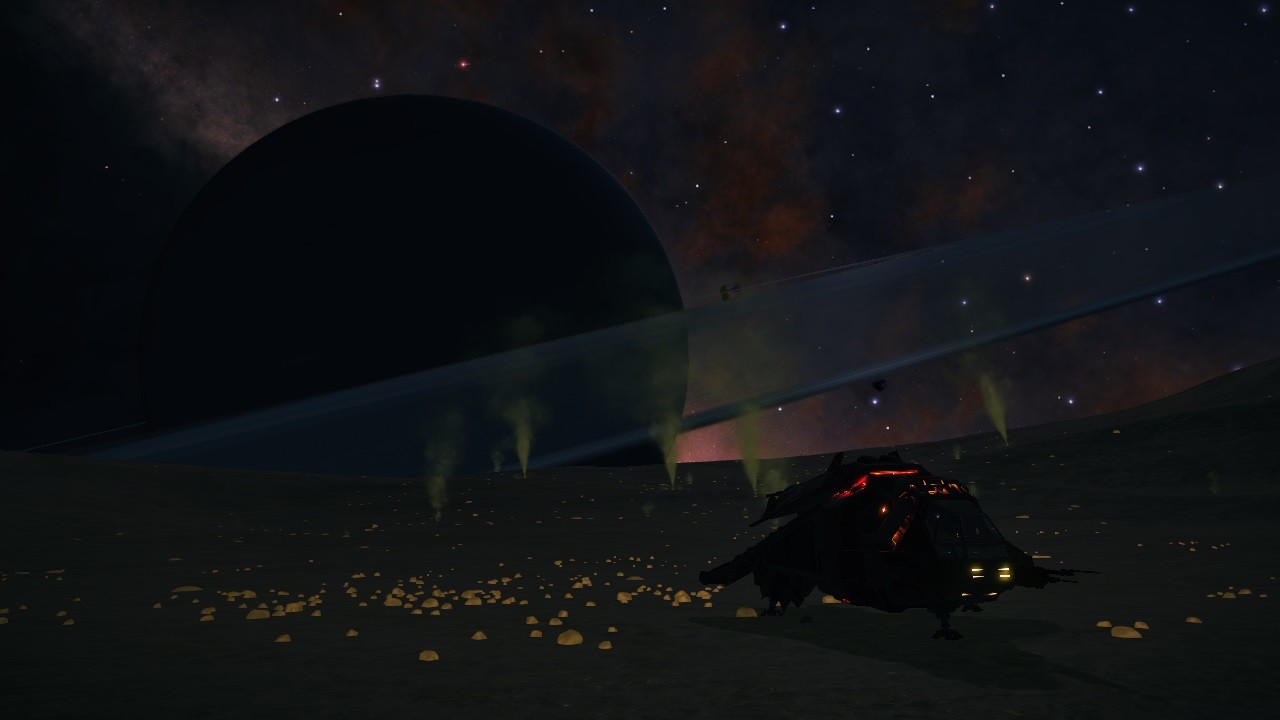
Being this system in the region of Izanami, the Japanese goddess of both creation and hell, it reminded me the legend of Yomi, the land of the dead, most commonly known for Izanami’s retreat to that place after her death, that is described in Japanese mythology as a World of Darkness.
I think Yomi would be a very proper name for this place.
Resuming log. After expending some time exploring the frozen system I have found, I finally made it to system Dryiquae SO-Z d13-3, the Phoenix Nebula, which greeted me with all its magnificence opening its wings like trying to embrace my little ship. The three thousand light years trip here was worth that sight.
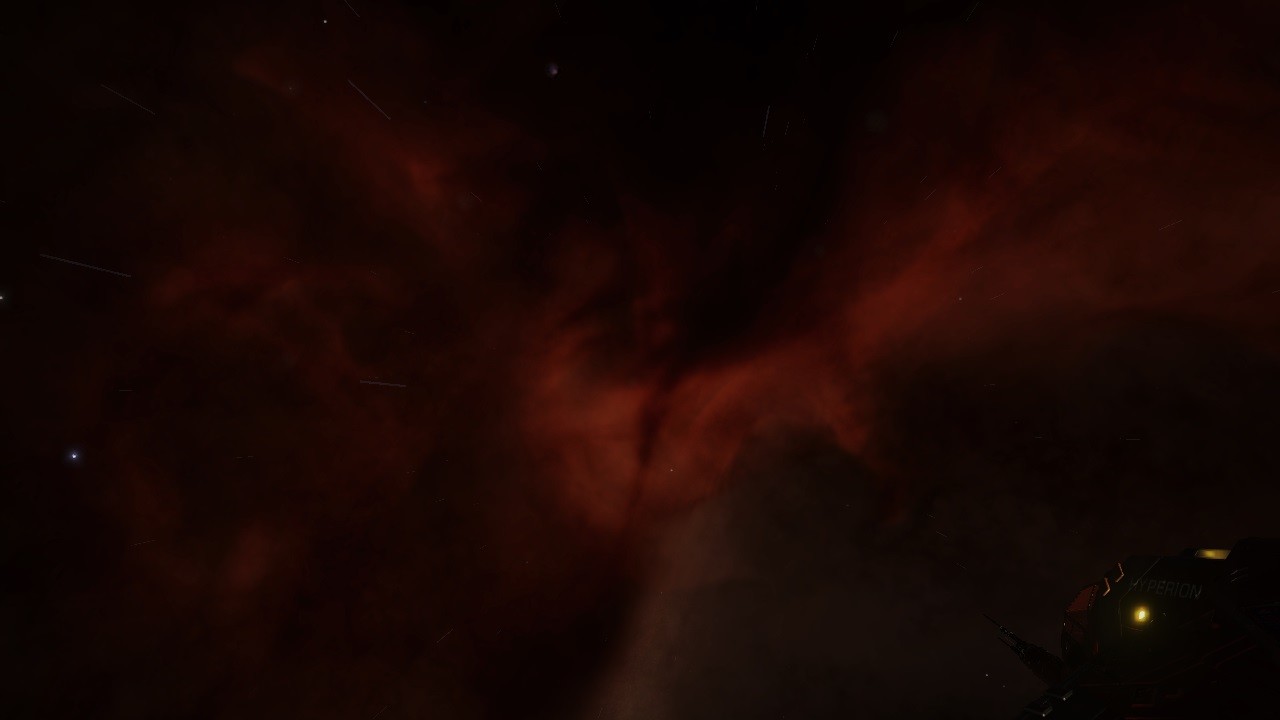
It has been quite a trip and I am exhausted now. I am looking for a suitable place to land and rest, and I think I have found it in one of the moons of system Preia Pri UA-A CO. A great campsite under the shadow of the Phoenix.
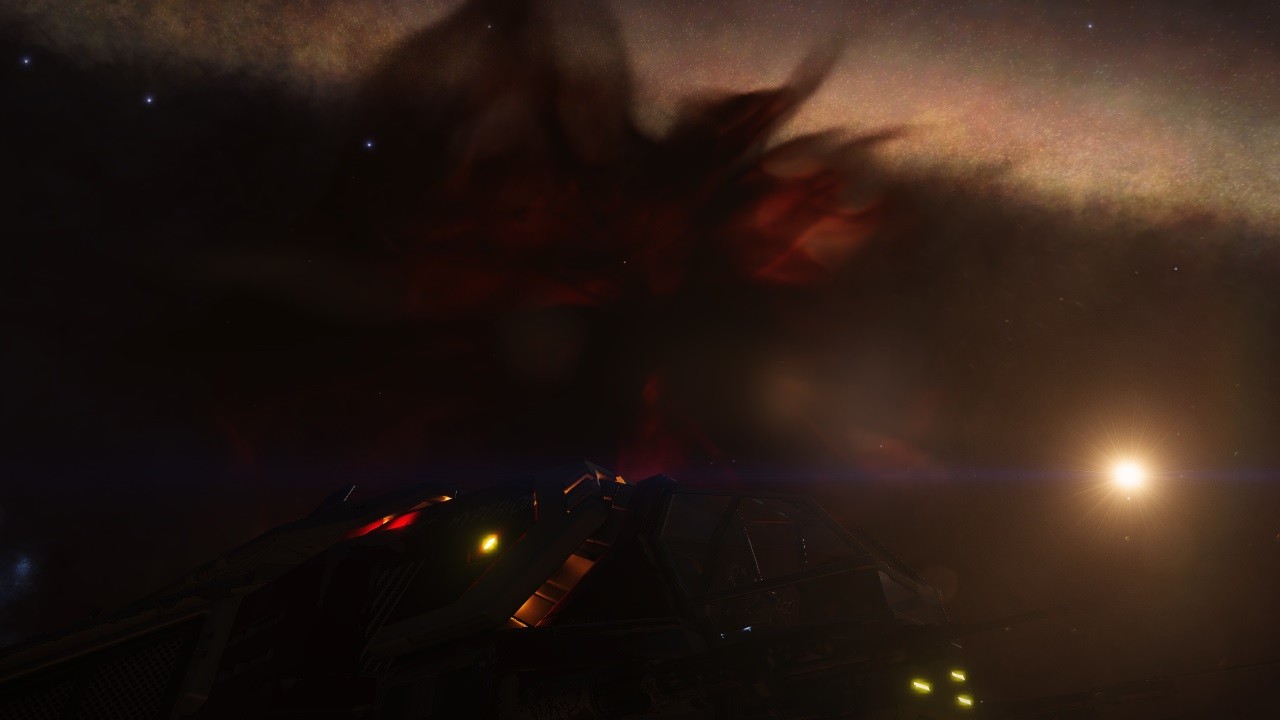
Resuming log. I am heading to system Bleia Flyuae ZU-N d7-54, also known as Poseidon’s Fury. According to the Galactic Mapping Project database, there is a ringed water world, with three relatively large moons. While ringed water worlds in of themselves are not all that unremarkable, this particular water world and its ring system is unusual due to the large gap between the A and B rings with two moons orbiting between the A and B rings, and the third moon in an inclined orbit outside the rings, suggesting that the planet moon system may have had a violent formation.
Due to the third moon’s inclined orbit, it is possible to find an excellent view of the water world, its inner ring, its two intra-ring moons and its colossal outer ring.
This planet and its ring system was discovered during the Minerva Centaurus expedition in Feburary 3304.
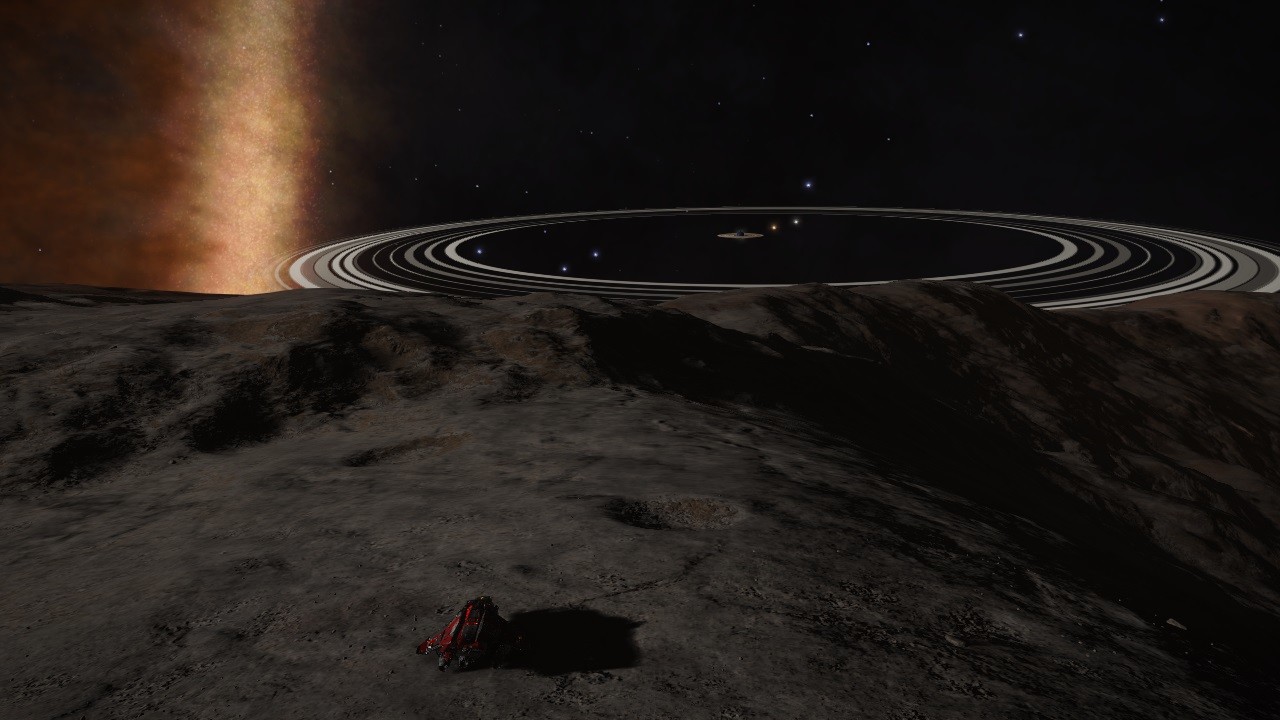
Resuming log. After enjoying the view of Poseydon’s Fury, I am heading now to system PRU AUB DL-P E5-35, also known as Aristo, the first stop of this stage of the expedition. It is my plan to look for systems with heavy mass along the way in hope of finding something interesting.
Resuming log. I think I have found something. There is an undiscovered black hole in system Blae Flyuae CL-Y g1. Interesting! The system contains, apart from the black hole, two almost identical T Tauri Stars with almost two identical class III gas giants orbiting them. Alas, there is nothing visually striking here.
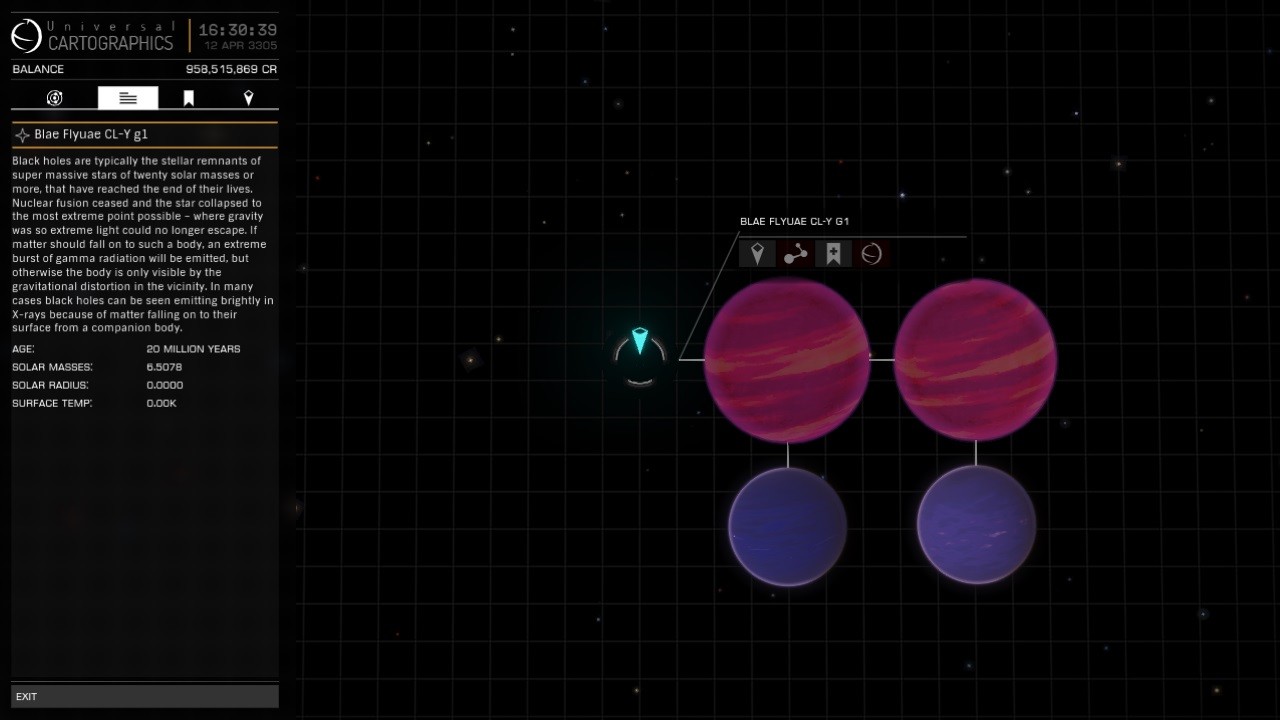
Resuming log. I was passing by system Blu Aoscs LH-N b20-15 when something attracted my attention. There was only a planet there, an icy body, but its colour in the scanner was orange instead of blue. I decided to approach and found it is huge, more than sixteen Earth masses with 2G. And here is the best part. Its surface temperature is 540 K. What a hell! And the computer identifies it as an icy body. Well, if there was ever ice here it was a long time ago. This huge desert planet is vey close to the systems main star too. I have decided to land an take a closer look. On approach, the surface looks quite bumpy. Such a desolated place! But I am tired. The distances of this stage of the expedition are huge, and I must take any opportunity to rest. So, there I go, to land in this burning ice rock.
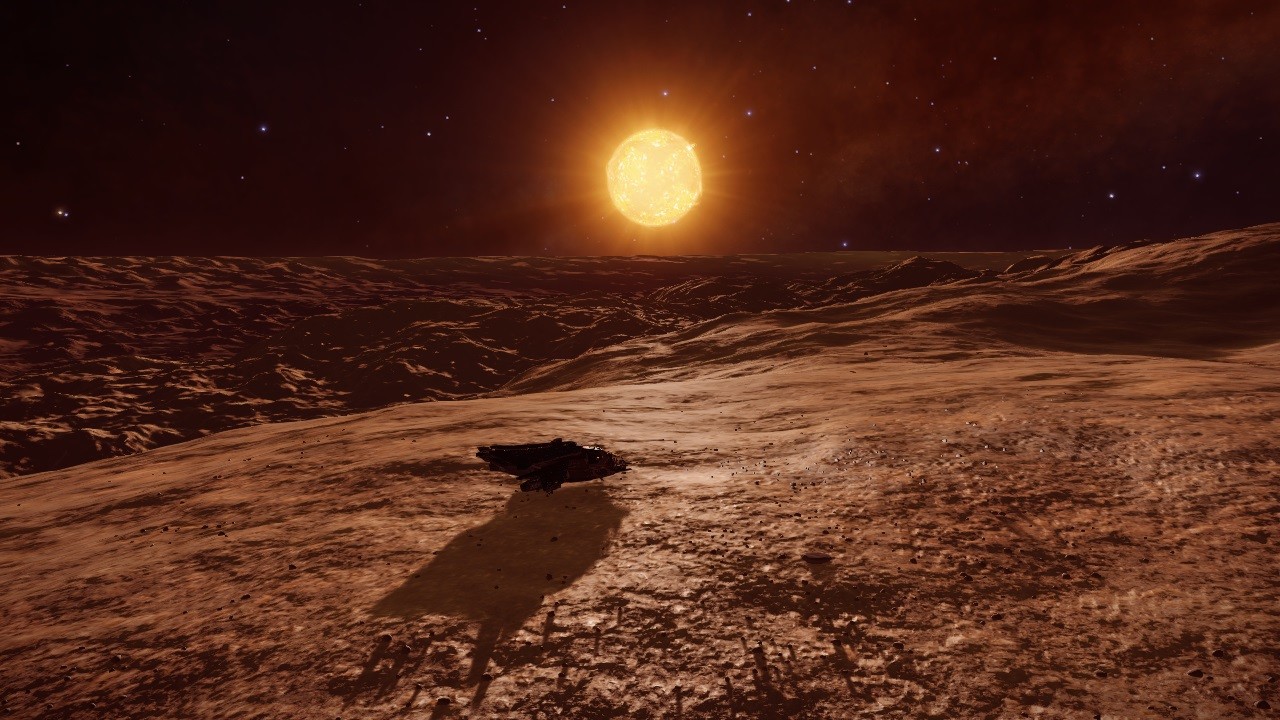
Resuming log. I have found an Earth like planet. Here! In the middle of nowhere. It is the first one I find in quite a time. It is very close to Aristo, in system Pru Aub BX-A c27-49. And it is beautiful!

Resuming log. I have arrived to Aristo, in system PRU AUB DL-P E5-35. It is quadruple white star solar system in the heart of the Boreas Expanse. The system contains a variety of high metal content worlds, brightly illuminated ring systems, and several moons, many of which are landable. Most of the landable planets are high gravity. I am heading now to the coordinates of the meeting point, in a ringed metal rich world. The place is on the edge of a huge crater with a great view of the ring. Two of the white stars of the planet are illuminating the ring right from behind making it very luminous. There are no signs of the fleet here. Not a single commander. I am alone in this place.
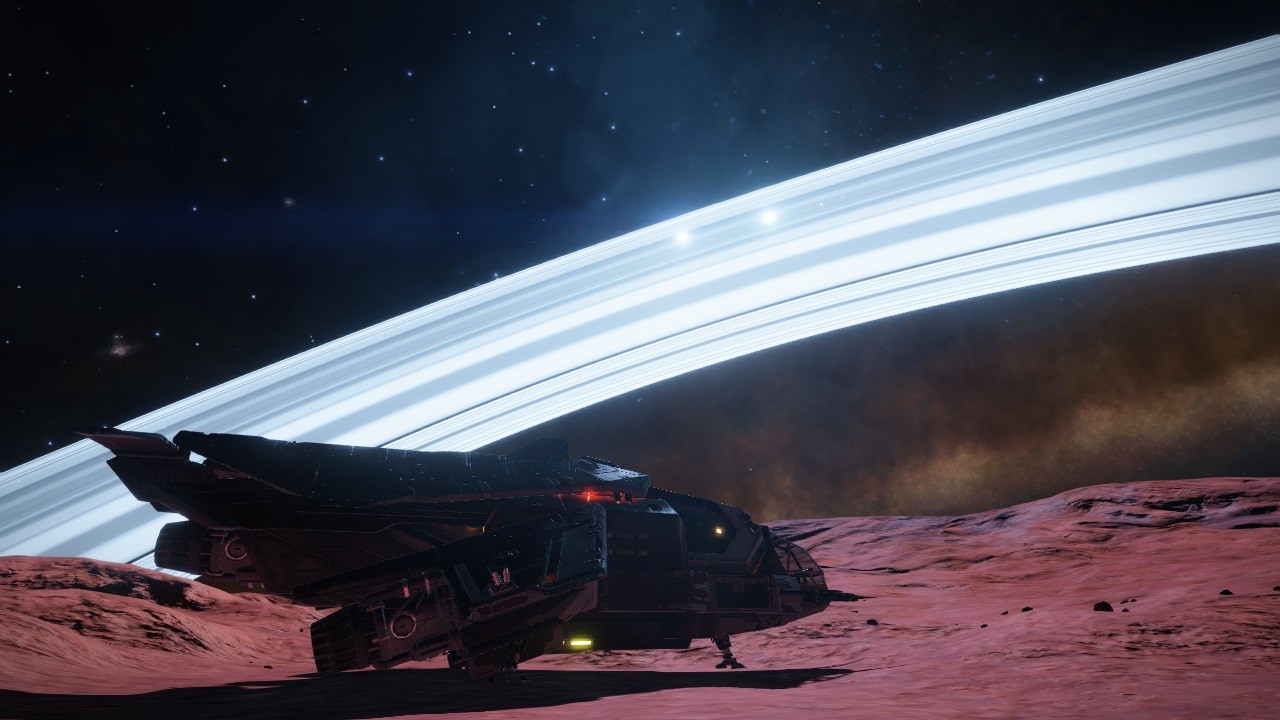
DISTANT WORLDS 2 (PART 13) – THE SHADOW ZONE
7 APRIL 3305 Mors Pit (Bleethuae NI-B D674)
This is commander Jav Marlo, onboard the Hyperion, registering this log at Mors Pit, basecamp of the Distant Worlds 2 Expedition in system Bleethuae NI-B D674, in the Morphenniel Nebula.
The farther we go, the more mysteries we encounter.
The week started fine. On this occasion, I woke up at Tranquility Valley basecamp several hours before the releasing of the itinerary to the next waypoint, so I indulged myself in an animated chat with other commanders gathered there. I even drove around the valley watching the Kraits, ASP Explorers, Cutters and Anacondas landed there, dreaming about being the owner of one of them soon, now that I have the credits earned through my exploration efforts. When driving around I met friendly commander Thudpucker, who taught me how to make my scarab rest over its butt in a vertical position. I aligned my SRV with his and we both performed a particular figure of sun salutation to the gas giant above us, resembling some kind of ancestral ceremony before embarking us on the next stage.
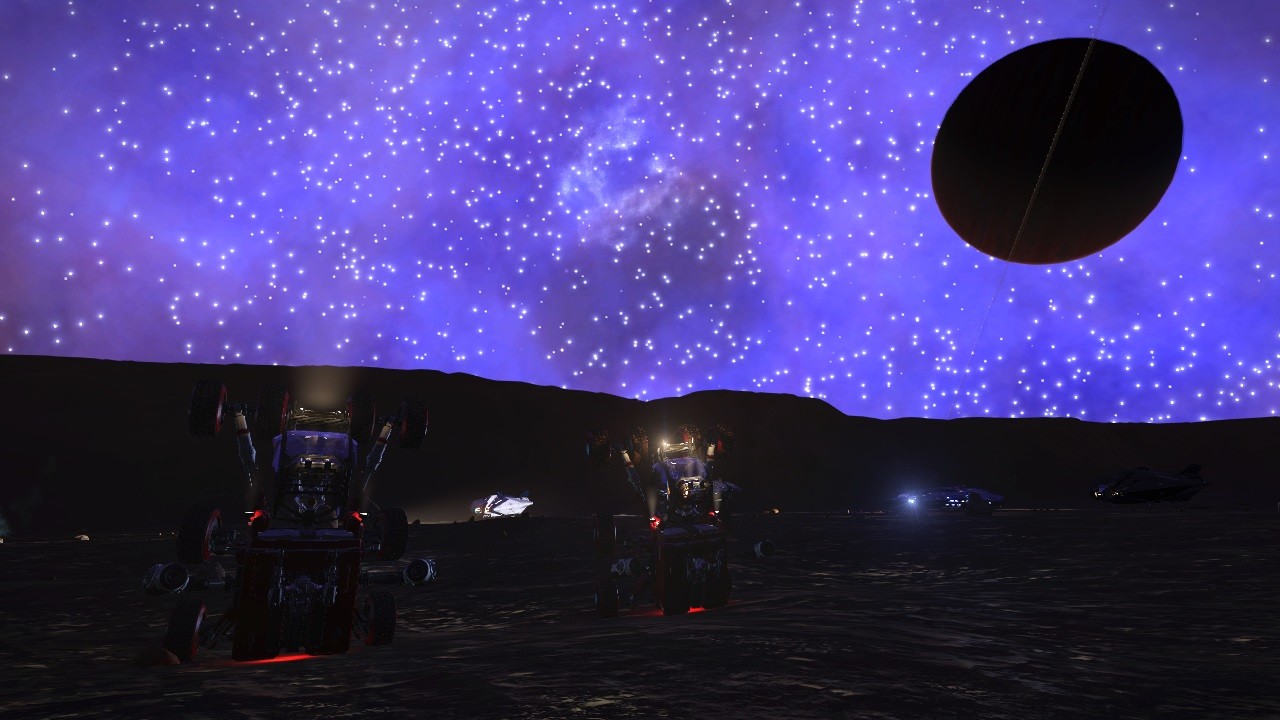
Then it came the transmission of commander Erimus Kamzel with the coordinates of the next waypoint. Most of the commanders wished good luck to everyone and departed.
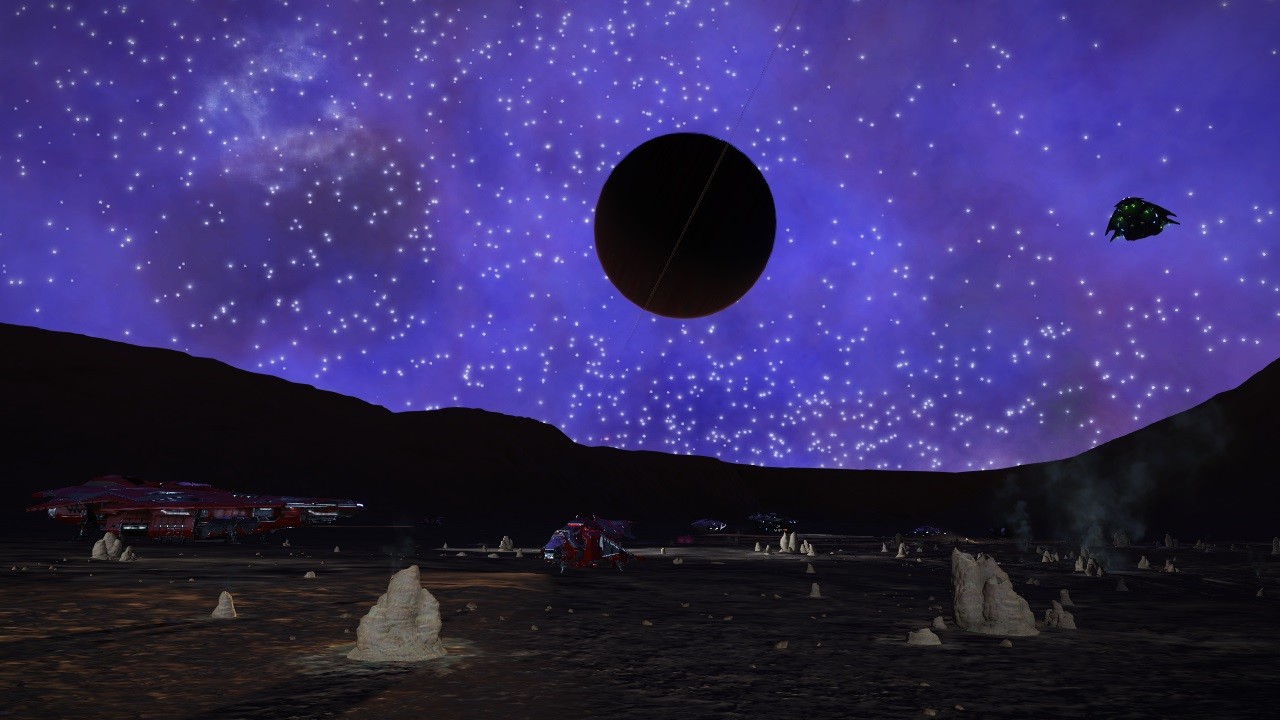
The first point of interest of the itinerary was the Undine Haven, in system Phroi Bluae LS-B d13-744, which contains a neutron primary star and two secondary stars. Its most distinctive feature is that in one of the secondary stars, at a distance of about twenty eight thousand light seconds, has six water worlds orbiting, all of which are terraformable. According to the Galactic Mapping Project database, the term ‘Undine’ refers to mythological water spirits first described in the alchemical writings of Paracelsus.
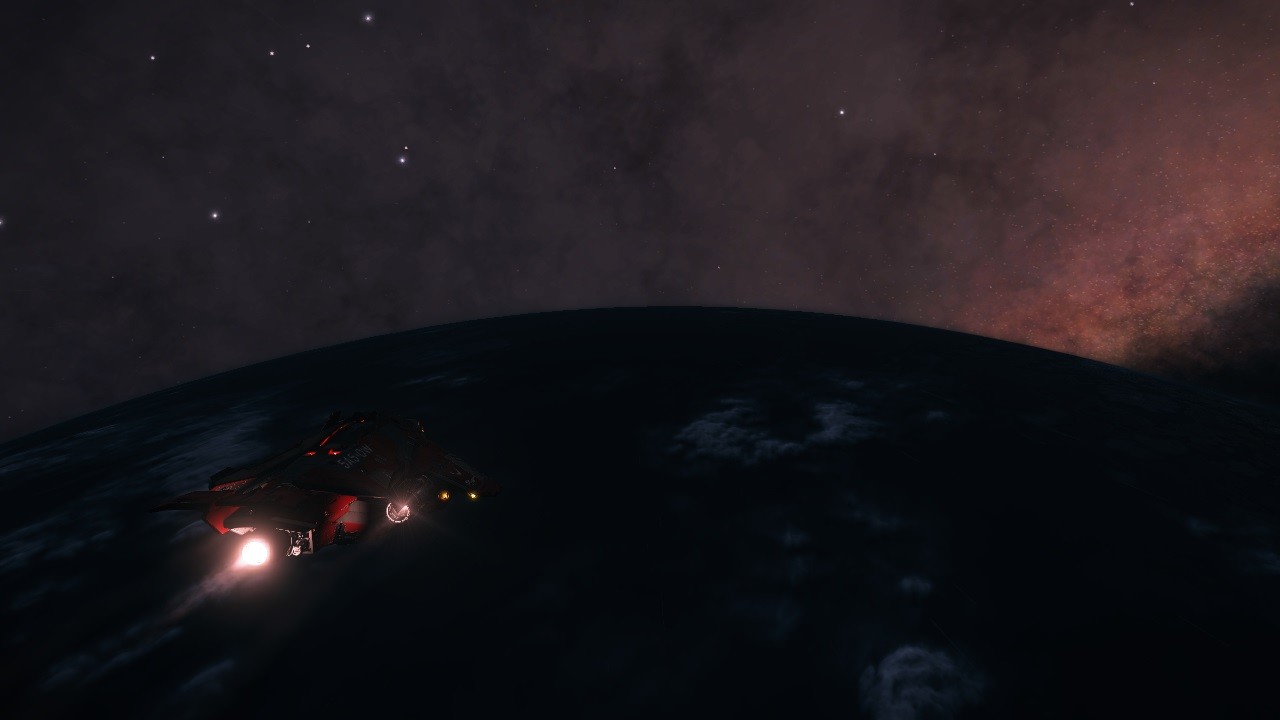
A pity I did not bring my swimsuit with me. From there I headed to the Briar Patch Nebula, in system Hypuae Briae BV-Y e3851, a lone neutron star inside a nebula that has an eerie feel to it as it is the only star there.

Close from there and way above was the Zinnia Haze, in system Hypuae Briae LC-U e3-152, a small planetary nebula located more than a thousand light years above the galactic plane. It has a neutron star as its primary object that gives a blue hue to the nebula when watched from the inside close to the arrival zone.

But when observed from the nearby system of Hypuae Briae LU-A b33-10 it shows its true and beautiful purple and pink colors.
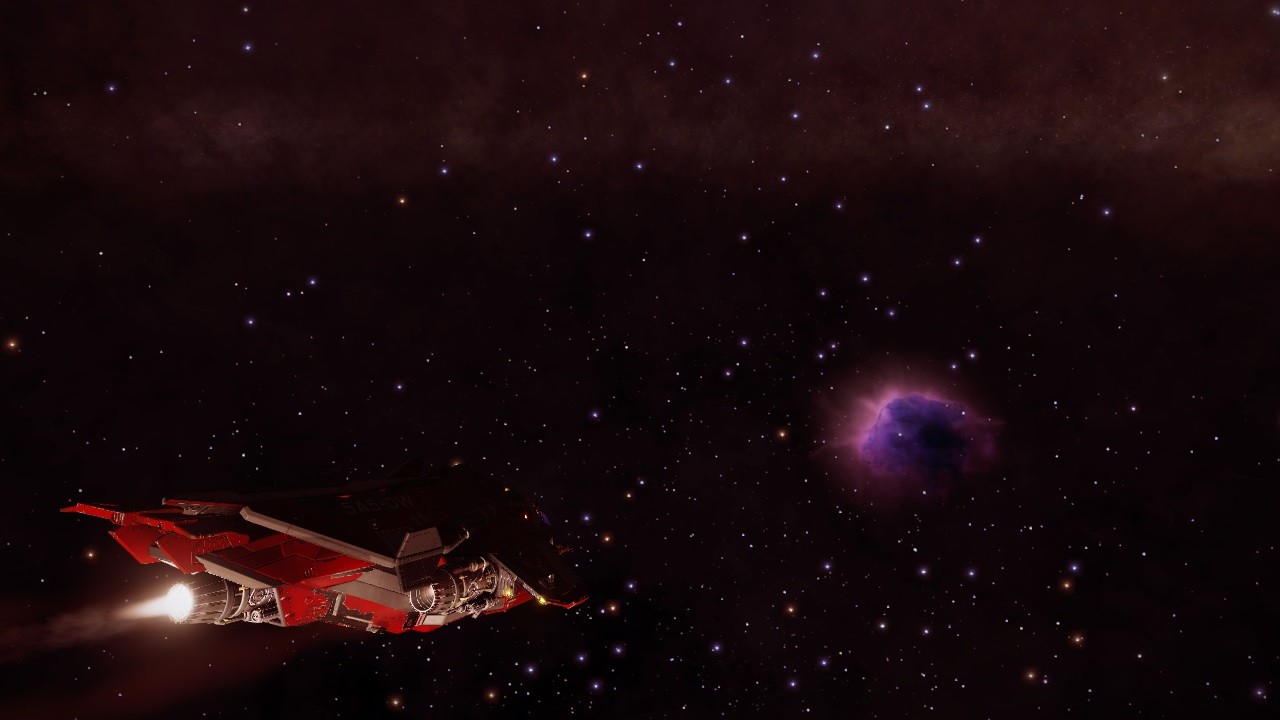
Down again it was the Hydrangea Nebula, in system Hyuqeae MT-Q e5-4335, a small nebula with bright red, orange and green colors that gives it a very floral appearance, hence the name. It has a neutron star as its centre and a collection of planets with many airless moons.
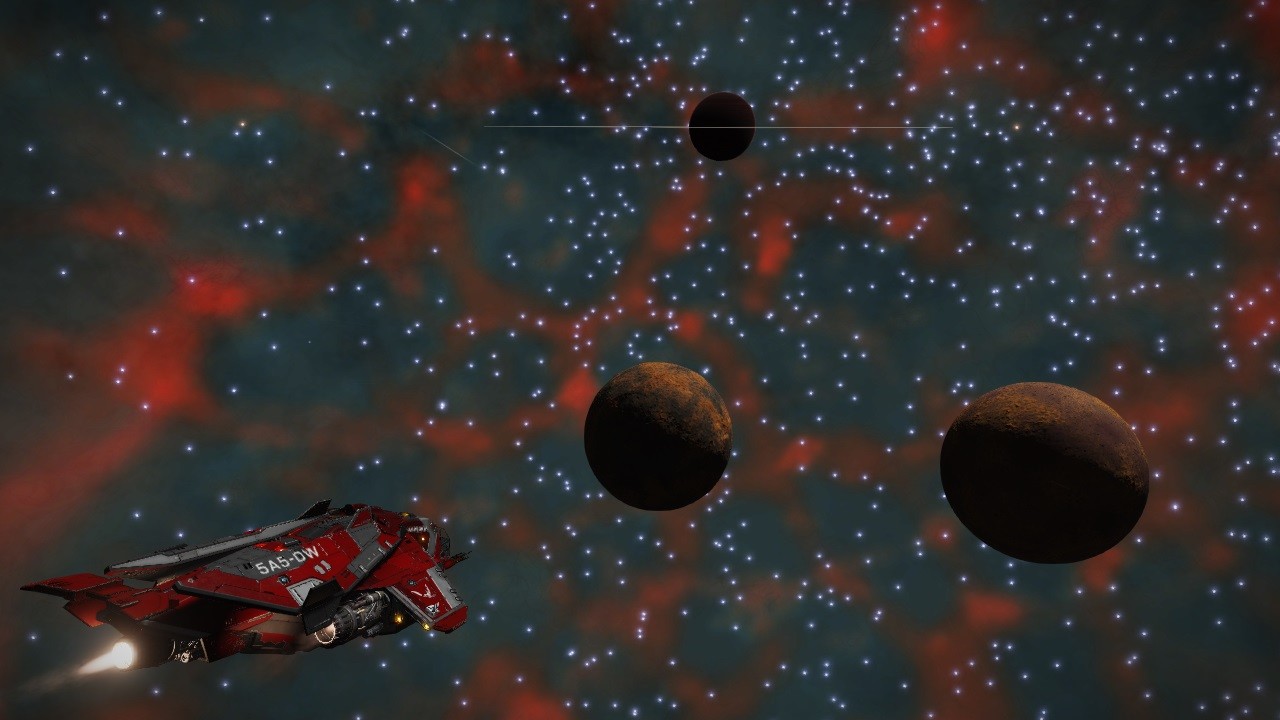
And very near it was too the very impressive Magnus Nebula, a large vivid purple nebula along the inner Perseus Arm near the galactic core. According to the Galactic Mapping Project database, it is possibly one of the largest nebulae so far discovered on the far side of the galactic core. Magnus Nebula contains several thousand star systems, including two neutron stars and three K-Class Giants. In system Hypuae Briae YQ-Z c28-339 I found two big high metal content planets sharing an orbit that had the tag of being discovered by commander Erimus Kamzel himself and landed in one of them for a rest. The 2.5 gravity tensioned my muscles and made all my body ache, but I decided to endure it since I was feeling very weak after so many days travelling with no gravity. All the space explorers loose muscular mass when out in the black, it comes with the business.

The Magnus Nebula is situated just seven hundred light years outside the mysterious borders of the Bleia Permit Zone. Commander Erimus Kamzel warned us about that through the Fleetcomm channel. “If route plotting fails commanders will need to look for passable sectors skirting around, above, or below these restricted sectors in order to reach the Morphenniel Nebula”. Restricted sectors? What does that mean? Let’s find out.
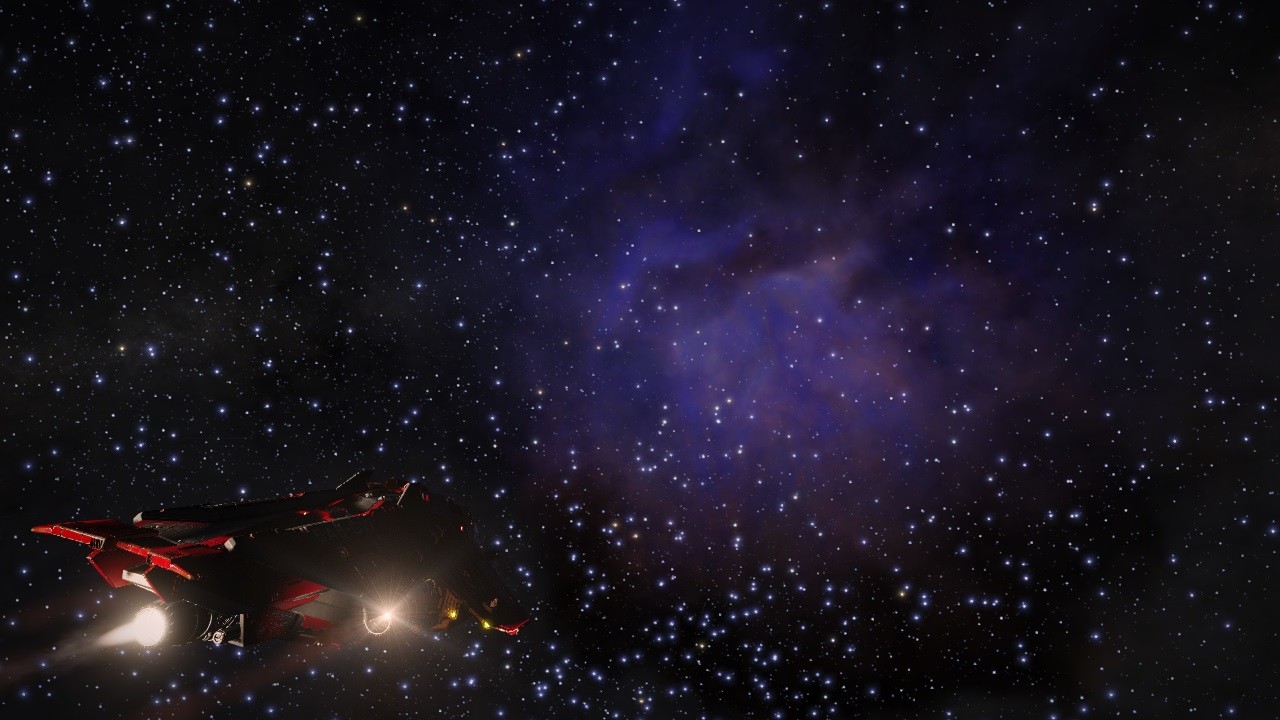
I arrived to the Infinite Bonds in system Hypuae Briae YF-E d12-2760 without difficulty and found the stunning pair of Earth-like worlds there with their beautiful purple colors sharing their orbit just 0.25 light seconds apart.
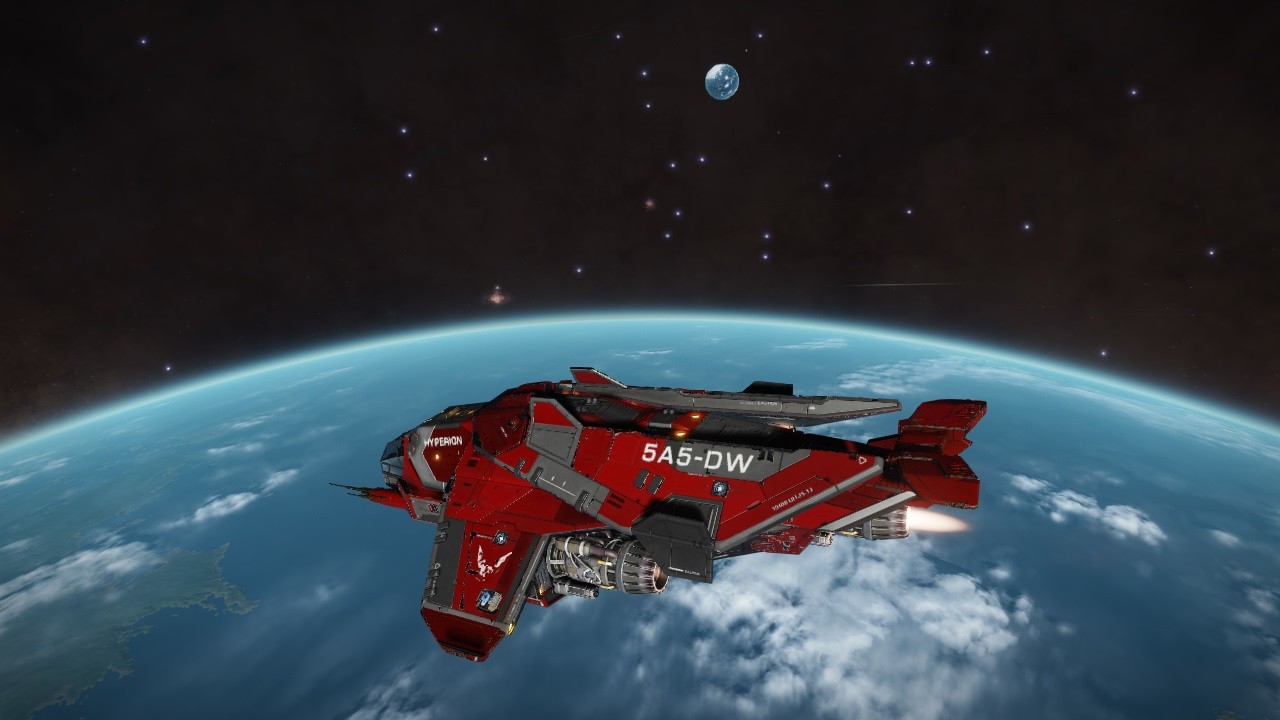
And there is when the problems started. I opened the navigation map in order to lock the next system of the itinerary Vegnoae BK-R d4-1105, also known as the Neighboring Necklaces, but the computer was not able to plot a route. What the hell! I guess that was what Erimus Kamzel was talking about.
I randomly tried to lock on systems in the Vegnoae sector until I found one that the computer was able to plot a route to, and I headed on that direction. It seemed that the problem came from the systems in the Bleia 3 sector. When I tried to lock on them the computer it simply said: “unknown permit required”. Unknown permit? Here? I know that some systems require a permit in order to travel there, like Sirius or Alitoh. Indeed, it took me a while to get the permit to those systems. But why an unoccupied sector so far from civilized space will require a permit? Or, maybe, is not so unoccupied.
I managed to skirt around Bleia 3 and arrived to a system that was well above the Vegnoae BK-R d4-1105. From there, the navigation computer was able to plot a route and I finally made to the Neighboring Necklaces, two planets of the primary star in Vegnoae BK-R d4-1105 system that are in a binary configuration with such a tight orbit that their rings almost touch themselves. The contrast between these two worlds and their necklaces of rings is also remarkable, being one an airless landable rocky world and the other a gorgeous lava world. A great camping spot.

I checked Galactic Mapping Project database looking for other sectors in the far regions of space that were permit locked too and found there were many of them: Bleia, Dryman, Hyponia, Sidgoir, Froadik, Bovomir, Praei… And there were many others closer to Sol like Col 70. Wait! I remember now. Col 70, that was the sector where Salomé found something. Something that costed her life. Something important enough to rally hundreds of bounty hunters that tried to prevent her for coming back to the Bubble with her secret while thousands of independent pilots tried to protect her. Somehow, she must have managed to get into there. That shadow zone. But, how could she? It always amazes me how she, Salomé, managed to be involved in every mystery and conspiracy that puzzles the galaxy: the battle over the Prism system, the conspiracies within the Federation and the Empire, the Dark Wheel, the Children of Raxxla, the Zurara, the INRA bases and the Col 70 sector mystery. Is it possible that they can be all linked? But how? I fear that secret died with her.
As far as I know, space navigation depends on the Pilots Federation GalNet system, that is installed in every independent starship. The GalNet system is not only a star chart, it is also a communication system that provides newsfeed, markets information and many more. The Pilots Federation is not only the dominant provider of this information, they also manufacture the hardware and software serving this data that is embedded in every starship and space station. Summarizing, they control the communications net and the navigation systems of almost everyone. And that is a lot of power. They claim to be politically neutral, but all their endeavors are involved in secrecy.
I could understand that such an elusive and mysterious organization like the Pilots Federation locks the access to some systems in order to protect dark secrets. Conspiracies are the fuel of politics nowadays, or always have been. But we are talking of huge sectors of the galaxy blocked here. Places that were beyond the reach of any starship just five years ago. This cannot be just because of the Pilots Federation. There must be something more. Some other reason behind this shadow zones.
The system Vegnoae WE-R e4-9257 and the Eos Nebula was just six hundred light years away and I did not have problems plotting a straight route there. The place takes its name from Eos, the Greek goddess of dawn, because of its rosy calming colors.

I found a notable stellar phenomena within the nebula, a yellow Lagrange cloud filled with solid mineral spheres, rubeum metallic crystals and some serious electric activity.
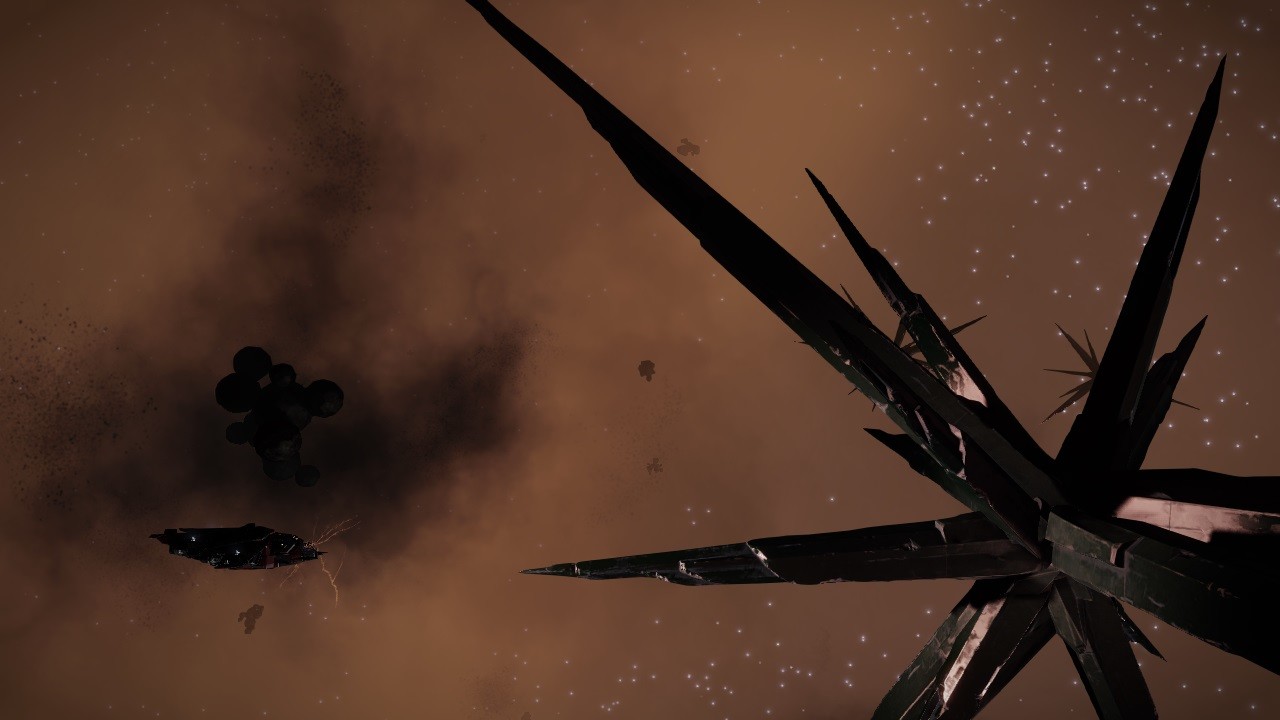
I thought it was time to head for the Morphenniel Nebula the closest visitable nebula in the middle of the mysterios shadow zone of Bleia. But it was not easy to plot a route to the system Bleethuae NI-B D674, where the base camp was. I had to approach little by little, locking in the navigation computer the systems that took me in that direction while avoiding the shadow zones of the Bleia sectors in the way.
The process was tiring, and I had been flying without resting for days, so I decided to make a stop in the way before reaching the basecamp. Anyhow, I was way before schedule. I was looking for a suitable place when I jumped into system Phroi Byoe FE-B c29-23, which contained a class V gas giant orbiting very close to the secondary star of the system. I decided to make an approach to enjoy the views.
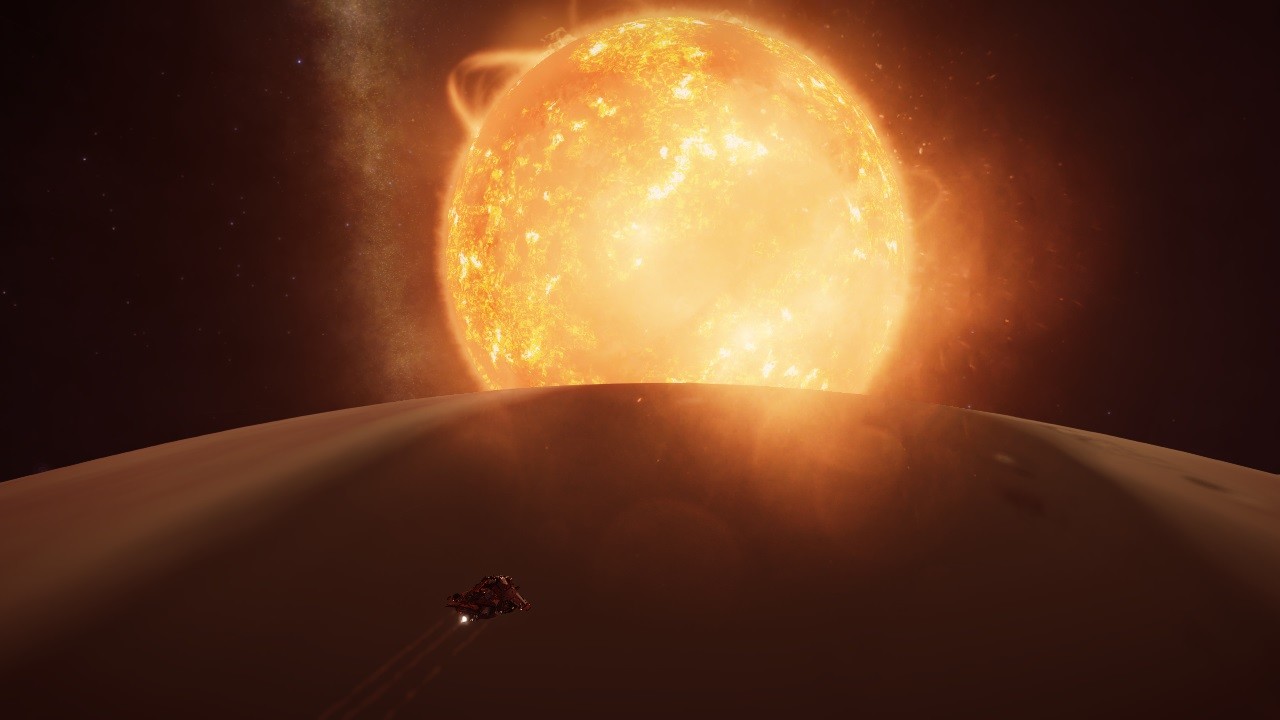
I think I have never seen a gas giant so close to a star. The view was mesmerizing. I flew around the planet before leaving looking for a place to land.

I landed on the third moon of the primary star, and I could enjoy a beautiful binary sunset that reminded me of an iconic scene in an ancient movie from the twentieth century that told a story that happened a long time ago in a galaxy far, far away.
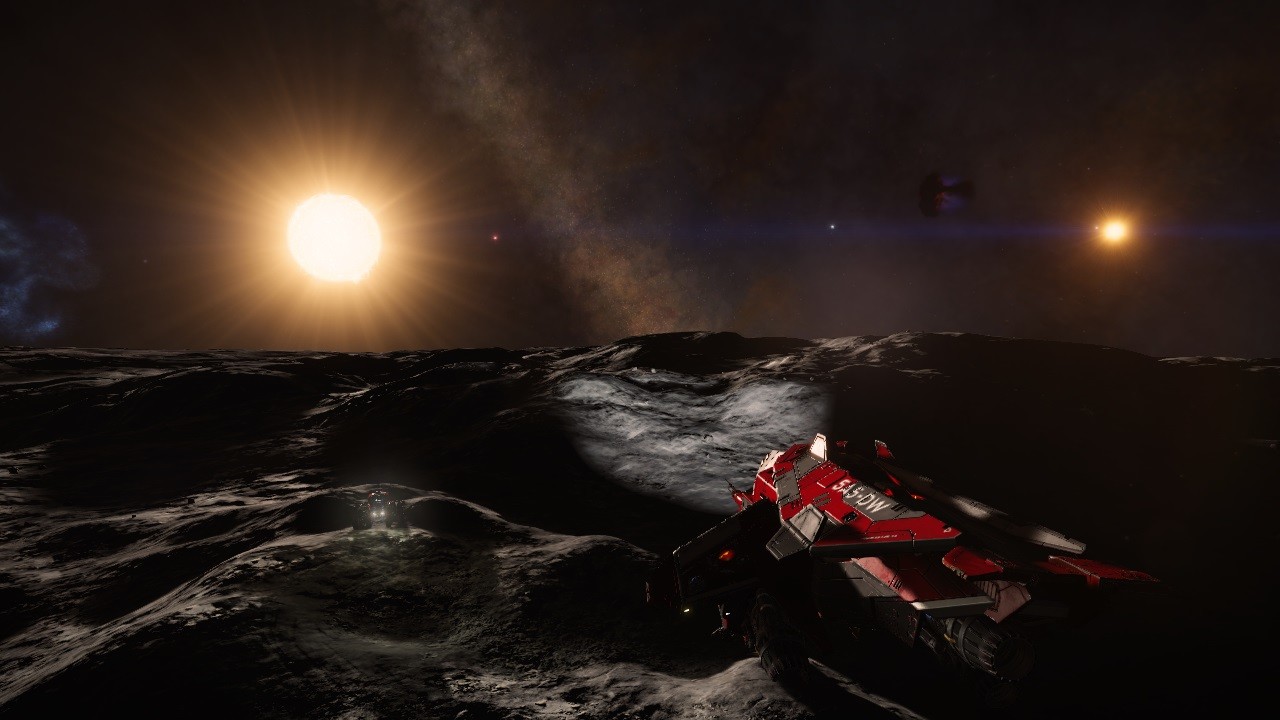
After a short rest, I finally was able to plot a direct course to system Bleethuae NI-B D674. The view of the Morphenniel Nebula from Bleethuae UH-E b1-14 was majestic. It is said that, with its bright orange-white tip that falls away to darker orange and red colours, it resembles from some angles the tail fire of a rocket.
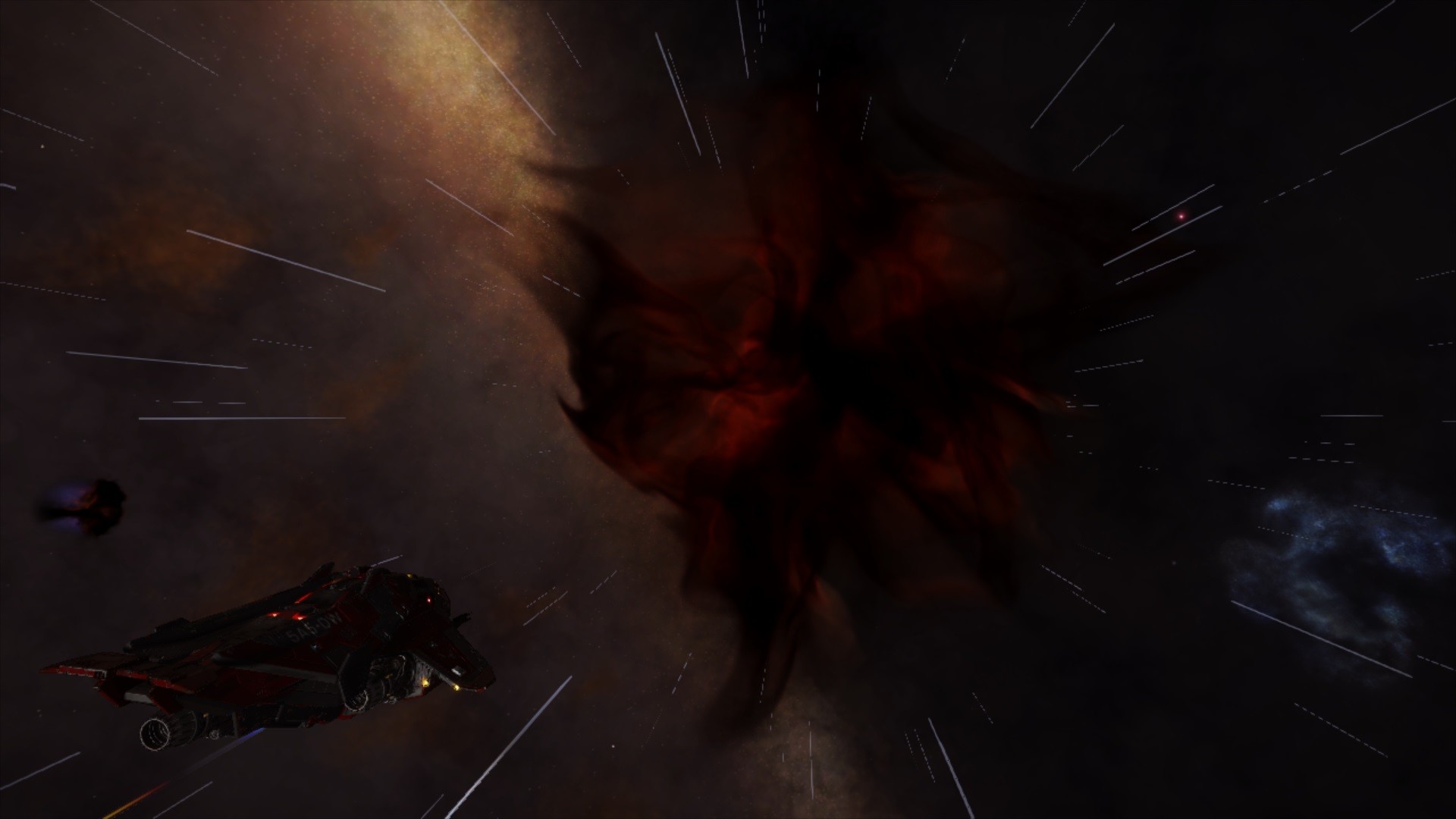
I had arrived to the basecamp seventy two hours before the release of the next waypoint, so I expected to be alone there, but soon I noticed the presence of other commanders.
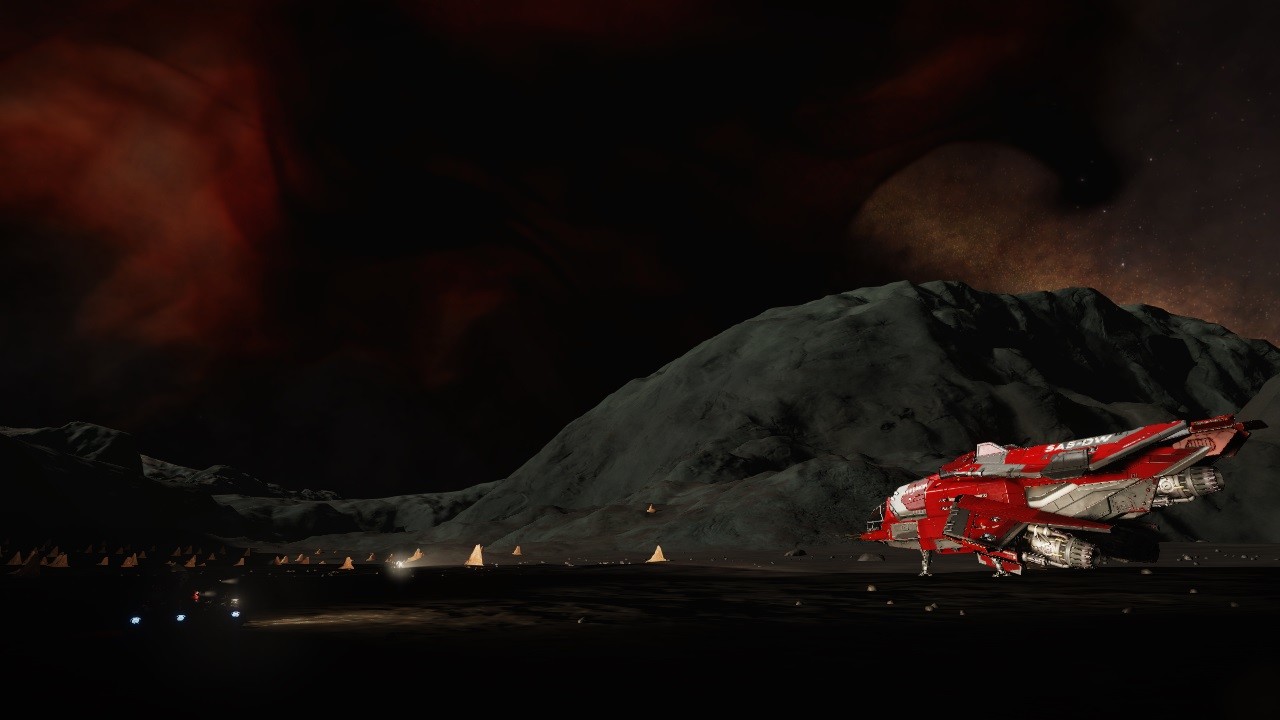
I decided to ride into the SRV and say hello. I had just left the Hyperion when I heard a loud boosting sound coming close right behind me. Out of nowhere, a superfast Taipan flew over me did a loop and stopped hovering right in front my vehicle. It was commander Hyundai35 closing by to say hello. He greeted me, performed a pirouette and lift up boosting leaving a cloud of dust behind him. I love these Taipans. They must be great for surface exploration. I have to get my hands in one of those as soon as I am able.
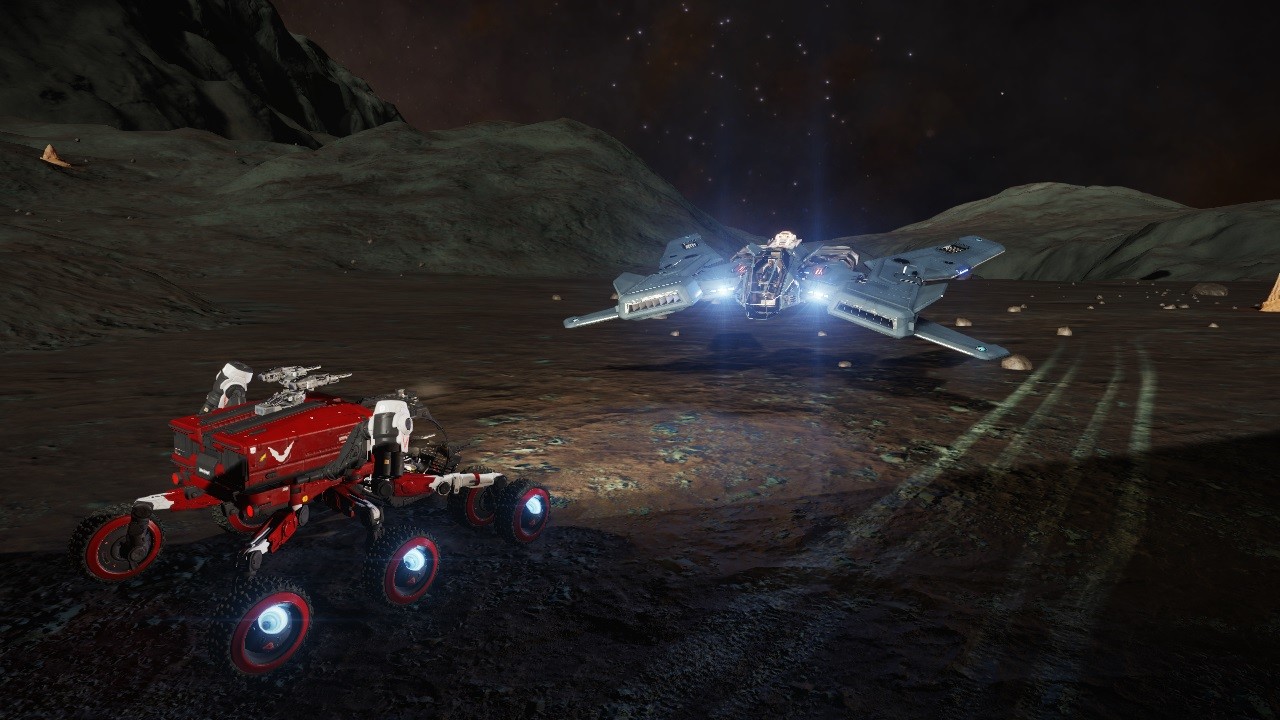
It seemed that commander Hyundai35 was not there alone. A couple of minutes later he came back accompanied by commanders Jipsee and Liilee, and they were flying guardian fighters. Amazing technology! I need to find a way to contact the engineer known as Ram Tah and get some Guardian technology too. They approached my humble SRV too and greet me amicably. It seemed that we were the first commanders to arrive to Mors Pit. That is one of the best parts of this expedition. The camaraderie between commanders from so many different allegiances. Here, in the black, we are all explorers, and I think that feeling of camaraderie gets tighter the farther we find ourselves away from civilized space.
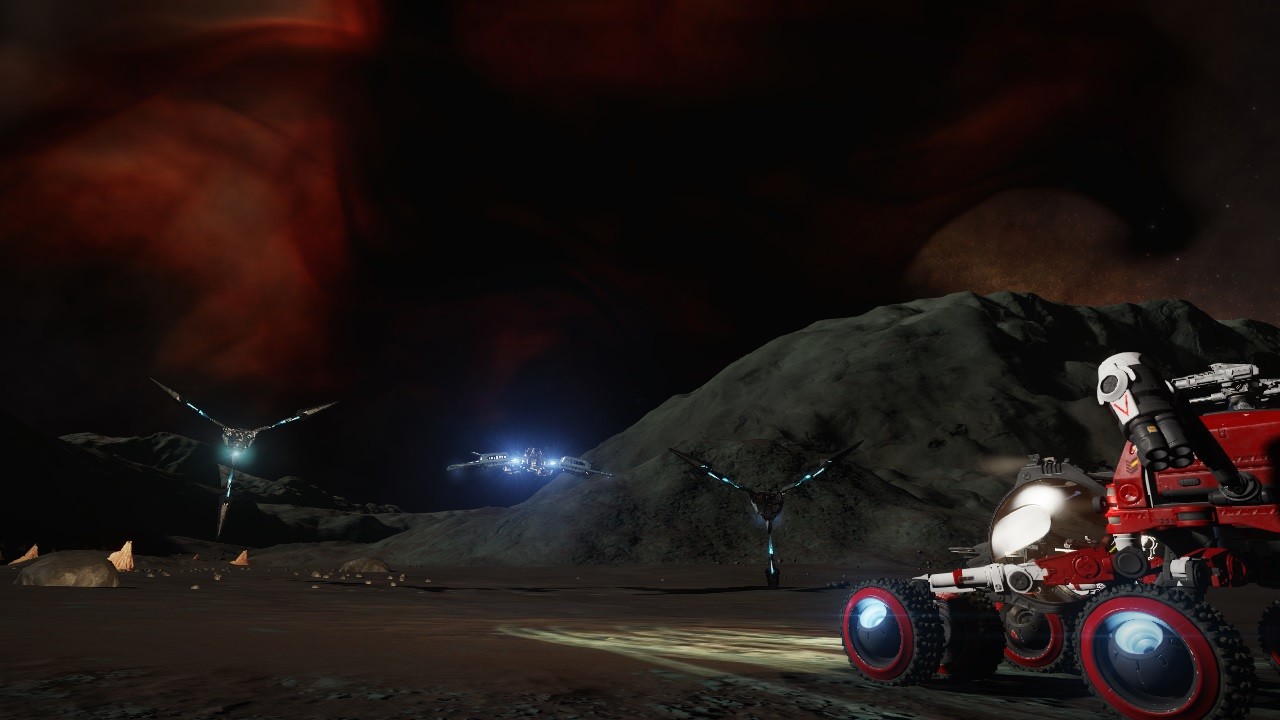
In the following two days, different commanders came and go. I took the opportunity to exchange thoughts with them about the crossing of the shadow zone of Bleia, hearing all kind of theories. Some say that these sectors have higher than usual density of ammonia worlds. Others talk about mysterious distant objects and sightings. But the most common theory says that these could be a region of space controlled by the Thargoids. Alas, none of these rumors has been verified. I am afraid that the mystery of the shadow zone of Bleia will continue in the shadows for the time being.
Jav Marlo signing out.
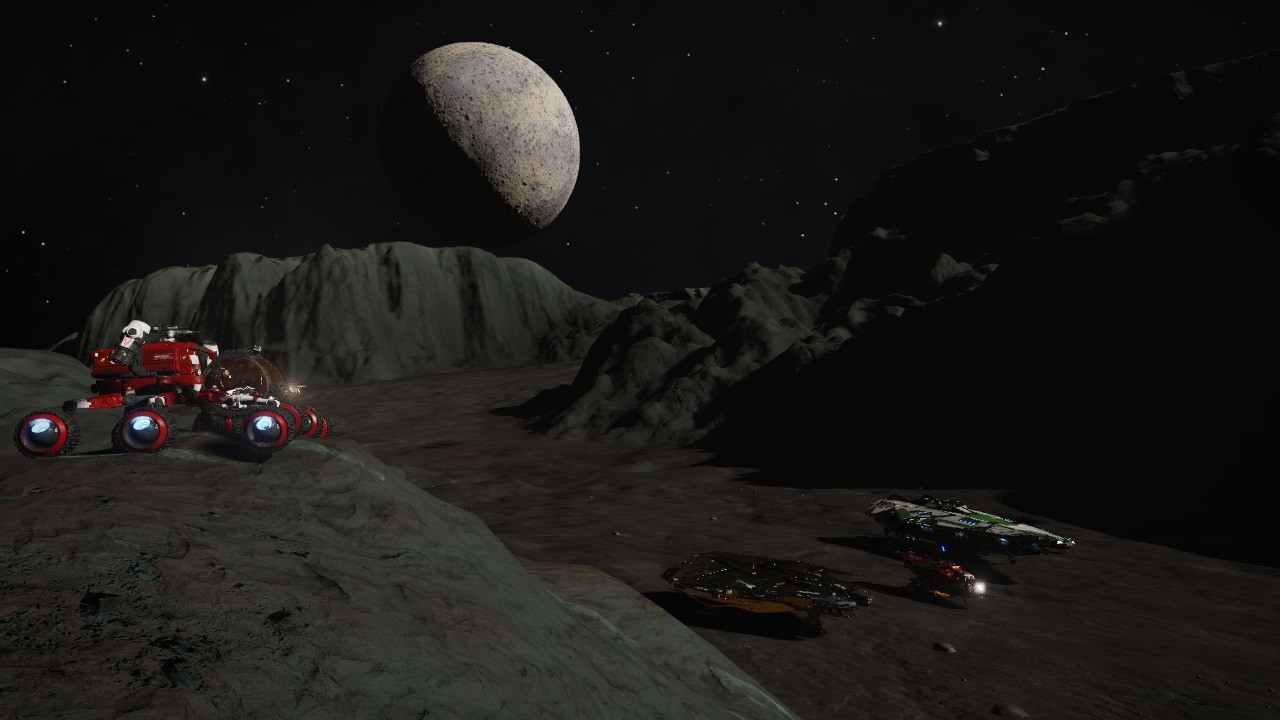
DISTANT WORLDS 2 (PART 12) – THE DISCOVERY OF A NEBULA
31 MAR 3305 Tranquility Valley (Phroi Bluae QI-T e3454)
This is commander Jav Marlo, onboard the Hyperion, registering this log at Tranquility Valley, basecamp of the Distant Worlds 2 Expedition in system Phroi Bluae QI-T e3454, also known as Cerulean Tranquility.
We are closer now to our destination: Beagle Point. If everything goes as planned, we should be there in the next weeks. Meanwhile, the number of expeditioners has decreased significantly. This is still a huge community endeavor, but I can tell that our numbers are thinner after reaching the core. Nobody said it was going to be easy. According to the Galactic Mapping Project database, who is following the progress of our expedition, 2,496 commanders have died on this trip, I guess mostly because of crashing when trying to land in planets with high gravity and victims of terrorist that had been harassing the expedition. 922 commanders self-destructed their ships. Space-madness, getting stranded, who knows what happens in the head of commander to force him to commit suicide. And 7 commanders have abandoned. The rest of us still go on. To the black, always to the black. The star density is still huge here, so close to the core, but that will change soon.

I think that my ship, the Hyperion, and I are ready for the next stage of this trip. We made it so far with no major problems. I believe we can reach the end. When I was at Hades Edge, in the top of the galaxy, I got perspective of the incredible voyage this is. The immensity of the galaxy, observed from that height, was overwhelming, and the limits of the milky way were visible, far away, on the horizon. Our final destination: Beagle Point. It was hard to abandon the comforting warmth of the giant star Goliath and start the descend.
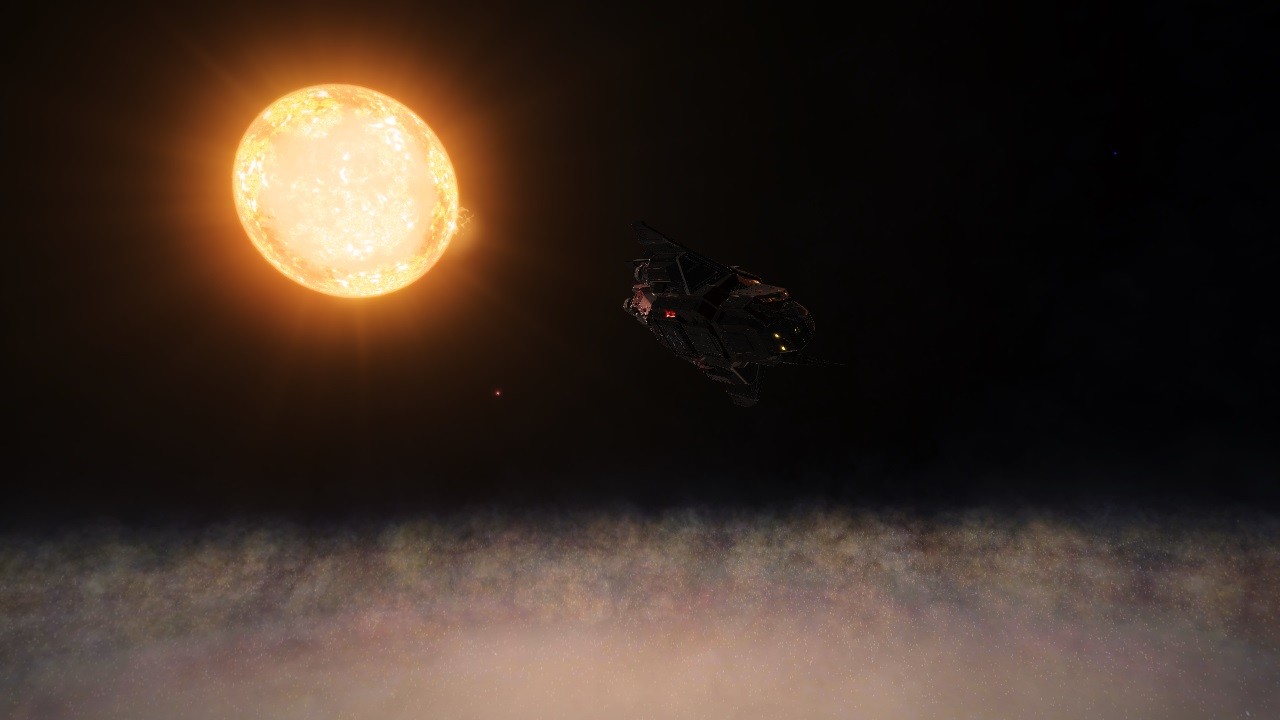
My first stop was at system Schee Bli AA-A h300, the Remnants Trio, which contains many wonders, being one of them a ringed white dwarf.

The system contains many other stars orbiting its main black hole, and another white dwarf and a neutron star can be found orbiting a secondary black hole not far away from the heaviest one. If you get enough close to this black hole, it distorts the light of the stars around it and the ones on the background creating incredibly beautiful views.
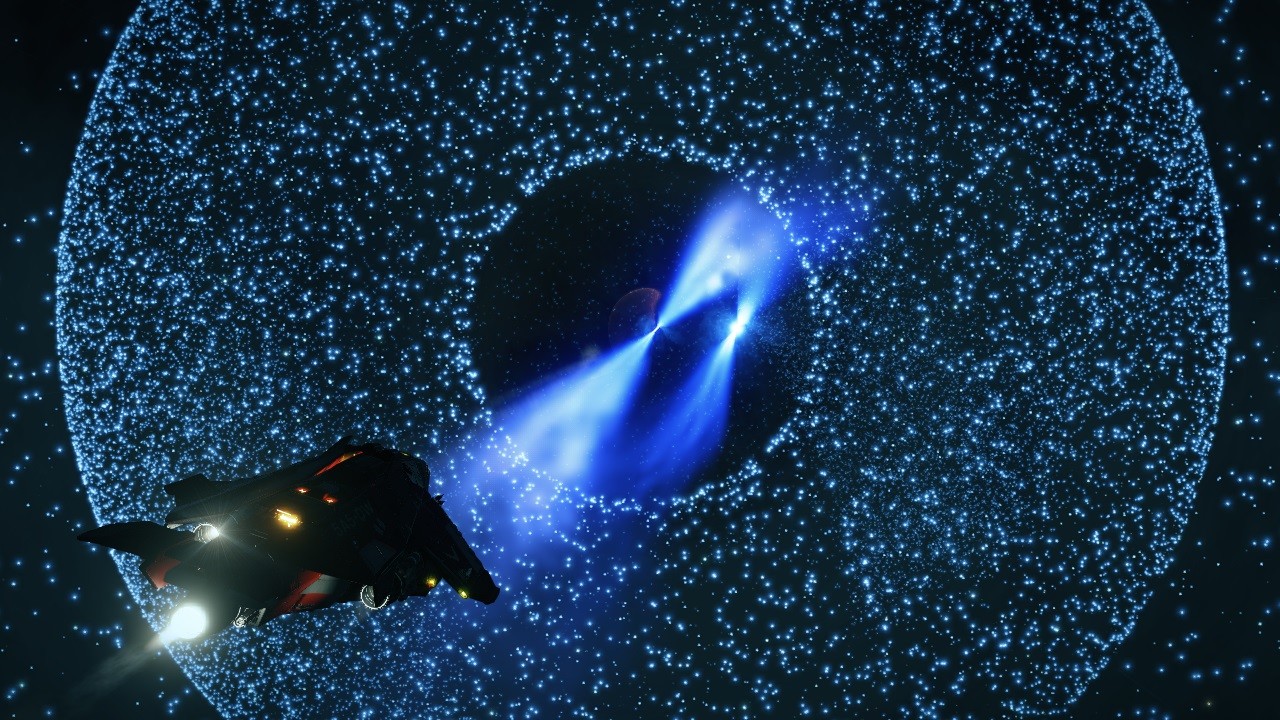
From there I headed to system Braisoea UQ-C d13-6108, also known as the Gaesous Twins. The system contains a binary pair of Earth-like worlds orbiting its neutron star. I approached the ELWs to take a closer look at their surfaces and could see how violent their climate looked from above, probably result of the influence of the neutron star.
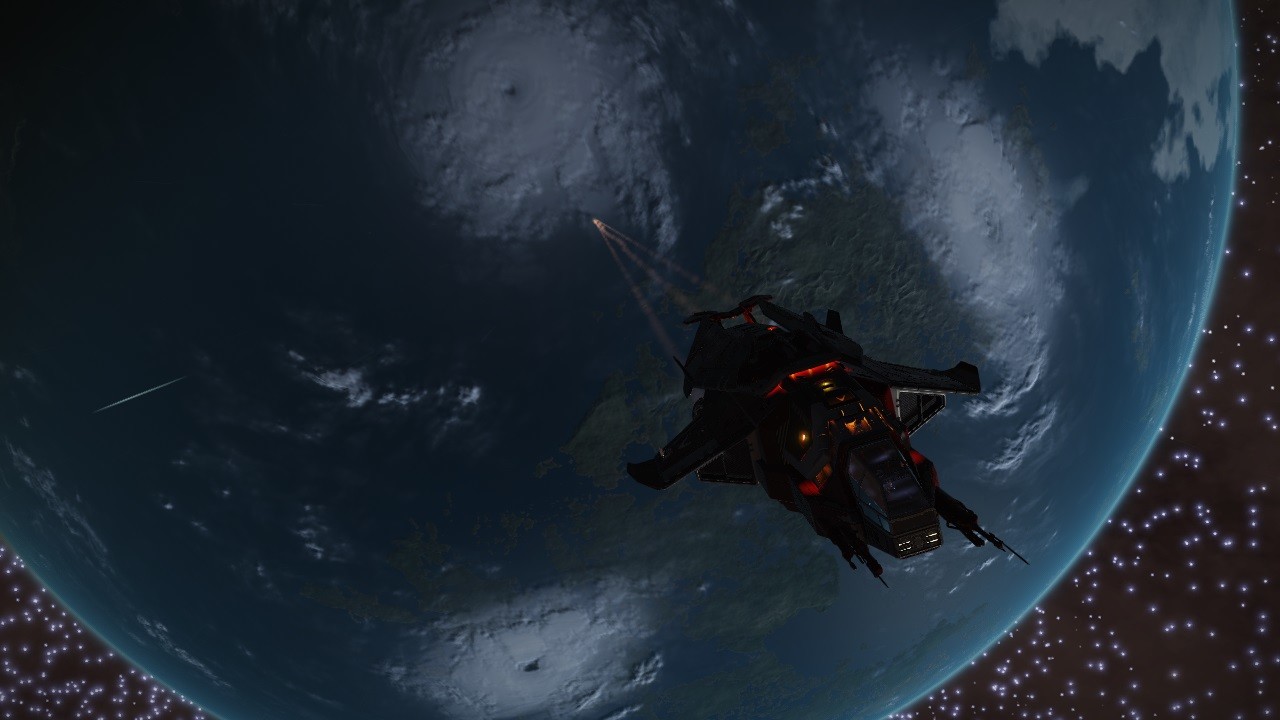
The next step was the Arach Nebula, in system Lyaisae PJ-Y c14-472, but on the way there I made a significant discovery. The biggest ammonia world I have ever seen. And it had an ice ring around. I took a closer look of Braisoea JS-L c23-493 A 6. It had nearly thirty times the mass of Earth and a gravity of 2.8. The surface temperature was just 185 K. I thought that, if it is true that the Thargoids come from this kind of planets, they must be accustomed to incredibly low temperatures.
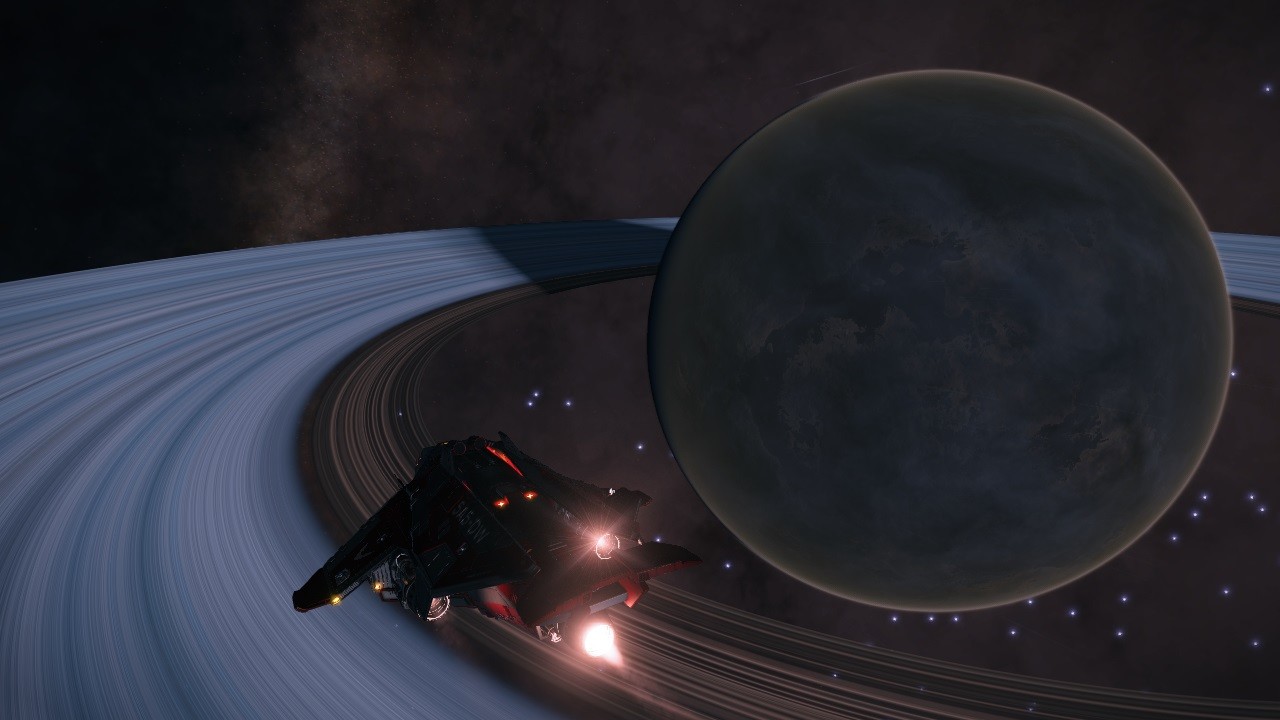
The Arach Nebula is a planetary nebula with a neutron star core that can be observed from system Lyaisae PJ-Y c14-472.
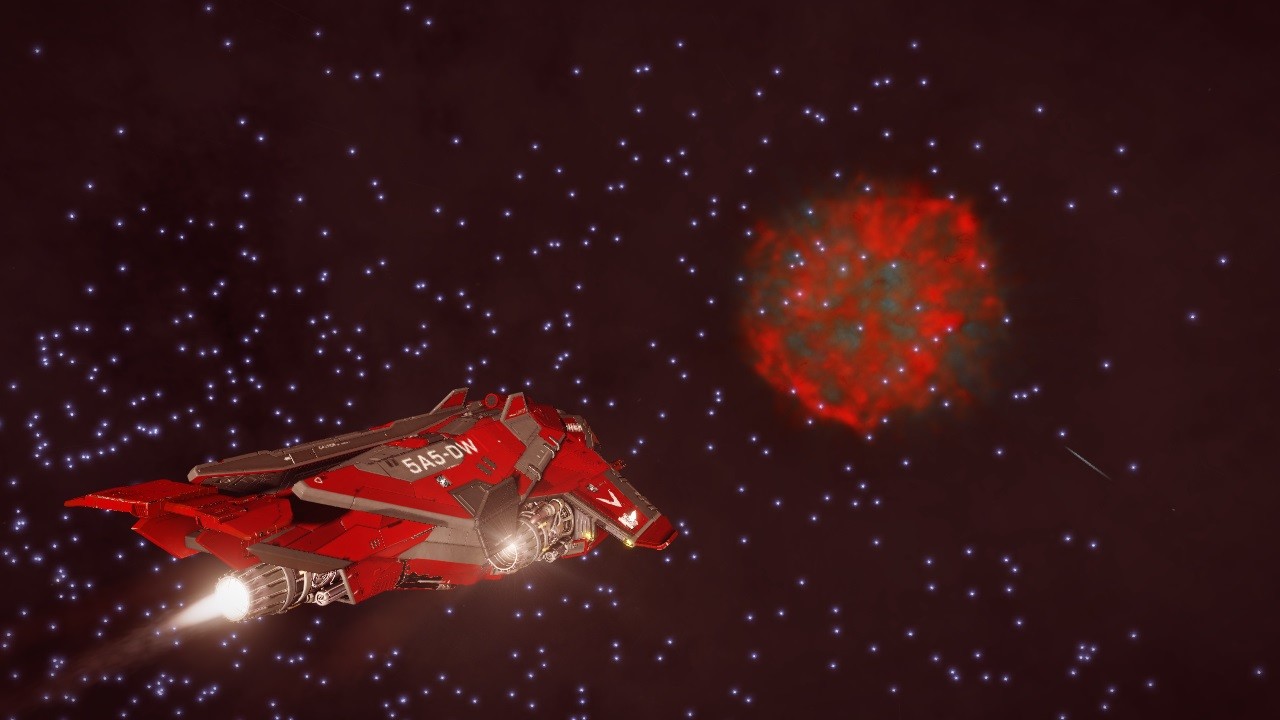
But the true core of the nebula is system Lyaisae SY-S e3-581 which contains a water world that, according to my sensors, it has never been mapped. I fixed that and approached the neutron star in the middle of the nebula to gain FSD impulse for the next jump.
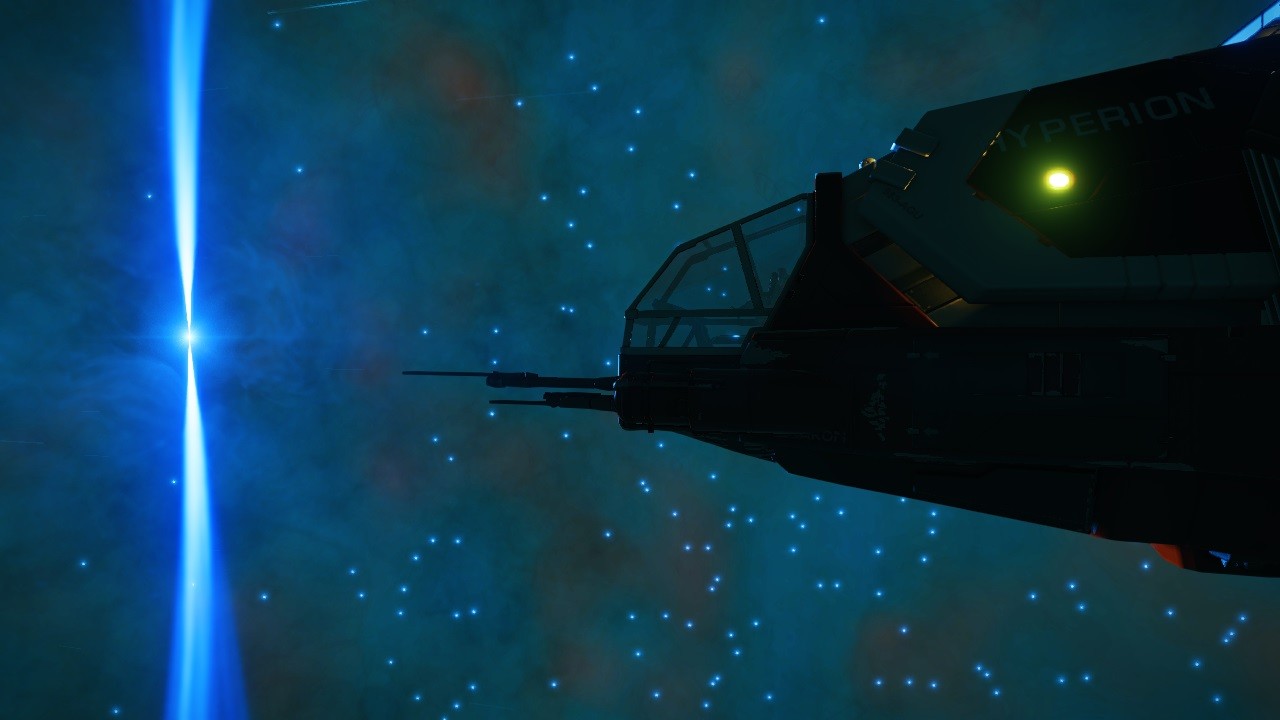
Some hours later I was watching the nebula known as the Iri’s Misive from the nearby system Lasoae JZ-Y c1-315.
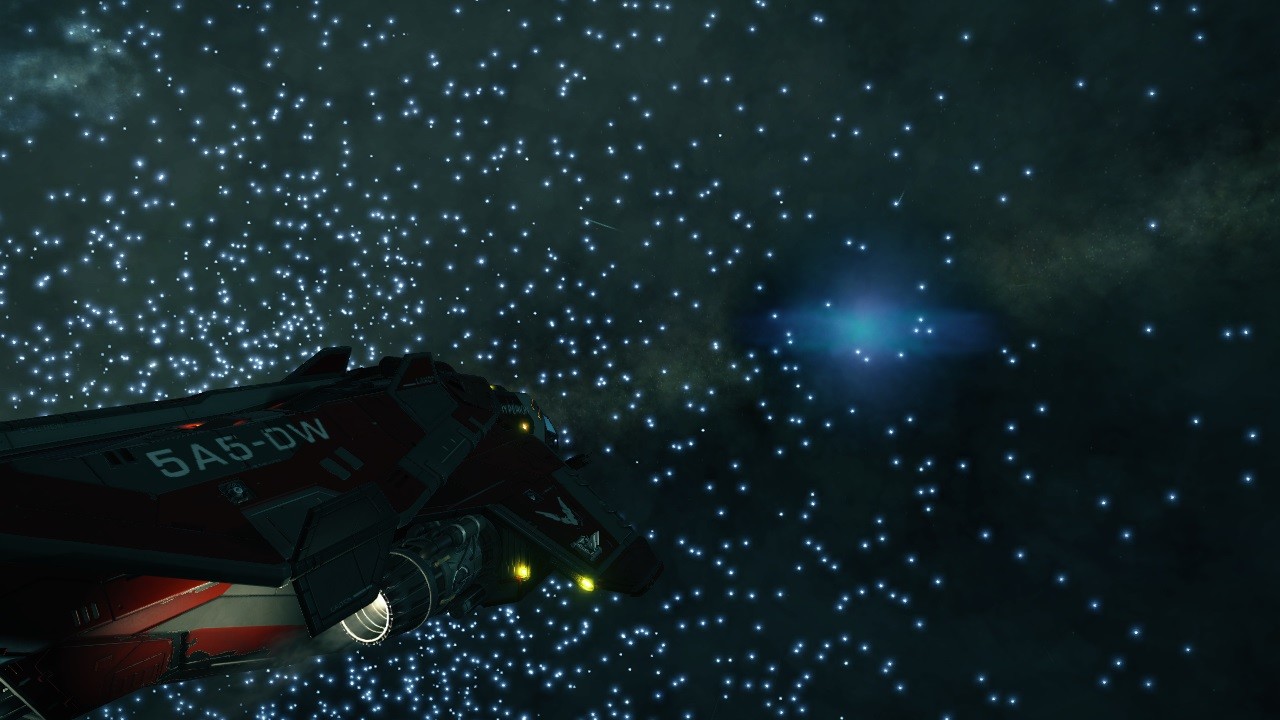
But the best view is from system Lasoae BF-A f810, and this is because a black hole was discovered there during the Perseus Survey expedition. It is just seven light years away from the nearby green and blue planetary nebula so, when you try to look to the nebula through the black hole, the light distortion creates an amazing gradient of colors blue, green and purple, hence its name. As the notorious explorer and chronicler commander Obsidian Ant would say, the experience can only be described as utterly beautiful.
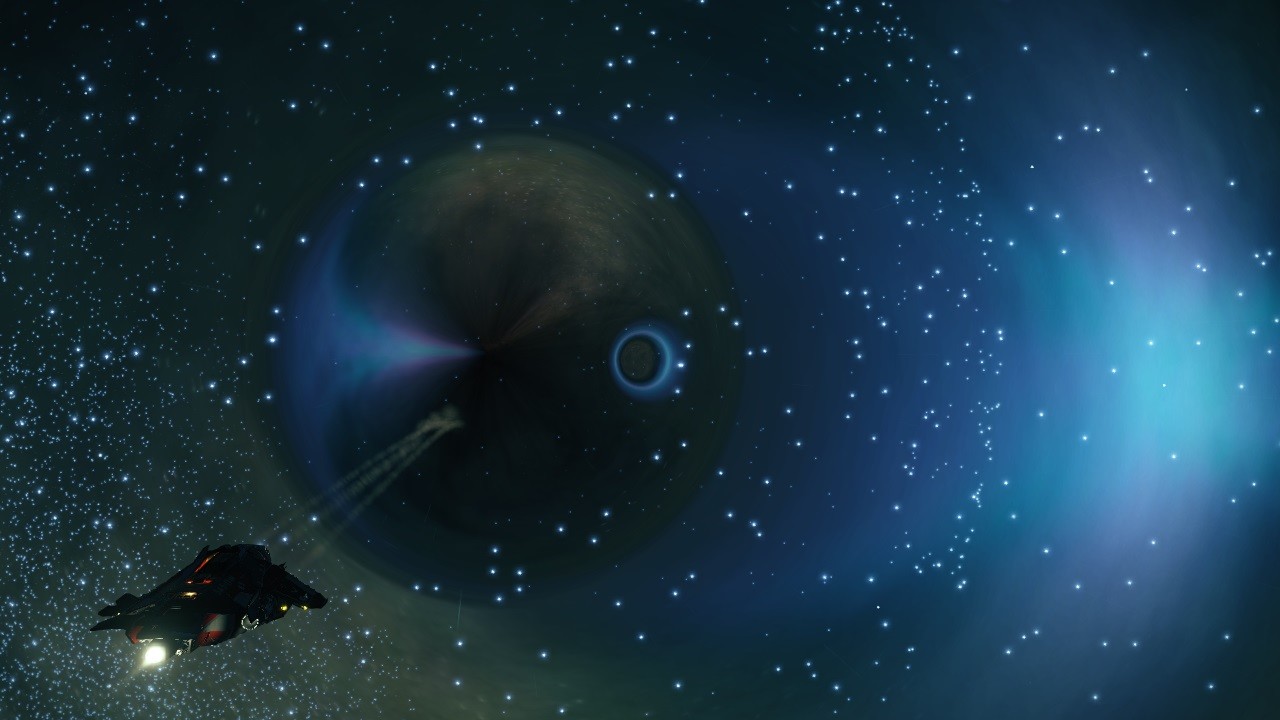
After enjoying the rainbow caused by the black hole, I jumped to system Lasoa AP-A e6892, the very heart of the nebula with its single neutron star. And from there I aimed to system Lyaisua SJ-Z e7708, also known as the Blue Rhapsody Nebula. There I found a planetary nebula caused by a large supernova remnant with varying shades of purple and blue. The system also has fifty stellar bodies orbiting a single neutron star.
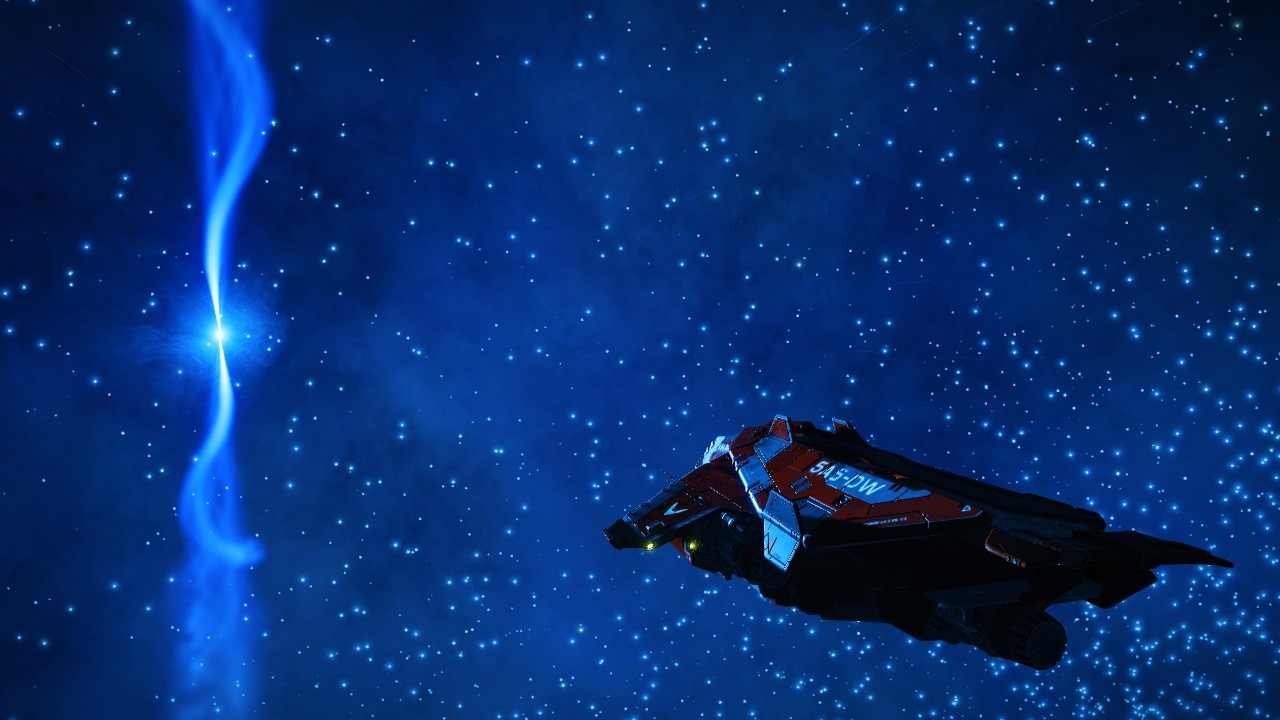
And one thousand and five hundred light years bellow, there was the system Brairee KD-S e4-2776, also known as the Forgotten Twins Nebula. Little is known about this place. According to the Galactic Mapping Project database, during the original Distant Worlds Expedition, the Eleu Exploration Vessel Velsheda came across this beautiful double nebula while in transit from the Green Crystal to the Magnus Nebula. No more description or pictures in the entry.
I flew around into the system and between its many gas giants mesmerized by the views. Some of them are in very close orbits to the others, making it possible to observe at plain sight three ringed gas giants at the same time, with the neutron star shining in the distance.
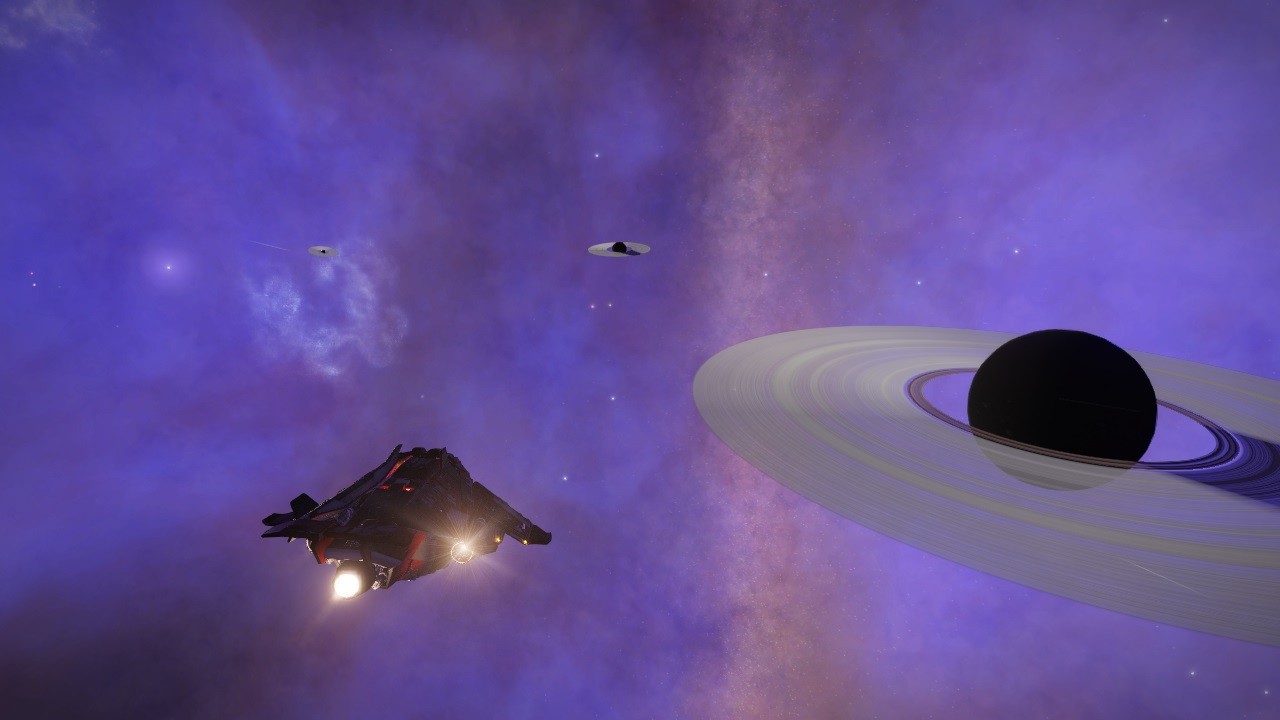
Before continuing with the trip, I jumped to the nearby system of Brairee RN-U c18-786 to better watch the nebula from afar. I took some pictures and made mental note to send them to the Galactic Mapping Project initiative as soon I have a chance.
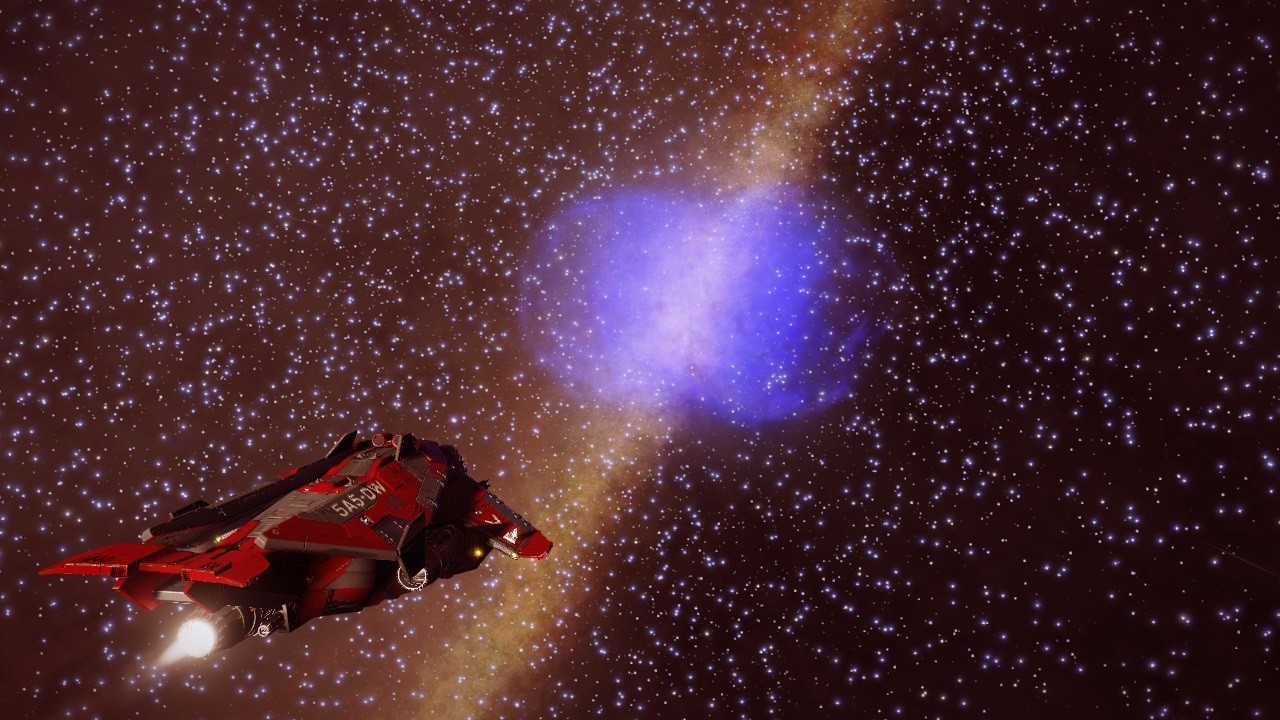
One thousand and seven hundred light years away the system known as Dance with Giants awaited. According to the Galactic Mapping Project database, system Hypoe Bluae VP-O e6-8688 has two twin gas giants in a binary orbit with an orbital period of just 0.5 light years.
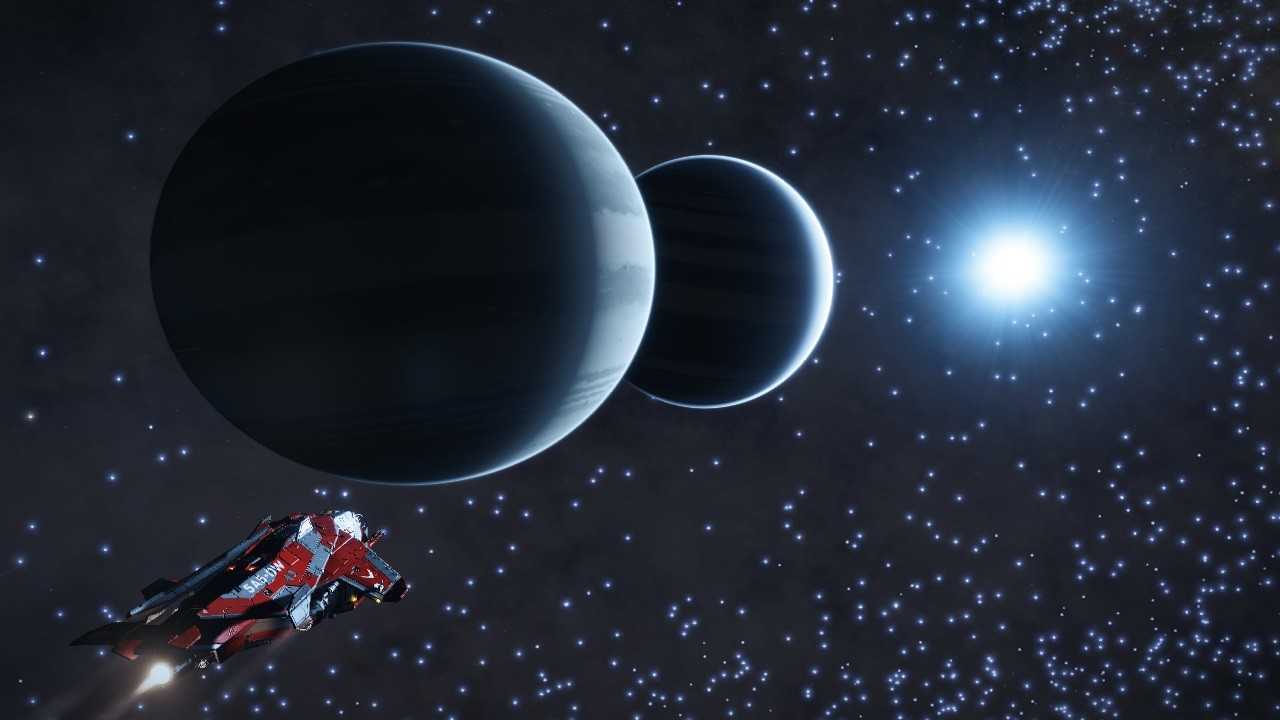
Additionally, those commanders who are prepared to wait and position themselves behind the more distant gas giant will be treated to a double sunrise when the main star shines through between them both. A must see for any traveler yearning for stellar sights while passing through this region of space.
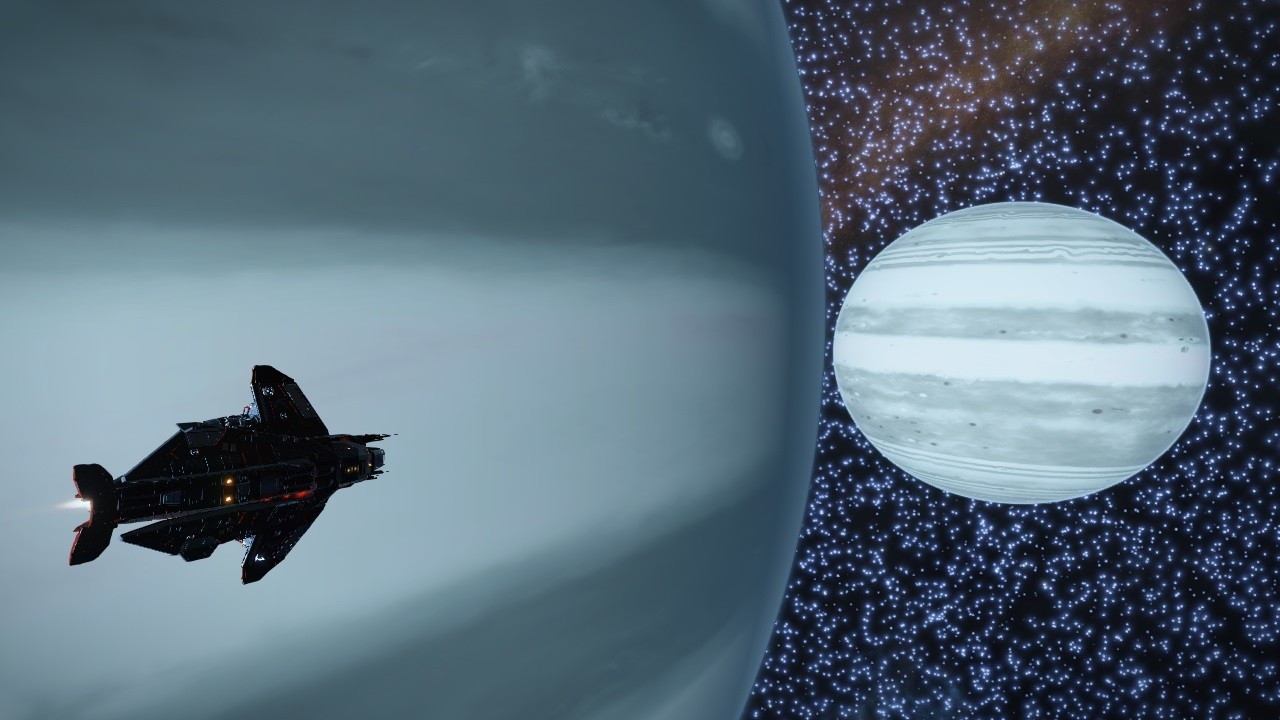
I did not have the time to wait for the planets to align with the star in a way the light shines through them, but I could behold a beautiful double sunrise. Mesmerizing. These planets are so close that it is a miracle that they did not tore apart themselves.
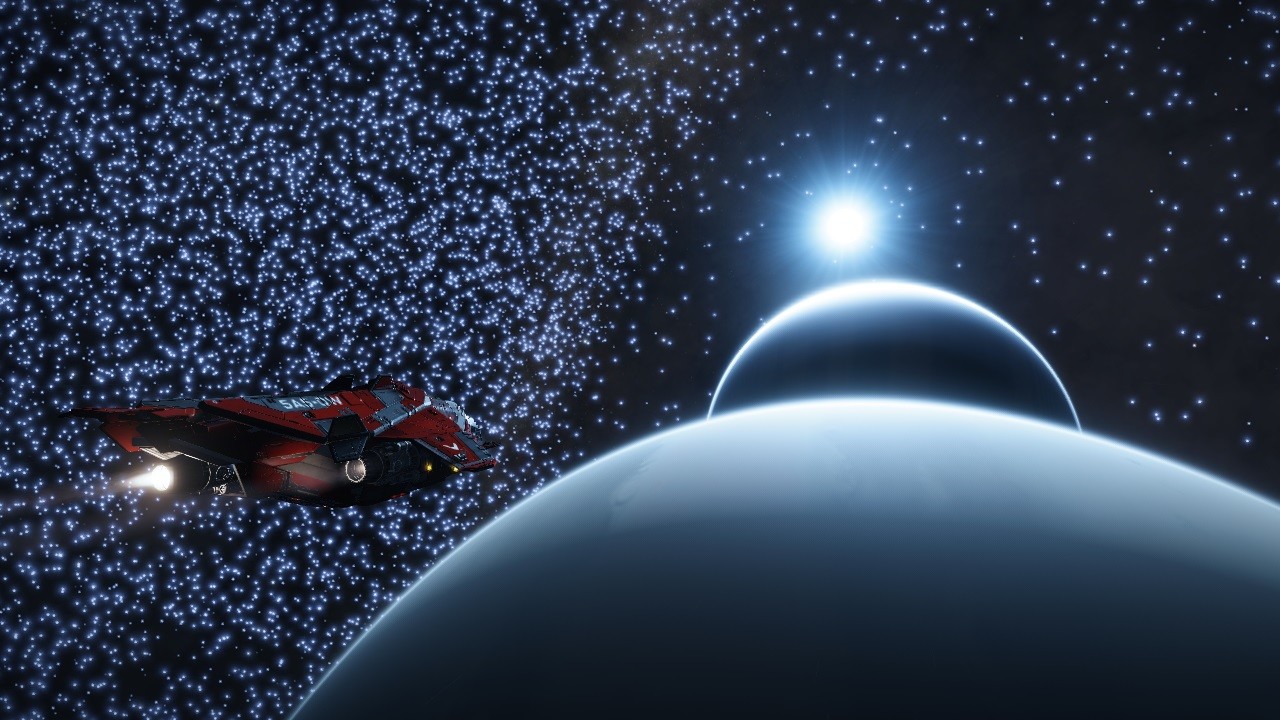
The basecamp of this stage of the expedition, in the system known as Cerulean Tranquility, was very close. I thought I had enough time to visit a minor point of interest I had skipped along the way, system Phroea Bli BW-V e2-10185, the Hot Temptation. The system contains three stars and a black hole, being one of the stars very close to the event horizon of the black hole. Explorers travelling there are warned about sudden super cruise drop outs followed by dramatically increase in the temperature. Nothing that the super cool Hyperion cannot manage, I hope.
I arrived to the Hot Temptation after a three thousand and five hundred light years trip and dropped out of super cruise at the very limit of the event horizon of the black hole in an angle from where I could observe the star and the black hole at the same time. Amazing! The temperature raised but held at sixty percent.
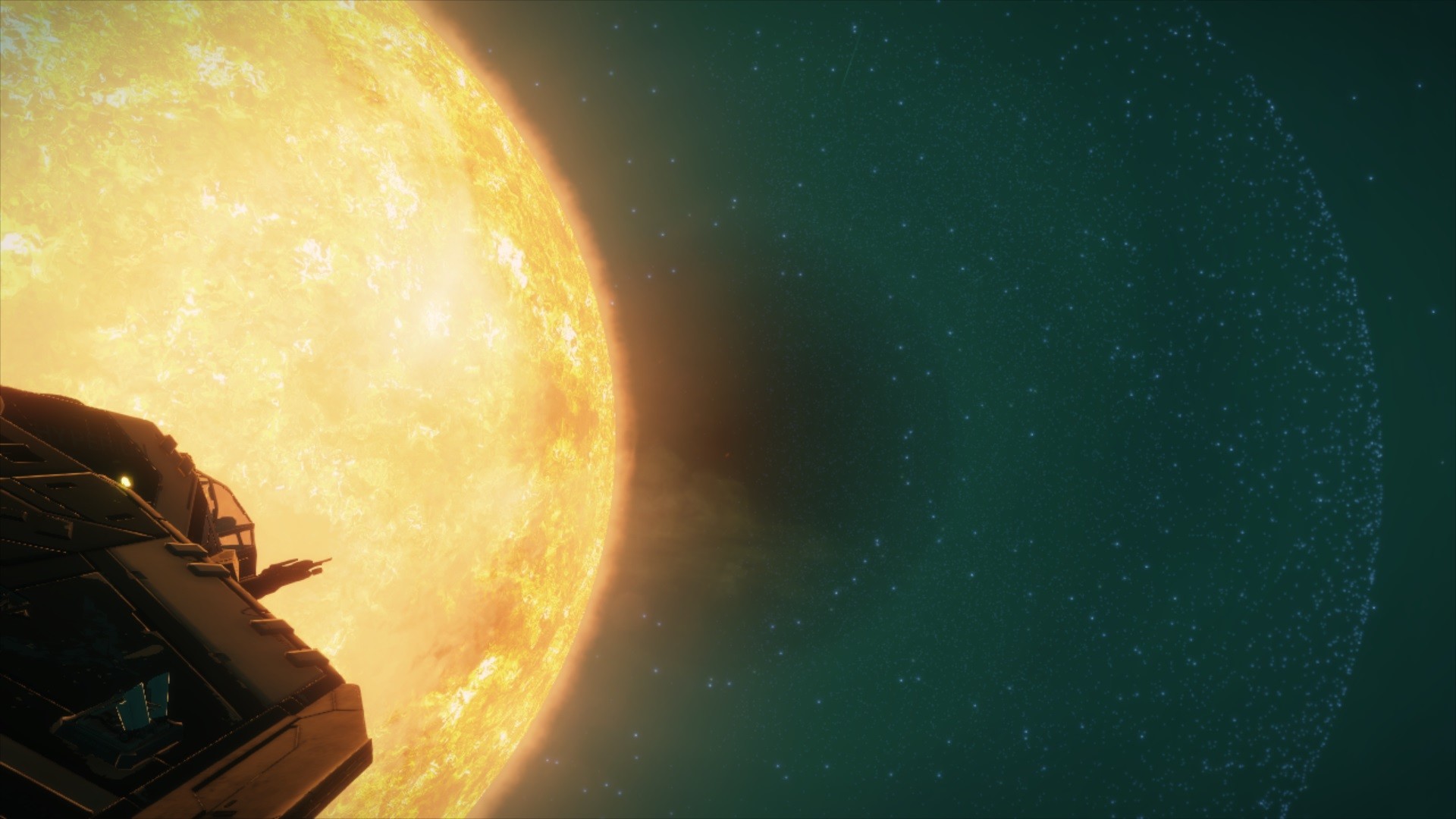
Jumping back to super cruise so close to the star and with the gravity of the black hole pulling over was not so easy. The temperature suddenly raised to ninety five percent due to the stress imposed to the power plant and the frame shift drive. I kept a finger over the heat sink trigger. It was not necessary. I love this ship!
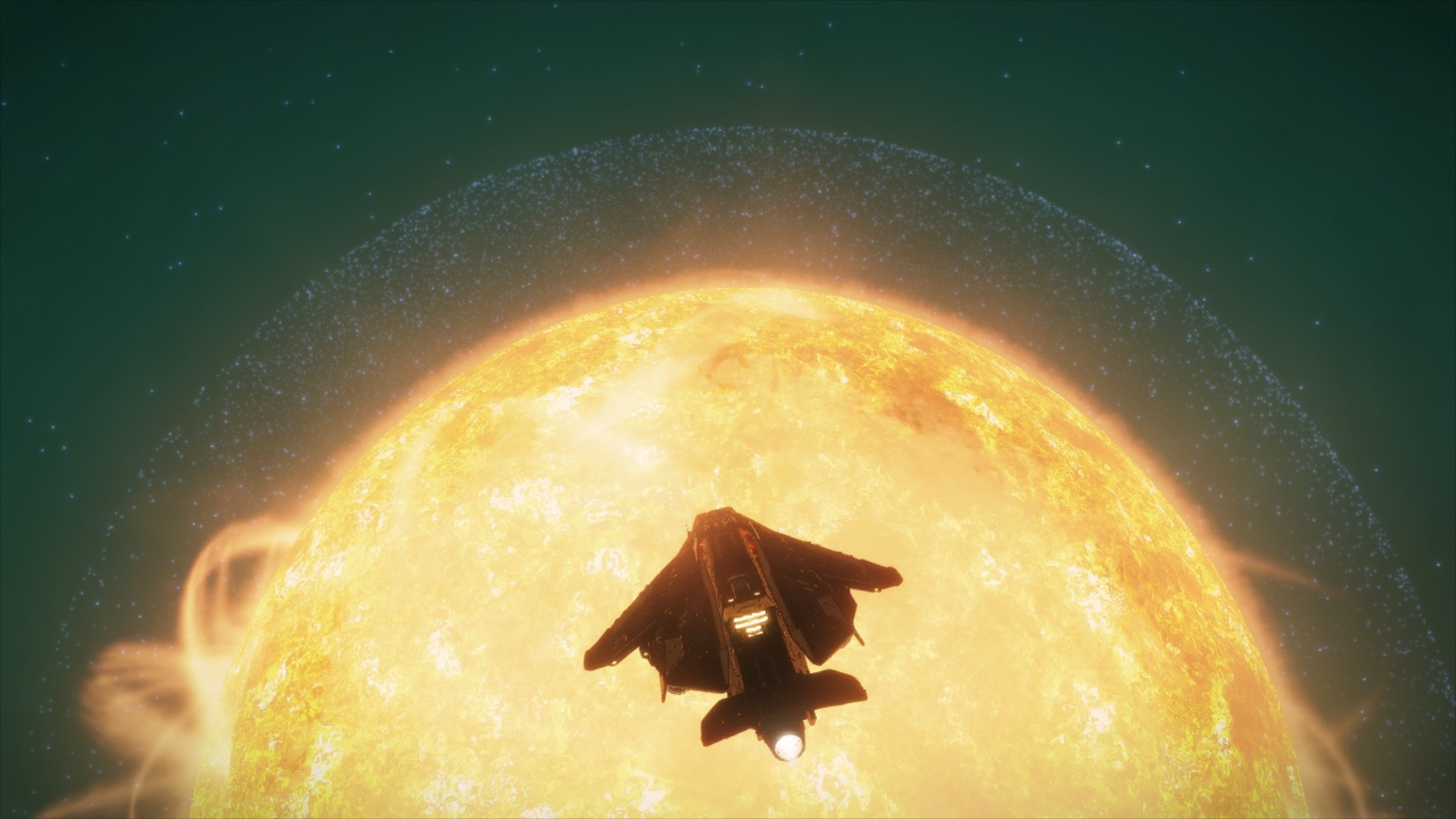
Back on track from the Hot Temptation to the basecamp of the expedition at Cerulean Tranquility, I made another curious discovery. I was fuel scooping at Aemorrs PU-N d7-1422, a system with nothing interesting, when I saw what looked like a nebula in front of me. I locked the system in the navigation computer and looked for information in the Galactic Mapping Project database.
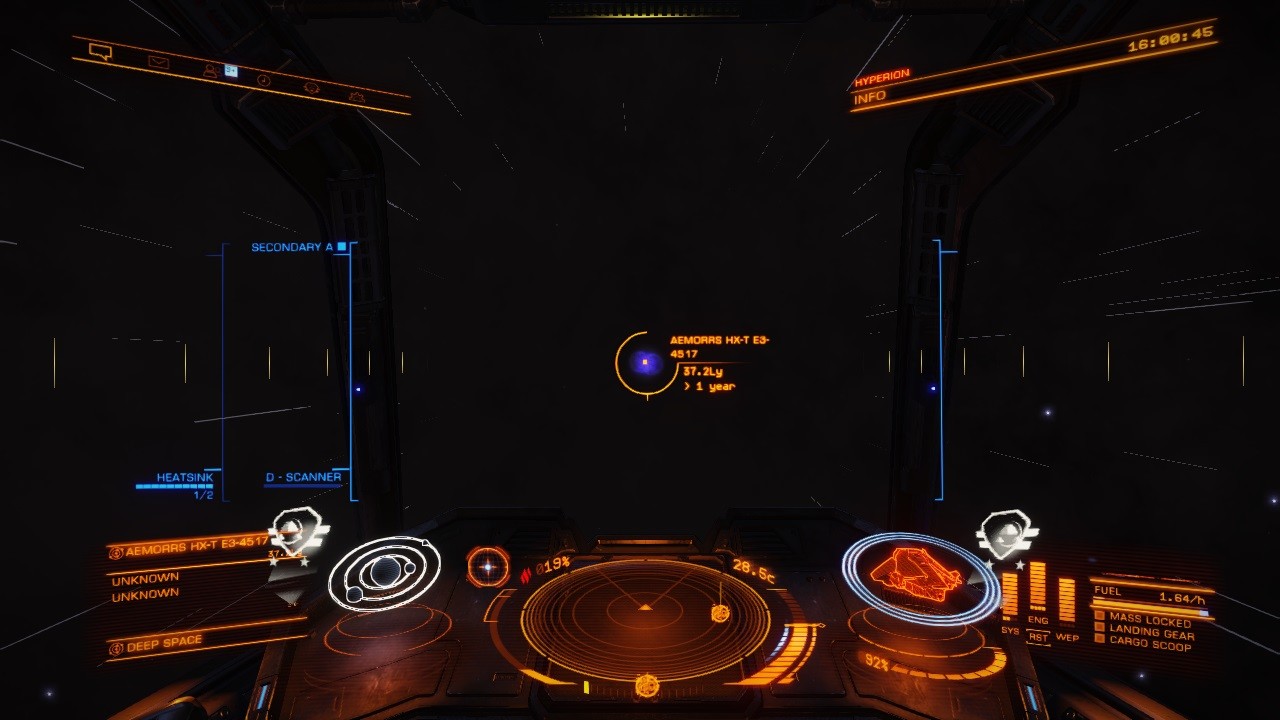
From thirty seven light years away it looked like a double planetary nebula with a neutron star at its core. It was strange that the Galactic Mapping Project did not mention that there was a nebula there. The entry only said that the system was visited for first time by commander Scrublord-sama. Once there I could see in the Pilots Federation database that commanders Picker, Dragonsbreath, Polar Fox and Spica had been there too. The neutron star and some of the planets had their name tags. I guess they arrived there running the neutron highway and did not have the time to properly scan the system or to notify it was nebula. A pity because, according to my scanners, the system contains thirty five stellar bodies, many landable moons and it is a green system with everything necessary to synthesize jumponium.
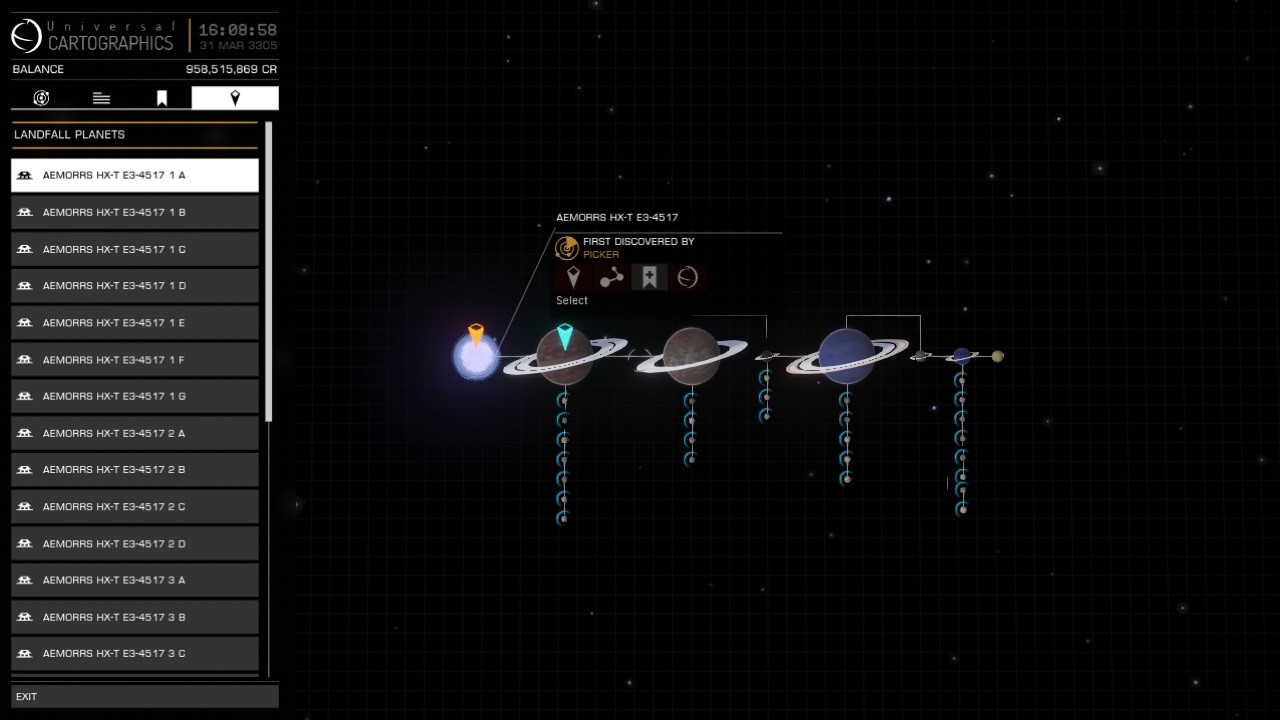
And it is a beautiful place too. The blue and purple colors of the nebula combined with the jets of neutron star and the star mat of the Perseus Arm creates a mesmerizing sight.
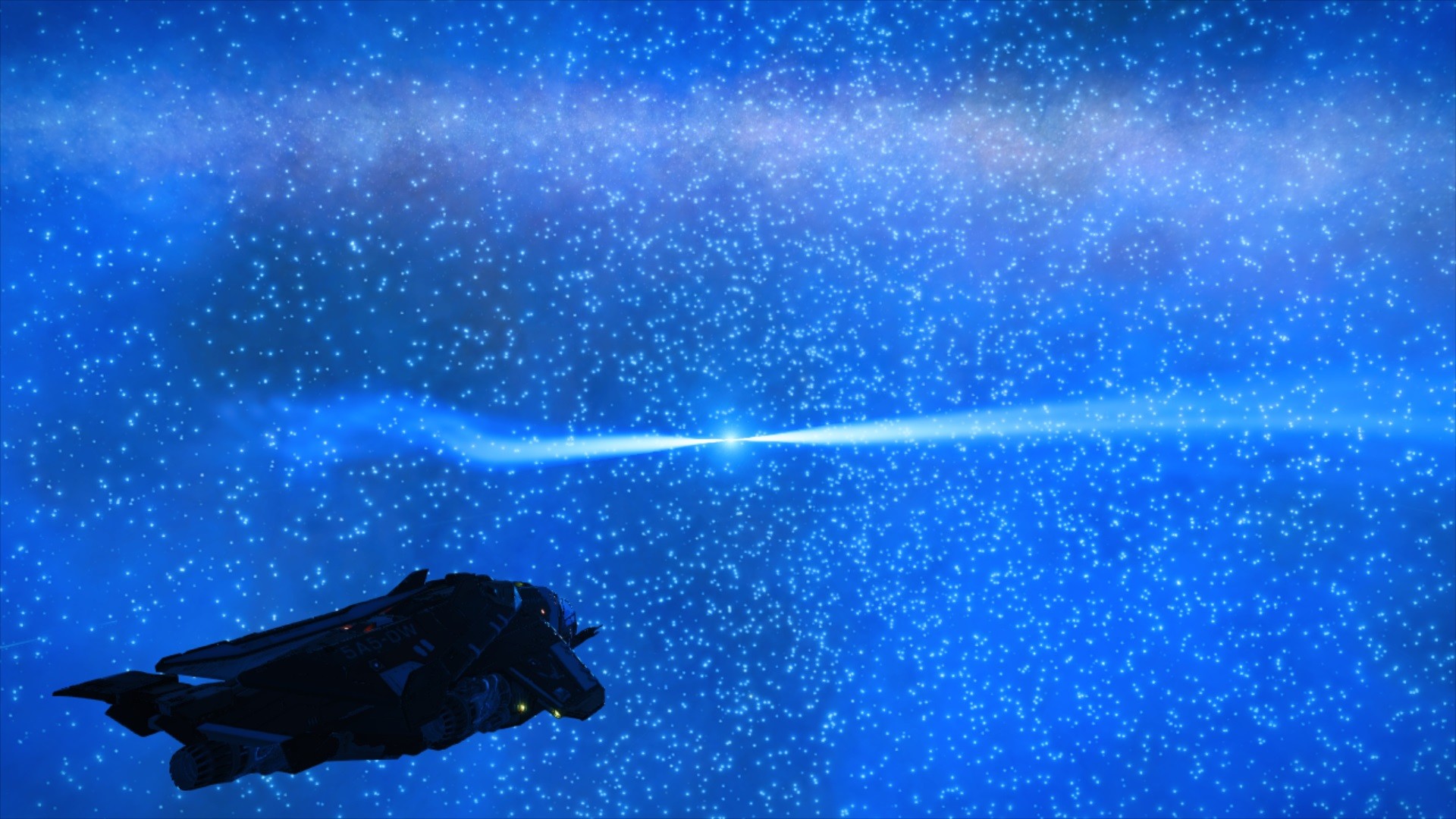
I took some pictures before departing and fully scanned all the stellar bodies in order to transmit the data to the Galactic Mapping Project initiative as soon as I were able. If they finally name this nebula, maybe they will recognize that, in spite of being an already discovered system, it was commander Jav Marlo who reported about the nebula during the Distant Worlds 2 expedition. With so many commanders passing by the nebula without telling and being it in the Perseus Stem, it reminded me of the story of The Graeae, the three sorcerer sisters that were sought by Perseus during the beginning of his quest to defeat the Gorgon. The Graeae were three perpetually old women, who had to share a single eye. As the women passed the eye from one to another, Perseus snatched it from them, holding it for ransom in return for the location of the Hesperides that were keeping the weapons he needed to defeat the Gorgon. When the sisters finally agreed to led him to the Hesperides, he returned what he had taken. I think that The Graeae Nebula would be an appropriate name for Aemorrs HX-T e3-4517 system.
Some hours later I finally arrived to system Phroi Bluae QI-T e3-3454, the Cerulean Tranquility, a planetary nebula eight thousand and four hundred light years from Saggitarius A that promises spectacular environmental views with its light blue skies. I landed among other fellow commanders between the fumaroles of the Tranquility Valley basecamp, a perfect place for resting before the release of the next waypoint towards Beagle Point.
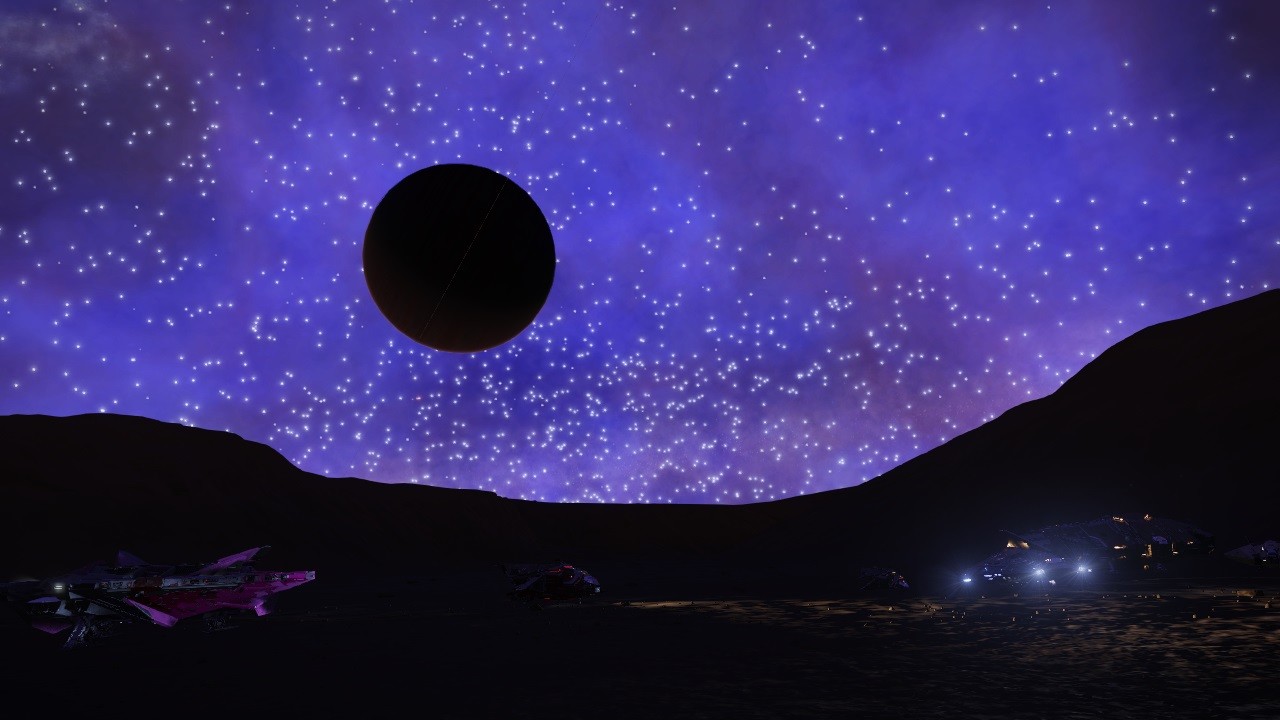
And here I am now. Registering this log entry and preparing a data transmission for the Galactic Mapping Project initiative with information about the Forgotten Twins Nebula and the nebula I found at the Aemorrs HX-T e3-4517 system before indulging in a hard earned rest.
Jav Marlo signing out.
DISTANT WORLDS 2 (PART 11) – GOING BEYOND
24 MAR 3305 Hades Edge (Swoals IL-Y e0)
This is commander Jav Marlo, onboard the Hyperion, registering this log at Hades Edge, basecamp of the Distant Worlds 2 Expedition in system Swoals IL-Y e0, also known as Goliath’s Rest.
I could not join my fellow commanders for the massive jump from Sagittarius A one week ago. The Hyperion needed some patching before venturing on this stage of the expedition, that promises to be the hardest. No more ports on the horizon until we reach Beagle Point. When I was finally ready to depart, the hangar of Explorer’s Anchorage looked deserted compared to the frantic activity it has hours before. The dock crews were exhausted after fixing so many ships for exploration again after the mining community goal.
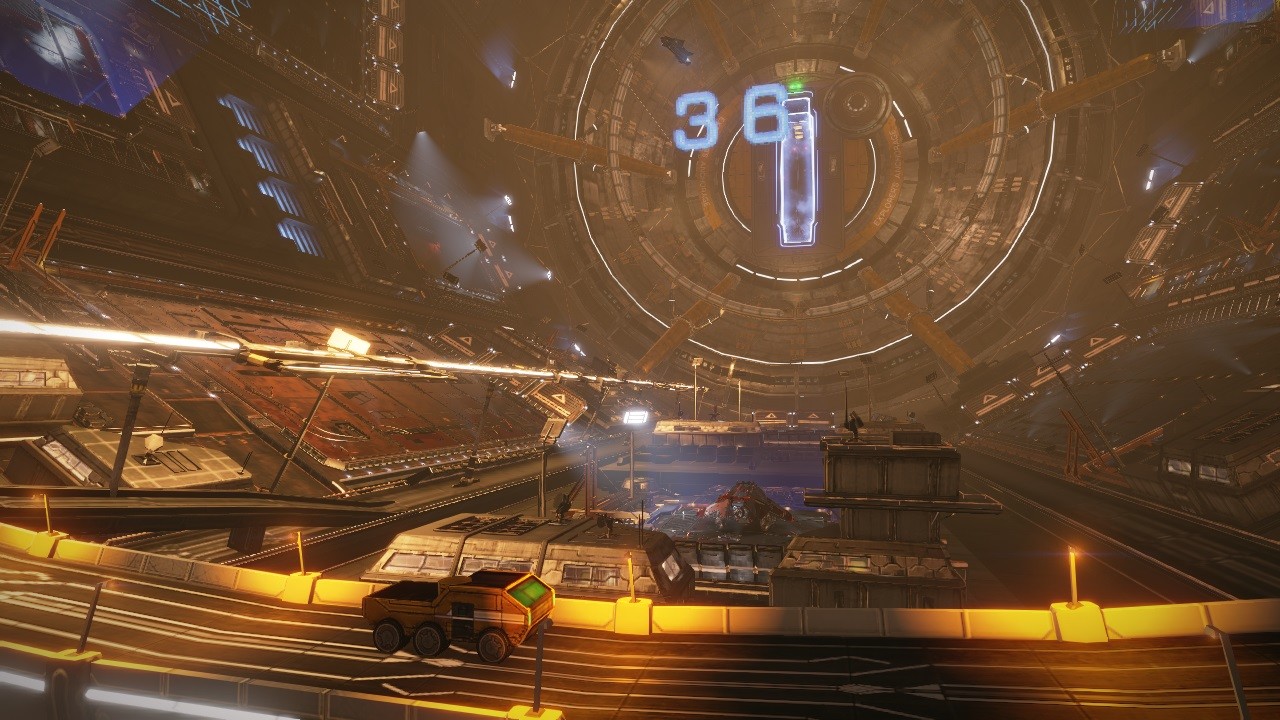
Once in space, the habitat ring of Explorer’s Anchorage looked almost finished, thanks to the hard efforts of the fleet. The construction will probably be over by now.
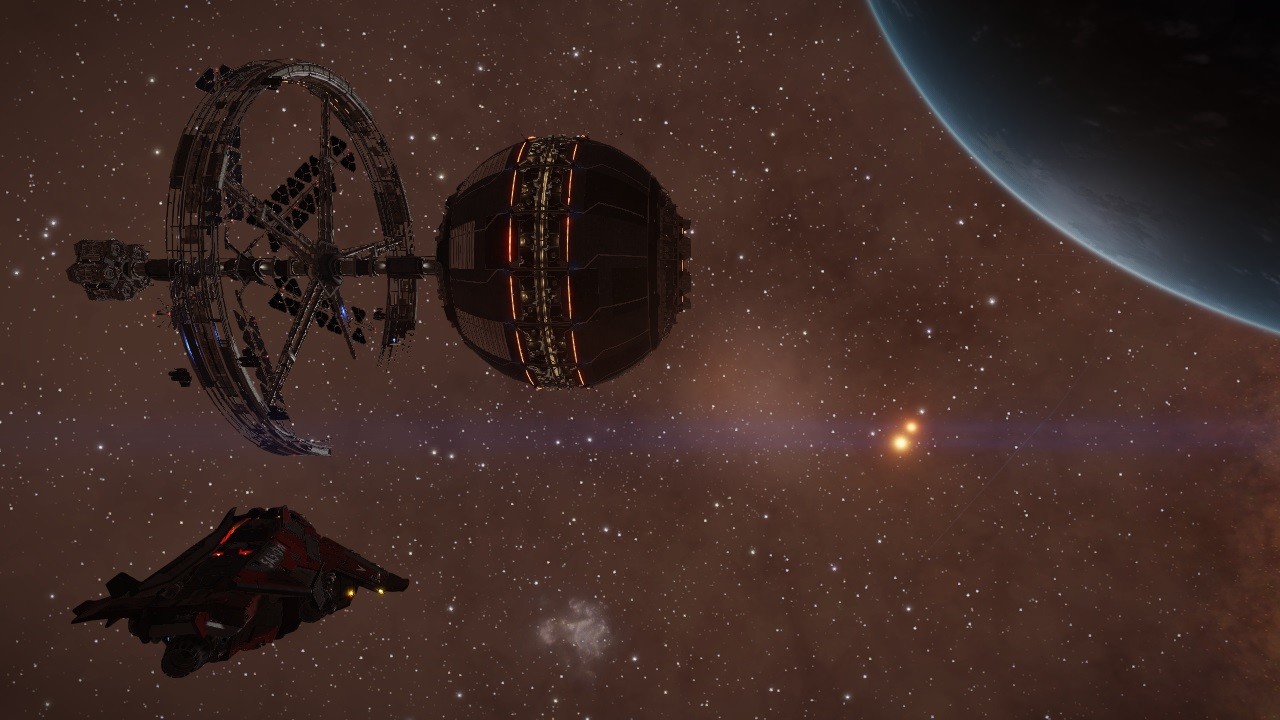
My first stop in the itinerary was the Hengist Nebula, in system Juenae OX-U e2-8852, where I located a notable stellar phenomena upon arrival. It was a Roseum Lagrange Cloud with heavy electric activity. I did not venture to enter into the cloud and risking losing my ship, so I just approached enough to identify the Rubeum Metallic Crystals inside and then I departed.

According to the Galactic Mapping Project database, the Hengist nebula is a planetary nebula named after the late Emperor Hengist Duval, who was assassinated a few days after the system was discovered. A terraformable water world orbits the secondary star; while it could have been classified as an Earth-like planet, the presence of large amounts of water vapor has heated its atmosphere well above to what is considered breathable.

From there I headed to the Phua Aub Nebula Cluster that was six hundred light years away. The first nebula I visited was Phua Aub Archer Beta, in Phua Aub VY-S e3-3899 system, but it can be better appreciated from the nearby Phua Aub UD-K D8-3863 system.
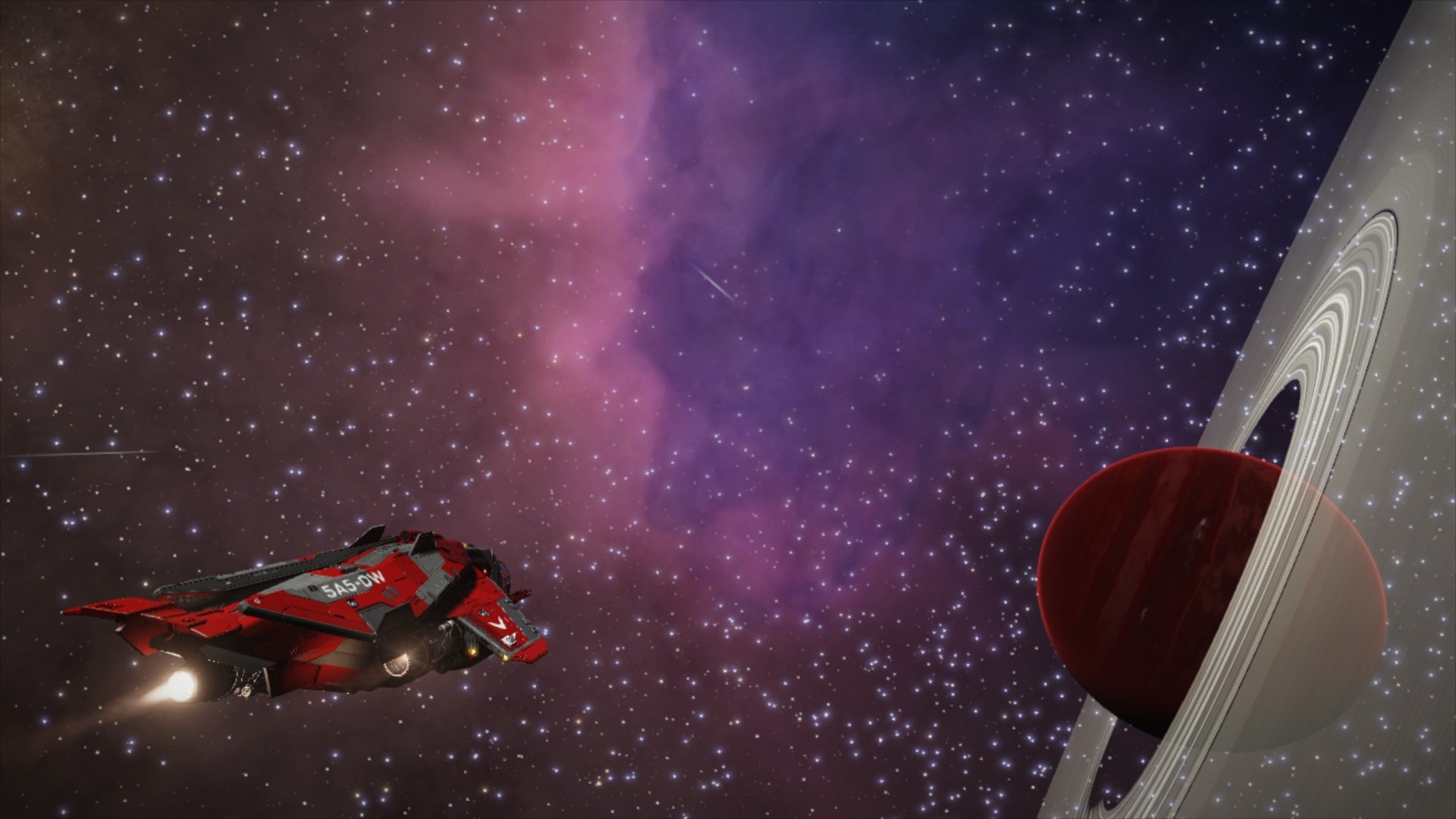
Five hundred light years away was the Phua Aub Archer Epsilon nebula, located in system Phua Aub MX-U e2-7396. Once there I chose to contemplate it better from the nearby system Phua Aub FC-C C13-5788.
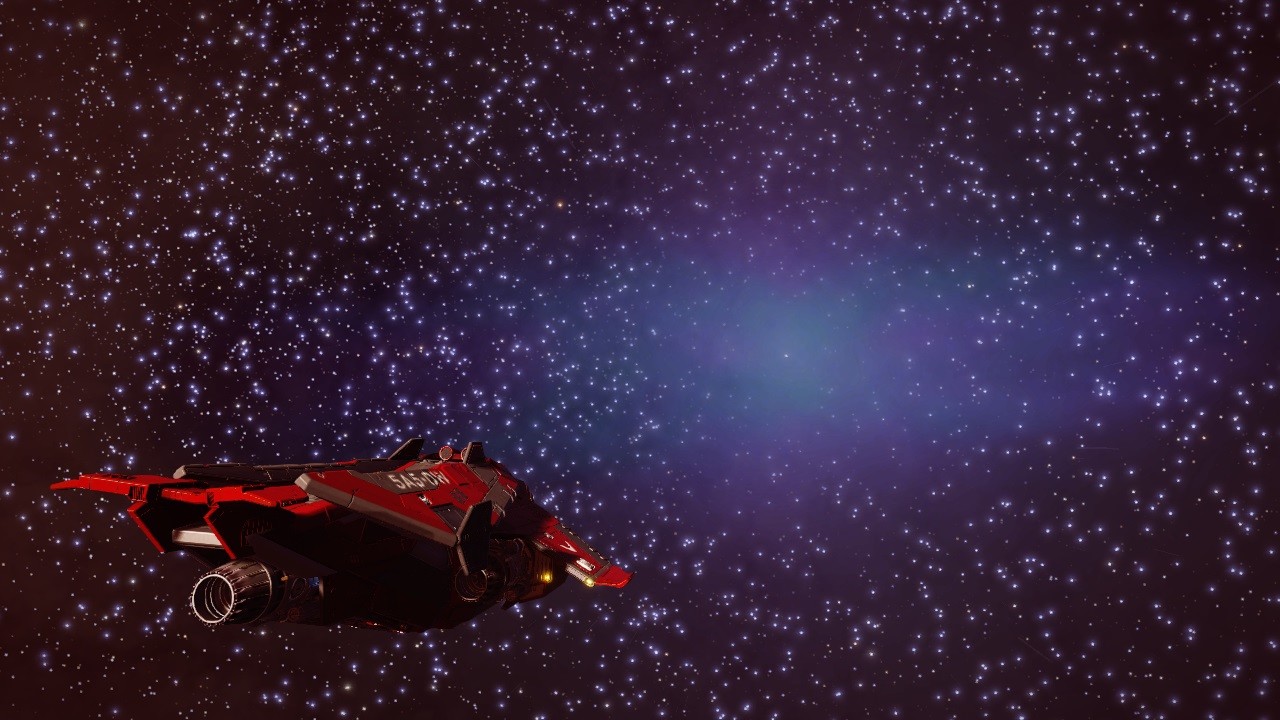
And the third nebula, four hundred and fifty light years away, was the Phua Aub Archer Kappa, in system Phua Aub SJ-R e4-8234. This one has a neutron star as its core and reminded me of the Rusty Net Nebula.
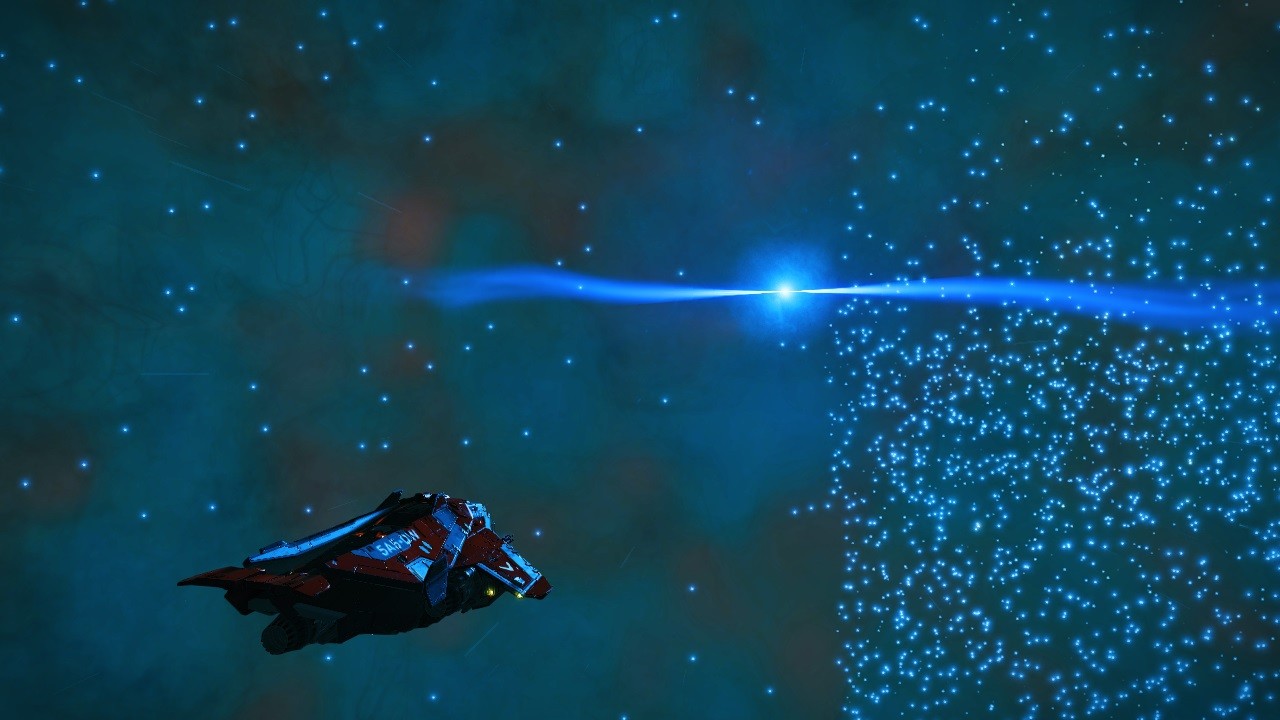
According to the Galactic Mapping Project database, there is an intermediate mass black hole, in system GRS 1739-278, just one thousand light years away. The system was first described by old Earth astronomers in the year 1996, having detected emissions of X-rays and gamma rays. At this time, observations of compact objects were still in their infancy, however it was correctly theorized that this system was home to a large black hole. In 3304, the system has now been found to be composed of a black hole at 115 solar masses, and two young stars of class Ae/Be and T-Tauri in a relatively close 10AU orbit. Five terrestrial, atmospheric planets are present in the system, however due to their young age and energetic, unstable conditions, life is highly unlikely to exist here. Worth of a detour, I thought.
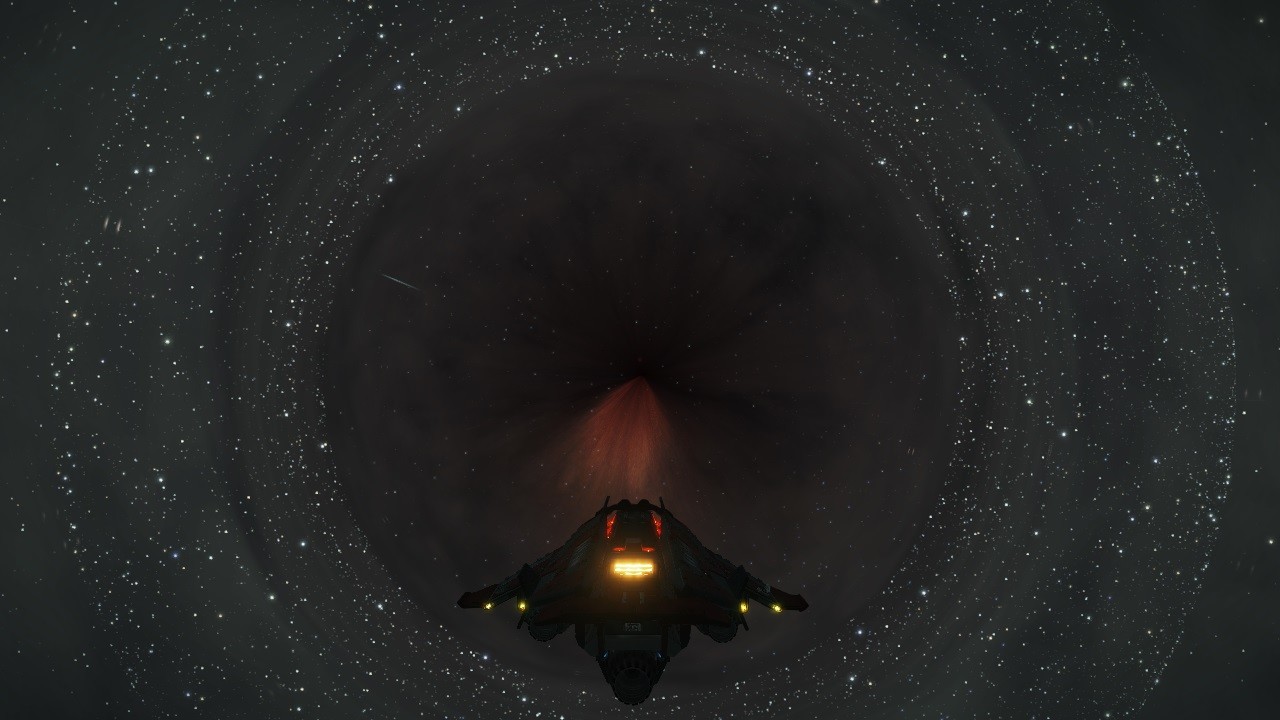
There was a worth visit nebula nearby too. The Karkina Nebula, in system Eok Bluae GX-K d8-1521, is a small red, black and green nebula in the Galactic Bar, about one thousand light years north of Sagittarius A, and about another thousand light years below the galactic plane. It is part of a population of unusual small nebulae in the core that have not formed any stars, and thus cannot be entered with current FSDs. However, the star density in the surrounding area is high enough for an excellent naked-eye view. They said that, when observed from the nearby system of Eok Bluae GX-K D8-7721, the nebula resembles a ribcage seen face on. The left lung appears to have been filled or destroyed by a large black mass and a sickly green color appears to be spreading throughout the rest.
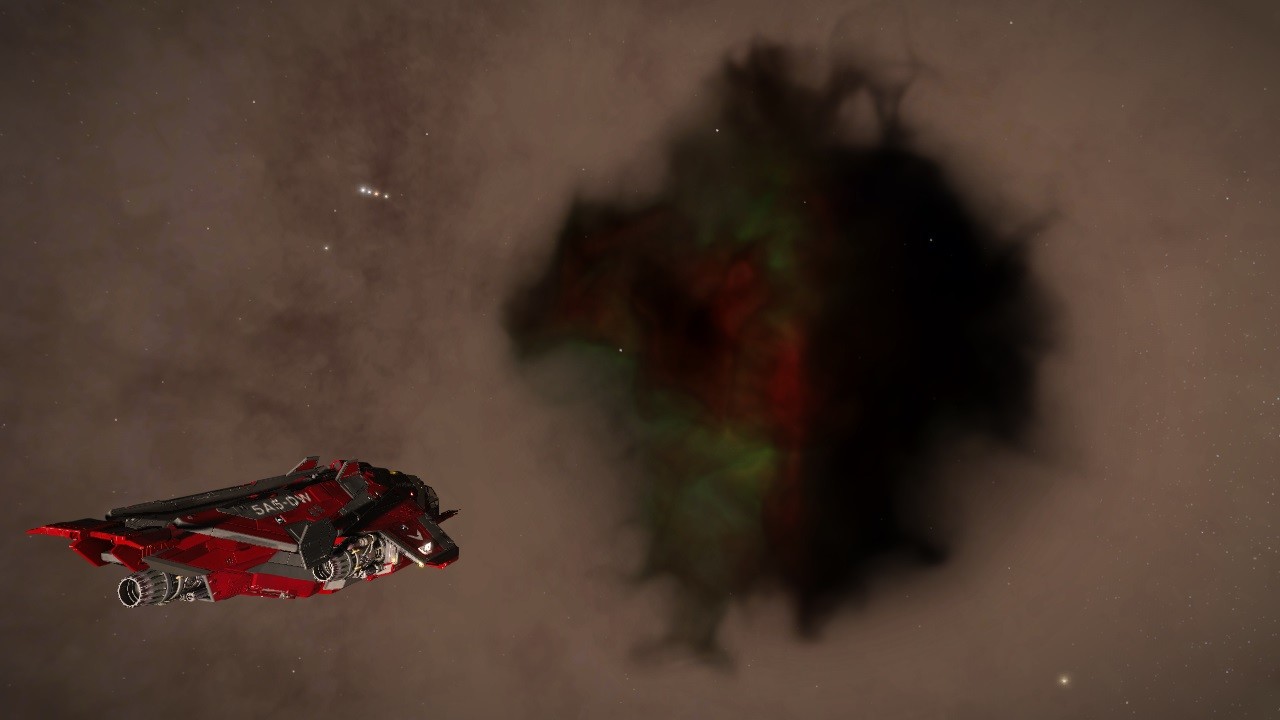
There was another system close that deserved a visit, G2 Dust Cloud Sector JH-V c2-2851, that takes its name from The G2 Dust Cloud, the remnant of an event observed in the twenty one century, during which what was then suspected to be a gas cloud encountered near Sagittarius A. Since the event actually happened twenty six thousand years ago, by today the cloud has gone quite a distance away from the centre. Explorers who visit it will find a small and faint nebula, which can be observed by the naked eye from only within eighty light years. The nebula colors the bright light of the galactic core crimson red, which can make for some unique sights.
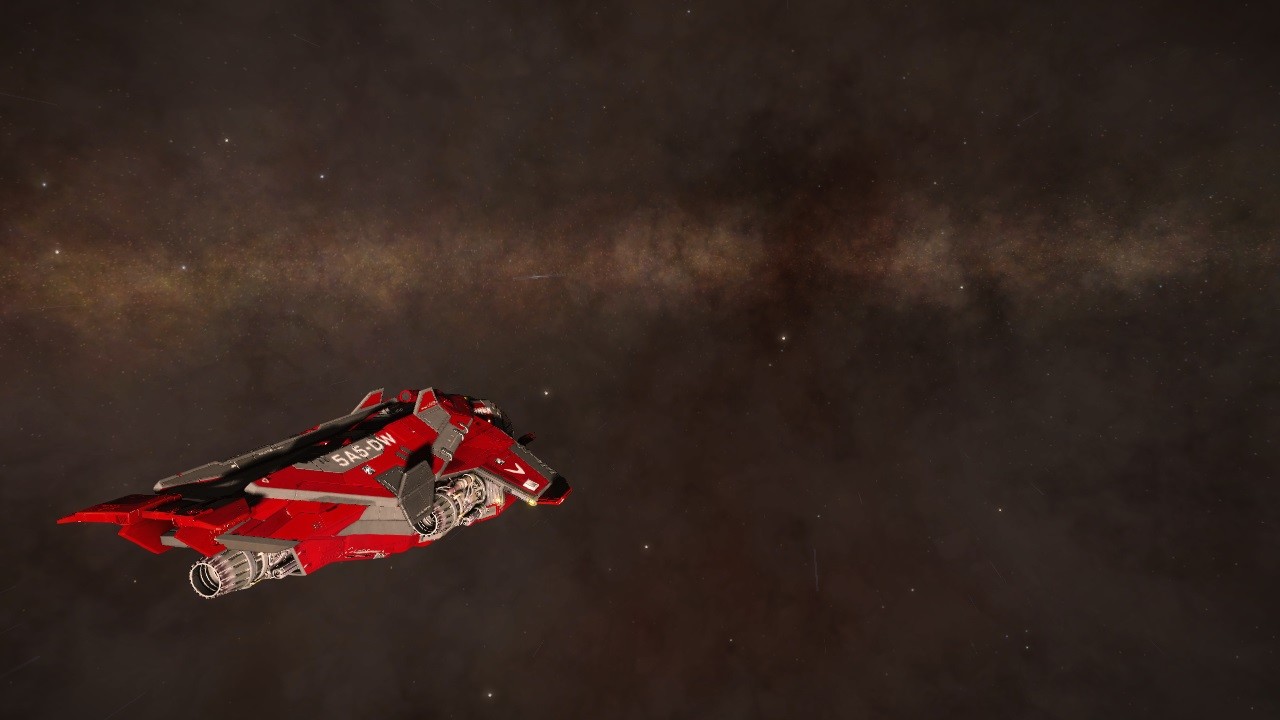
After that little detour, I finally headed to The Crown of Ice, in system Phipoea WK-E d12-1374 but, alas, I arrived there during the moon’s night phase, and the darkness did not allow me to behold properly the majestic mountain range, that forms in the northern polar cap of the second moon of the fourth planet, with its peaks of more than fifty kilometers in height. I carefully navigated through the overwhelming mountains promising myself that I will come back some day.
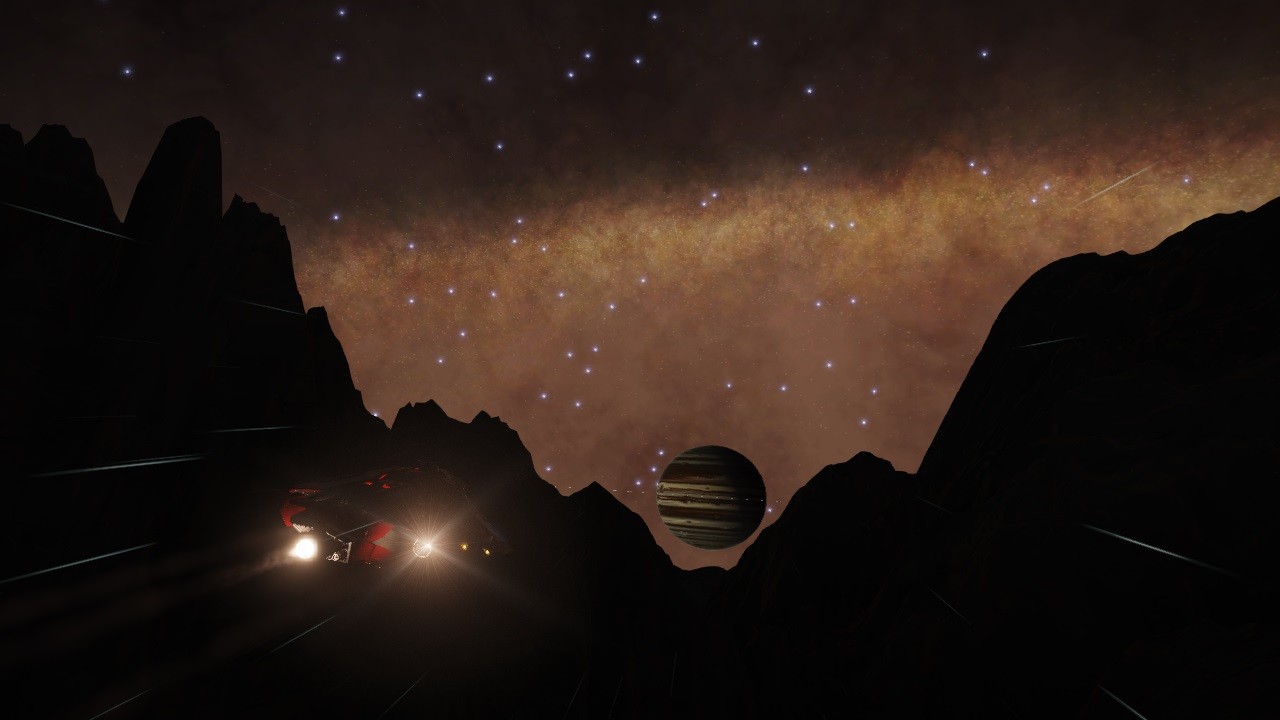
The terrain was to abrupt to land there, so I continued to the system Phipoea HJ-D c27-5254 and the Silver Highway. Hidden on the outskirts of the Phipoea Nebula is an ice moon, located between a Class 1 Gas Giant's inner and outer ring systems, and very close to the former. If you go there you will be rewarded with an extreme close-up of this inner ring as it tilts away from the moon's surface, so close in fact that it is easy to see individual objects moving in the belt as it orbits. The appearance is that of an enormous, shining, million-lane highway around the gas world.
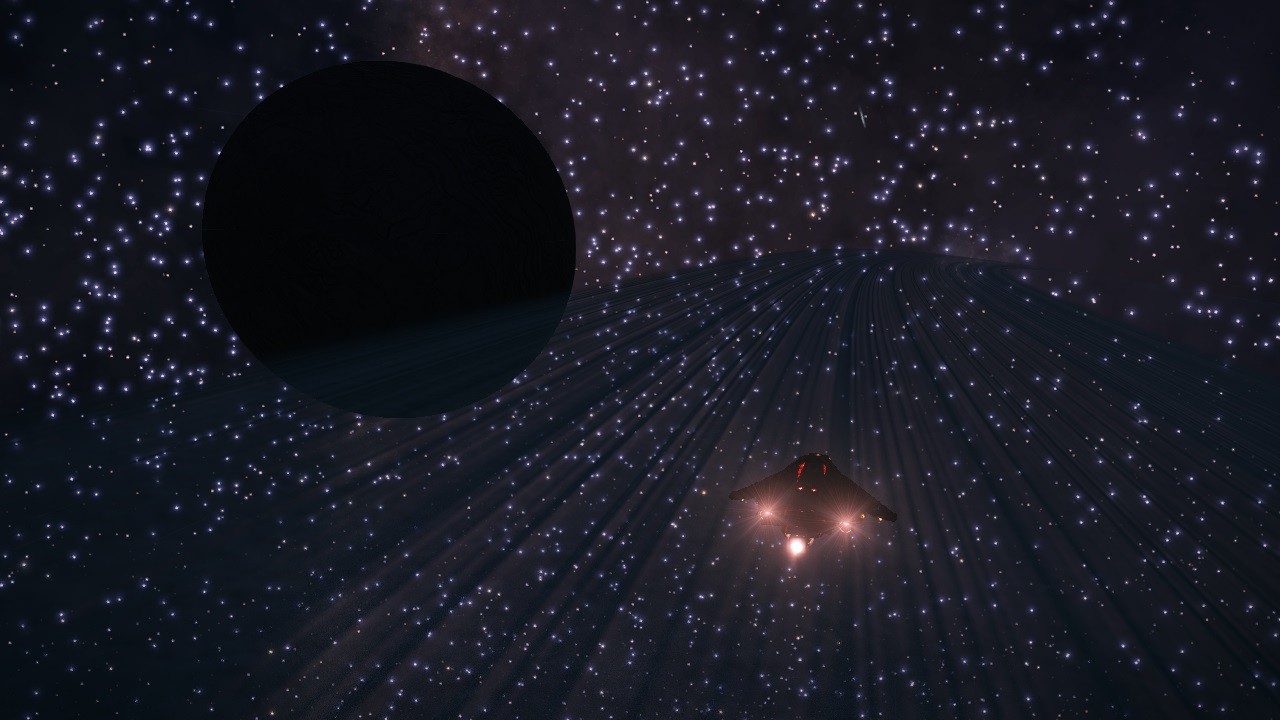
It was night there too when I arrived so, as usual, I found myself a cozy place with a camp fire and nice views to rest.
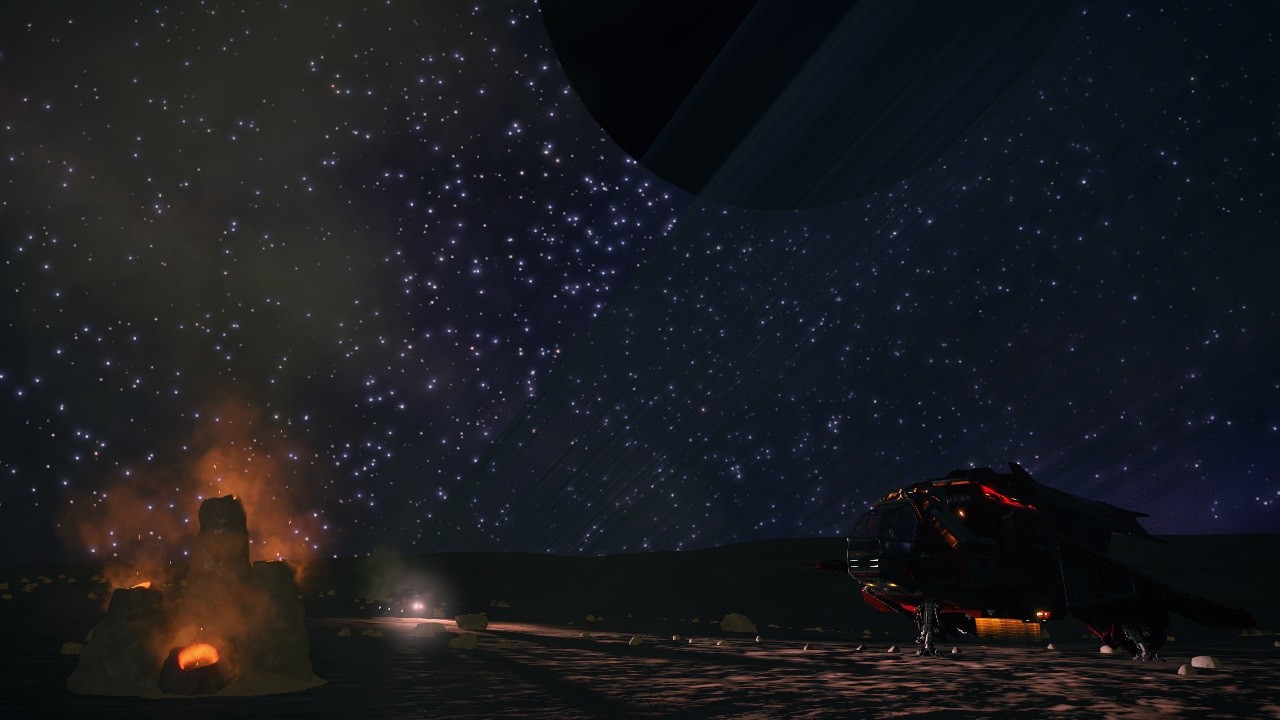
Twelve hours later I was on route to system Dryau Chrea DB-F d11-3866, known as the Stair Away to Heaven, where there is a ringed Earth-like world in a trinary orbit with two gas giants. They said that there is a beautiful sight of the core from there.
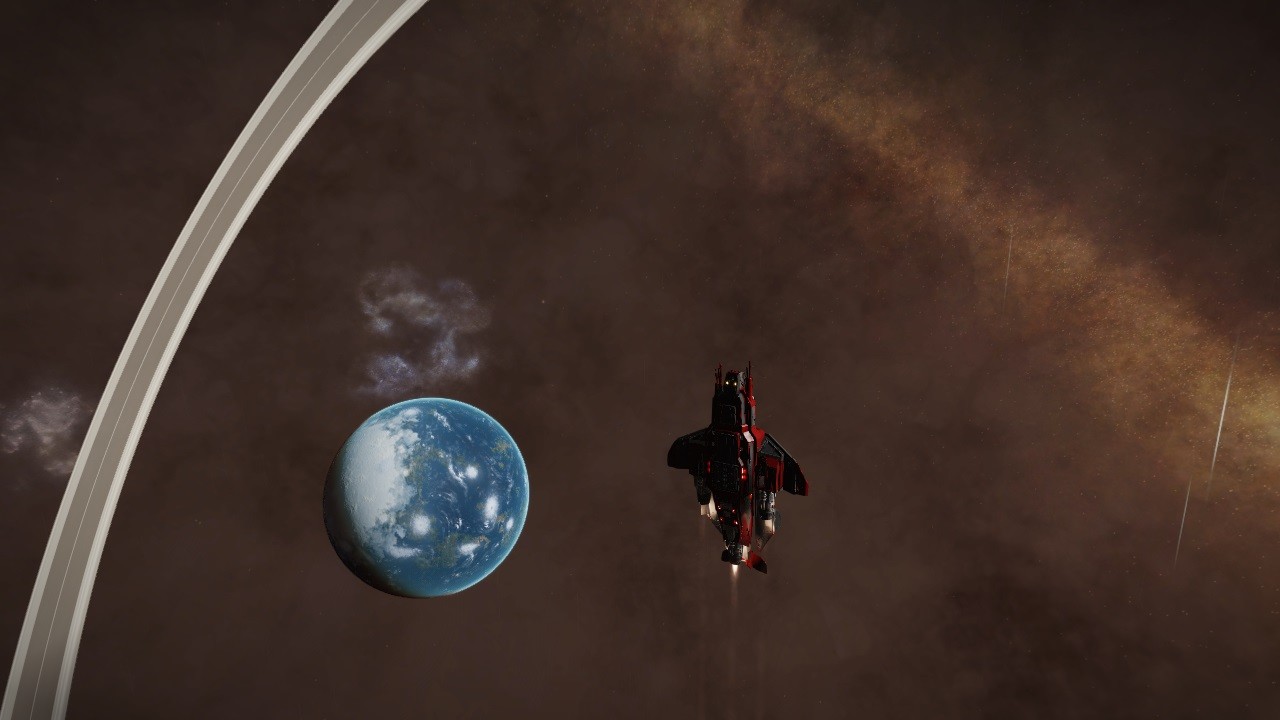
And from there I aimed to the Dark Eye Nebula, in system Rothaei SI-B e2047. The Dark Eye Nebula is a dark planetary nebula obscuring the bright star field behind. From some angles it resembles a photo negative of a cat’s eye. This system was named by the Mobius Exploration Corps.

The Braisio Juliet Nebula Cluster was more than two thousand light years away, so I decided to use the Neutron Highway. The first nebula there that is a must to visit is Braisio Juliet Beta, in system Braisio FR-V e2-293. It has a black hole in the middle that distorts the light creating very curious images.
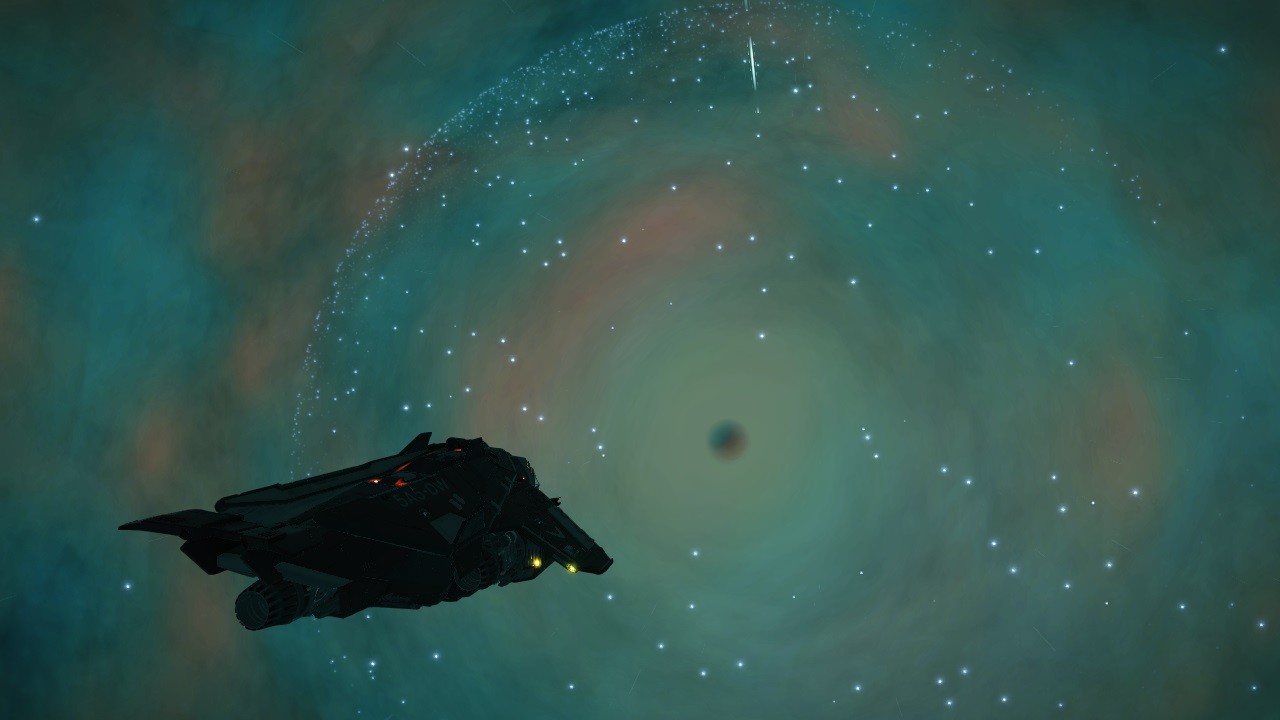
The Black Giant’s Nebula, in system Eorl Broae EB-O e6-1507, was just eight hundred light years away. It is a planetary nebula with a black hole in the middle so, as a result, there is no light apart from nebula itself. The view from the two gas giants looks incredible.
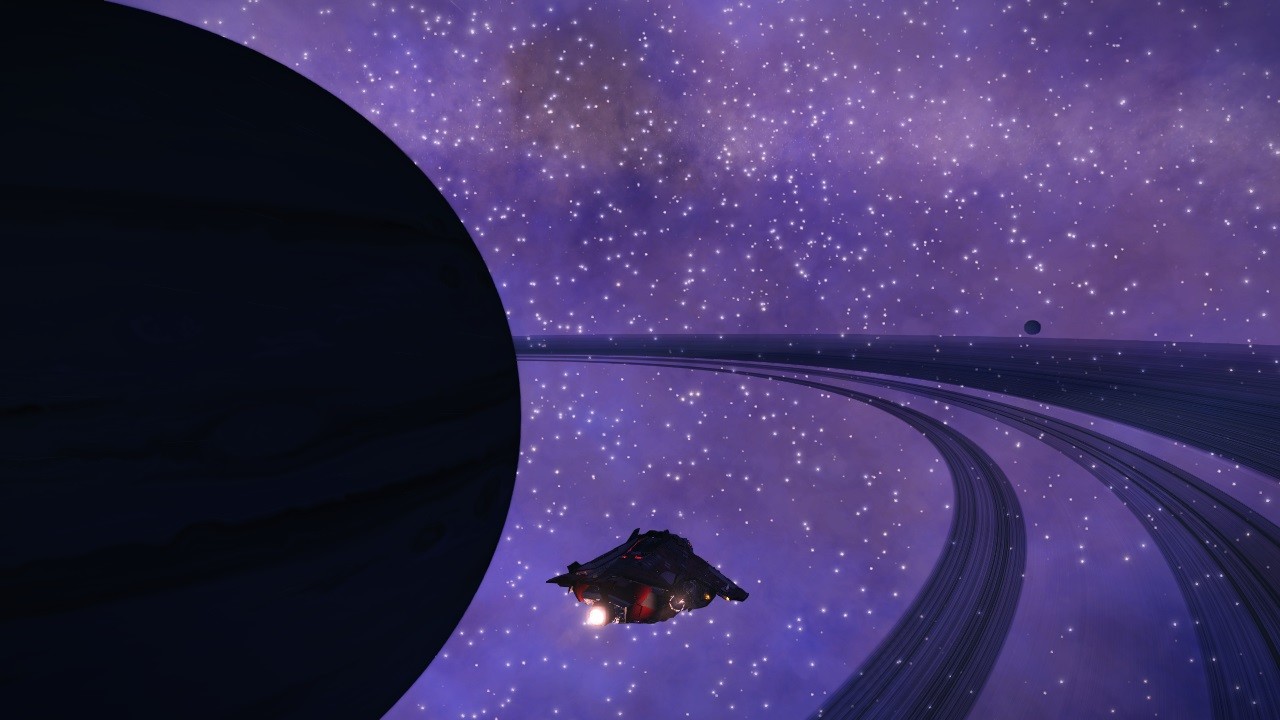
And there was too Lyaisae Juliet Alpha, a planetary nebula, at system Lyaisae HA-A e3363, that has a black hole core that creates beautiful sights.
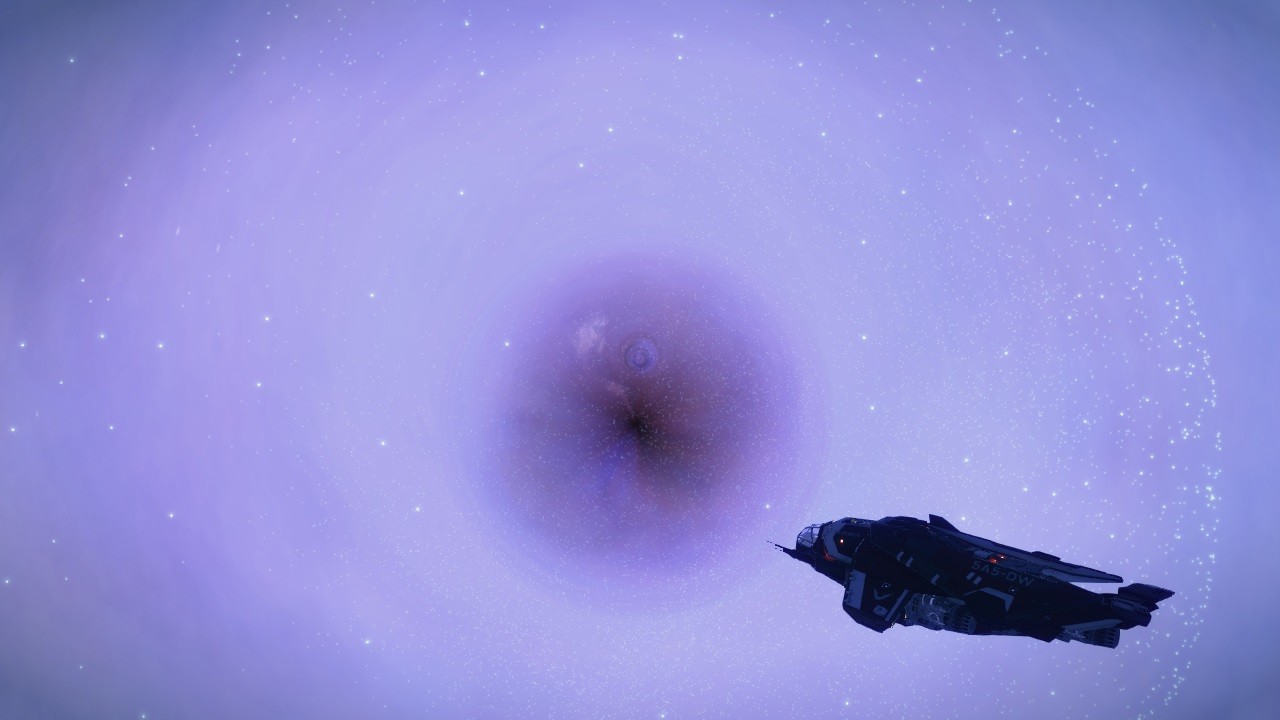
The nebula can be better appreciated from the nearby Lyaisae KI-V c2-953 system.

On my way to the Breakthrough Echoes, in system Rhuedgie KN-T e3-721, I found the one and only Earth-like world I discovered on this stage of the expedition. It was in system Lyaisae JJ-R C5-238. It had big continents and just half the mass of Earth.
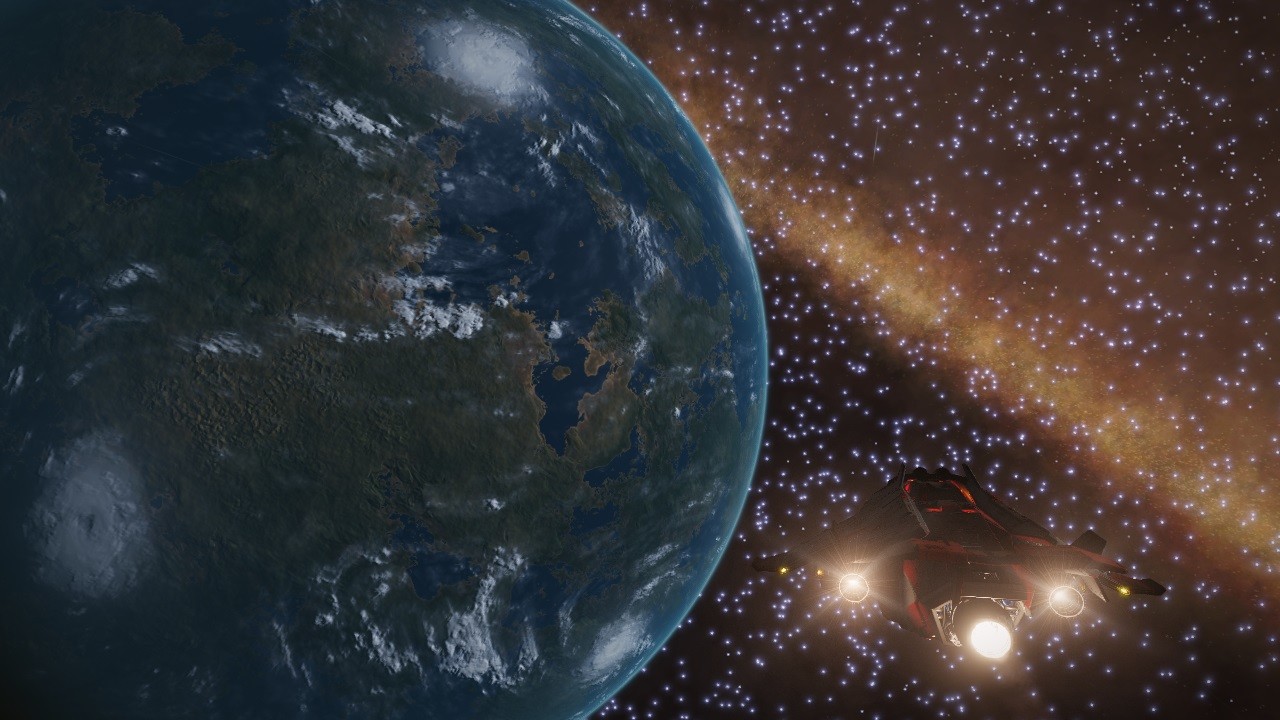
That was very appropriate because, the Breakthrough Echoes contains a gas giant with three Earth-like worlds moons, one of them ringed. That wonder was discovered during the Perseus Survey. The three worlds are in close orbits and can be seen clearly from the others.
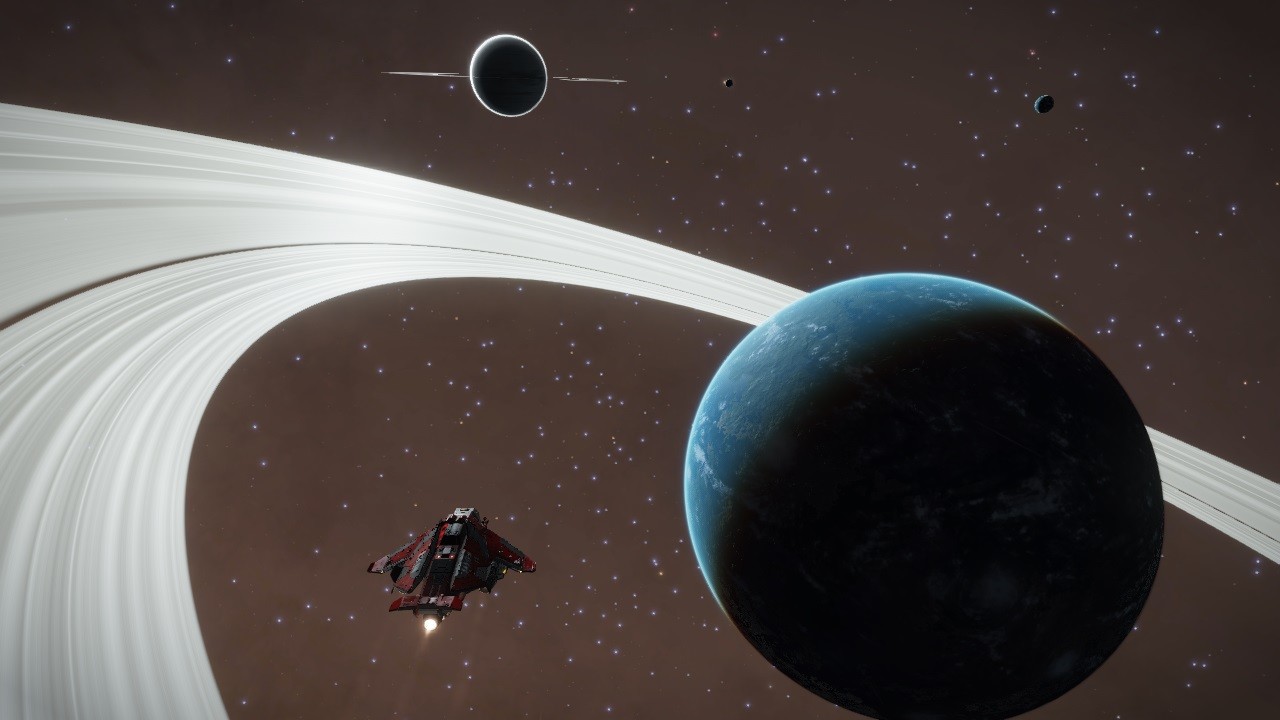
The basecamp of the expedition, Hades Edge, is located two thousand and eight hundred and fifty light years above the galactic plane, and it is very difficult to reach for ships with jump ranges below forty five light years. That is why Fleetcomm has designated an alternative basecamp in system Hypiae Phyloi LR-C D22 called Lower Hades Edge. I headed there first in hope of finding some commanders of the expedition, but had no luck so I found myself a nice camping site close to some fumaroles and rested enjoying the view of the galaxy below before confronting the ascend to Goliath’s Rest.
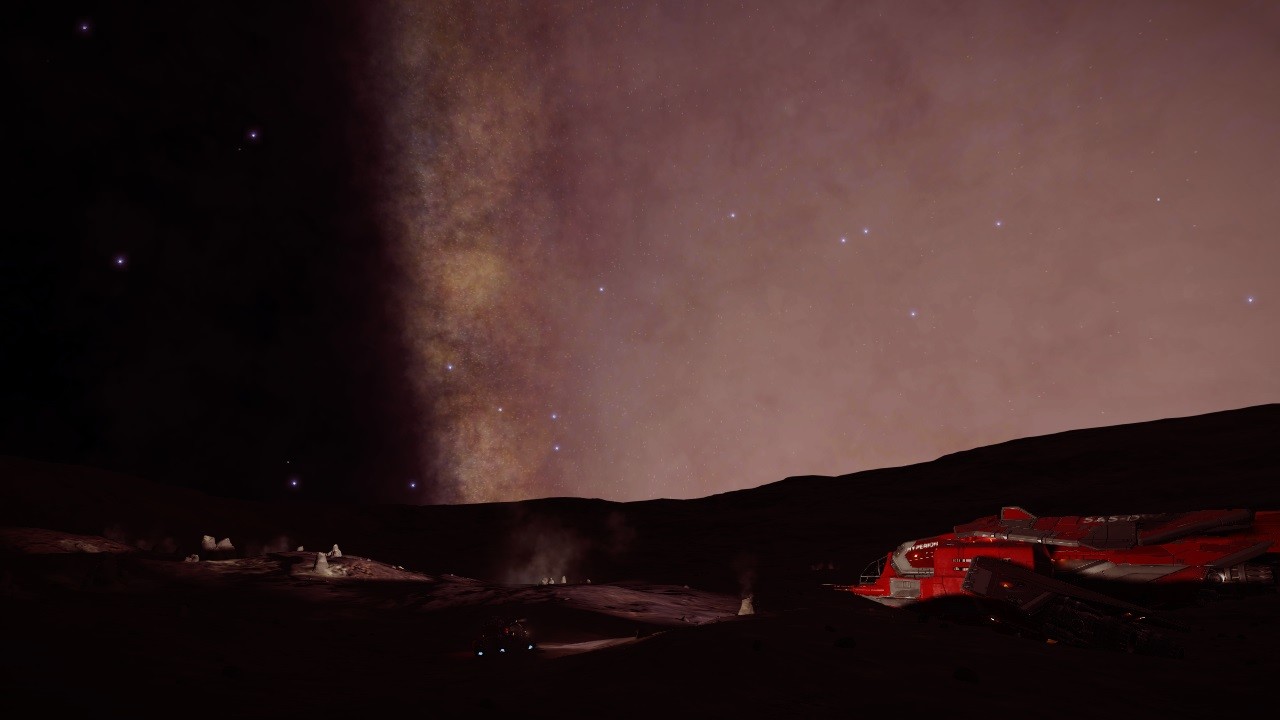
I took the chance to do some repairs to the Hyperion. I think I have abused lately of the neutron jump and my FSD is too much battered to work properly. Thanks I brought an Auto Field-Maintenance Unit with me. I made some mistakes too in my way here and lost five percent of hull integrity. I have no way to repair that now. I will have to be more careful if I want to make it in one piece to Beagle Point.
It was the time for the final ascend to Goliath’s Rest, in system Swoals IL-Y e0. According to the Galactic Mapping Project database, Goliath’s Rest is located above the galactic plane, on the fringe of intergalactic space. It contains a large red giant carbon star, Goliath, with twenty nine times the mass of the sun and a sole landable planet in its close proximity. The orbit of the metal-rich planet is perpendicular to the distant galactic dust and stars, serving as a perfect backdrop for intense light with the carbon star in the foreground. In the distance one can no longer discern distinctive stars, but rather, the galaxy appears as a luminescent haze of glowing light and fire. This system serves as a distant point of departure for those trying to reach three thousand light years above the galactic plane. Nearby there are multiple black holes and neutron stars reachable only with jumponium at the upper limits of the galactic ceiling. Goliath's Rest was discovered by CMDR Parabolus during the SHEPARD Expedition of 3303. I finally made it to there supercharging again the FSD with the aid of two neutron stars.
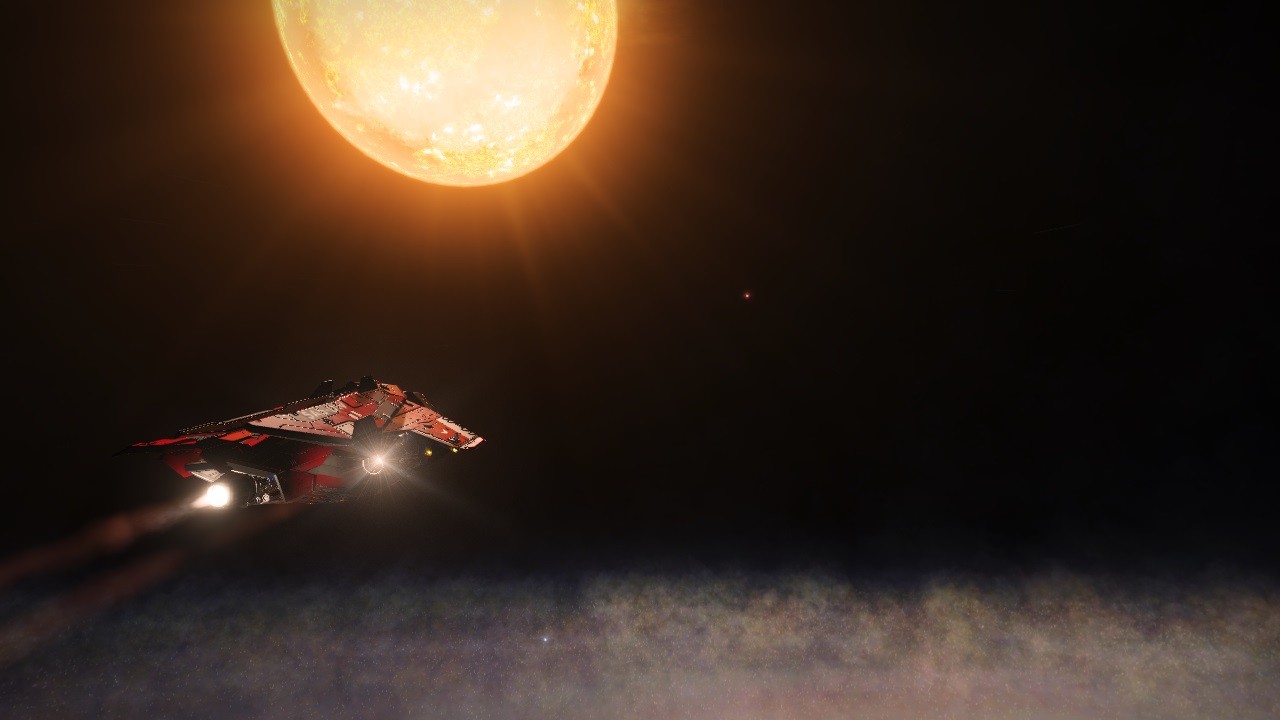
And here I am now. Registering this log with all the events of the last few days. There is nobody here yet. I arrived very early on this occasion. I have landed at Hades Edge, a flatness in the middle of a canyon from were to behold the magnificence of Goliath upon me. The perfect campsite. I have plenty of time, so I think I will open one of the Lavian Brandy crates I am carrying and have a drink in proper gravity while I wait for my fellow companions. Here is a toast to Distant Worlds 2.
Jav Marlo signing out.
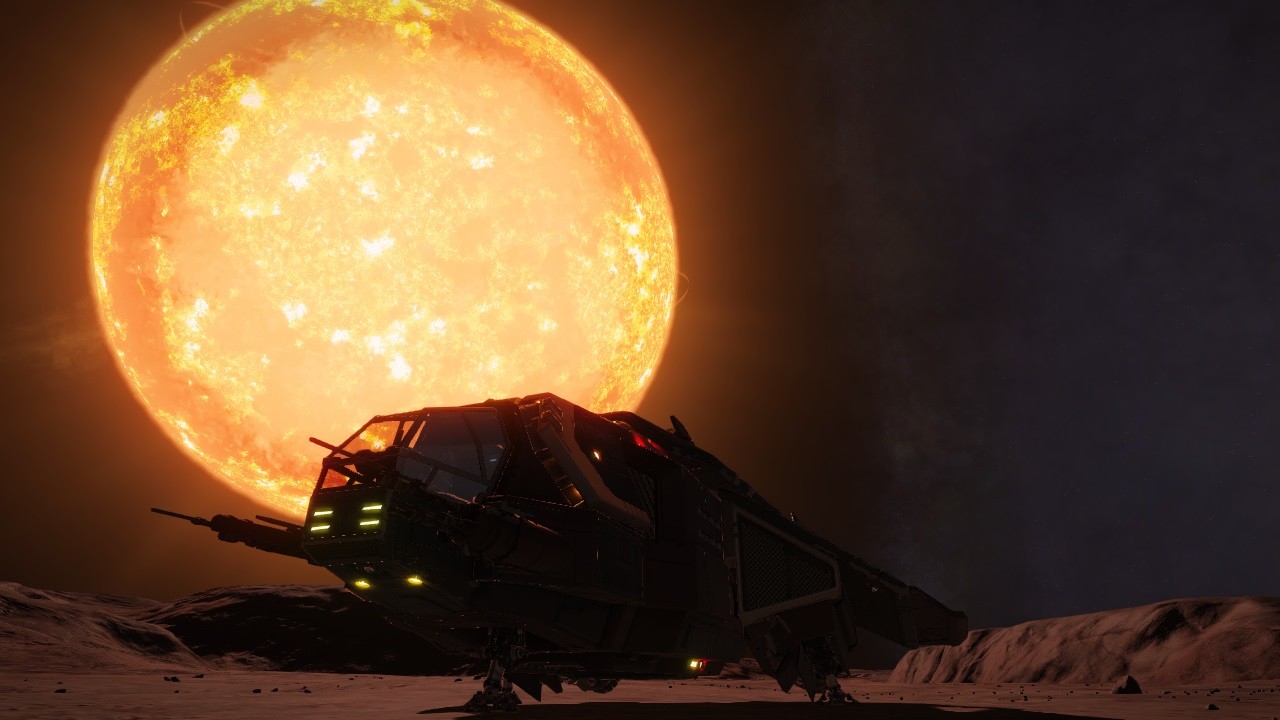
DISTANT WORLDS 2 (PART 10) – HUNTING WOLF-RAYETS AND THE ODIN’S HALL
17 MAR 3305 Explorer’s Anchorage (Stuemeae FG-Y d7561)
This is commander Jav Marlo onboard the Hyperion, landed at Explorer’s Anchorage, in system Stuemeae FG-Y d7561. I cannot believe I am just a couple of light years of distance to Saggitarius A, the very core of the galaxy. I barely can wait for the Hyperion to be refueled and patched. I want to see how it is.
As soon as the Hyperion is ready I lock Saggitarius A in the nav map and proceed to launch. A short jump later I am there. In front of the Supermassive Black Hole at the very centre of the Galaxy. As expected, there is a nav bouy, so I head there.
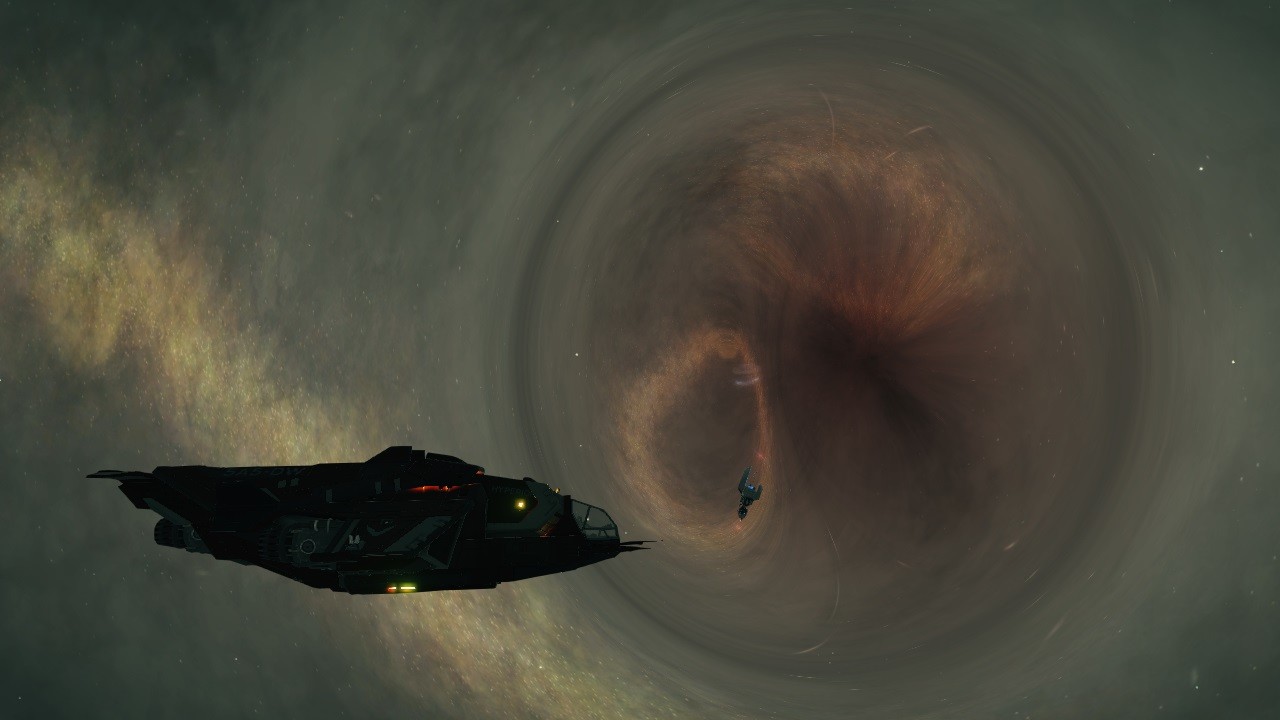
According to the Galactic Mapping Project database, since modern FSD technology made it possible to travel the extreme depths of space, Saggitarius A has been visited by hundreds of explorers. Some come here as part of a speed race or challenge, others to gain the experience and credits of scanning the most massive stellar body in the galaxy. Some come because their wanderlust drives them ever further from the regions around Sol, and others come as part of one of the many community expeditions that have made their way through this system.
Saggitarius A was first reached by CMDR Zulu Romeo, which I have heard is taking part on this expedition, in late November 3300 while he was doing a scouting mission for the First Great Expedition towards the galactic core. At the time no one expected that it would be possible to reach the galactic core before massive FSD failure would be experienced, but CMDR Zulu proved the resilience of modern drive technology by continuing on and on.
A later notable event here at the centre of the galaxy, was the record breaking meet-up during the Distant Worlds Expedition of 3302.
And now I am here too as part of the second Distant Worlds 2 expedition. Six months ago I was dreaming with owning my own spaceship and exploring the galaxy and now I am an Elite explorer who has reached the core of the Galaxy. The very centre of everything. I have become a true explorer, like my father, I only wish now he would be alive to see it. As far as I know, he never visited Saggitarius A.
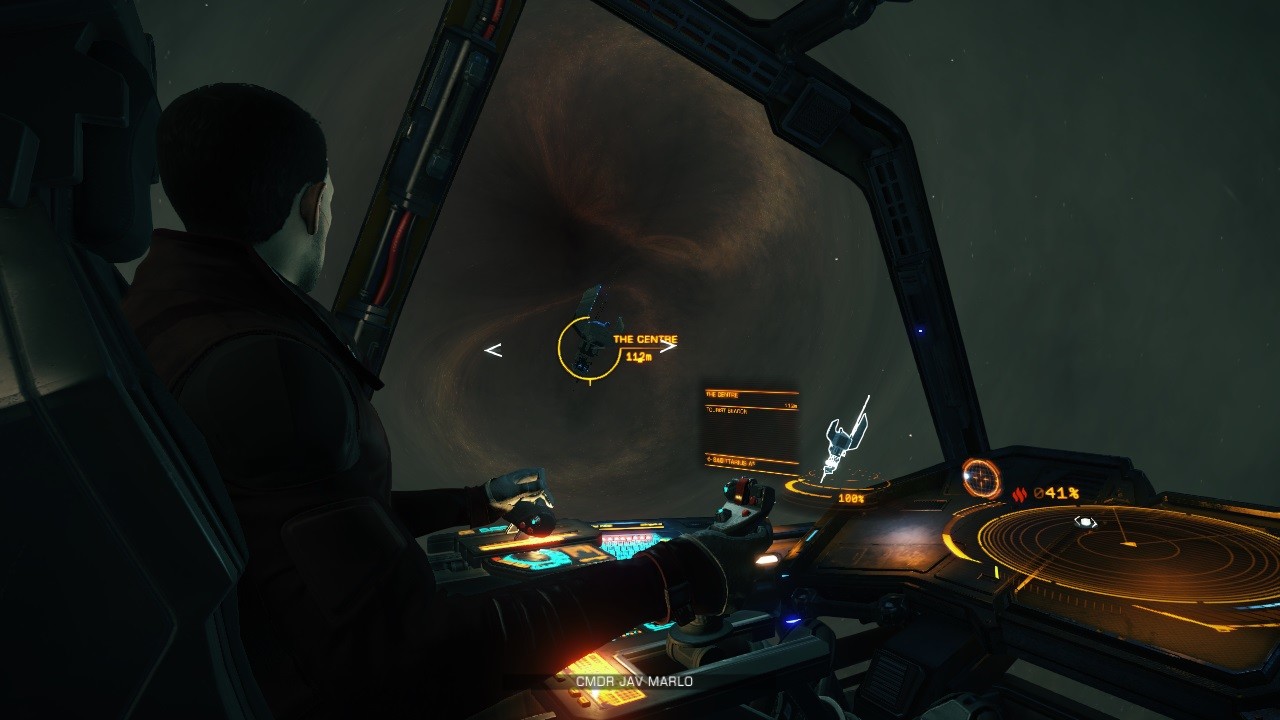
Well, if I want to catch up with the part of the fleet that has joined the excursion to Altum Sagittarii I better hurry up.
Resuming log. I have arrived to system Nyuena JS-B d342, commonly known as Altum Sagittari, that is situated two thousand light years above Sagittarius A.
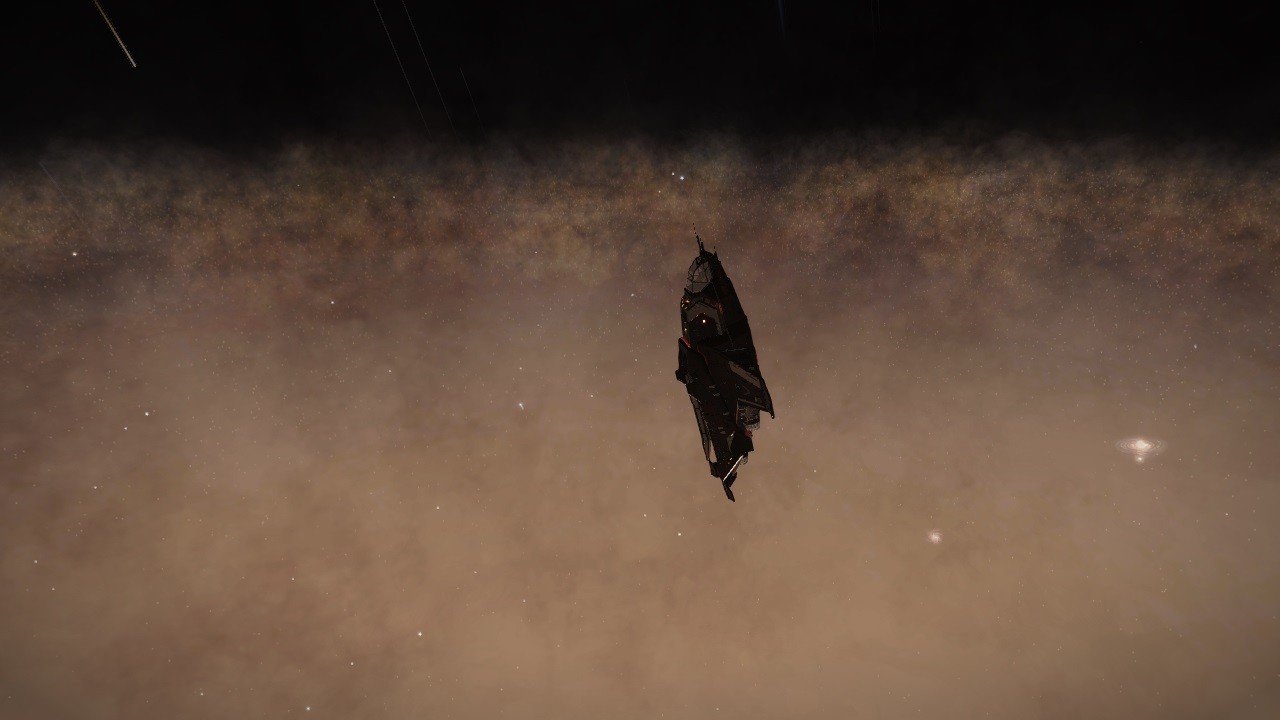
This system was one of the waypoints of the original Distant Worlds expedition. It is said that, from the basecamp of Gagarin’s Reach, in one of the moons of the fourth planet, there is a spectacular view of the expansive galactic core regions below. An awe-inspiring site that only a few have witnessed from first hand.
I am trying to locate the exact coordinates of Gagarin’s Reach when my sensors catch the echo of a signal. Probably a landed ship. I aim on its direction and soon I see a beautiful yellow Krait Phantom landed on a promontory that has to be Gagarin’s Reach. The ship is registered to March Top Cat, a fellow commander belonging too to the Distant Worlds II squadron. I scan his ship and hail him, but it seems the Krait is unmanned. He must has left in the scarab for exploring. I am happy of, at least, being able to catch up with another commander. Exhausted after the trip, I decide to take a sleep while I wait for commander March Top Cat to come back. The view is incredible, as promised.
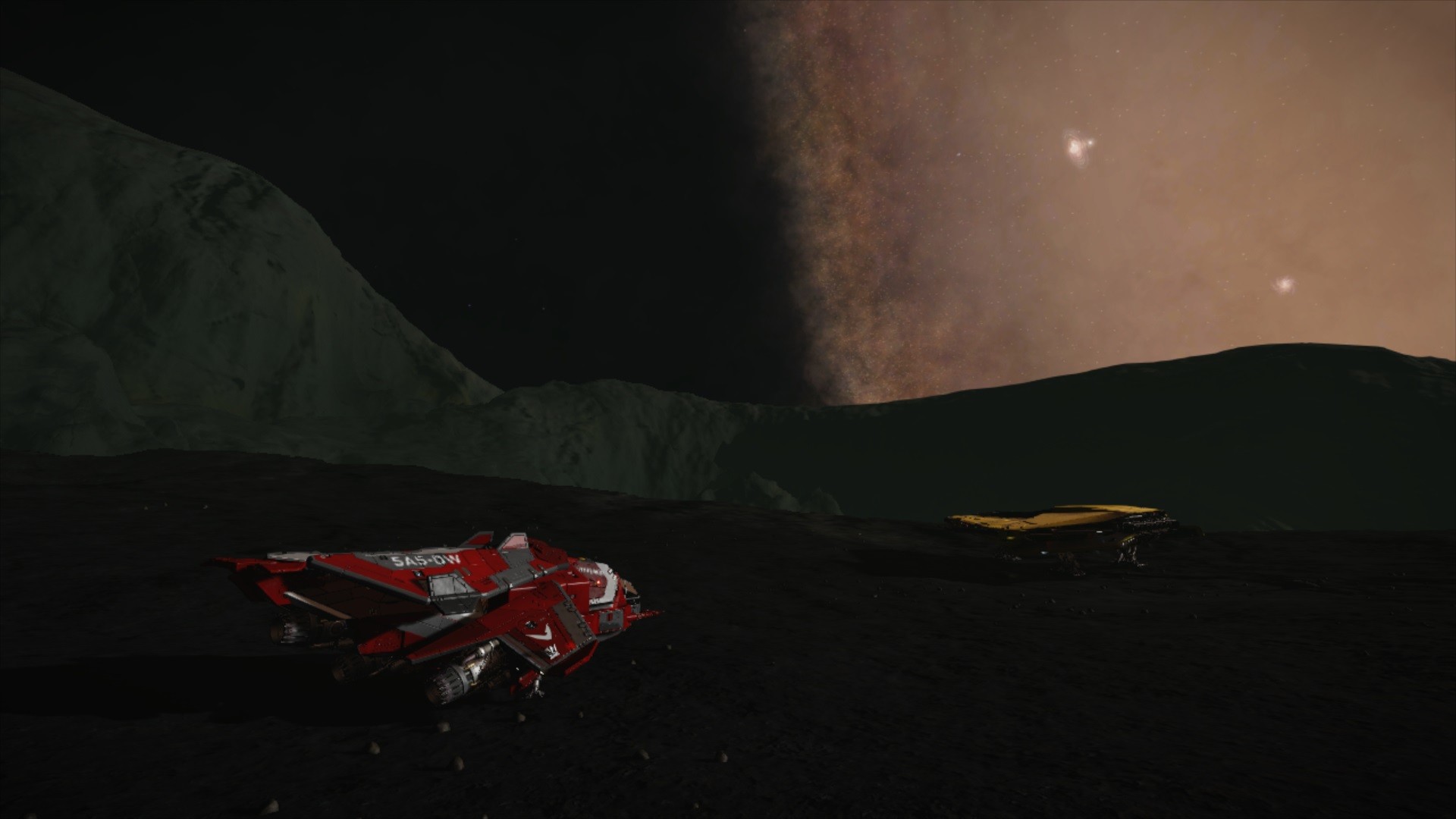
Resuming log. I just got up and there are no signals of commander March Top Cat. I am alone at Gagarin’s Reach. I better depart and head back to Explorer’s Reach.
The feeling of aiming towards the void with the whole galaxy below is overwhelming.
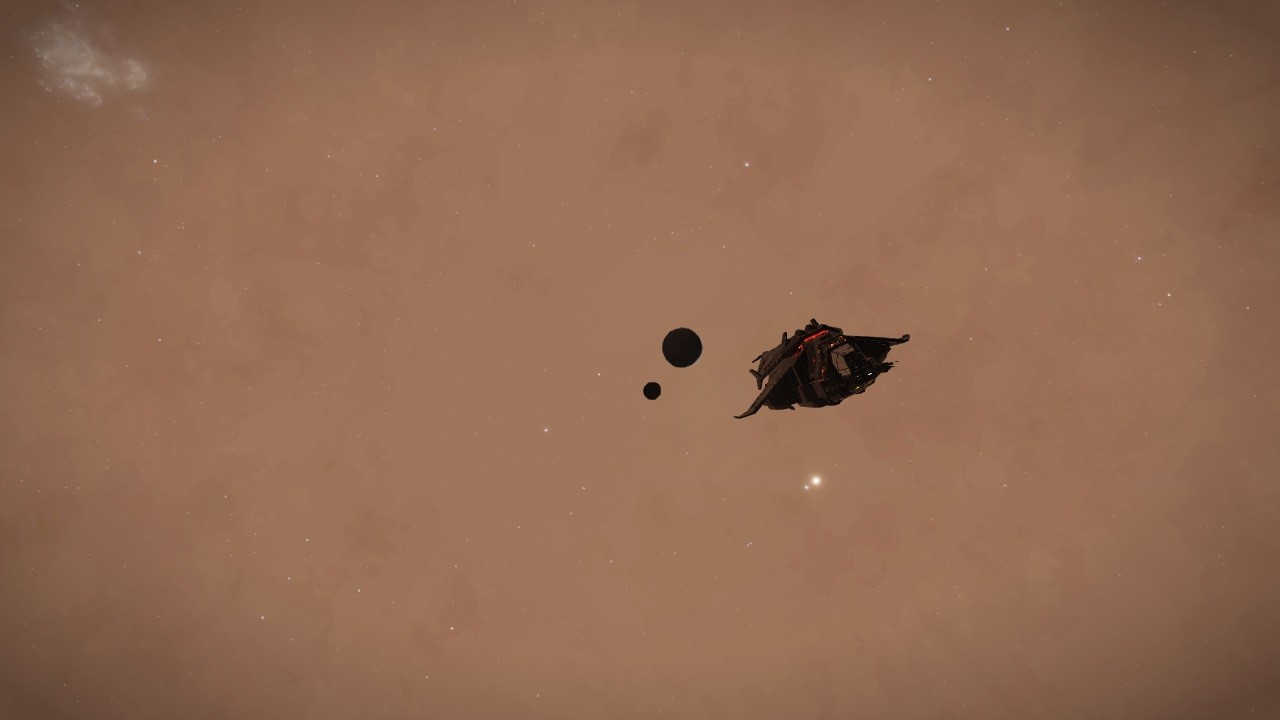
Resuming log. Before coming back to the starport, I have decided to pay a visit to the official basecamp of the expedition in system Stuemeae KM-W C1-342. Interesting! There are notable stellar phenomena on the system.
I have found prasinum metallic crystals and solid mineral spheres in the rings of the first planet.

Well. Armstrong Landing is deserted too. I guess everybody is exploring for mining sites or at Explorer’s Anchorage. I better get there too. I just hope there is place to land there still.
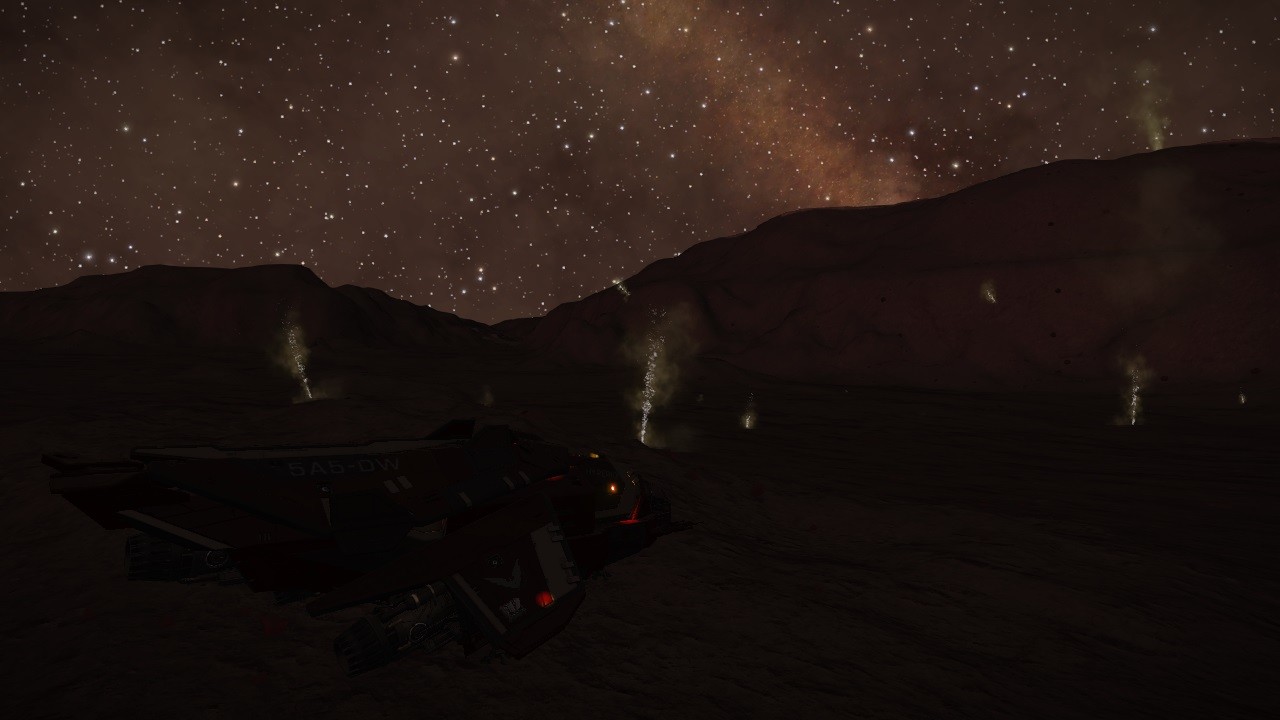
Resuming log. Stuemeae FG-Y D7561 is boiling with activity. There are commanders from the Distant Worlds 2 fleet flying everywhere. I have identified some ships too that only can be pirates. There are reports of attacks to the fleet in the system. Several commanders have been shot down. Some say that there are terrorist factions following the expedition and trying to disrupt its operations. Some even say that one of this factions may be the dreaded Smiling Dog Crew leaded by the notorious commander Beseiger. I better land and see what is happening. On approach to the spaceport I can see that the construction operations are marching at good path. There is welding activity in the pylons that will support the habitat ring.
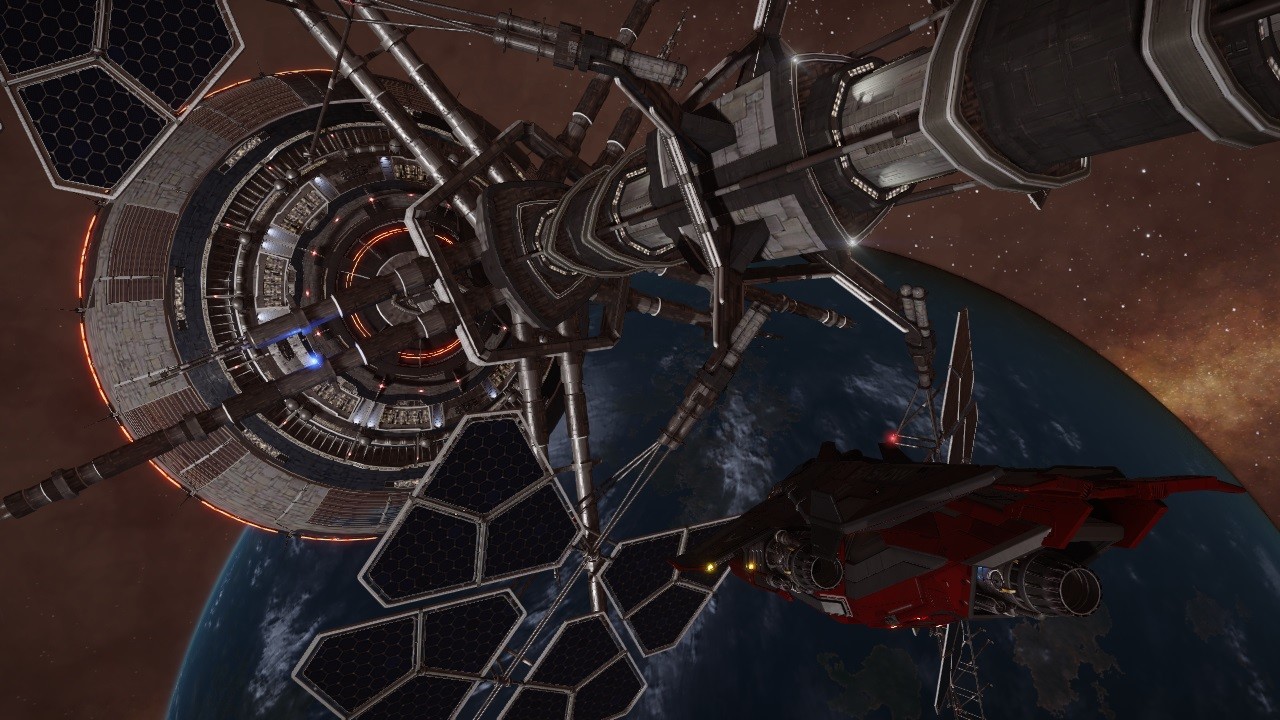
Resuming log. It seems that the Distant Worlds 2 fleet has done it again. Every inhabited system where this fleet expends some time destabilizes sooner or later. And this time it has been sooner. The moment the Ocellus Starport of Explorer’s Anchorage was deployed the problems started. The mighty task of building a starport in the core of the galaxy and the promise of a new life far from the tribulations of the Bubble has brought seven hundred and fifty thousand souls to this system, plus more than ten thousand ships of the Distant Worlds 2 expedition. The recipe from disaster. On this occasion the fleet did not even disrupted the local mining operations, like in Omega, before triggering the conflict among the local factions.
This system has entered in civil unrest. The problem is that if the situation escalates, the whole system will lockdown and all the station services will be disable. Bad timing when a huge fleet has been lured here with the task of helping in the completion of the next phases of construction. Presumably, there will be a call for mining different materials, like in Omega, and there will be a call too to hunt pirates or factions that might disrupt the operations. The situation must be deal with before the whole system collapse. I pity the poor devils that left the Bubble and all its misery to live here only to find war. Same old war.
Well, I am not taking part in this. I cannot and, besides, I have another kind of hunt in mind. Last time I was able to buy an old Type 6 cargo ship and equip it form mining in order to contribute to the community goal, but there is no shipyard here at Explorer’s Anchorage. The Hyperion is a pretty basic tiny explorer ship, not fit for mining or even less for combat; its shields were meant just in case of bumpy high gravity landings. One thing is clear. I cannot contribute this time, and I do not want to be here when all the mess starts. I am leaving. This new is space station is meant to impulse the exploration of the core regions, and I am determined to find some undiscovered Wolf-Rayet stars.
Resuming log. I am on route to the Zuneae sector, about six thousand light years from the core. Here is my plan. I have chosen a sector of the Empyrean Straits region in hope that it has not been explored in depth. The star density so close to the core is huge, and sector Zuneae is not in the path of any heavily transited route, so maybe there will still be some interesting systems there yet to be discovered and, hopefully some Wolf-Rayet stars with no commander’s names on then too.
Wait. I think I have detected an Earth-like world.
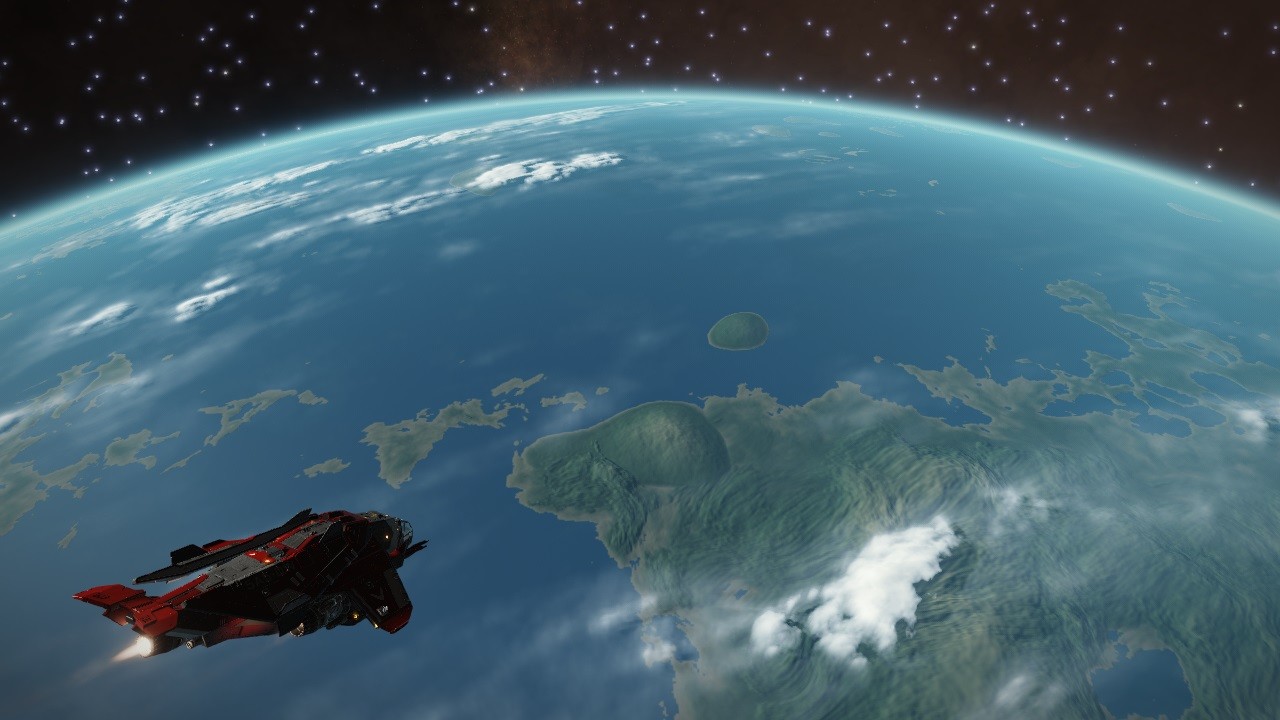
Resuming log. What makes Wolf-Rayet stars so appealing, besides the fact that the Galactic Mapping Project initiative gives you a badge for discovering one? Well, Wolf-Rayet are a rare heterogeneous set of stars with unusual spectra showing prominent broad emission lines of highly ionised helium and nitrogen or carbon. They were first observed by the astronomers Charles Wolf and Georges Rayet of old Earth back in 1867, fifteen centuries ago. They put out so much power that they usually blast off much of their outer layers to form nebulas around them. They have very high surface enhancement of heavy elements, depletion of hydrogen, and strong stellar winds. Their surface temperatures range from 30,000 K to around 200,000 K, hotter than almost all other stars. All Wolf-Rayet stars are highly luminous due to their high temperatures, reaching thousand times the luminosity of the sun, with most of their radiation output on the ultraviolet side. They represent a late stage in the evolution of highly massive stars, usually O-type. And there should be only around a thousand of these objects in the whole galaxy.
Summarizing, they are beautiful, violent, heavy, hot, bright and very scarce. That makes them coveted by the explorers. It is a mark of pride to being able of discovering one of these rare stars and “tag” them with your name. Since the FSD technology became mainstream five years ago opening a golden age of space exploration, many intrepid commanders have come to the unexplored regions of the Milky Way in hope of reaching notoriety by associating their names with one of these scarce stars. And nowadays, it has become quite difficult to find one of these stars that has not being claimed. But I intend to do it.
Resuming log. I have localized a Wolf-Rayet Star in system Zuneae AA-A H2 and I am jumping there.
There it is. As bright and beautiful as I expected. It has more than one hundred times the mass of the Sun and a surface temperature of nearly 30,000 K. And it has the name of commander PrimalHumanRage on it too. Damn it! He got it first. Hey! Wait a second. The system has other three class O type stars, and it appears as unexplored in the Galactic Mapping Project database. Probably commander PrimalHumanRage navigation computer is not linked to the Mapping Project database, so I guess I will get the credit and the badge for discovering this Wolf-Rayet after all. But it will not have my name on it. I want to tag with my name one of these stars, so I must continue my quest. It would have been a lot of luck to find an untagged Wolf-Rayet at my first try.
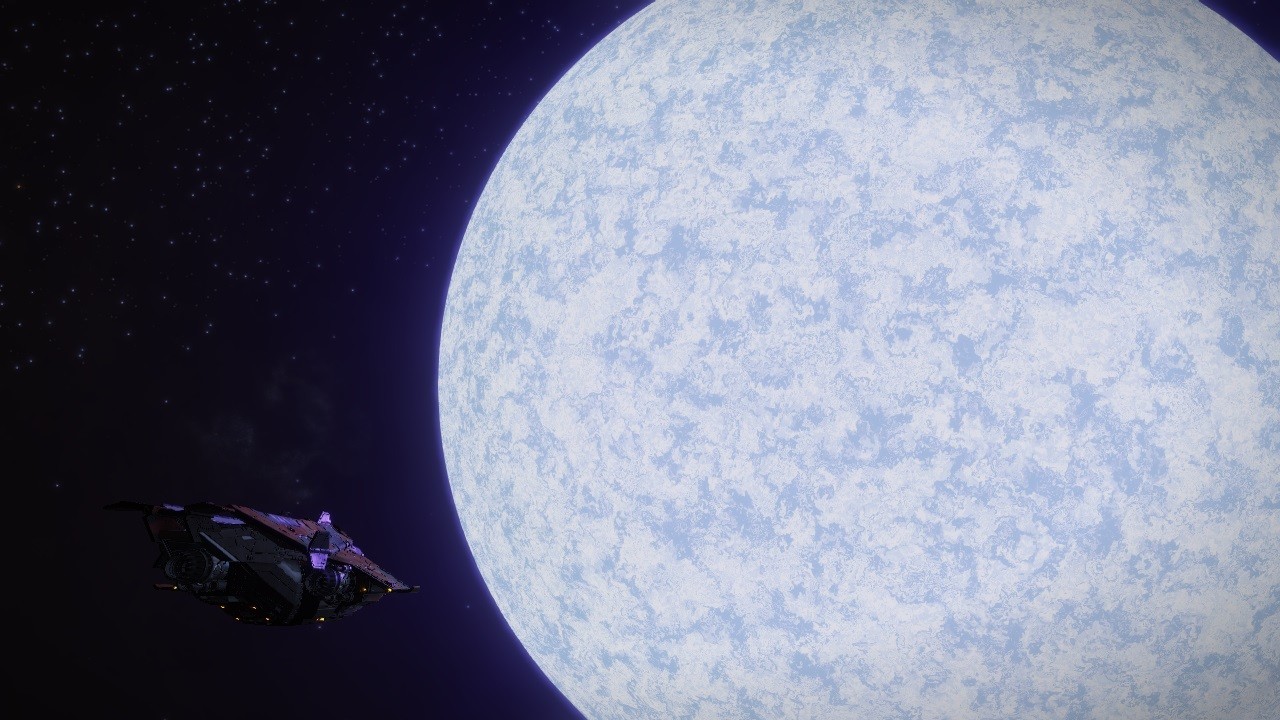
Resuming log. I did it! After looking in tens of systems already explored by commander PrimalHumanRage, I finally found an untagged Wolf-Rayet star. But it is red, not violet. It is a tiny Wolf-Rayet O with eighty solar masses that burns mostly oxygen and has a surface temperature of just 6,720 K. That explains its reddish hue. Well. It does not matter. It is an unclaimed Wolf-Rayet and it will have my name on it. Now, I want to find one of the big blue ones.

Resuming log. I have found another reddish unclaimed Wolf-Rayet. This one is fifty solar masses and has a surface temperature of just 3,672 K. It seems to be burning Nitrogen and Helium.
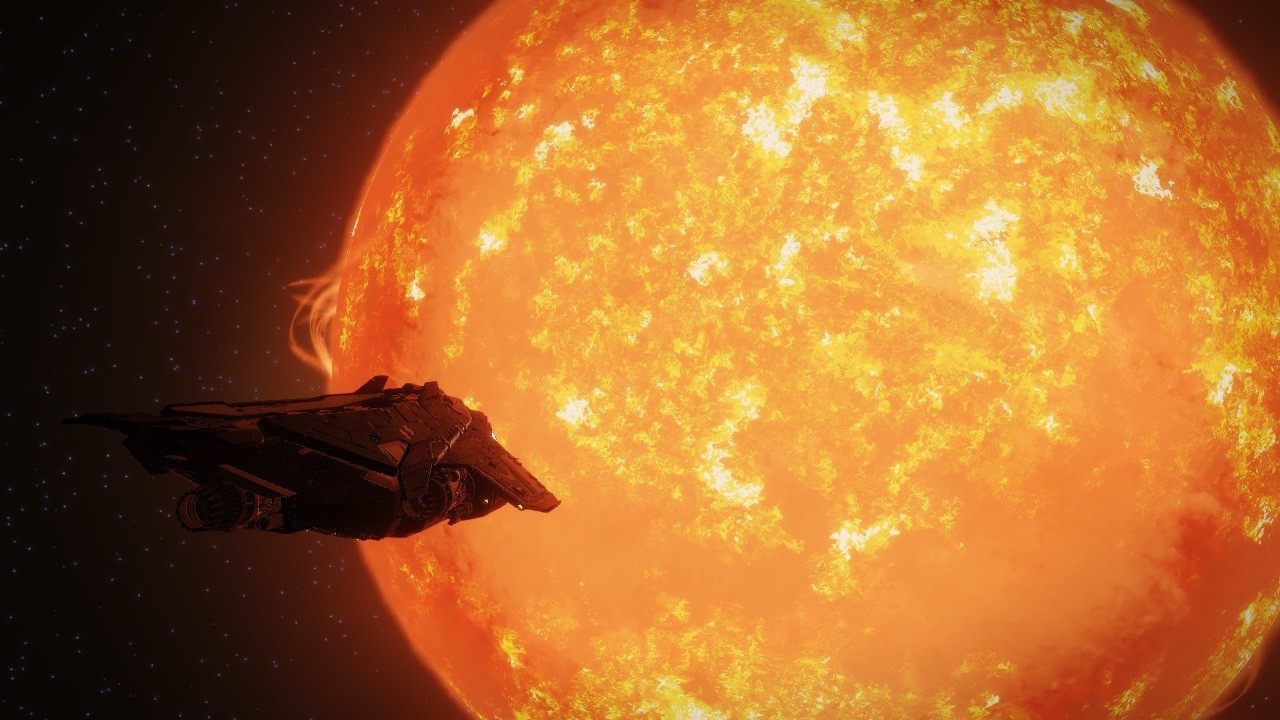
Resuming log. Finnally I found my own violet unclaimed Wolf-Rayet. This one is burning oxygen too, but it has more than one hundred solar masses and a surface temperature of 50,989 K. Shiny!
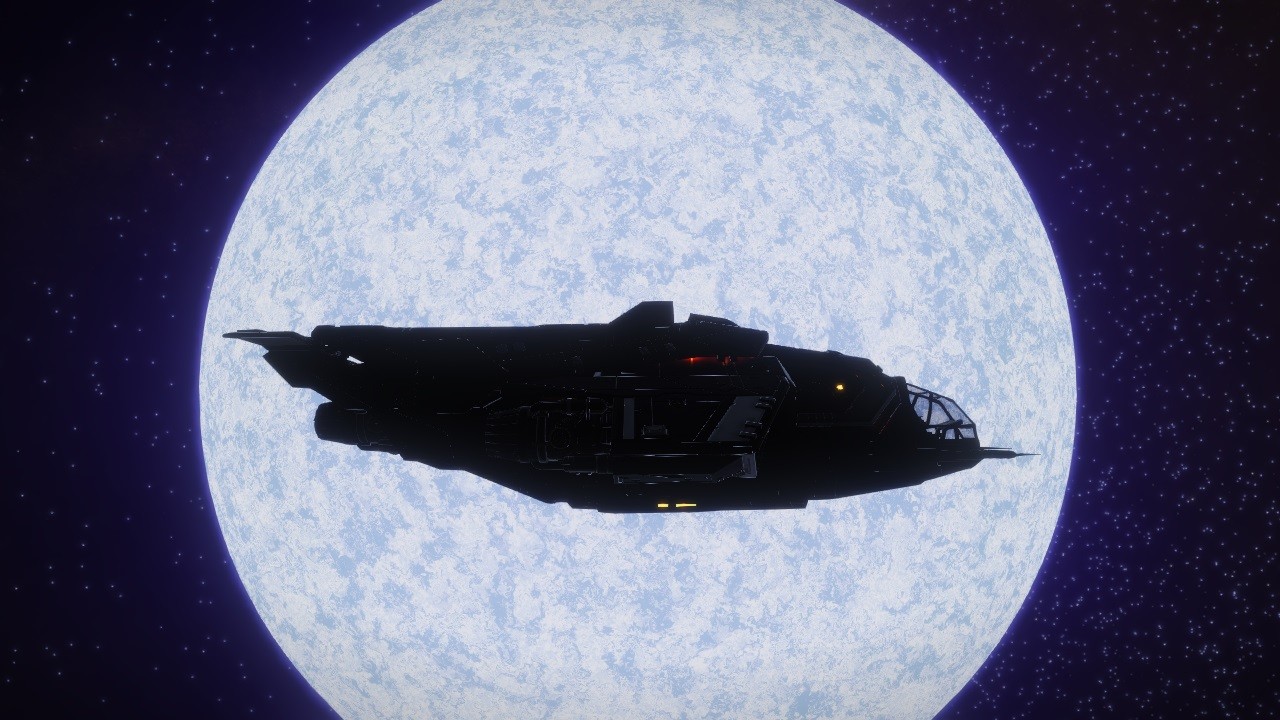
Resuming log. In the last twenty four hours I have found many other Wolf-Rayet stars in system Zuneae. Most of them were already claimed by commander PrimalHumanRage, but few of them were yet undiscovered. I found a couple of black holes and an Herbig Ae/Be star system, all already claimed too.
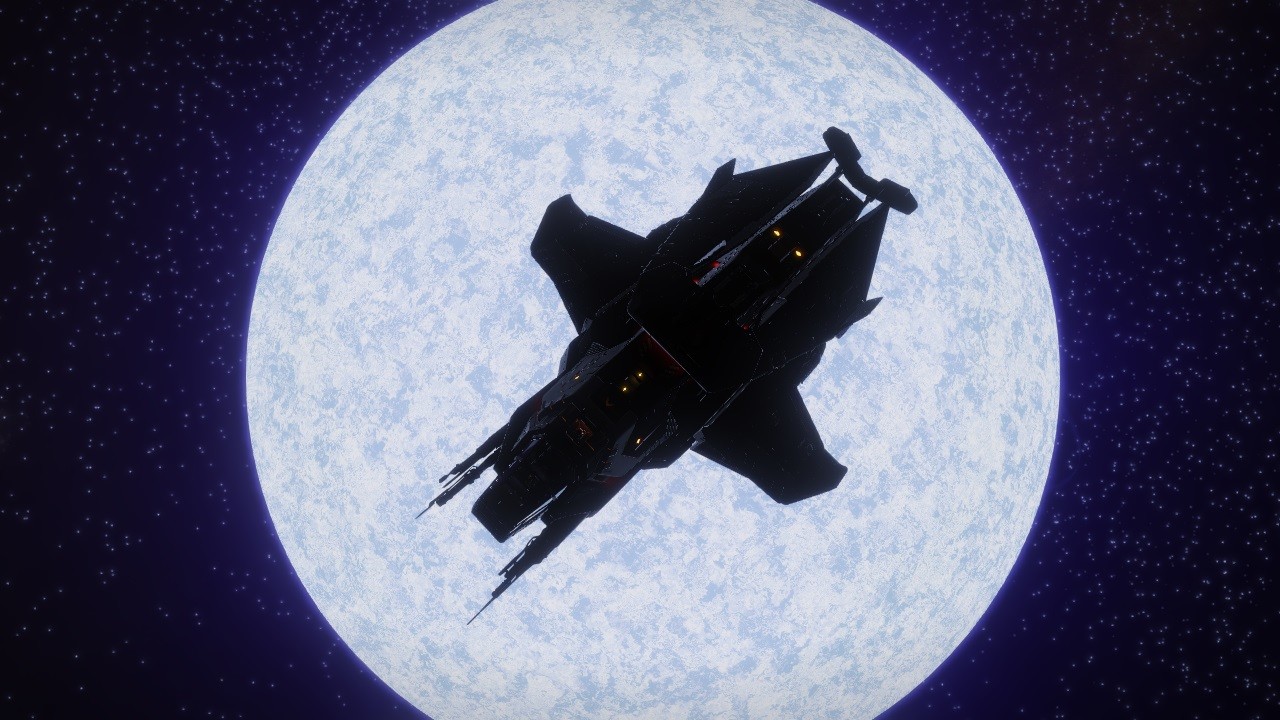
Resuming log. I am looking for a place to land and rest after all this Wolf-Rayet hunting. I am exhausted. I think I have found and interesting planet in system Zuneae GX-J d92624. The ninth planet is a terraformable high metal content world. I am going to approach and probe it.
It seems it has many geological sites. Well, let’s choose one and land. After all this jumping from system to system, some gravity and a ride on the scarab will feel very nice.
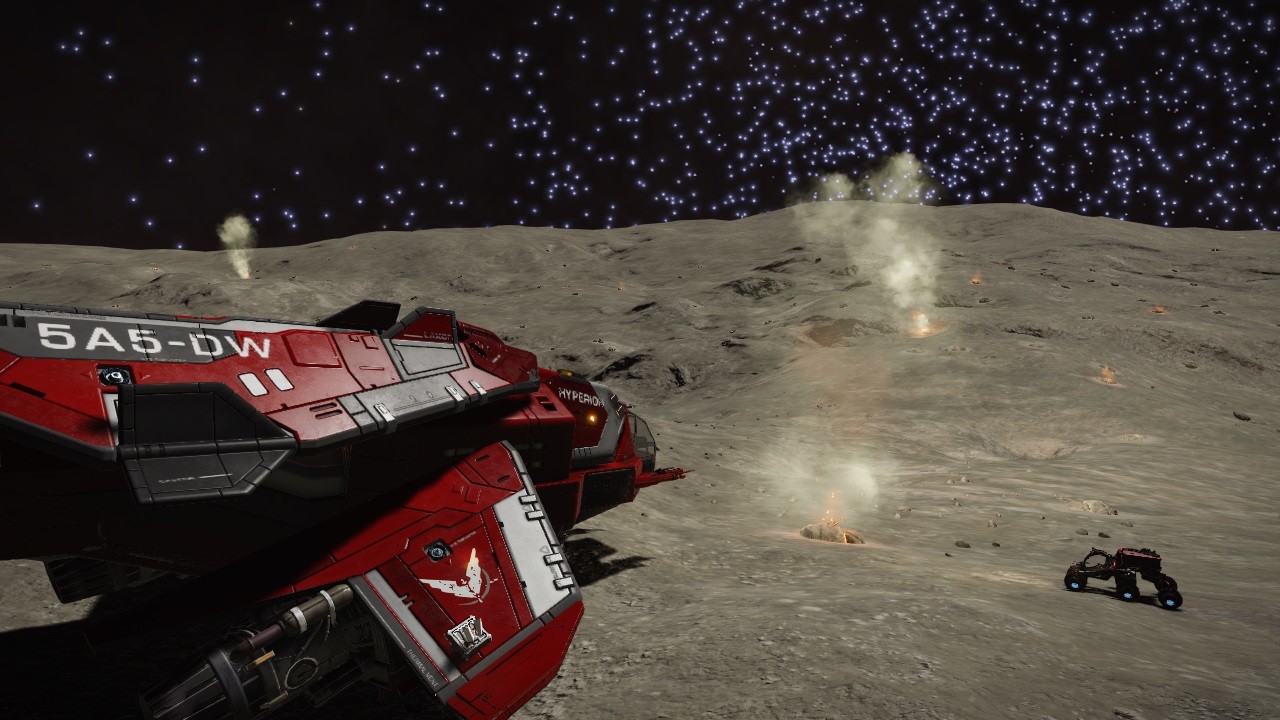
Resuming log. My plan has worked perfectly. There are thousands of stars in this sector and, despite the exploring efforts of CMDR PrimalHumanRage, there are still many interesting systems yet unexplored and even some Wolf-Rayet stars waiting to be discovered.
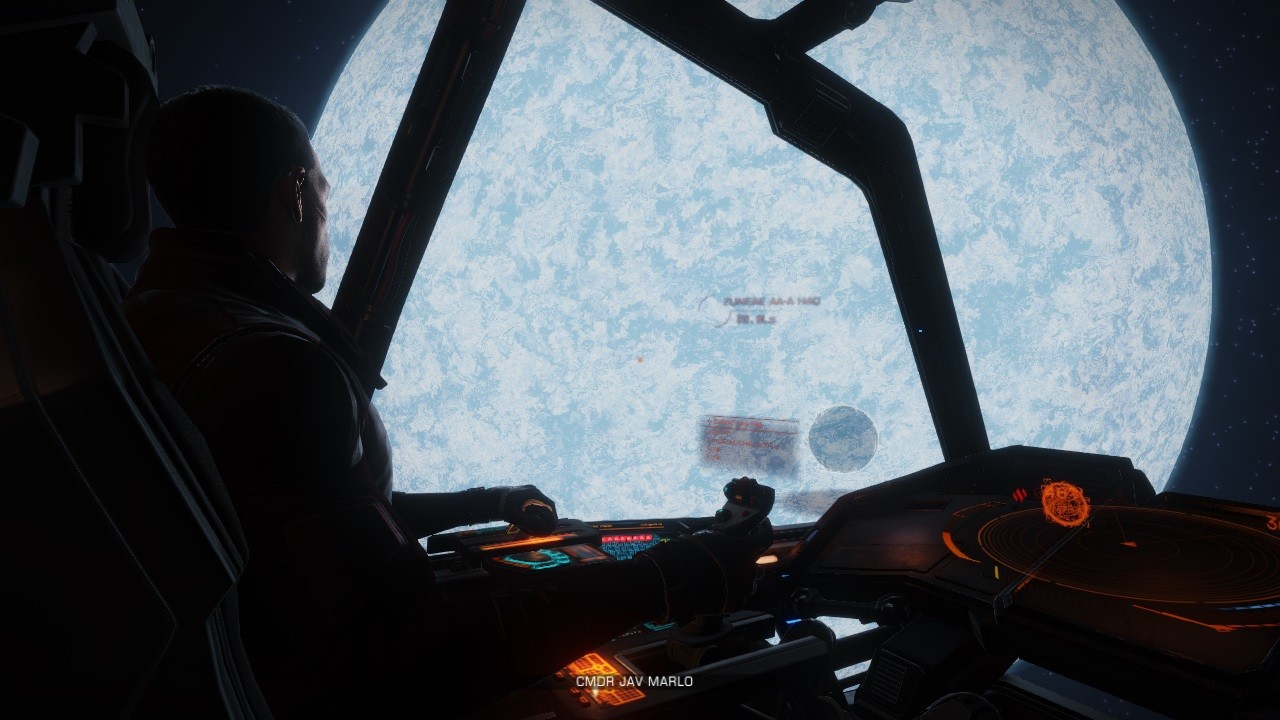
In the last hours I have discovered many new Wolf-Rayet stars that have never been visited by a human.
Some of them were huge, like the one I found in Zuneae AA-A h45 which had one hundred and twenty solar masses.
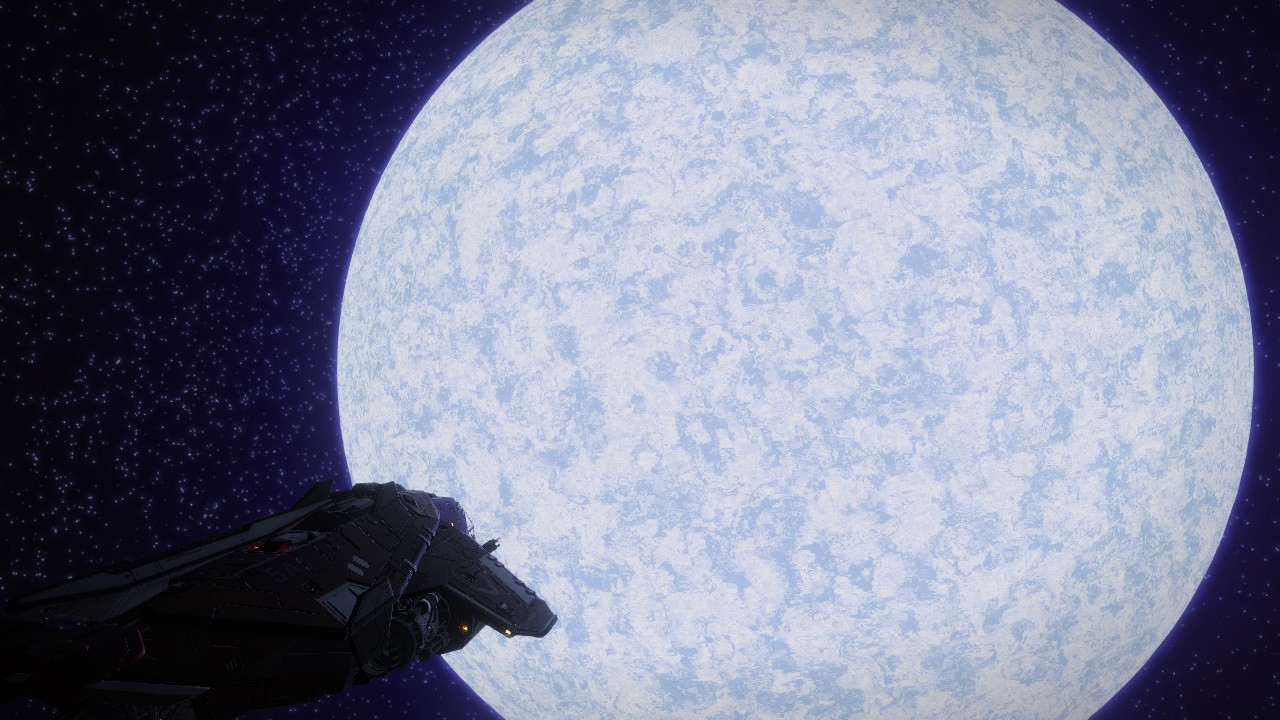
I found one with a solitary orbiting high metal content world. The star casted a beautiful violet light over the planet creating a mesmerizing sunset.
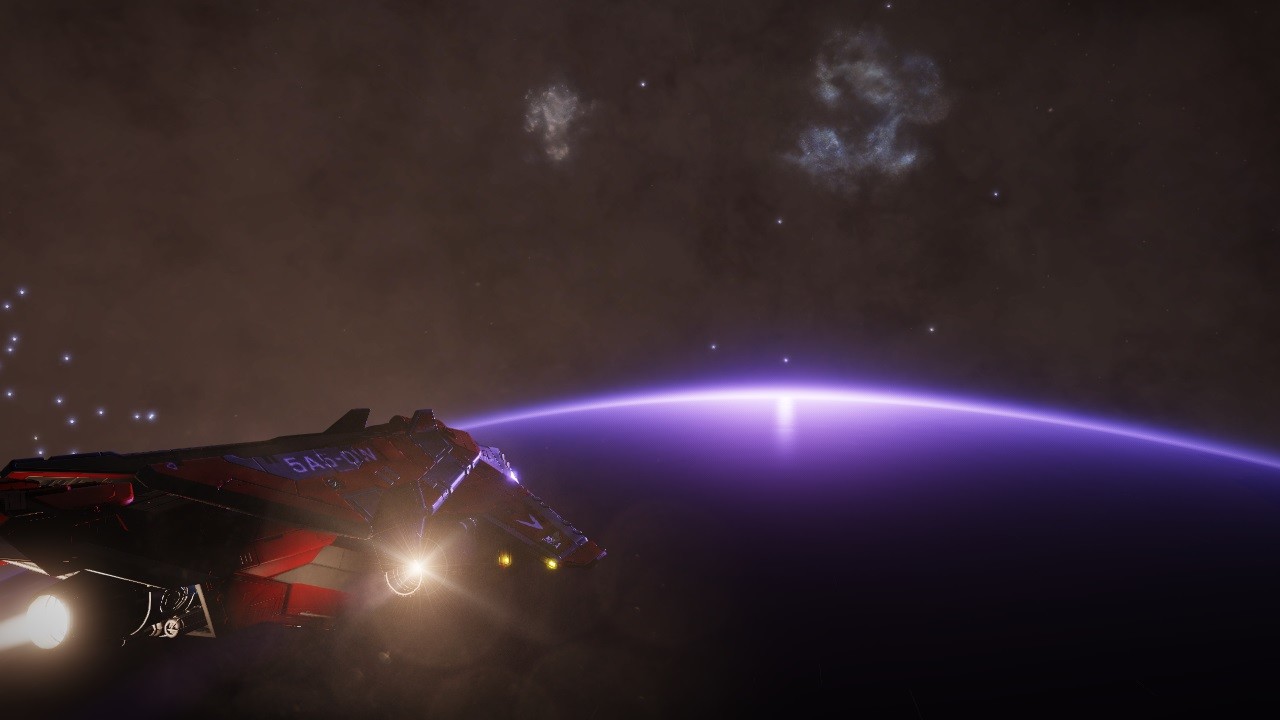
Many of them had a sister O type star orbiting near. And on occasions the orbit was so tight that, from certain angles, both stars resembled me the eyes of a mythological god scrutinizing the vastness of space.
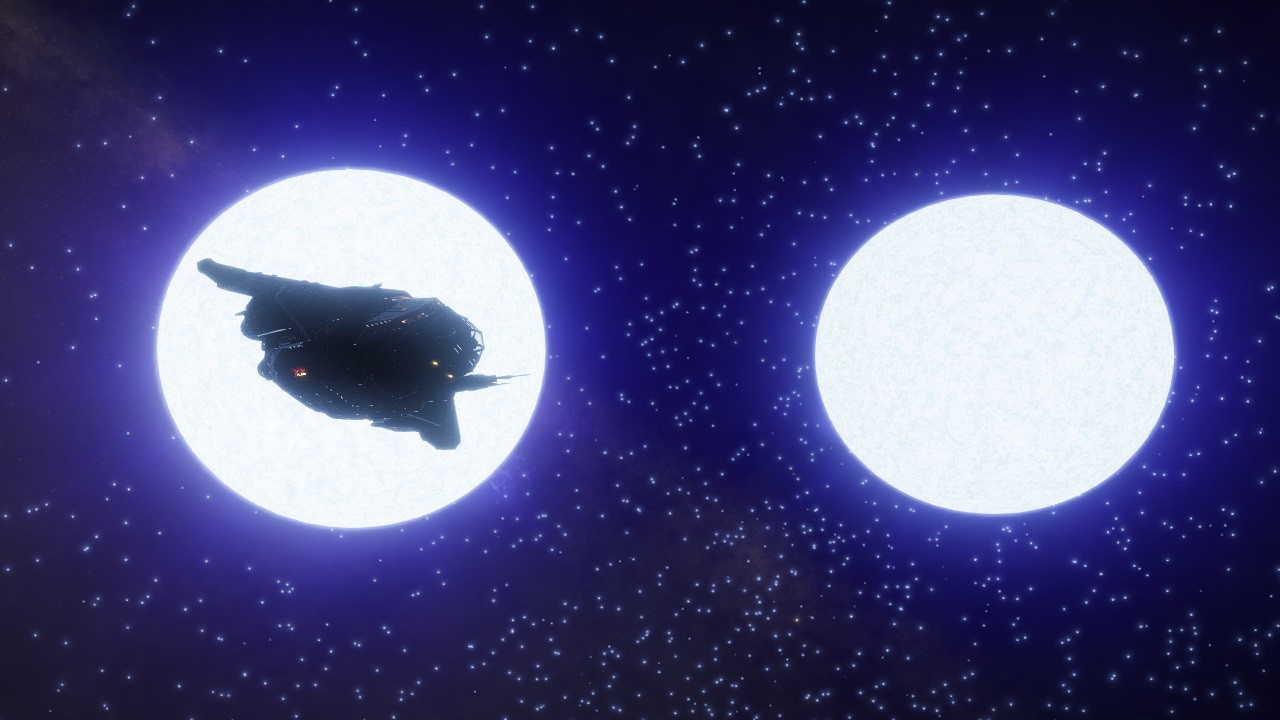
One of these systems almost killed me. It was in Zuneae AA-A h67. The system contains a Wolf-Rayet star, two O Blue-White stars and a Herbig Ae/Be Star. The problem is that the Wolf-Rayet and one of the type O are orbiting very close, and both of them have a surface temperature over 50,000 K. The perfect oven. Seconds after I dropped into the system the high temperature alarm triggered. For the record, I arrived at zero impulse power and the Hyperion is a heavily modified Diamondback Explorer with all systems A rated and a low emissions power plant. I turn out and tried to gain distance with the stars as fast as I could, but it was not enough. I started to suffer module damage. I fired a heat sink and that bought enough time to save the ship but, incredibly, the temperature started to rise dramatically again when the effects of the heat sink passed while I was still gaining distance. At the end, I just suffered minor module damage, but this system is a death trap. Explorers be warned!

Besides the Wolf-Rayets, I have found several undiscovered black holes in this sector. I had seen many of them before, but never found an unexplored one. I think that will gain me another badge from the Galactic Mapping Project initiative.
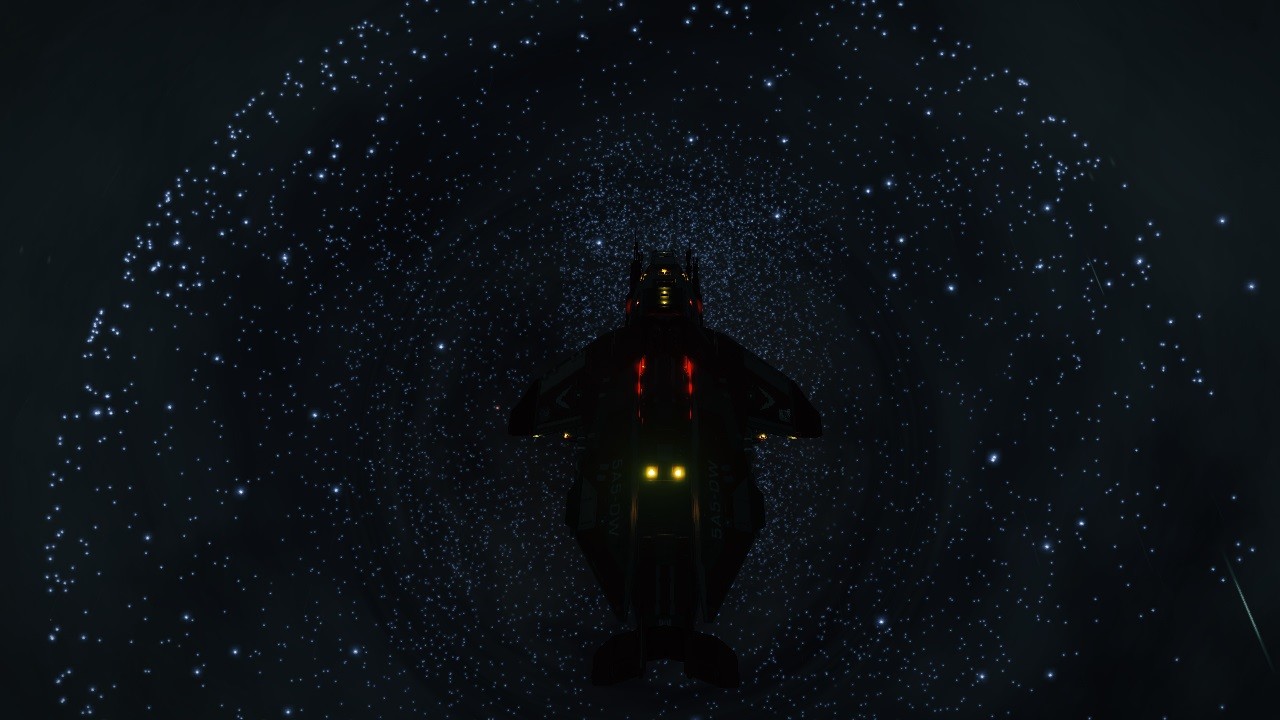
I am landed now in system Zuneae VE-P d6-4040. I have a found a solitary landable ringed high metal content world orbiting a neutron star and thought it was a good place for resting some hours. I chose myself a cozy crater with a plateau in the middle and a nice view of the ring.

Resuming log. I am on my way back to Explorer’s Anchorage. This week exploring Zuneae sector has been very fruitful. I have discovered many Wolf-Rayet stars plus some black holes and many terraformable planets. I have stopped a moment at system Zuneae AA-A h287 to behold a blue-white supergiant with an orbiting class V gas giant.
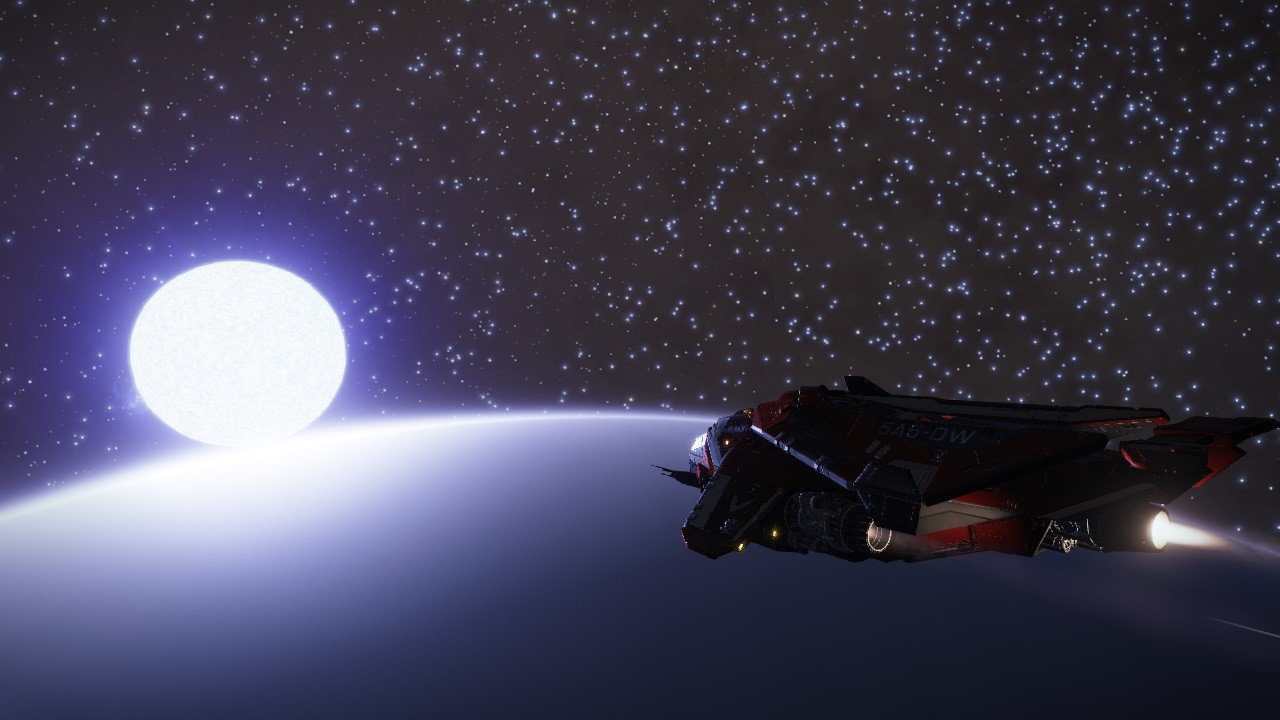
Resuming log. I have just arrived to system Stuemeae FG-Y D7561 and I can see that the construction of the habitat ring is progressing. That means that the civil unrest is under control now. The Earth-like world is blocking the light of the red dwarf making the sparks of the welders shine in the dark.
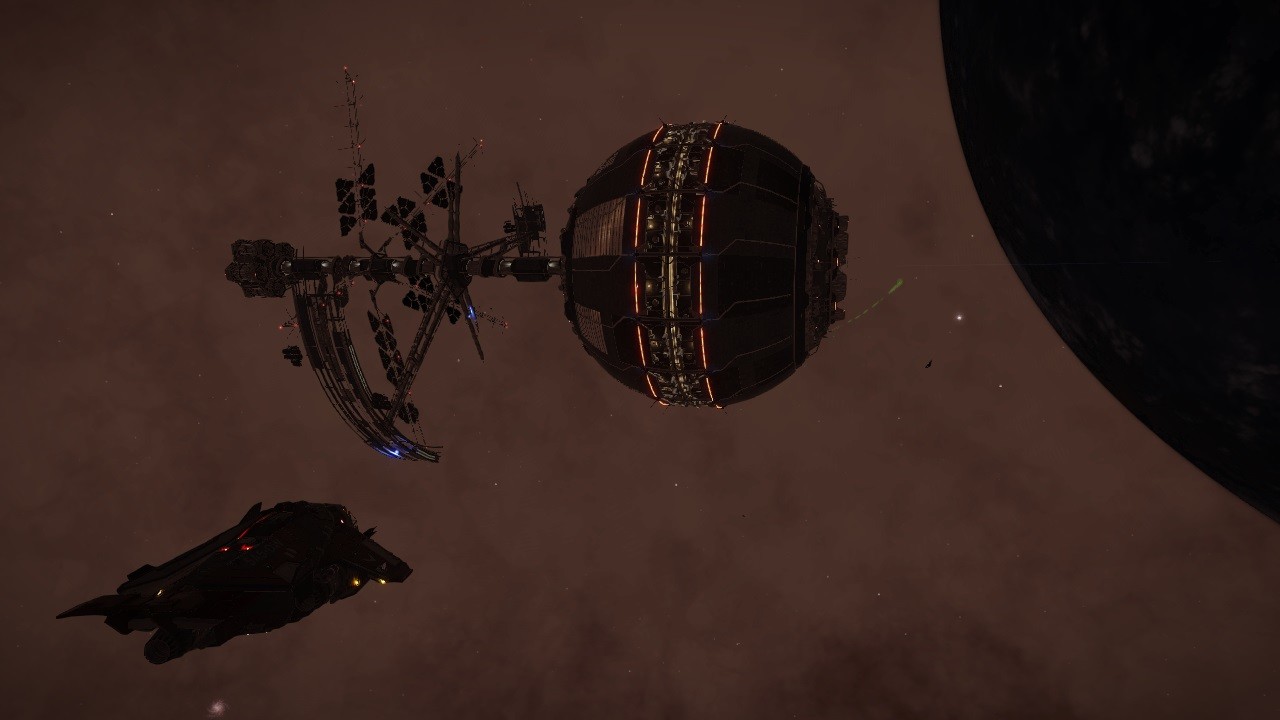
The deck crews at Explorer’s Anchorage tell me that the construction of the habitat ring is progressing as planned. I have talked with a delegate of Deep Space Surveys, the controlling faction, and he says that the security is now under control and the economy is in state of investment. He thanks the Distant Worlds 2 fleet for helping redirecting the situation and providing the necessary materials. Well, there is no task big enough for a ten thousand ships fleet, I said. I cannot avoid to feel like if I had skipped my duties and left to do some tourism on the other side of the core while other fellow commanders remained here doing the hard work. I am part of this fleet and contributed to the construction of this spaceport back in Omega using a mining ship I bought there. Alas, on this occasion I could not be of much help in the mining effort and I was not willing to participate in a civil war twenty five thousands light years away from the Bubble. Anyhow, I want to express my gratitude to all the commanders that contributed to this goal.
The news from the Bubble are very depressing. It seems that the Thargoid raids are becoming more violent every day and several systems from the Alliance and the Federation space have been swarmed. I feel the same in respect to this, like if I was running away in a sightseeing trip across the galaxy instead of staying at home to fight the invaders and defend the human territory against the alien attack. But this feeling is not new, it has haunted me since the expedition started. I better go to the Universal Cartographics office to collect my reward and write my name on some of those Wolf-Rayet stars and later I will maybe look for a bar to have a drink.
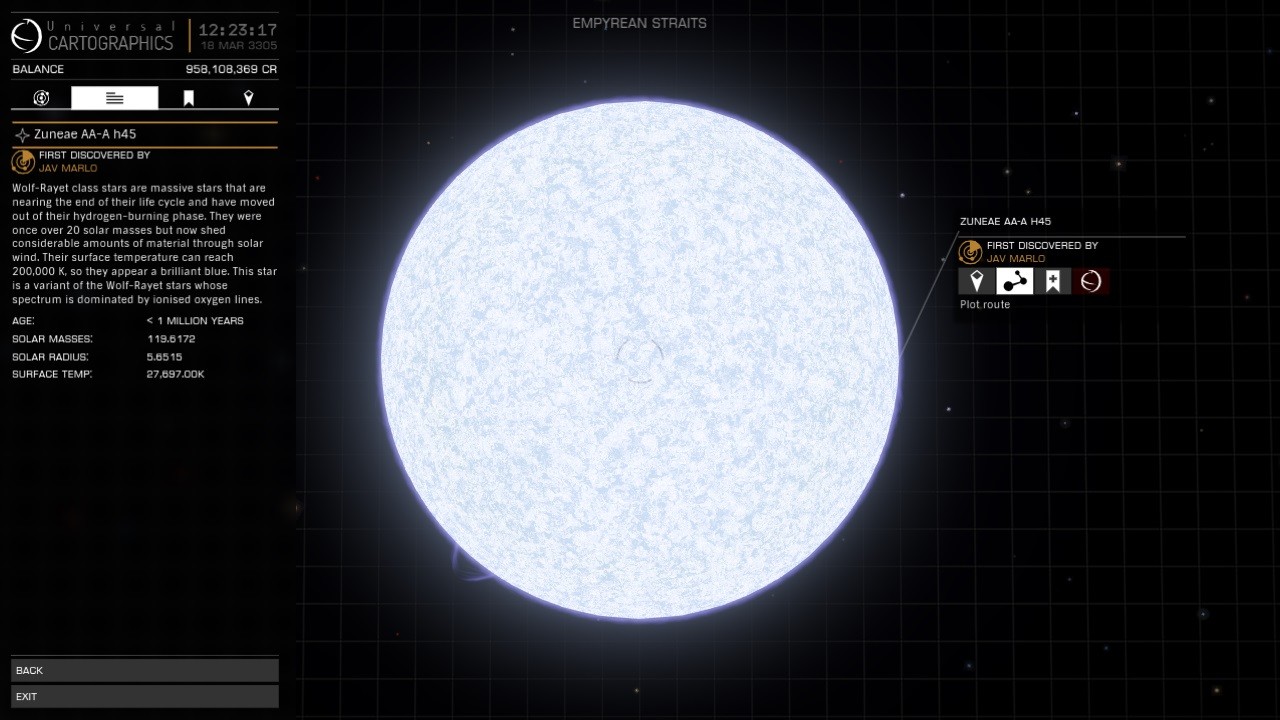
Resuming log. I was having a drink at one of the bars of the station, mingling with other fellow commanders, when I caught a conversation about an excursion to the Peak, the highest known system, discovered months ago by CMDR Straha Yeagar. The place sits three thousand one hundred eighty light years above the galactic plane, at is only at four thousand five hundred light years from this station. System Systae Free AA-A h1 is also a records breaker, holding several stars, three black holes, rocky bodies, three water worlds and one Earth-like world. Amazing! Too hard to resist. Captivated by the epic story of the voyage of CMDR Yeagar, I run to the Hyperion ready to reach the Peak.
Before starting the climbing to the Peak, I take a moment to observe the progress of the construction of the habitat ring now at daylight.

Resuming log. I have found an Earth-like world in system Phua Aub DJ-A c1-387. The size and configuration is very similar to original Earth and it even has a single landable moon.
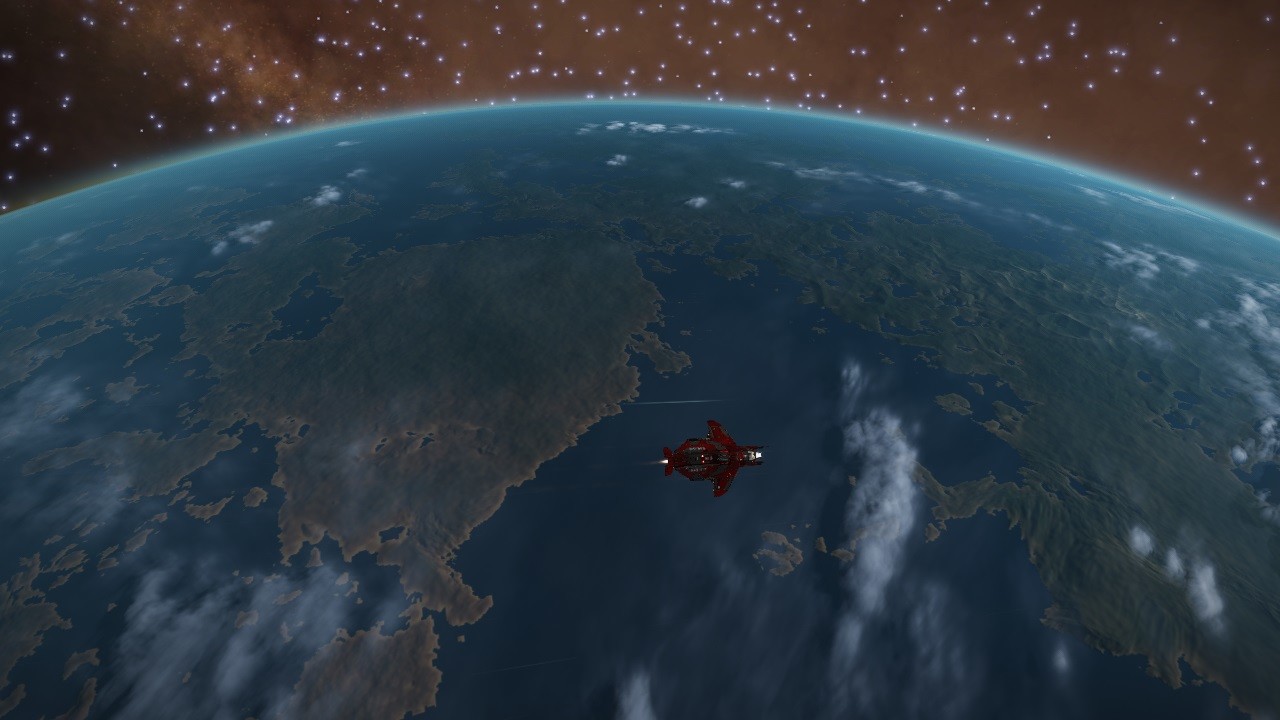
Resuming log. I have found another Earth-like world in system Phua Aub NS-B D3914. This one is one third the size of Earth and shares its orbit with a waterworld.
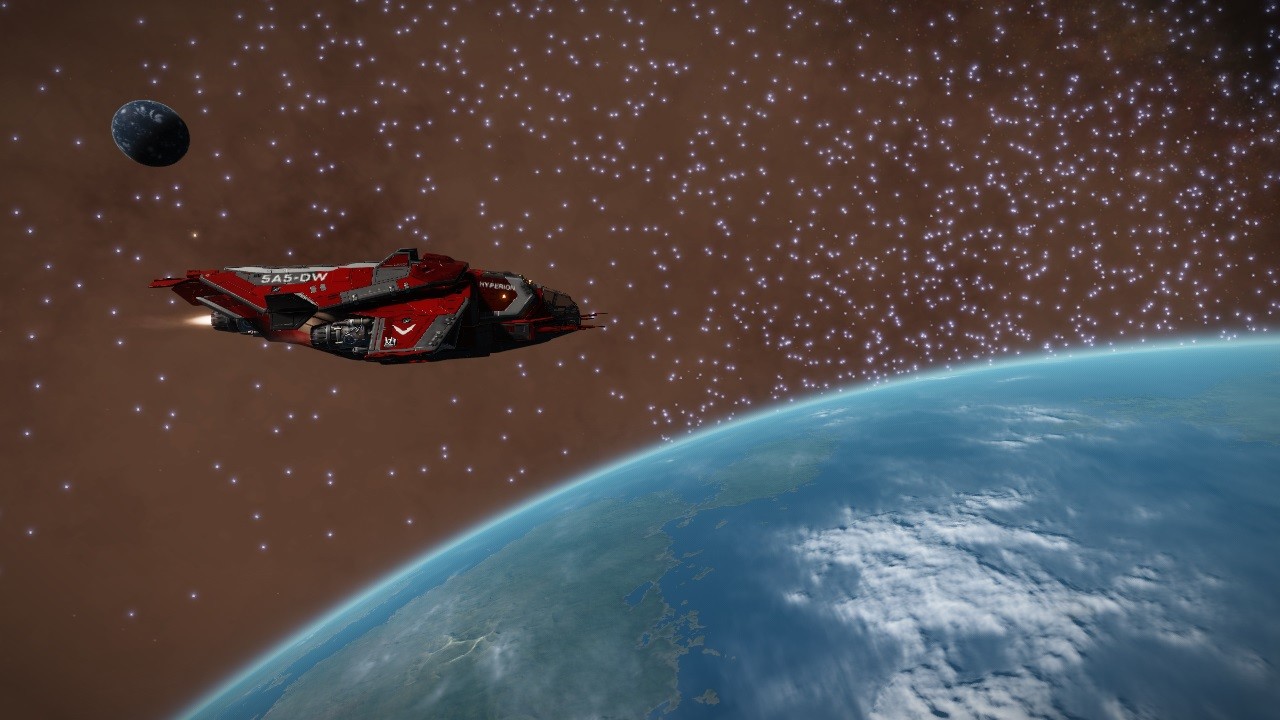
Resuming log. And just when I thought I was becoming a seasoned explorer, I made a stupidity. I was unable to lock system Systae Free AA-A h1, aka the Peak, on the nav computer, so I aimed to system Systae Free AA-A h3 instead, and traveled there using the neutron highway, taking advantage on the FSD boosts. Well, my last neutron overcharged jump has dropped me, finally, at system Systae Free AA-A h3, and now I cannot lock any system in the nav computer. There are no other systems in my jump range around. I am trapped here, alone, in the top of the galaxy.
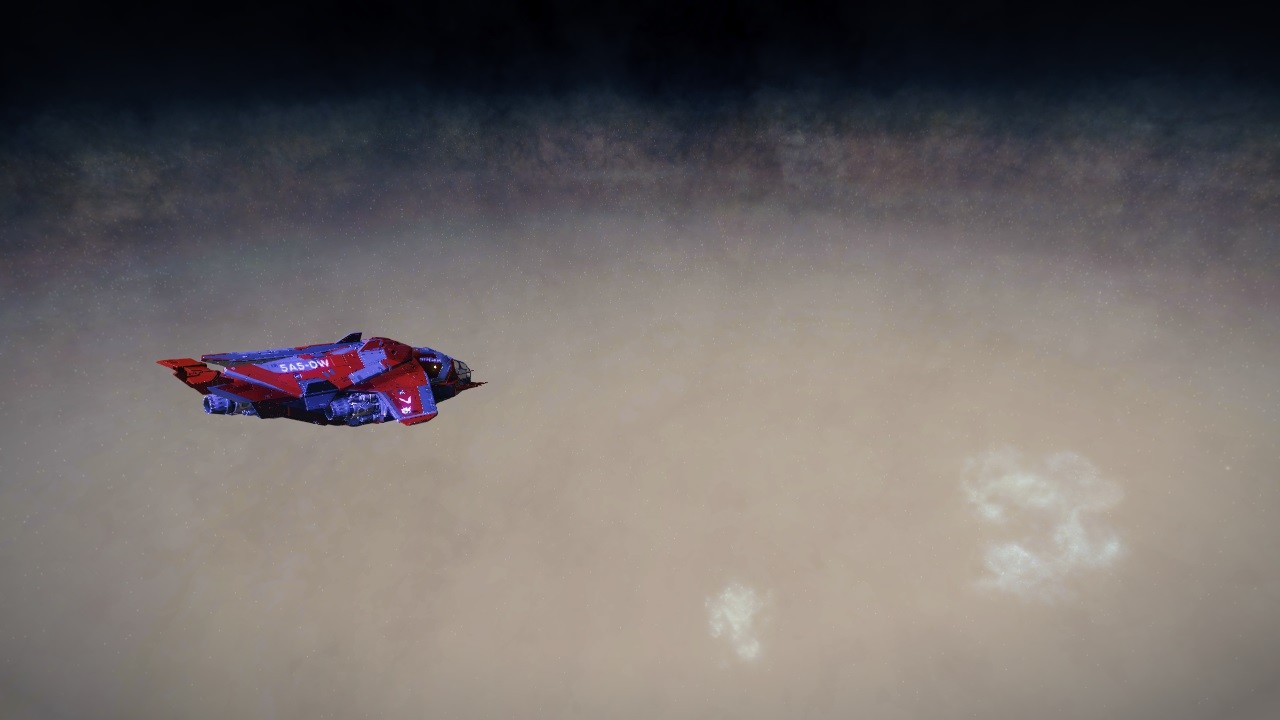
Do not panic! First things first. The only body in the system is a big blue-white star scoopable. Well, I have fuel. That will not be a problem. I have food cartridges and some Lavian Brandy at the cargo hold. I could resist here for a while. Now, let’s find out how to scape this place.
They call this region of space Odin’s Hall. Very appropriate! I feel like if Odin himself was staring at me now with his only eye laughing from above, while I think about ways of scape of this trap in which I, so stupidly, have lured myself.
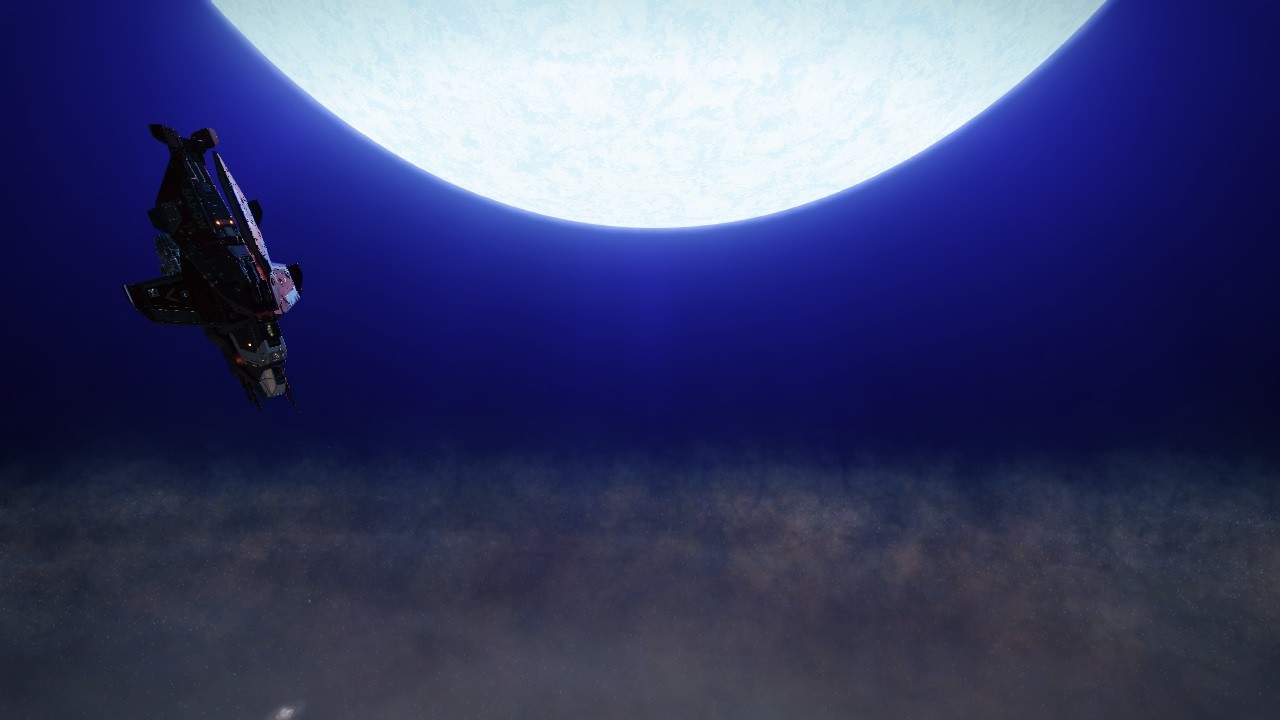
Wait a second. I could synthesize some jumponium. I collected materials at the Polonium Fields during the expedition, and there is a chance I can increase my jump range enough to lock into another system to jump. Any system.
I have never done this before. I would have preferred to experiment with jumponium before needing it for real, but it will have to be this way. I think I got it. Premium FSD injection. Jump range increased to one hundred and nine light years. I cross my fingers. There must be at least a system at this distance. YES! Got it. System Systae Free SD-T E3-4. That is the same system with a single neutron star that brought me here. Just eighty point six light years distance. Great! I am saved. That neutron star there guarantees my descend back to the galactic plane. 3, 2, 1… Engage.
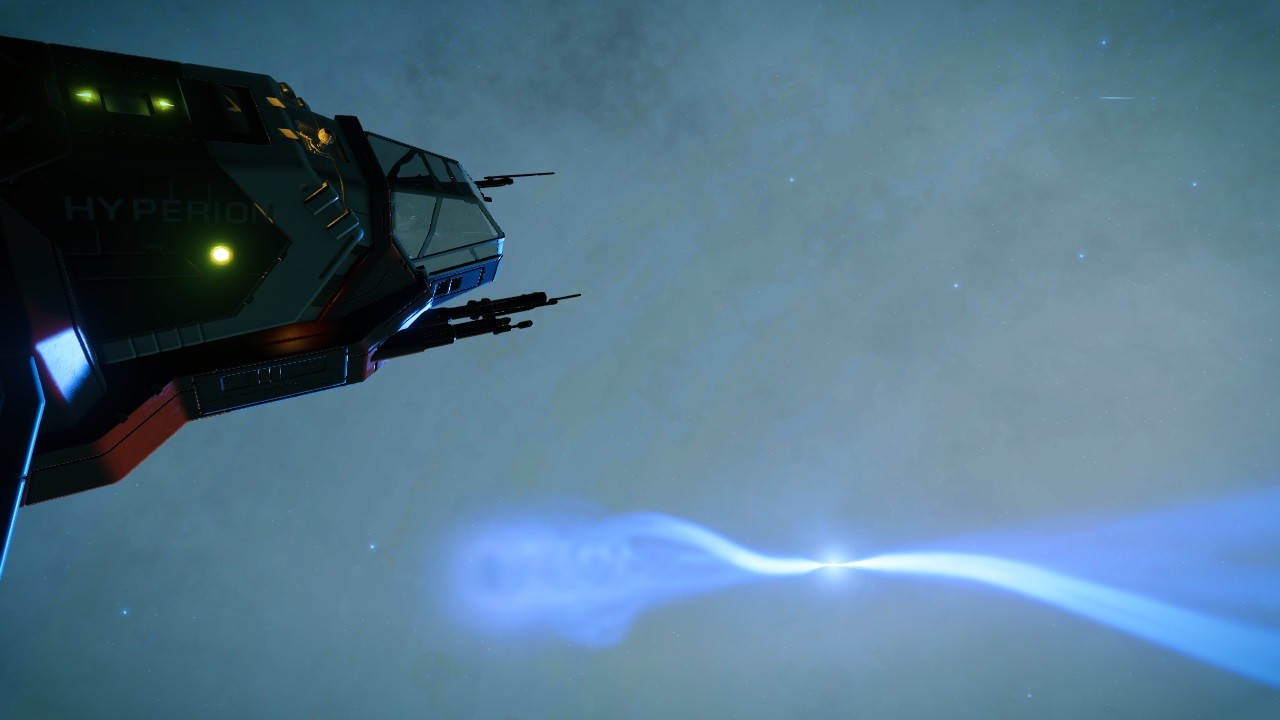
Resuming log. I hope I have learned the lesson. There is still much I have to learn about exploration. I should have been more careful. Launching myself to the top fringes of the galaxy without checking the jump ranges necessary and securing a safe path back was incredible unwise on my side. It is clear that I cannot reach the Peak with a jump range of just fifty three light years. But I think I could wander around Odin’s Hall a little bit.
This sector is full of wonders and ripe with black holes. I have found a system, Systae Free JS-B d13-9, where two red dwarfs and a landable ice world fifteen times the size of Earth orbit a white dwarf, creating mesmerizing views over the galactic mat.
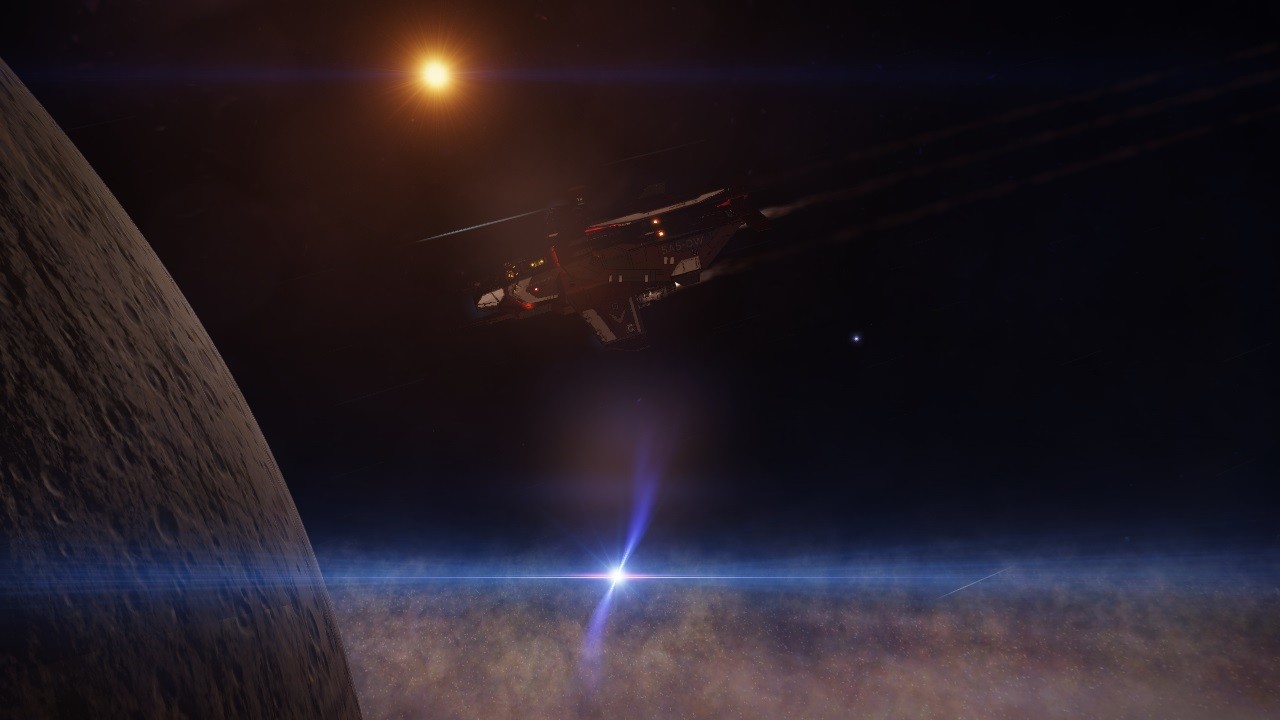
Amazing! I have discovered a system, Systae Free FG-Y g8, containing forty six bodies, including a black hole, three brown dwarfs and two neutron stars.
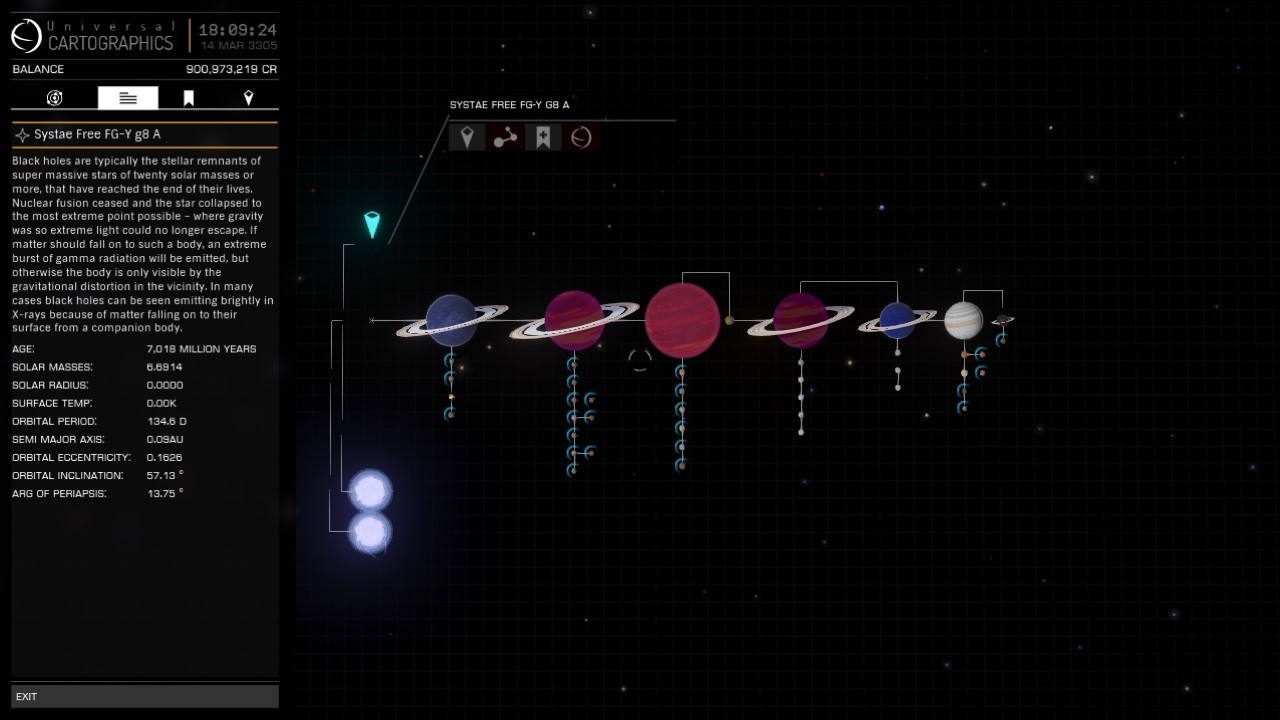
I am now at system Systae Free XJ-R e4-10. I had to use jumponium to reach it. It seems it was discovered by CMDR Bra2S, but it does not appear in the Galactic Mapping Project database, so I will get that credit. The system contains a blue-white star, four T-Tauri stars, and many gas giants and big high metal content worlds of which two are landable. I have not sleep in the last seventy two hours, so I find myself a cozy campsite in one geological signal and get ready to sleep twelve hours straight. I guess nobody will disturb me here.
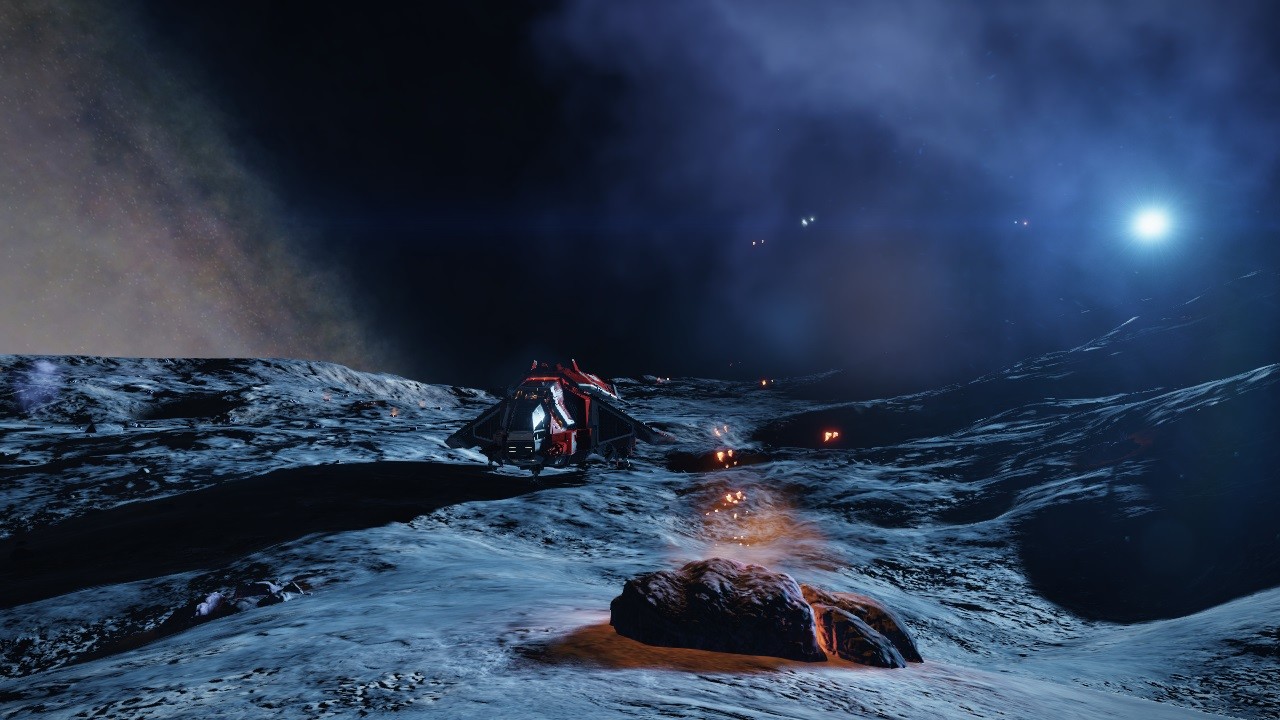
Resuming log. It is time to put an end to this trip around the Odin’s Hall. The next phase of Distant Worlds 2 expedition must be about to be released and I am still four thousand and five hundred light years away from Explorer’s Anchorage. But I hope to arrive there soon, because it is my intention to use the Neutron Highway to descend back to the core.

Resuming Log. I made it. Just in time for the announcement of the next waypoint. Explorer’s Anchorage is boiling with activity. The dock platforms constantly releasing ships. The commanders have started to rally at Sagittarius A for a massive jump to the next waypoint. And, guess what? I have just discovered that CMDR Straha Yeagar, the discoverer of the Peak, is taking part on the expedition. Her ship, the Buckeye Spirit, is docked at the station. I could have asked her about the minimum jump range to reach the Peak before venturing myself into the Odin’s Hall. Anyhow, it was an amazing trip. Next time I will reach it. Now, that I have the money, maybe I will buy myself one Anaconda. I have heard that they are still the ships that can get the highest jump range achievable.
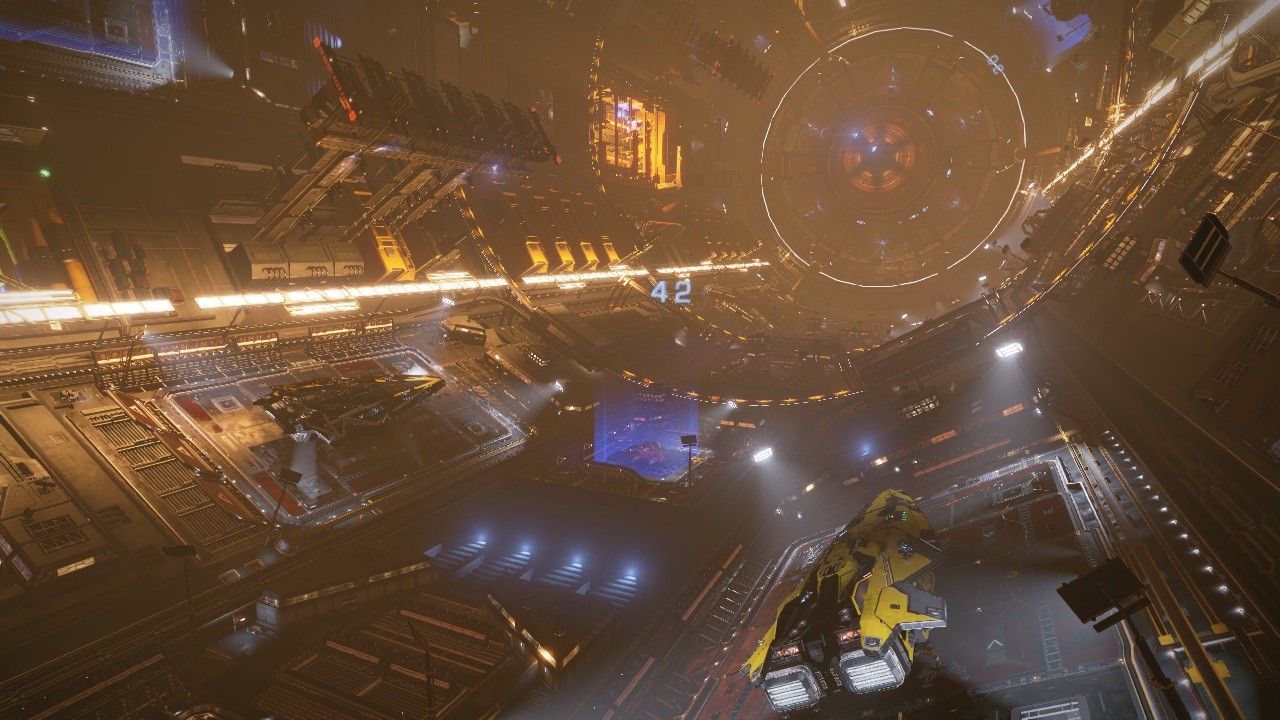
This is commander Jav Marlo, recording this log in the Hyperion, landed at Explorer’s Anchorage. I am afraid I will not make it on time for the massive jump. The Hyperion still need some patching, and it seems that we will not see another station for a while. Maybe I stayed too long at the Odin’s Hall mesmerized by the views. Anyhow, it has been two amazing weeks. According to the Galactic Mapping Project database, I am now the discoverer of seventeen Wolf-Rayet stars, many of them with my name tagged, and fourteen black holes. I have collected more than three hundred million credits for my exploration efforts. It is clear that the galactic core is ripe with wonders yet to be discover, and that the building of Explorer’s Anchorage means an incredible milestone in galactic exploration. Whatever was the price to put this station here, it was worth it. I am sure that this place will become a major hub for explorers looking to unfold the mysteries of the core regions. And I intend to join them too in the future, but first we must reach Beagle Point.
Jav Marlo signing out.
DISTANT WORLDS 2 (PART 9) – REACHING THE CORE
3 MAR 3305 Explorer’s Anchorage (Stuemeae FG-Y d7561)
New log entry. It has been a long trip to Explorer’s Anchorage, with many detours. As soon as the new itinerary was released, I headed to the first point of the route, the Shrogaei Nebula Cluster. A group of planetary nebulas, all very close one from the others in the sector Shrogaei.
The first one I visited was Shrogaei Bravo Lima, in Shrogaei BL-X e1-2343 system, a planetary nebula with a black hole core orbited by two brown dwarfs, a gas giant and two icy worlds.

The next one was Shrogaei Hotel Romeo, in Shrogaei HR-V e2-7758 system, a planetary nebula with a neutron star core orbited by a brown dwarf, four gas giants and an icy world.
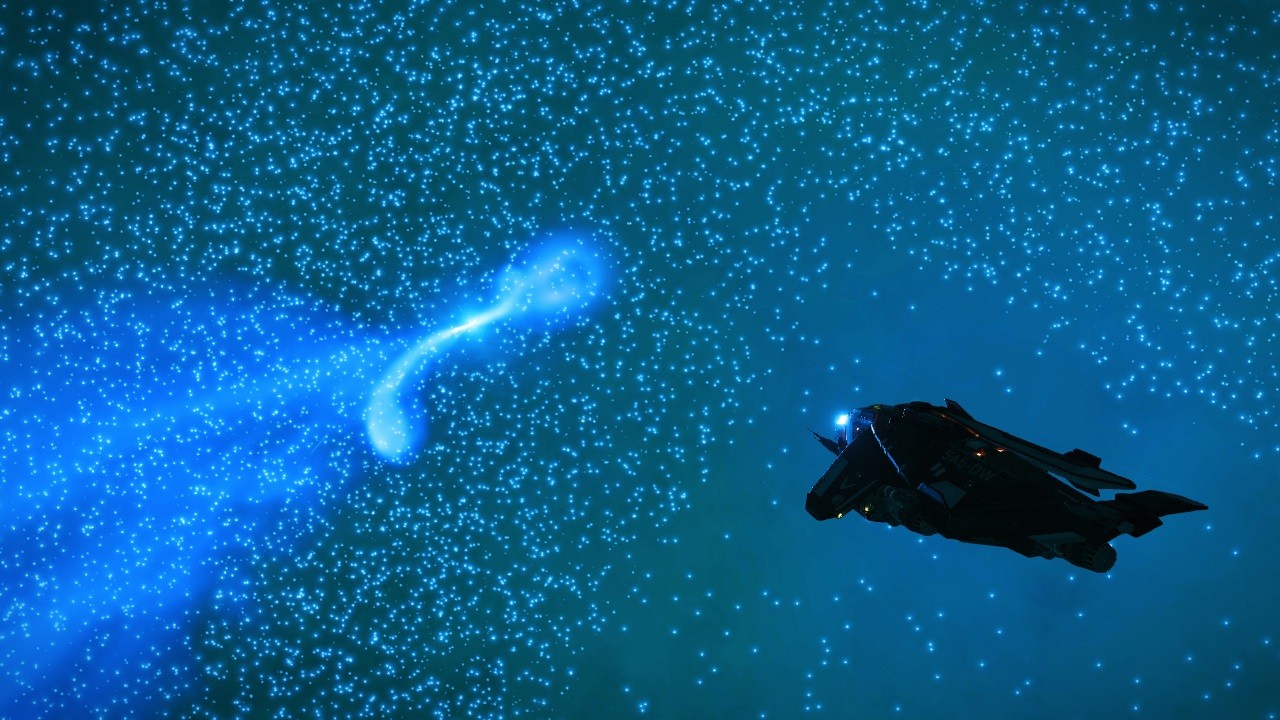
Five hundred light years away was Shrogaei Foxtrot Hotel, in system Shrogaei FH-U e3-1421, a planetary nebula with a neutron star in binary orbit with a Class M star.
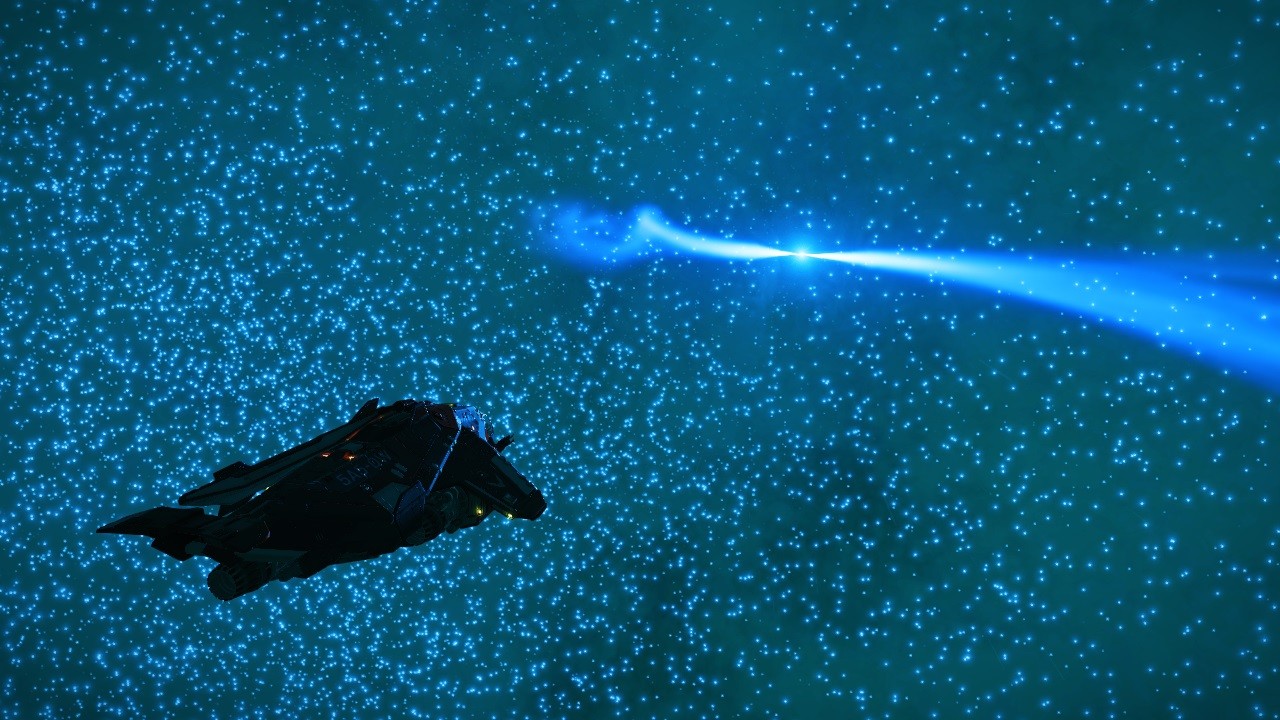
From there I headed to Shrogaei Quebec Oscar, in system Shrogaei QO-Q e5-343, a planetary nebula with a neutron star core orbited by two gas giants, that was four hundred light years away.
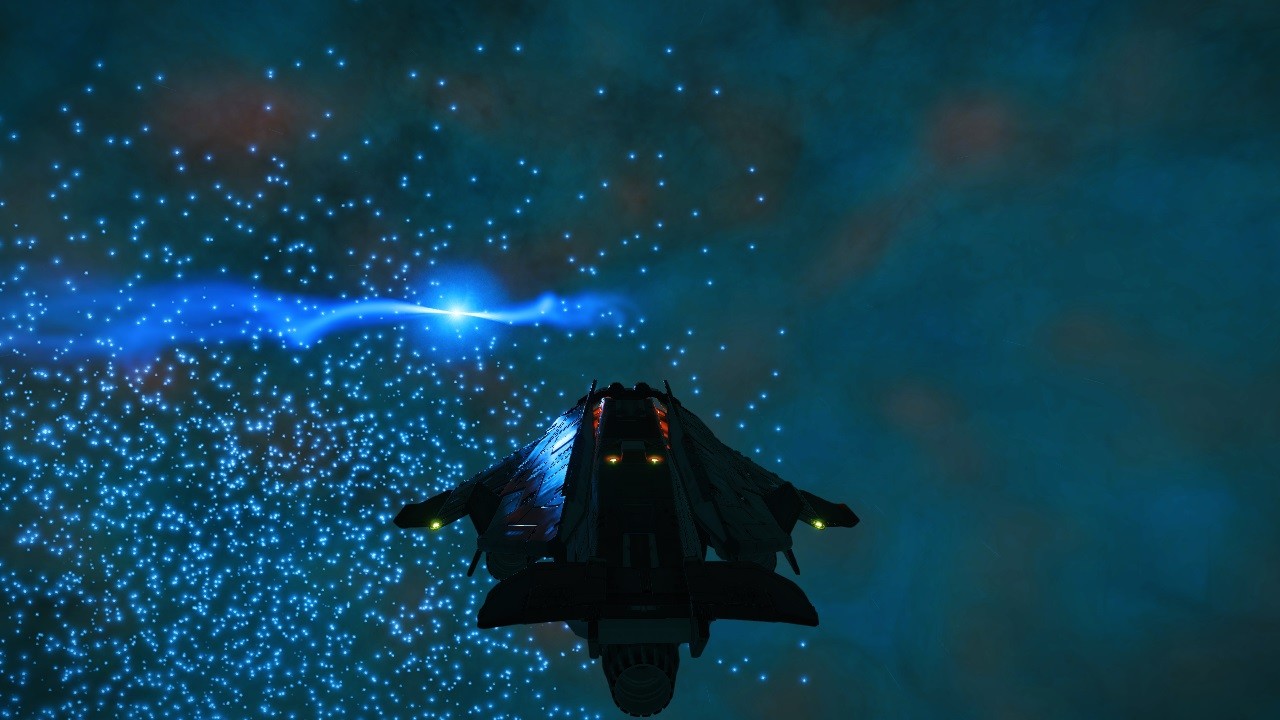
The last one was Shrogaei Victor Echo, in system Shrogaei VJ-Z e6712, a planetary nebula with a neutron star orbited by two ringed gas giants that was eight hundred light years away.
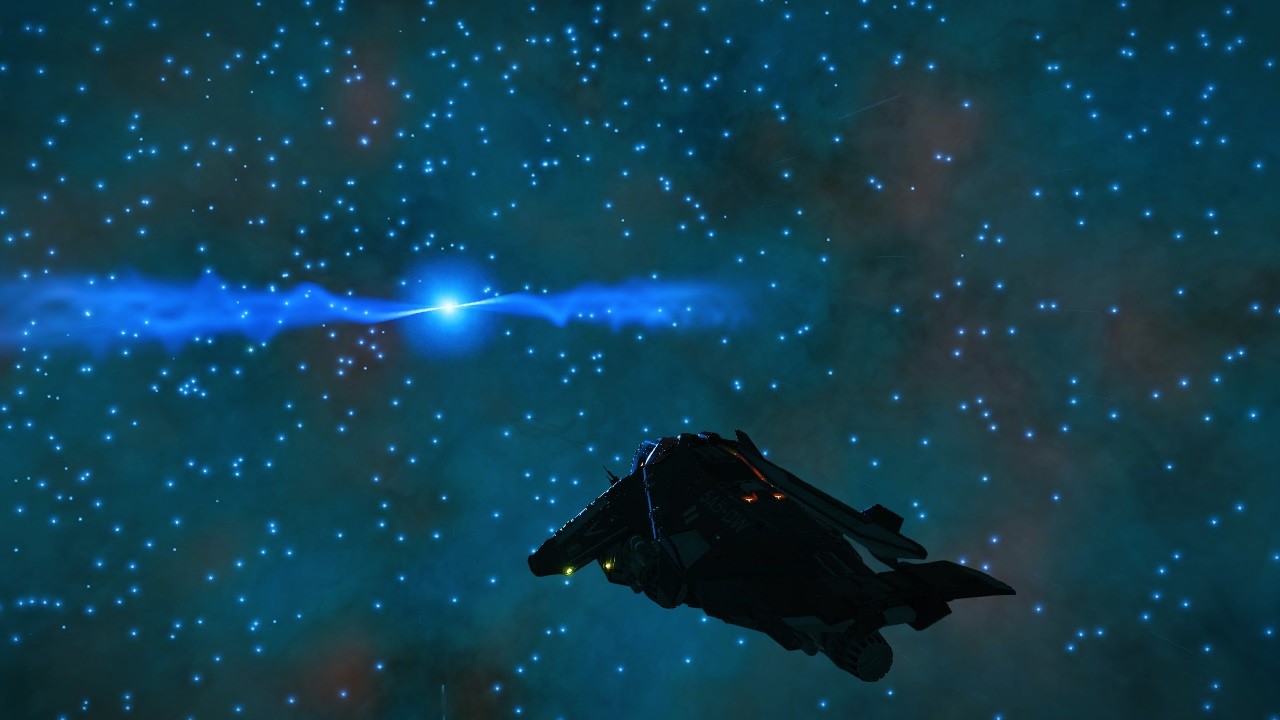
After the tour around the nebulas, I decided to visit The Black in Green Tourist Installation, in system Shrogea MH-V e2-1763, a tourist installation in orbit of a black hole within a planetary nebula known as Tranquility’s Stop. The installation was constructed in the vicinity of the preexisting Black and Green Tourist Beacon. The place is quite famous since March 3304 when it was featured in the Strange Worlds travel documentary.
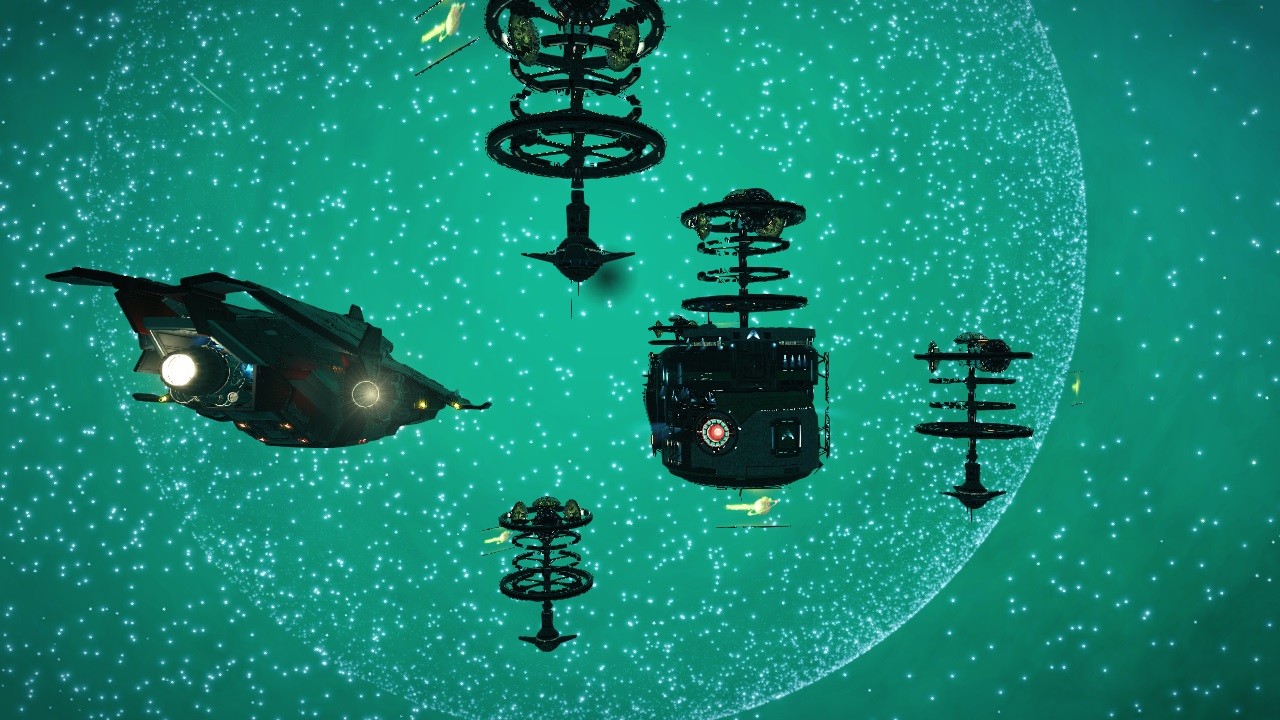
Alas, the place has no docking facilities. I wondered what kind of people chooses this place as a holyday destination.
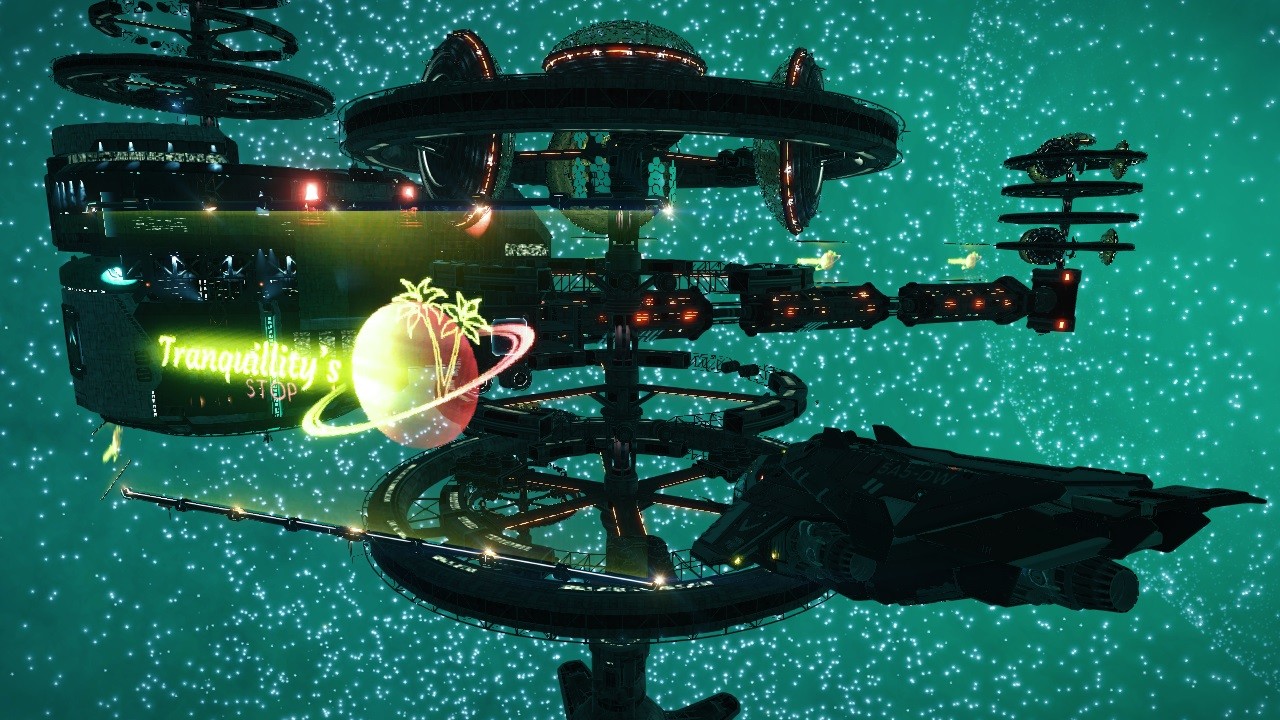
A cocktail and a massage would have been nice, but the Hyperion is not equipped to dock with the tourist installation, so I continued to The Clawed Hand Nebula, in system Hypuae Scrua AA-A H693, a large red and green dusty Stellar Nursery nebula about two thousand light years above the Galactic Plane near the southern edge of the Eastern Neutron Fields. From certain angles it resembles a clawed hand curling around a jewel, which is the inspiration for its name. It is about one hundred light years in diameter and contains over a hundred star systems.
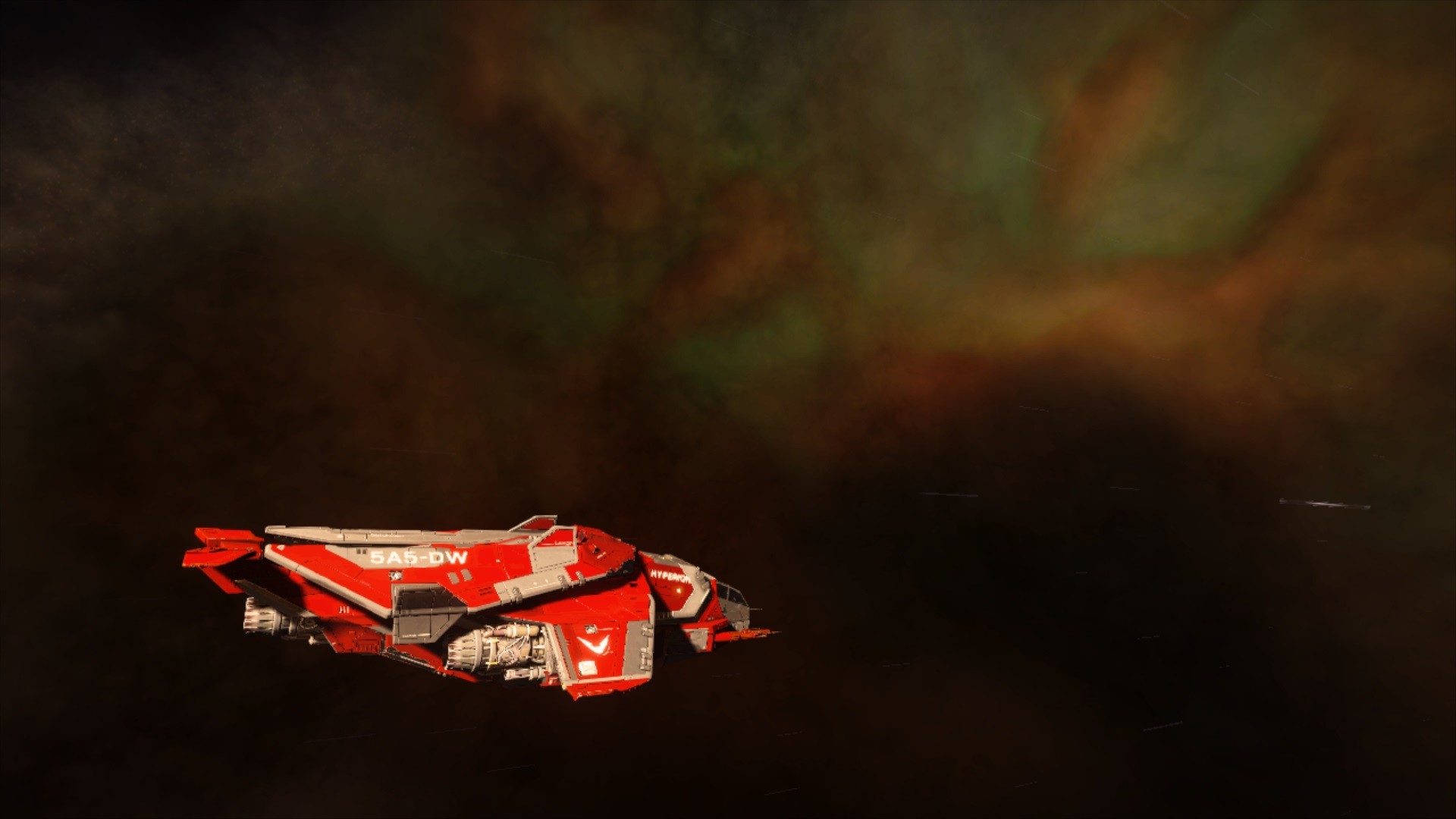
I headed back to the main itinerary and, on the way, I found a system, Hypoe Flyi GW-U d3-7978, containing a neutron star with five high metal content worlds orbiting, one of them landable, and a nearby M Red Dwarf with six high metal content worlds and two waterworlds, all of them terraformable.
Back on track, I arrived to system Hypoe Flyi HW-W e1-7966, also known as Galionas, a small planetary nebula containing a black hole and several gas giants under perpetually green skies of cosmic dust.
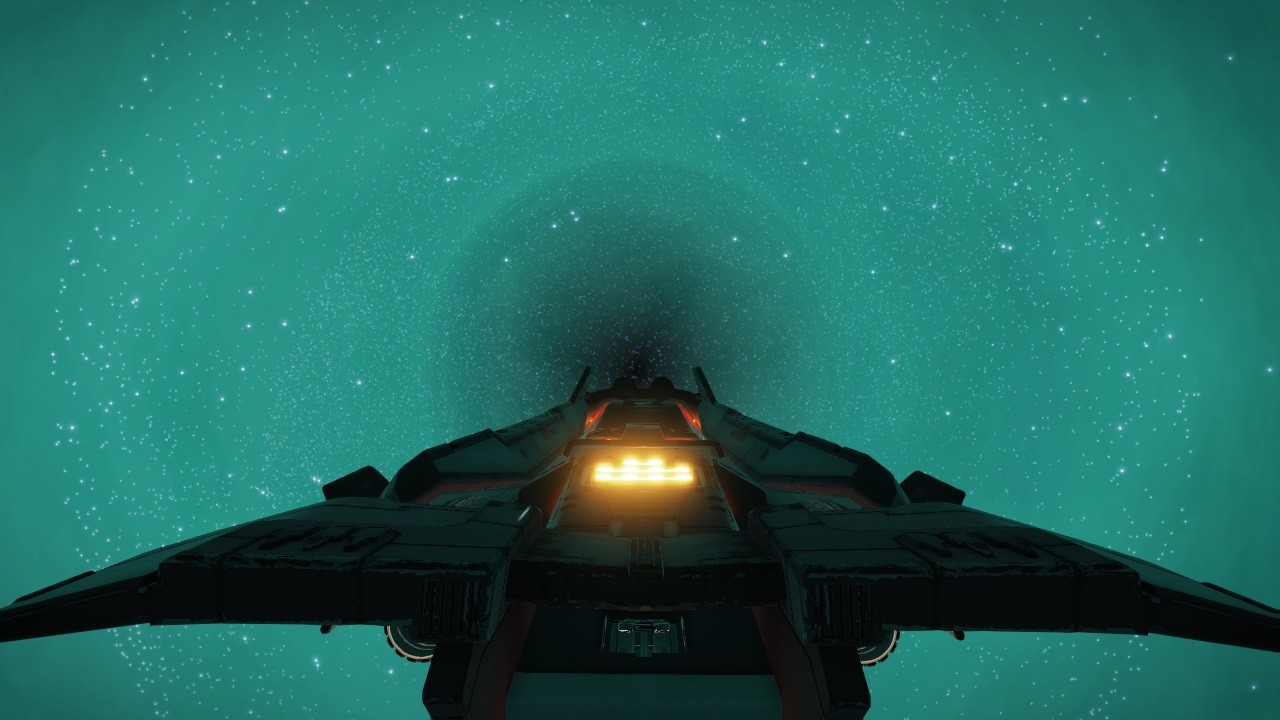
The next nebula in the itinerary is called the Caeruleum Luna, in system Hypoe Flyi HX-T E3-295, a blue planetary nebula with a neutron star at its heart. The system contains a variety of worlds, including many landable moons. The Galactic Mapping Project database even suggests landing at the Mysturji Crater, from where to enjoy the stunningly bright sky backdrop with the blue eject nebula becoming a bright pink and purplish color due to the brightness of the galactic core. A charming place to rest for some hours.
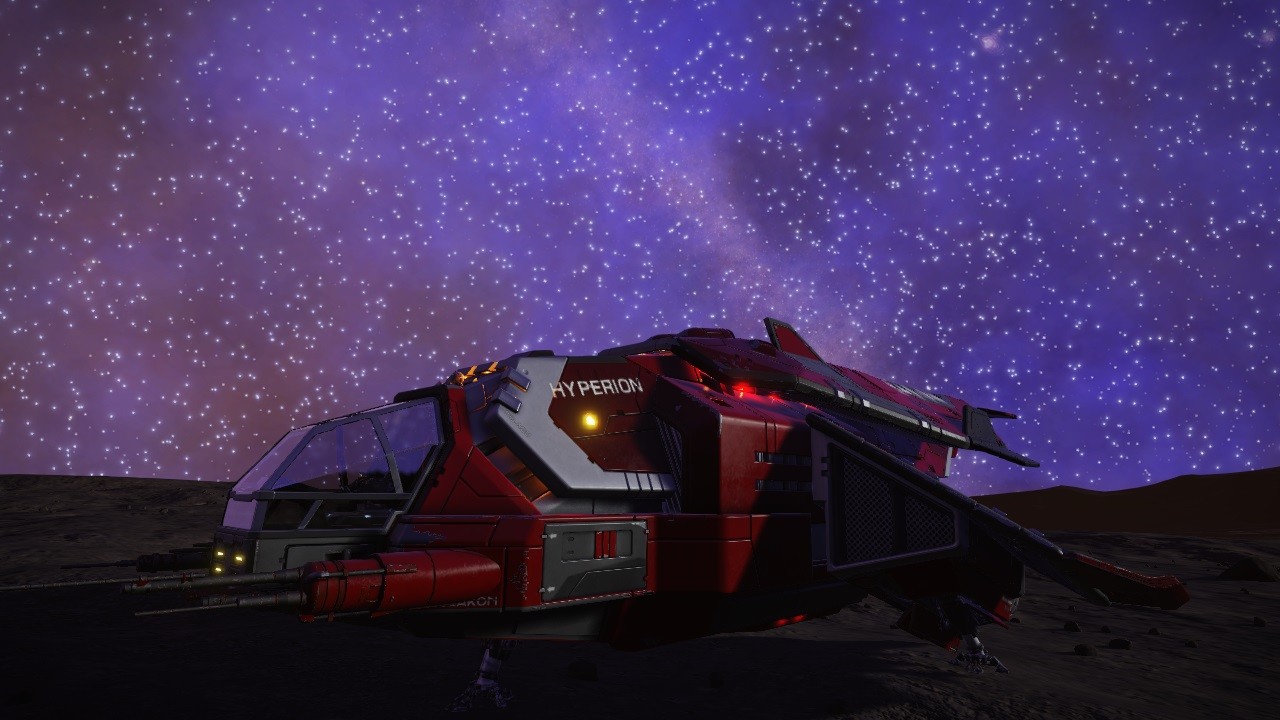
The Caeruleum Luna is above a very interesting system below the galactic plane that is called The Dance of Compact Quartet, because it contains a black hole, two neutron stars and a white dwarf, all within a few light-seconds of each other. That was a great opportunity to behold the galaxy from the bottom, so I headed to system Kyli Flyuae WO-A f39 despite it was quite a detour.
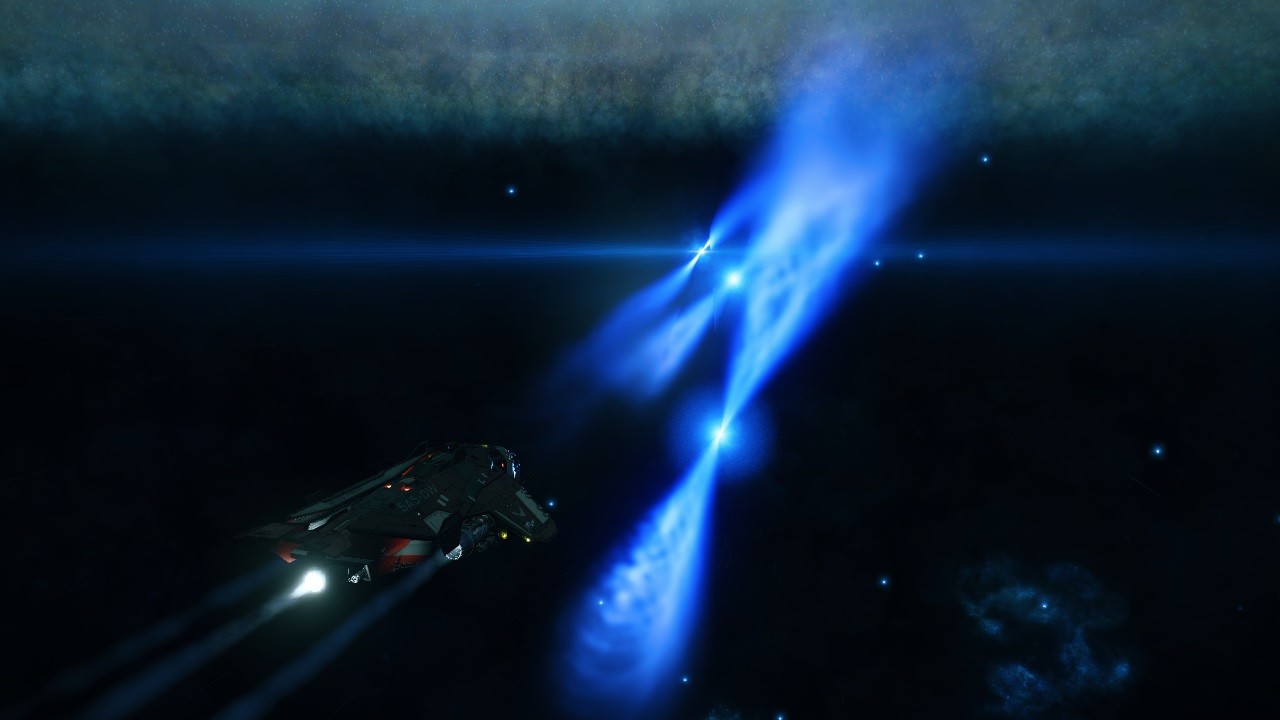
I must admit that the view was quite inspiring: three shiny torches casting their lights below the mat of the Milky Way. I stayed there for a couple of hours, sunk in deep thoughts, before coming back on track aiming to the Great Annihilator. On the way, I discovered system Athaip EJ-F d12-7075, which contained three waterworlds.
In the twentieth century, astronomers from old Earth discovered a source of intense photons at 511 keV, which was known to be the result of positron-electron annihilation. After studying the signal, they determined that the source was equal to annihilation events of 10 billion tons per second of positron-electron pairs. It was dubbed The Great Annihilator. The only possible explanation they found to this phenomenon was the presence of a large black hole.
In the recent years, thanks to the new advances in frame shift drive technologies, the system could be visited, being the first human to arrive there the commander Raiko. He discovered that there were two black holes and a set of T-Tauri stars in orbit. The primary black hole has almost two hundred solar masses and an unusually large radius of five hundred fifty kilometers. The secondary black hole has sixty six solar masses and a radius around two hundred kilometers. The system appears to be located in an unusually dense field of dust, obscuring most nearby stars.
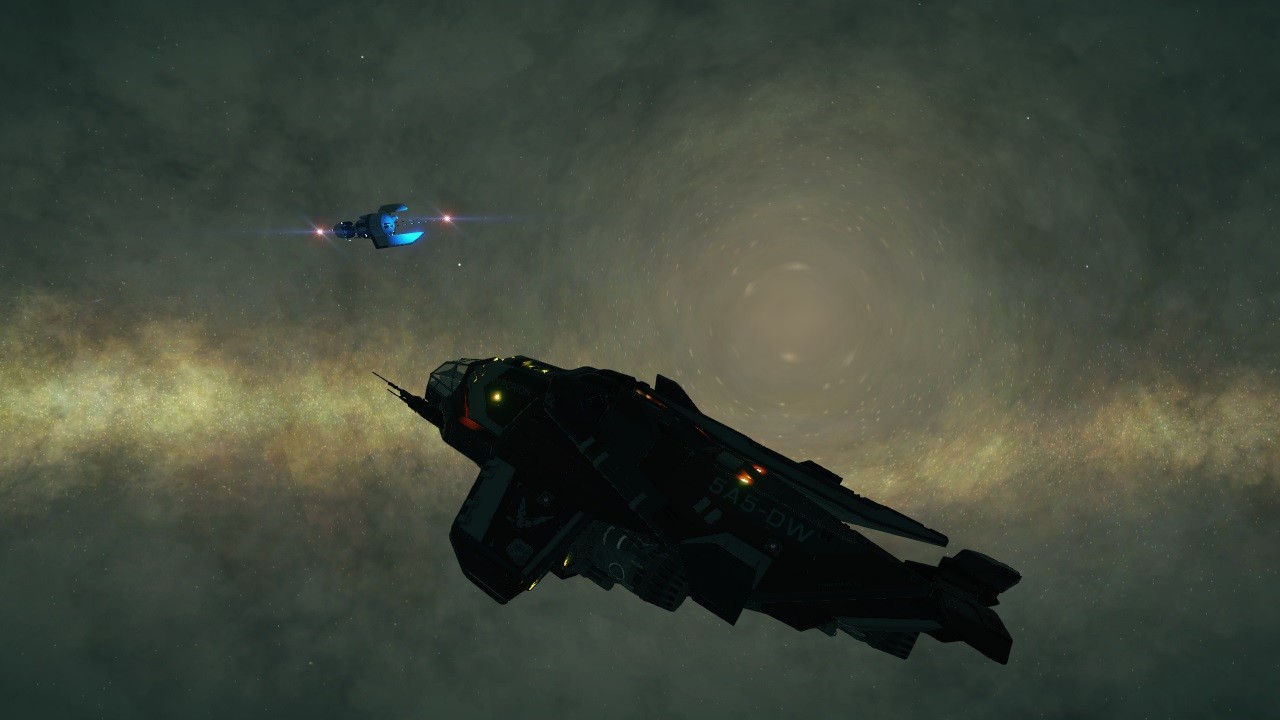
The next stop was the Zunae Nebula, that is better viewed form system Zunuae TC-V D2-5699, a small purple nebula situated on the near edge of the galactic bar nicknamed The Inky Nebula.
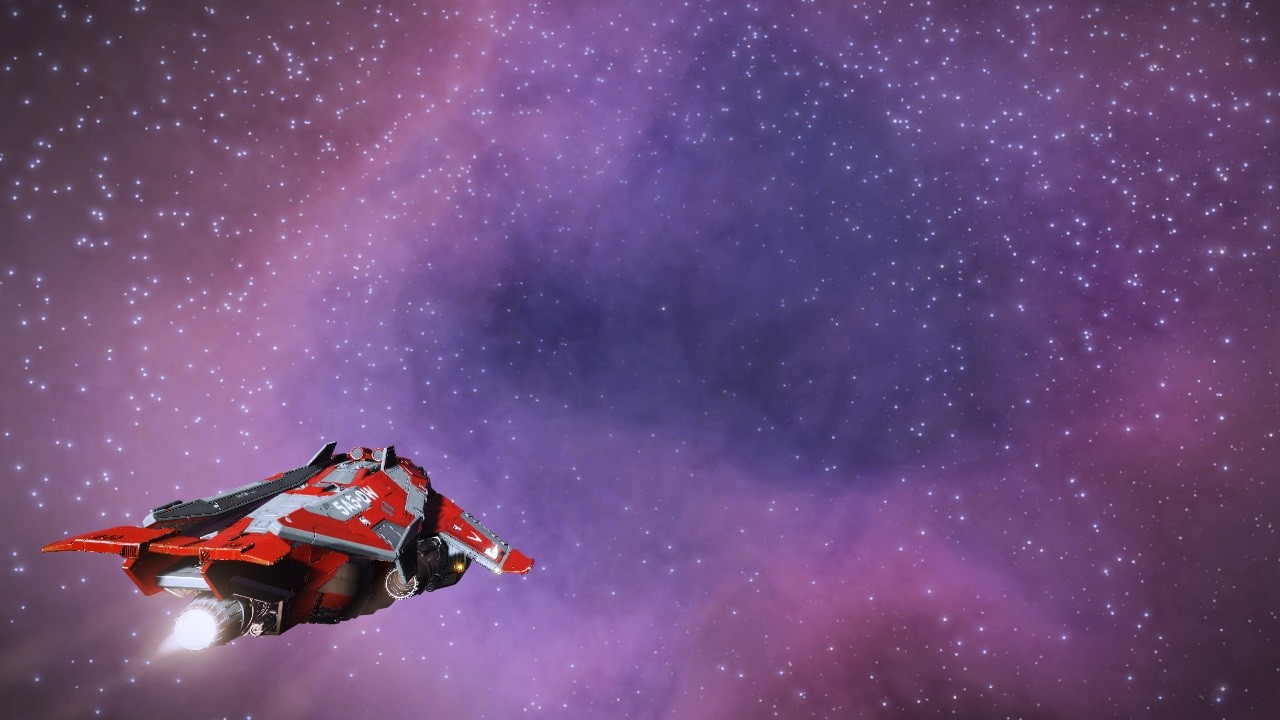
I needed a rest and decided that system Myriesly RY-S e3-5414, also known as The Six Rings, could be a sound place for sleeping some hours. This system houses 6 T-Tauri stars, each with its own ring, providing a series of stunning views set against many bright stars in the central part of the Galactic Core. The third planet also has an interesting ring system, with its angle of inclination almost exactly perpendicular to its orbit, so that the rings are face-on to the central star. The problem with this planet is that it has a gravity of near four Gs, even more than “The View”, that killed some rookie commanders at the beginning of the expedition, making it quite tricky to land there even for such a light ship as the Hyperion. Nevertheless, the sight was worth the risk.

After so many days in space, the four G gravity felt like a blow with a mace crushing all my bones and muscles. It was not a good choice for resting, but I forced myself to endure the pain for some hours. Space flying weakens the body and any chances to exercise the muscles must be exploited.
With all my body aching, I headed to the Wulfric Nebula, better viewed from system Byoomao WX-T C19-4546. The nebula is caused by a group of close proximity stellar remnants ejecta nebulae crating quite a red hellish sight.
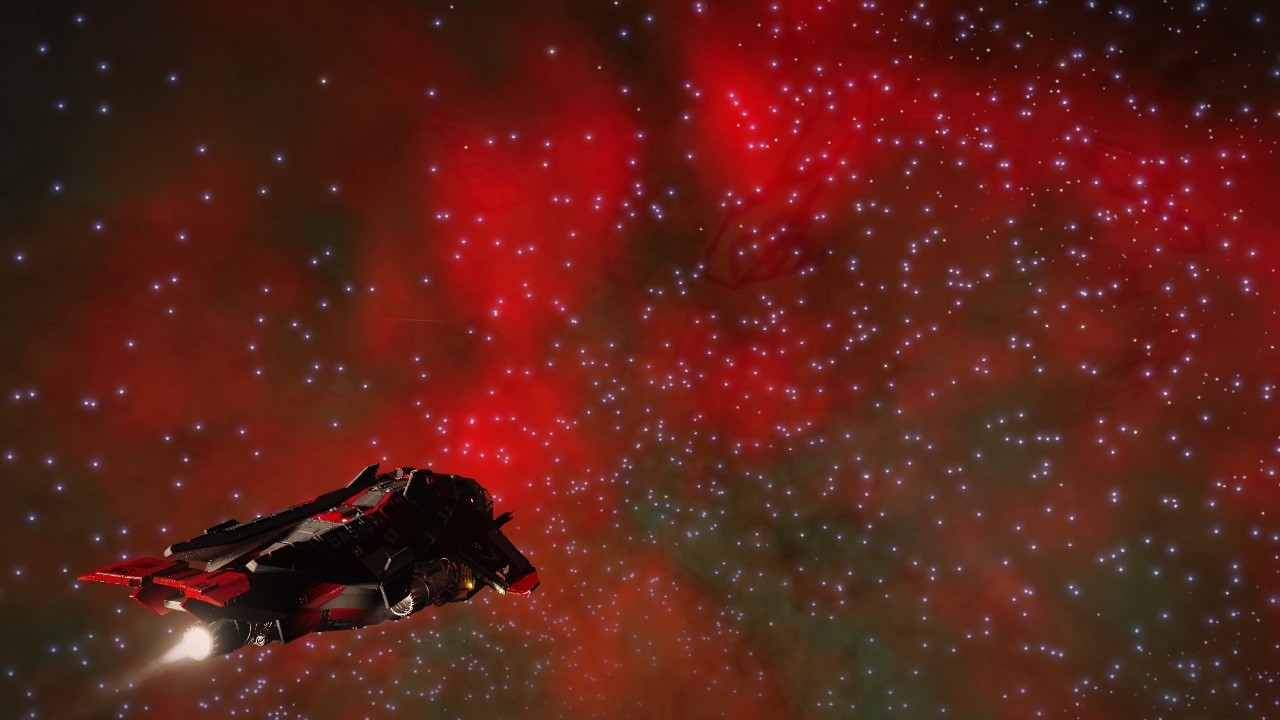
Once inside the nebula, in system Byoomao MI-S e4-5423, I found two notable stellar phenomena. Among the rocks of the rings of the first planet there was a cluster of rubeum metallic crystals floating.
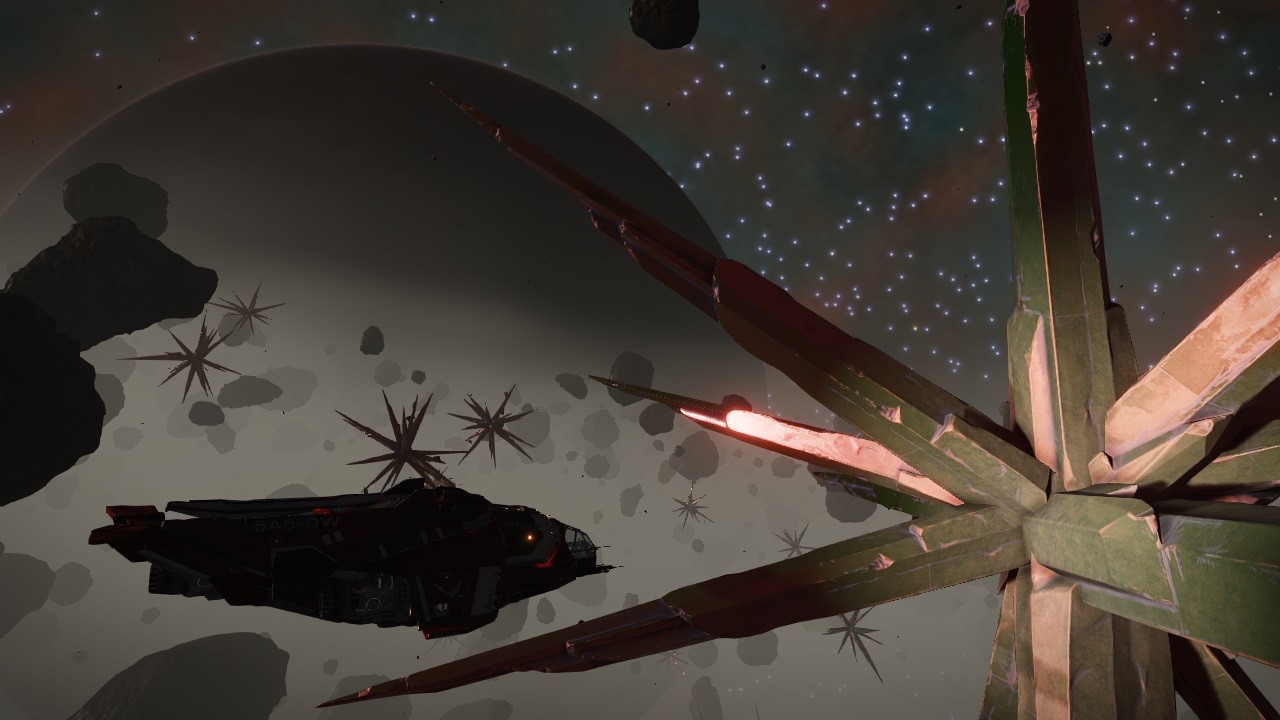
On the rings of the second planet there was a cluster of flavum metallic crystals.
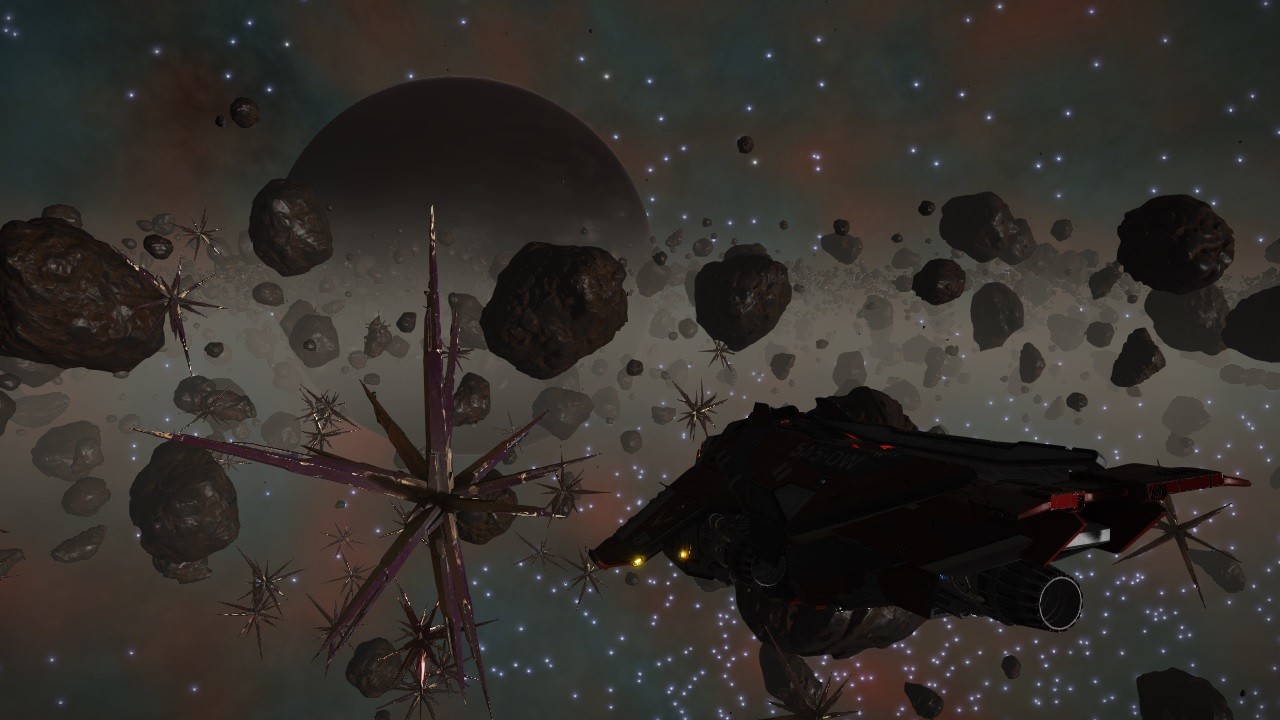
I could not rest properly at The Six Rings, so when I saw in the itinerary that there was recommended detour to visit a minor point of interest called Insinnergy's World, a moon orbiting its Gas Giant slightly below the ecliptic, I did not hesitate and aimed to system Myriesly DQ-G d10-1240.
Upon probing the moon, I found many biological and geological sites. I have read about them, but I have never visited one What I found was identified by the Codex as mussidaen seed pods. The presence of the strange fungal lifeforms with the spectacular view of the vast ring system towering in the sky made quite a place for setting camp.
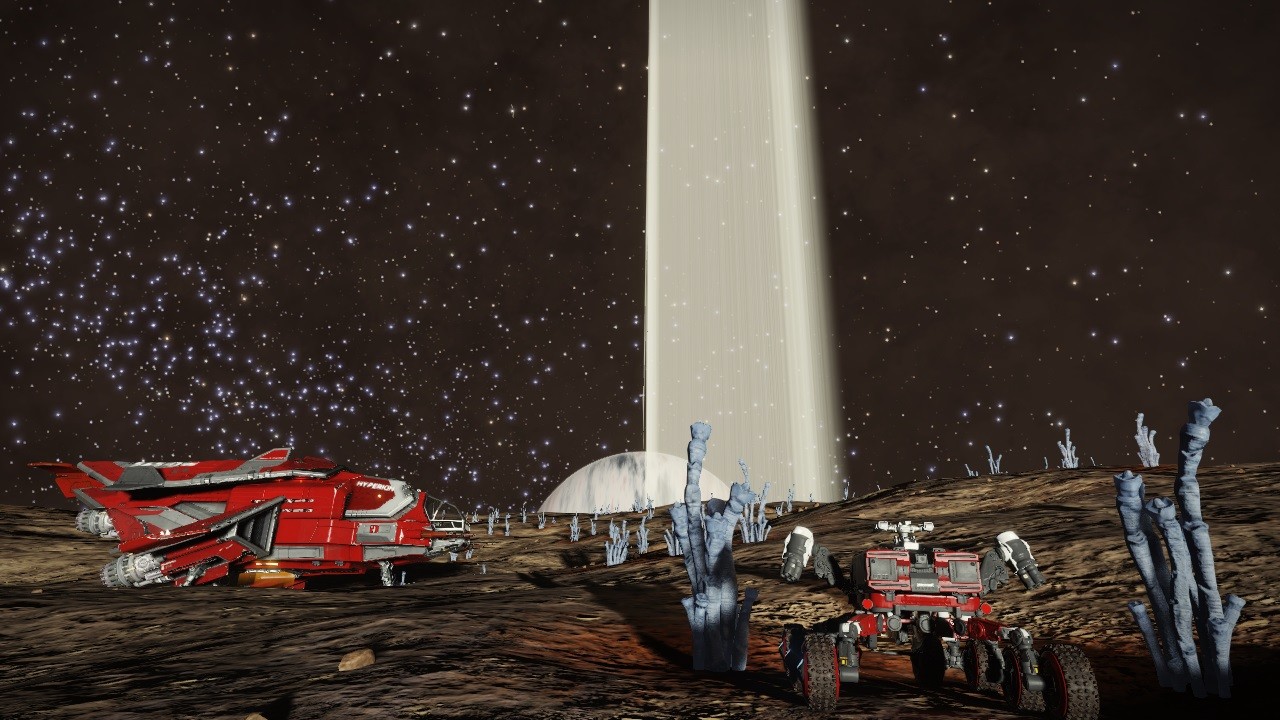
After sleeping for some hours I felt ready to confront the last stage of the route. The core was almost there. I headed to system Myriesly DD-O B47-68, to behold the Emerald Remnant, one of the several close proximity stellar remnants ejecta nebula within the Myriesly sector.
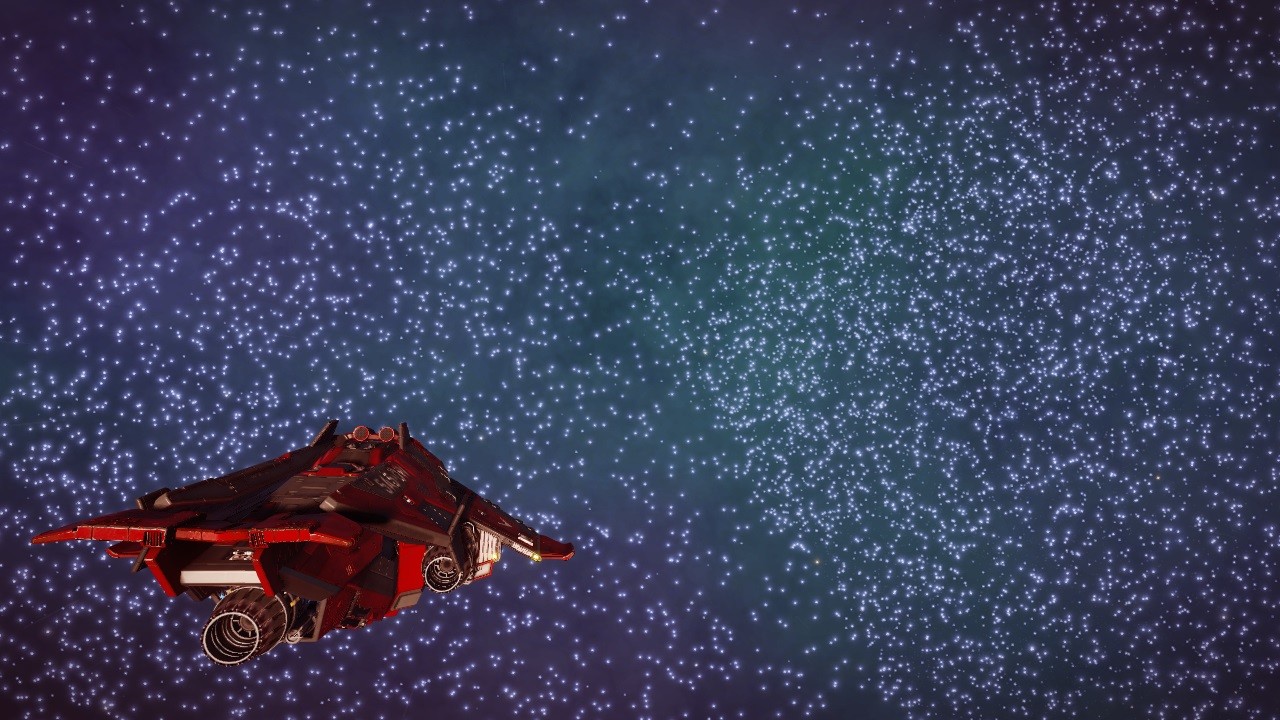
And from there I aimed to the system Myriesly HN-I C23-3141, from where to behold the nebula known as Fenrisulfur. The first planet of the system shown many geological sites after the probing, so I chose one in the middle of a flat valley to land and enjoy the view of the nebula.
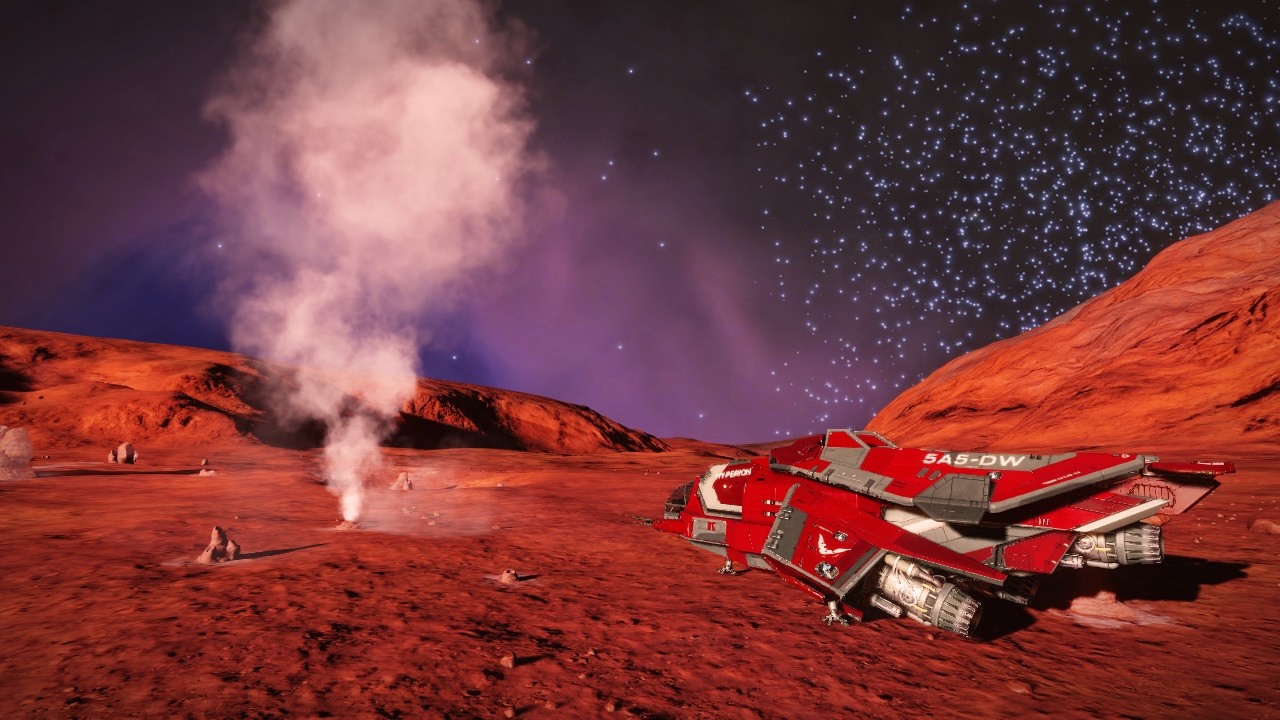
I decided to check the nebula from the inside before heading to Explorer’s Anchorage and I found two notable stellar phenomena. I had to explore them. The first one was a Lagrange Cloud were a huge storm was taking place. After my last experience with a storm, and with the Hyperion hull already battered, I could not risk to being stroke by another light bolt.
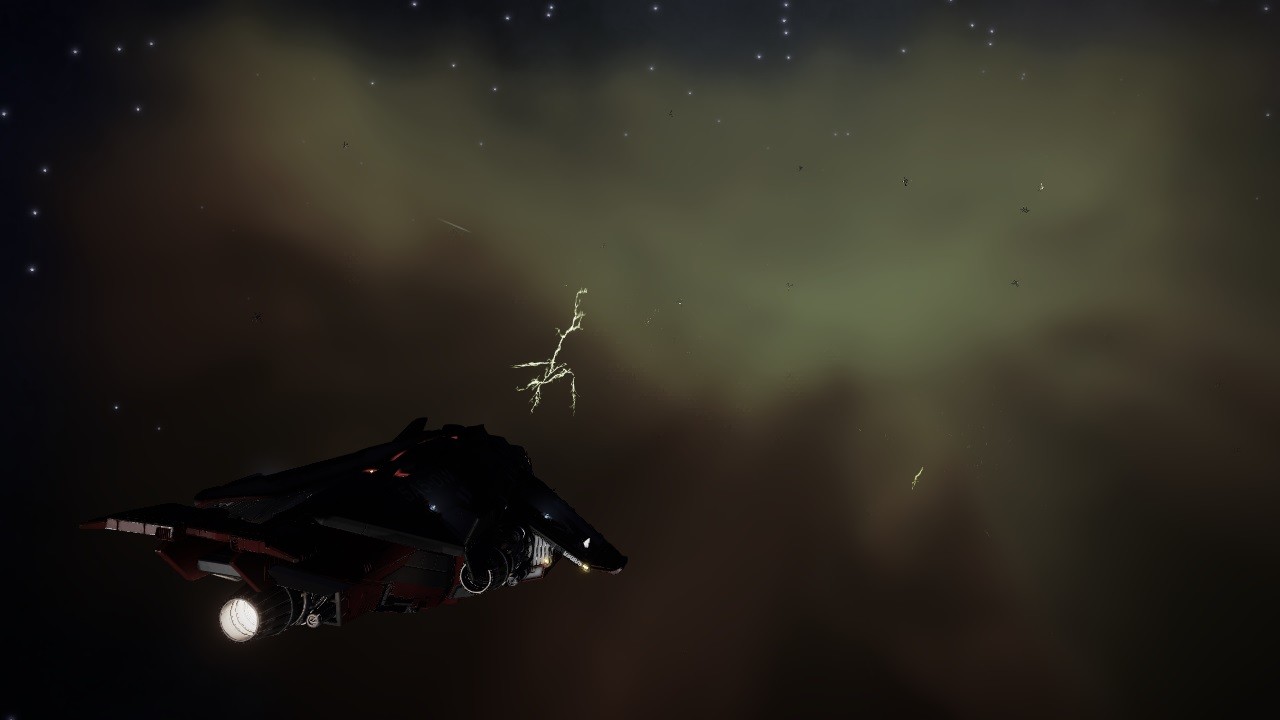
I ventured inside the storm just the necessary to learn that the metallic crystals forming there were the flavum kind and I left as soon as I could. The other stellar phenomena were just some solid mineral spheres forming in the rings of the third planet.
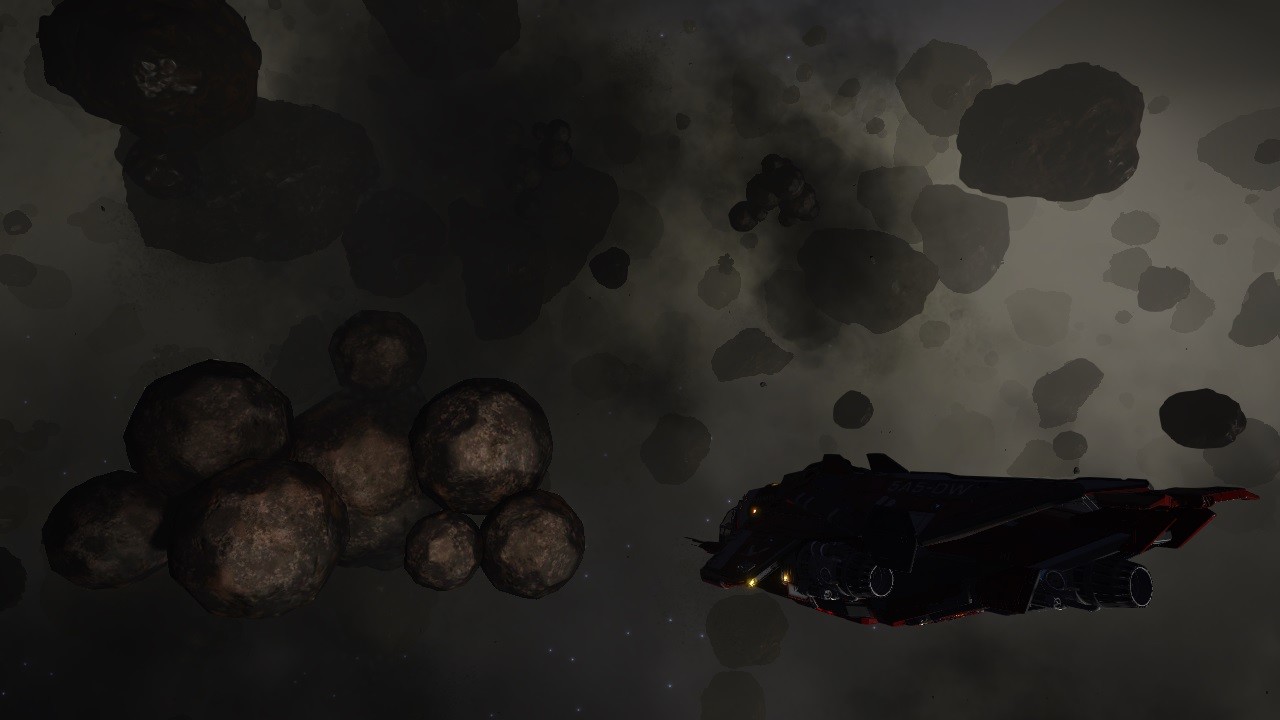
A couple of hours later I arrived to system Stuemeae FG-Y d7561, where the new exploration and scientific research hub, the Ocelus space station that has been called Explorer’s Anchorage, is being deployed. At first sight, I could see that the main thruster engines that were used to take the superstructure from the Omega Mining Asteroid base to its emplacement near the core of the galaxy have already been removed, and the solar panels were being deployed. Hopefully, soon the installation of the habitat ring will commence. That space station means a great milestone in deep space exploration. I must confess I felt quite proud for being part of the Distant Worlds 2 expedition.

I was greeted by Councillor Magnolia Gill, from Deep Space Surveys, after landing who apologized for any disruption that I may suffer due to the station being still under construction and the situation of civil unrest that the presence of the fleet had generated. Explorer’s anchorage boiled with activity. The construction crews working in twenty four hours turns. There were a lot of commanders from Distant Worlds 2, but not so many as I expected. Even being Armstrong Landing, in the nearby Stuemae KM-W C1-342 system, the official basecamp, I expected more commanders to be here. They told me that an excursion to Altum Sagittarii had departed some hours ago. That could be the reason. I wanted to join the excursion, but the Hyperion needed some hull repairs and restock before that, so I urge the crews in the docks to hurry up and, in the meantime, I asked about the Universal Cartographics office. It seems that they have started to be operative just a couple of days ago. My exploration data of more than ten days throw me the amazing sum of one hundred eighty million credits. It is incredible. I could afford myself an Anaconda with that money.
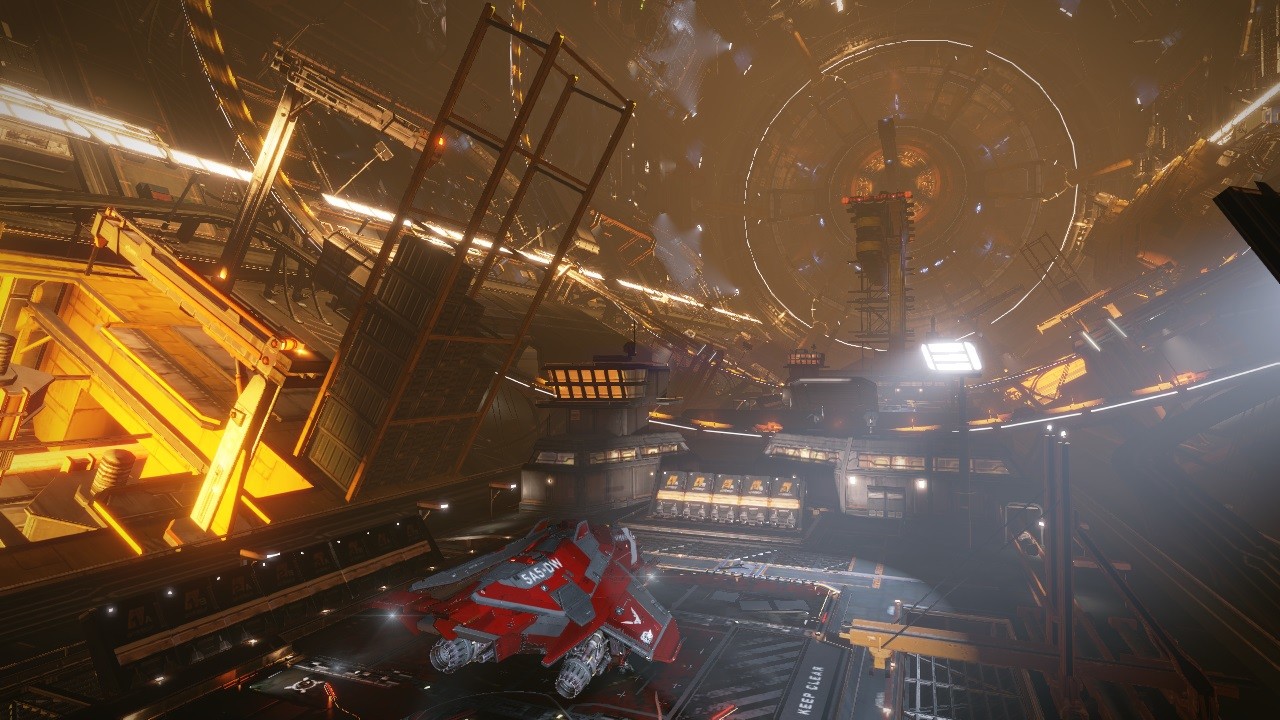
This is commander Jav Marlo, recording this log in the Hyperion, landed at Explorer’s Anchorage, while I wait for my ship to be refueled, repaired and restocked. There will be time in the following days for a complete check. It is my intention to try to catch up with the fleet on its way to Altum Sagittarii. I recently have seen the galaxy from the bottom, and I want to see it from the top. But first, I am going to jump to Sagittarius A, to the very center of the Milky Way, because after two months travelling and exploring, we have finally reached the core.
Jav Marlo signing out.
DISTANT WORLDS 2 (PART 8) – FEAR THE STORM
24 FEB 3305 New Aloros Ravine, Distant Worlds 2 basecamp (Dryau Ausms KG-Y e3390)
This is commander Jav Marlo, recording this log at the Distant Worlds 2 basecamp of “New Aloros Ravine” in system Dryau Ausms KG-Y e3390. It has been a long week of exploring, exhausting and dangerous. It seems that we will not see a space station until we arrive to the Galactic Core, if everything continues as planned. I could use some repair installations now. I have lost forty percent of my hull integrity in this stage of the expedition due to a foolish excess of confidence, but I guess I will have to wait to patch up my ship. Let’s hope that I do not lose too much more hull integrity.
The Hyperion was in perfect condition when I left Polo Harbour after two days enjoying the facilities there. Those pioneers are good people. The space port was swarming with the ships of the expedition. I bet they never expected to have so many visitors at the same time when they moved there. Anyhow, on this occasion, contrary to the conflict we caused in the Omega Mining Operation, everything went smooth and I think the people in Polo Harbour enjoyed our visit.
I set sail the moment the new itinerary was released. The first point of interest of this stage of the route was system Byoi Ain WE-R e4-913 and the Jade Ghost Stellar Remnant, a tiny nebula with a black hole in the middle that produces beautiful lensing effects combining the high density of stars of this sector with the beautiful green hue of the stellar remnant.
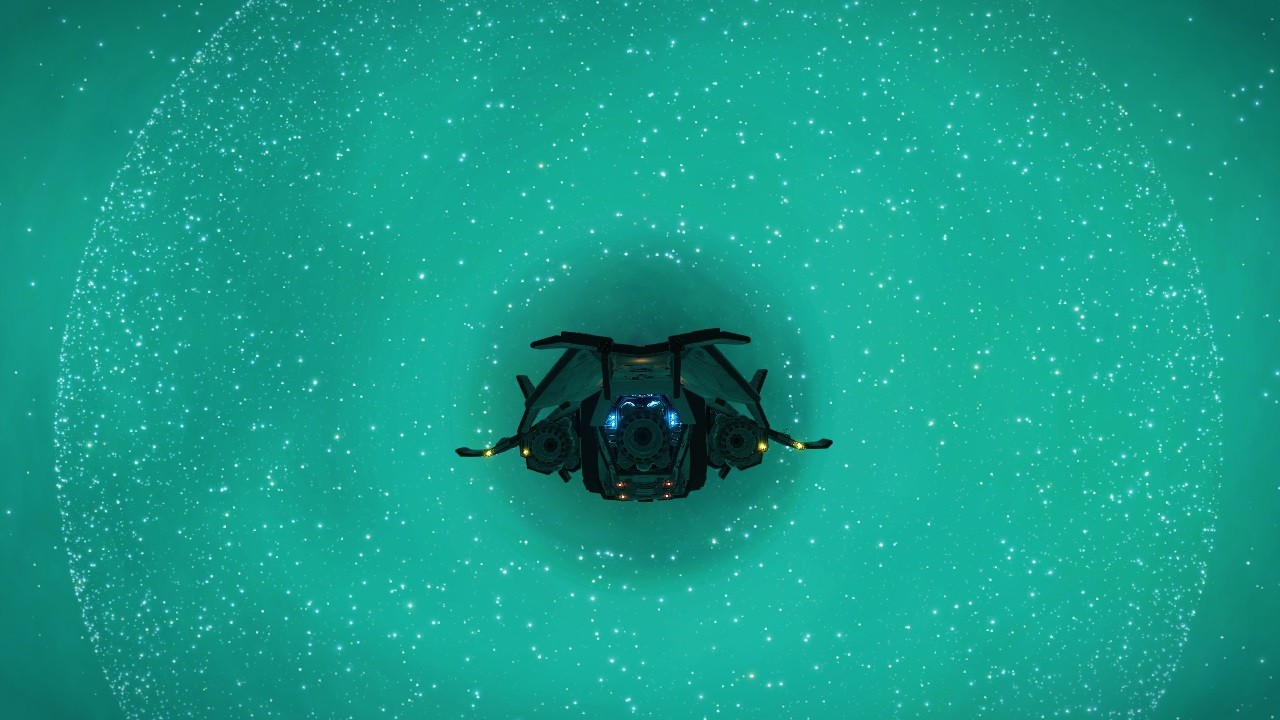
From there I headed to system Byaa Airm JM-W f1-744 to visit Ebony and Ivory, a system containing three neutron stars, a white dwarf and a black hole as the main sequence star. The Galactic Mapping Project database warns the explorers about the perils of the system due to the white dwarf orbit just two light seconds away the black hole and it is possible to hypercruise through one of the neutron jets when exiting the hyperspace sequence. I should have payed attention to them. I was mesmerized flying around the white dwarf, that I forgot about the black hole and it expelled me out of supercruise. The heat of the nearby white dwarf almost cooked me. I deployed a heat sink and engaged the scape vector as fast as I could, just suffering minor damages to some modules. First foolish error of this voyage due to an excess of confidence.
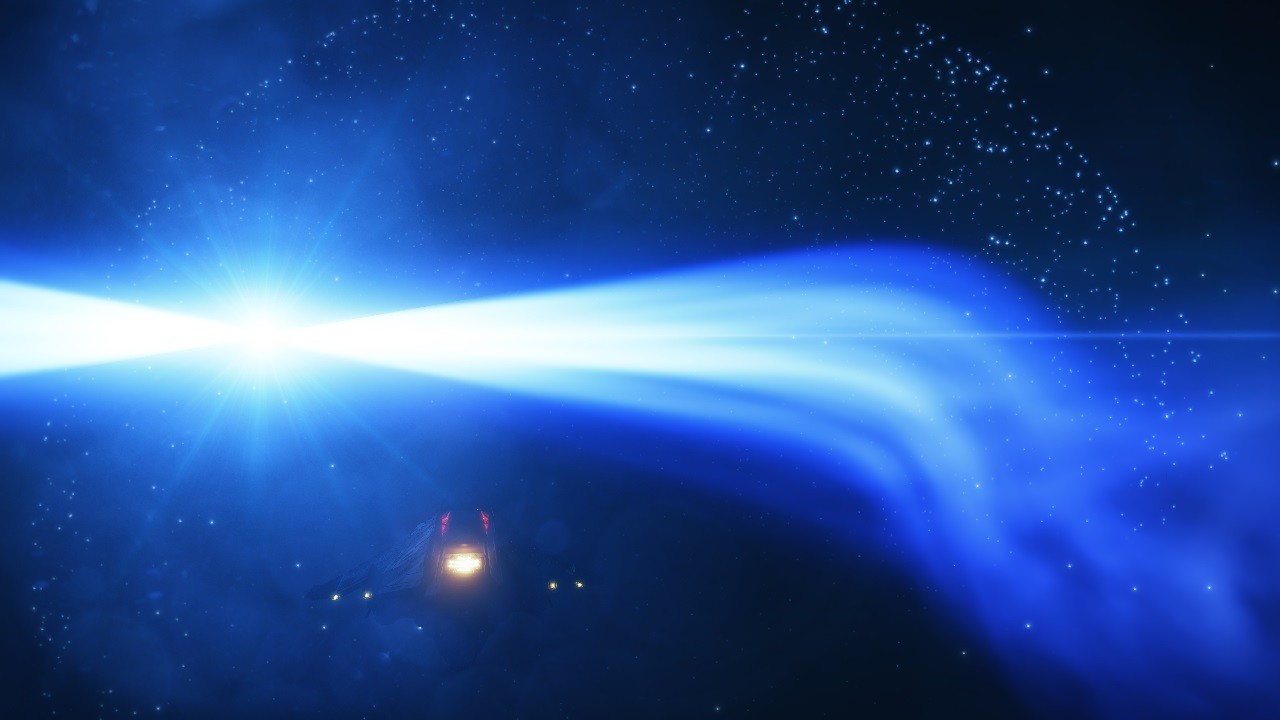
When I recovered my breath, still sweating, I locked system Dryao Aoscs FW-W e1-5865 in the nav computer. I explored every interesting system in route to Phianor and found a system, Eor Aowsy XU-N d7-277, that contained two high metal content terraformable worlds, two waterworlds and a beautiful ELW approximately the same size than Earth.
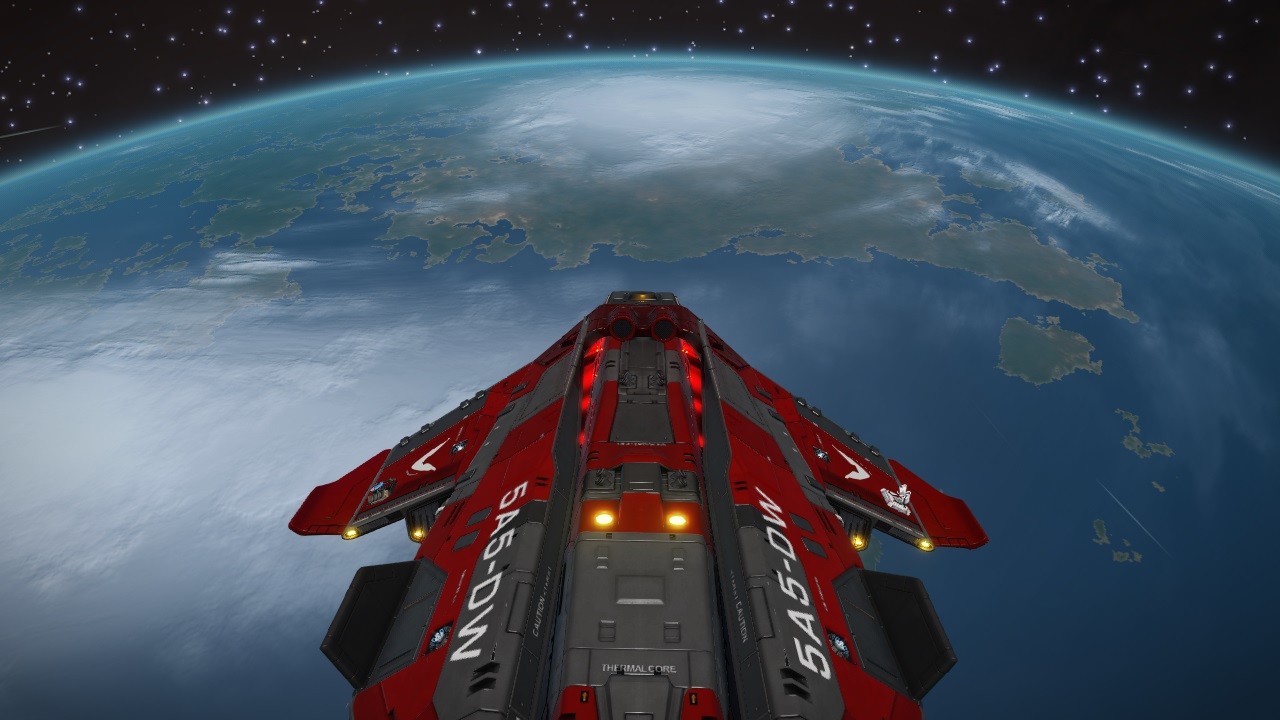
Some hours later I arrived to Phiaanor, a blue planetary nebula with a neutron star and a ringed water world which provides exhilarating views.
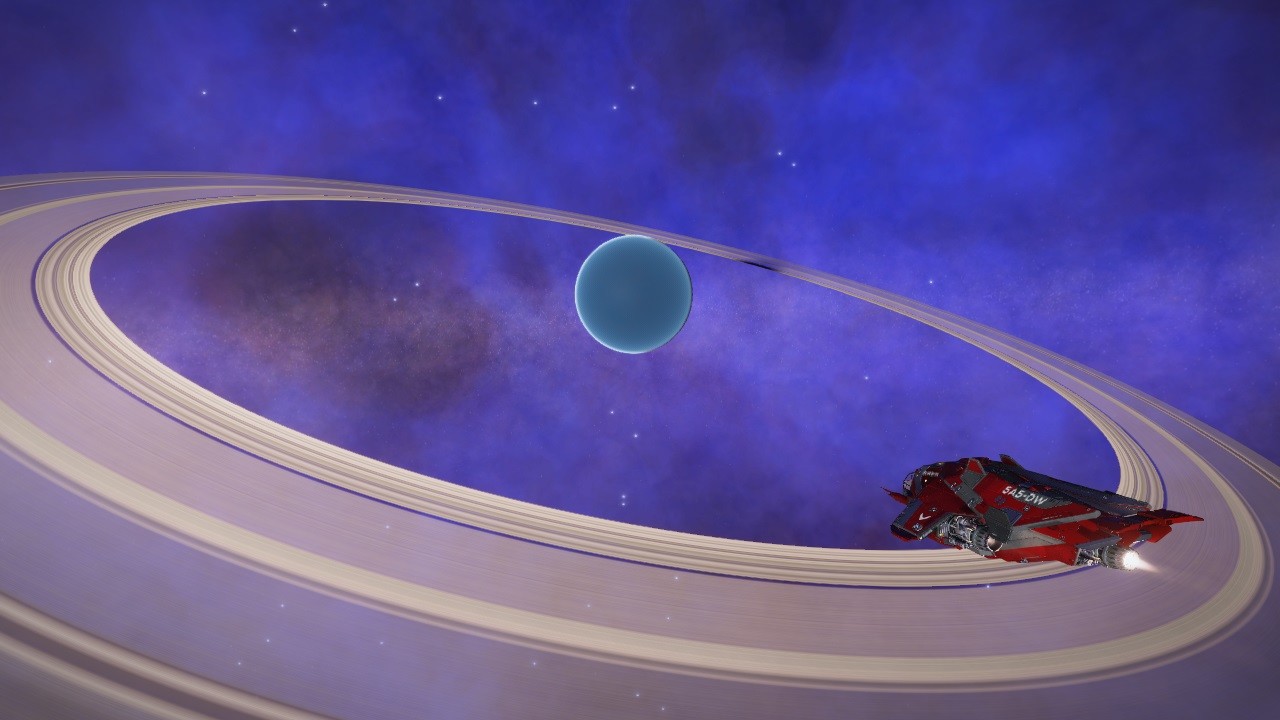
System Mylaifa AA-A h786 and the Ocularis Coelum were near, so I decided to continue. The Ocularis Coelum, or the Eye of Heaven, is a ringed G-class star discovered during a sector survey by Cmdr EtherealCereal on the SHEPARD mission. According to the Galactic Mapping Project database, its golden radiance coupled with the massive thirty million kilometers wide ring system gives it an angelic presence in an otherwise dark and dismal black hole system. I concur.
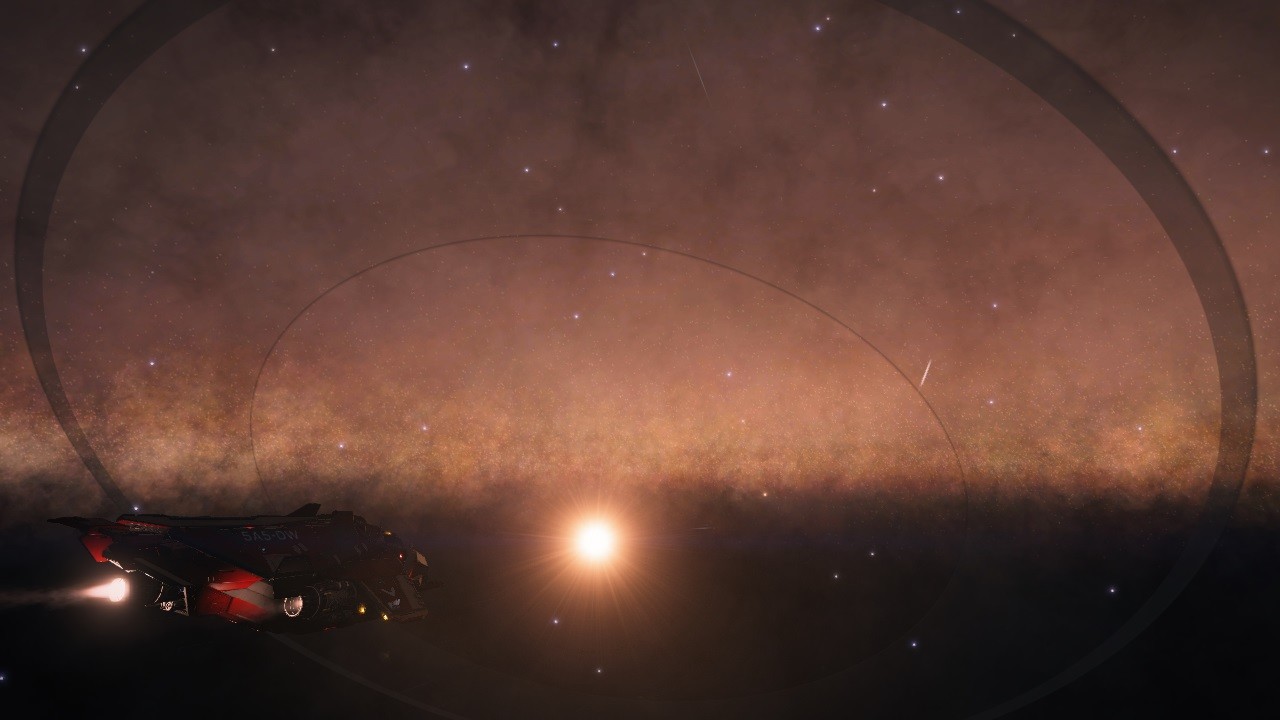
I felt well after such a long trip, so I decided to continue to the Gardens of Shangri-La. Knowing now what happened later, I should have landed and rest. Upon arrival I was greet by fellow commander VGN Niknoxe who complained about being losing the paint of his beautiful exploring Orca, and recommended me to visit the strange storms that were forming in the system. I have never seen a storm in space. Indeed, having expended most of my life in space, I have never seen a real storm. That was going to be my first storm. I activated the Discovery Scanner and quickly located the two notable stellar phenomena. I headed for the closest one. Commander VGN Niknoxe was not lying, there was a yellow Lagrange Cloud where a startling storm was forming among the prasinum and rubeum metallic crystals that floated around. I approached carefully one cluster of crystals and got hit by a light bolt. All systems blinked but the shields held.
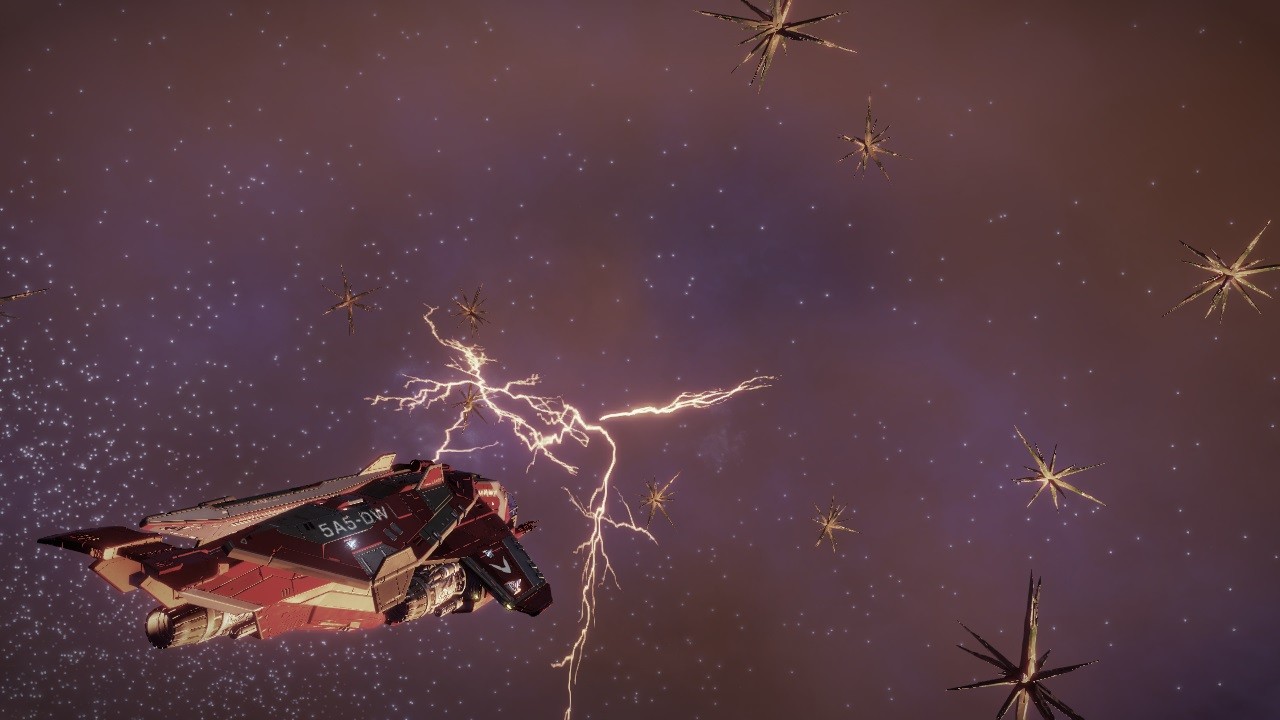
Overwhelmed by the experience, I decided to pay a visit to the second notable stellar phenomena. The moment I drop out of supercruise I noticed that the storm into this Lagrange Cloud was more violent that the one I had just beheld. The cloud looked darker and I could felt turbulence shaking the hull. That should had been enough signs for keeping a safe distance but, after being stroke by a light bolt with no harm, I was feeling quite confident in the Hyperion capabilities to resist this punishment.
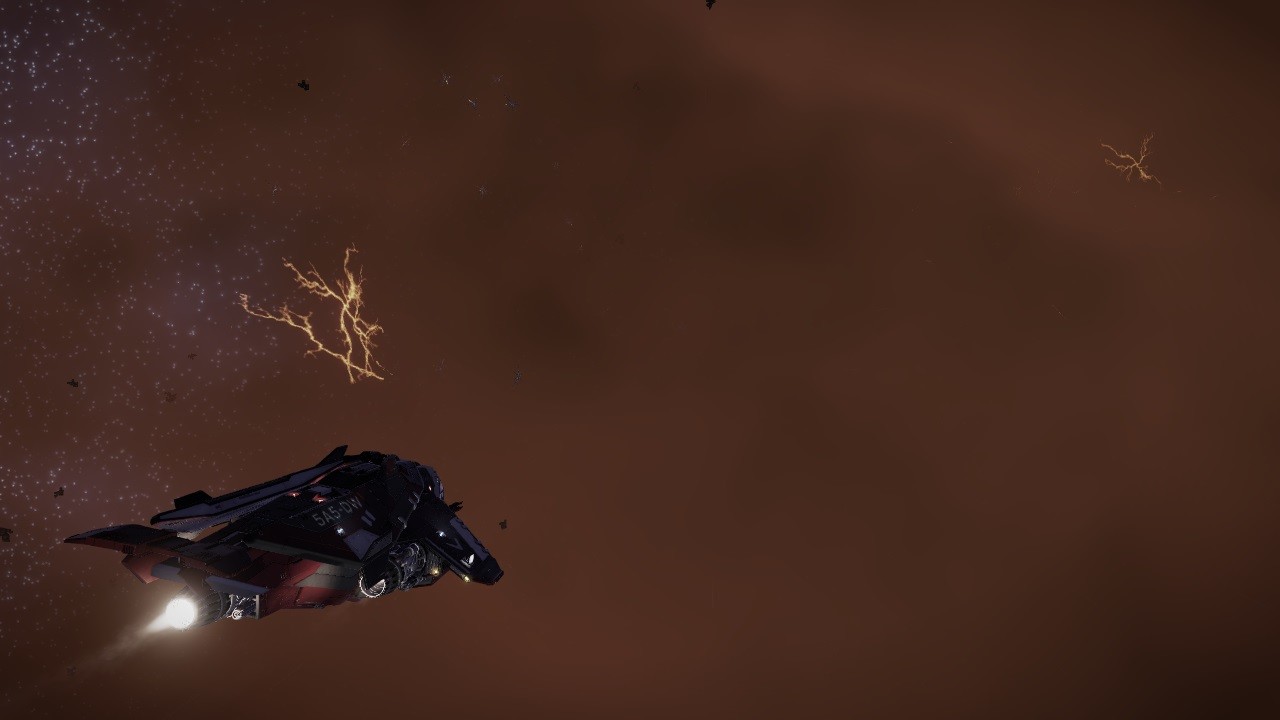
I found flavum metallic crystals and solid metal spheres on this occasion. As I pushed out farther into the storm it got darker and darker and the frequency of the lightning bolts increased.
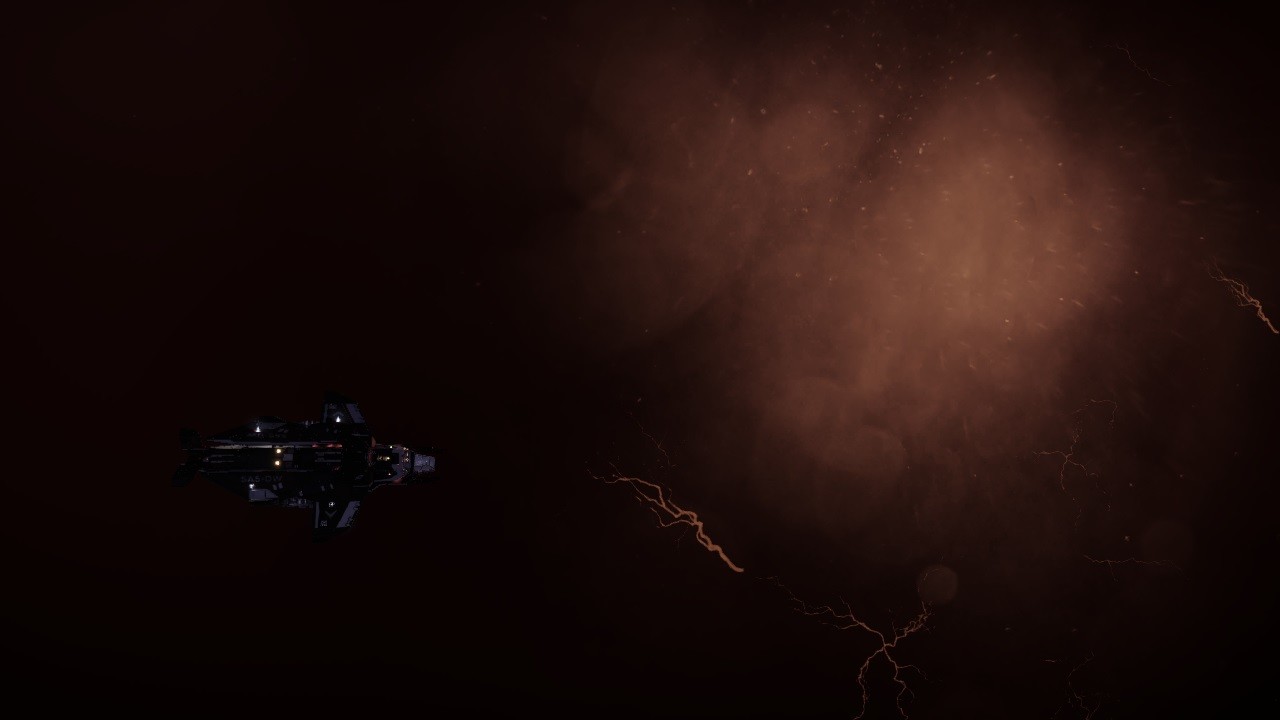
I should have turned back, but I did not and, suddenly I found myself surrounded by constant light bolts that made the Hyperion shake. In an instant, the shields failed, and I started to loose hull integrity. Damn me! There is a huge storm there, let’s put my tiny vessel in the middle of it and see what happens! I thought I was cursed. How could I be so reckless? How could I be so stupid?
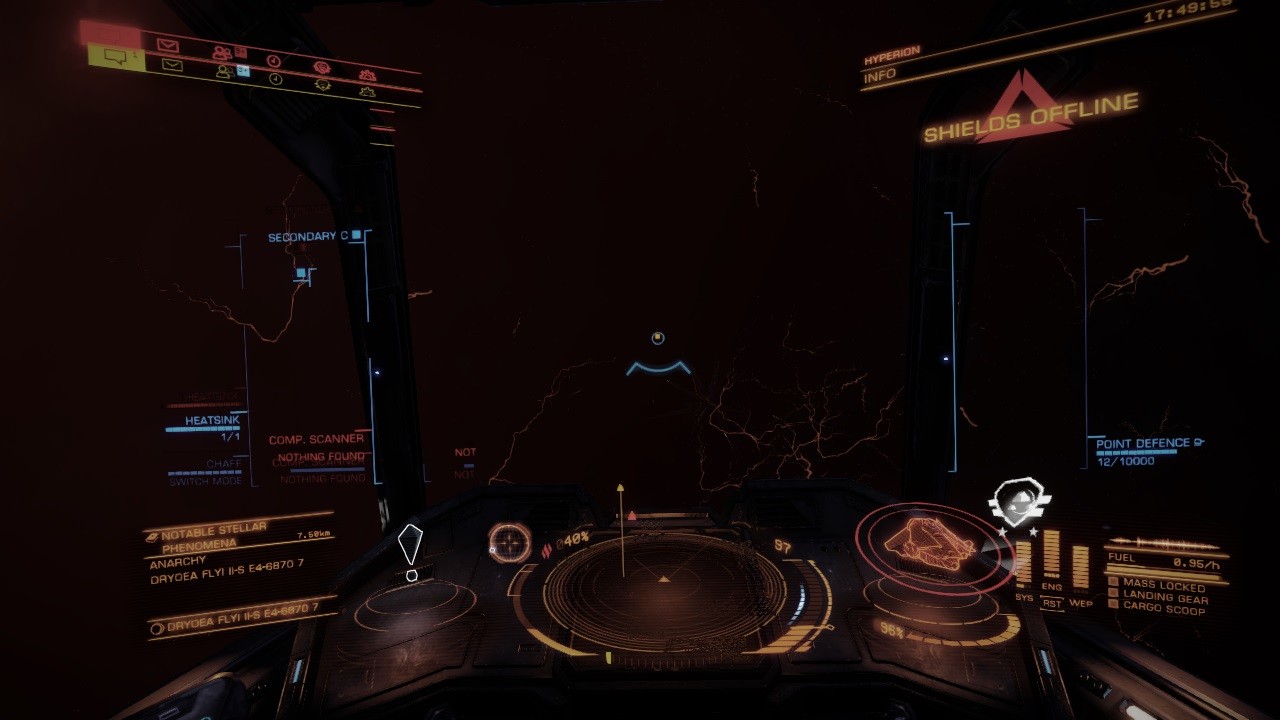
I boosted and boosted and boosted in a frantic effort to get away from the core of the storm. The shaking caused by the turbulence made it very difficult to control the Hyperion and plus all the systems were blinking. The COVAS repeated “Warning, taking hull damage” again and again. I think that I got touched by a light bolt twice, but I cannot be sure.
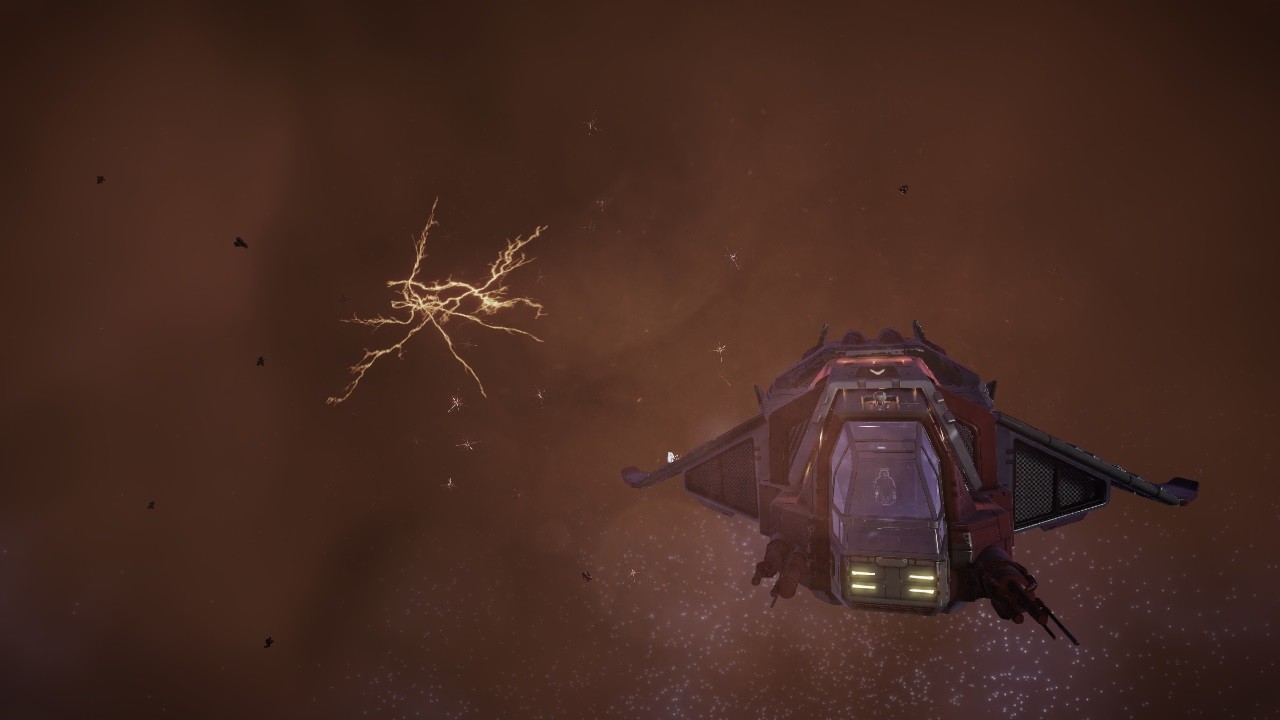
When I finally gained distance and stopped suffering damage, I checked every module of the Hyperion. It seemed that all systems were nominal, except the Frame Shift Drive but that was probably due to the neutron boost overcharging. There were some minor damages to the cargo hold too. But the most alarming was that the hull integrity had dropped to sixty percent. I had to take a decision, coming back to Polo Harbour for repairs or continuing with the itinerary knowing that I will not be able to fix the hull until we arrive to the core. Besides, I was carrying a fortune in exploration data. I switched off all systems and proceeded to activate them again. I used the AFMU to patch the FSD and the cargo hold. Everything worked fine. I thought that I was going to need to be more careful if I wanted to survive this expedition. I guess that a bigger ship would have endured the storm better that my tiny Diamondback Explorer, but this storms can be very dangerous for a little explorer with weak shields and a thin hull. I need to remember that as we move away more and more from civilized space. Who knows which other perils are waiting for us out there in the void?
I decided to fly to the nearby system of Eoch Pri FB-W e2-5646 and land there in order to make a visual check of the exterior of the Hyperion. I could use some rest too. Before departing, I took a quick recon flight over Dryoea Flyi II-S e4-6870 7, a beautiful Earth-like moon orbiting a lava planet in the nebula of the Gardens of Shangri-La.
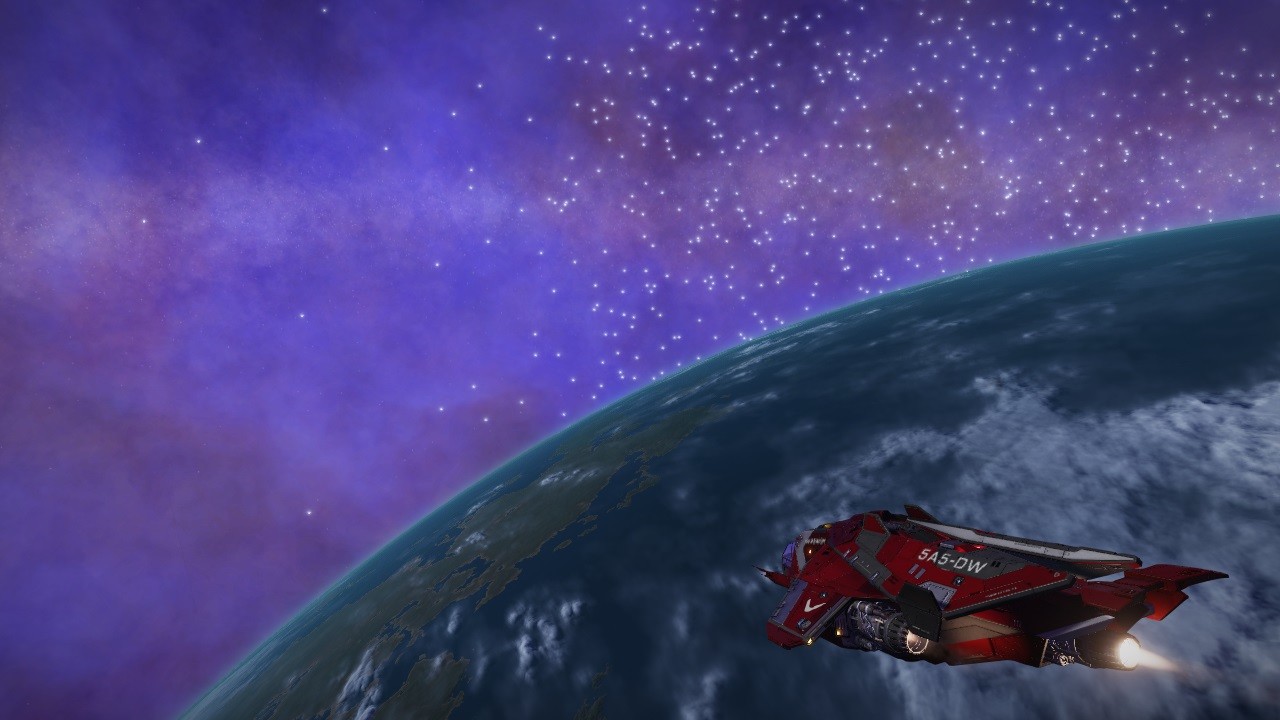
Eoch Pri FB-W e2-5646 is a system with a neutron star surrounded by a beautiful nebula known as The Gloaming. I thought that the first moon of the first planet in the system would be a sound place for landing, inspecting the Hyperion from the outside and sleeping some hours after more than seventy two hours exploring.
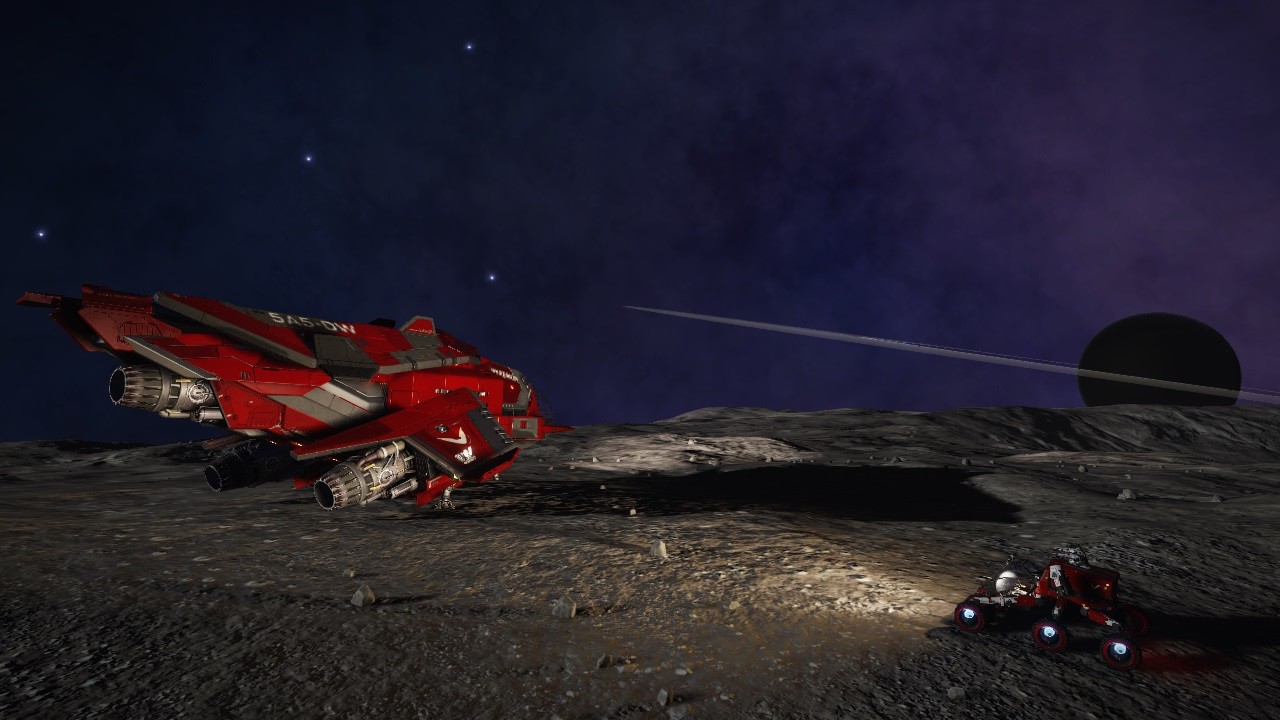
I stayed twenty four hours at The Gloaming. I used that time to rest and recheck all the systems of the Hyperion. The visual inspection of the hull showed no breaches. I decided to continue the trip. The next step was the nebula known as Fosforon.
I made a curious discovery on the way. A system with eighty stellar bodies including an Earth-like world. The place had everything: a green system with many pristine rings and lots of landable bodies. The only setback was that the secondary star where the ELW orbits was two hundred thousand light seconds away.
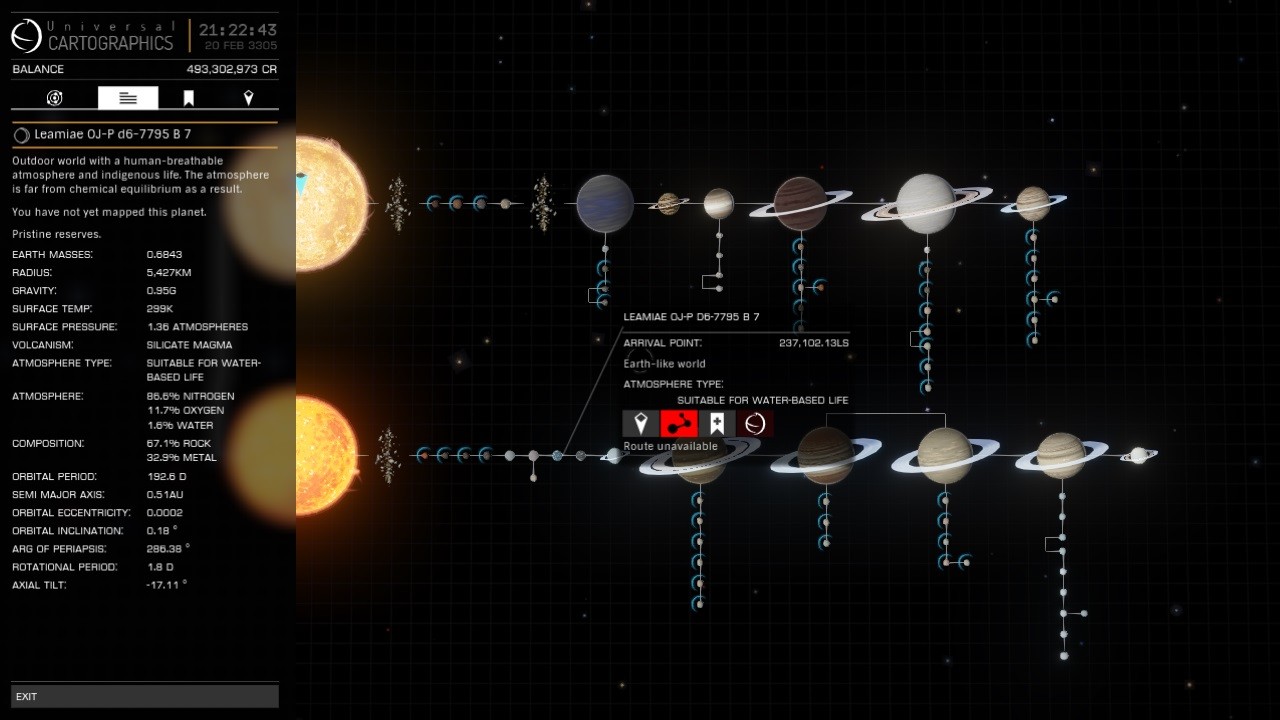
System Leamiae LS-T e3-3317, or Fosforon, was quite unremarkable, containing just a blackhole and a T class dwarf star, but its blue gas cloud was quite beauty to behold, specially from the neighboring star systems. I chose a rocky moon in the second star of system Leamiae WK-N D7-7617 to land and rest for the night while contemplating the nebula.
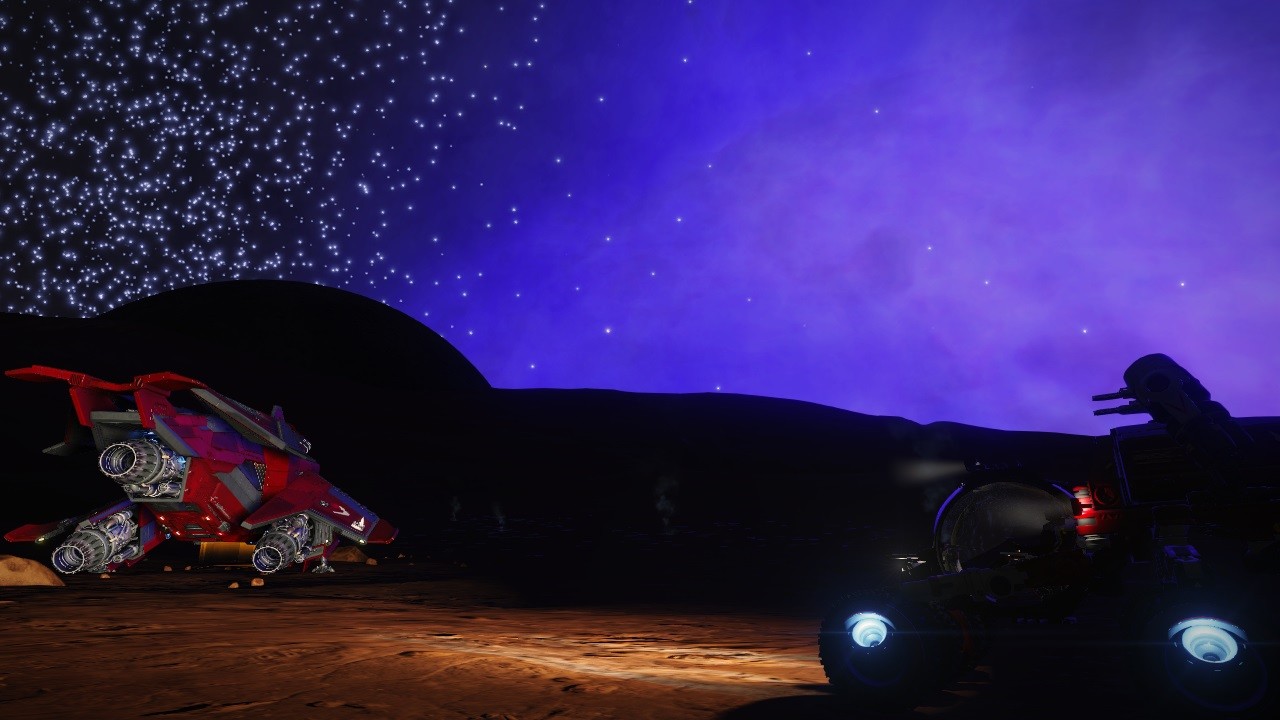
The next stop of the itinerary was the system Eok Pruae RO-R e4-2481, but I made a slight detour to visit the Fleur-de-Lis Nebula in system Dryaa Pruae BG-X d1-1087, a medium-small nebula, resembling the Fleur-de-Lis symbol from ancient Earth heraldry.
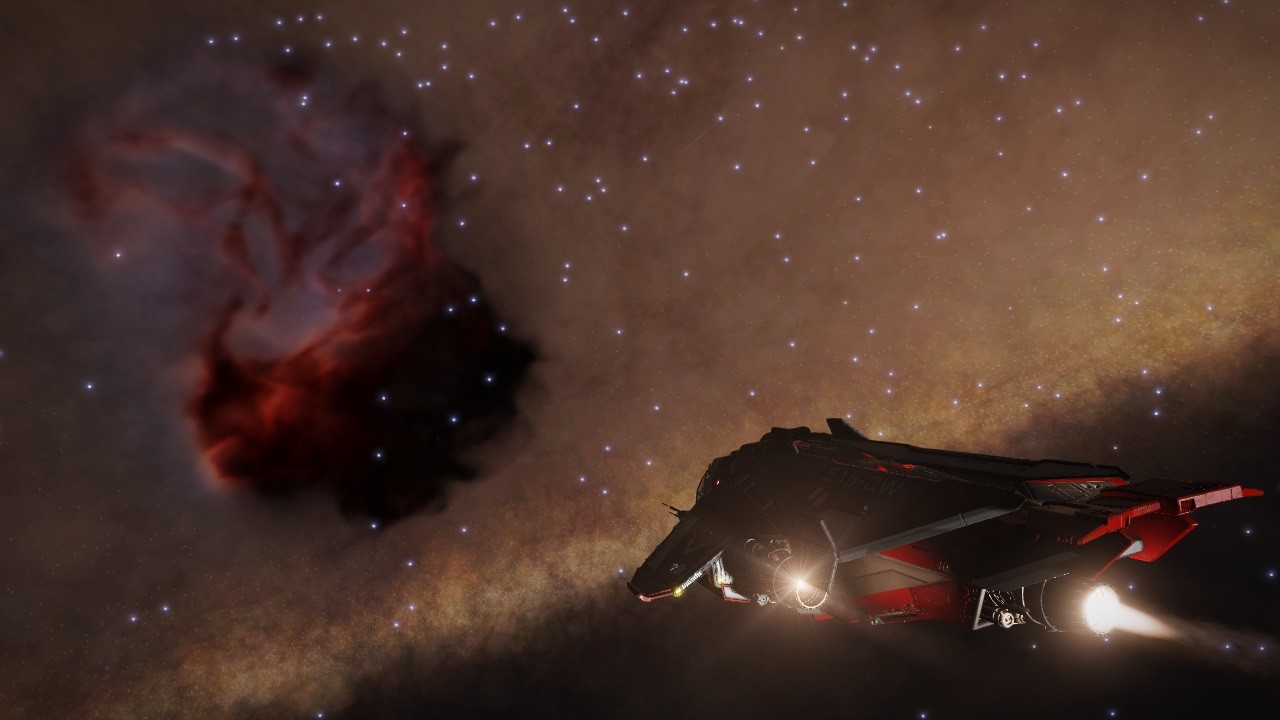
The nearby Pink Flame Nebula, at system Eok Pruae RO-R e4-2481 is a pink and purple supernova remnant containing a neutron star and its extensive planetary system, including a distant Blue White star companion with its own large planetary system.
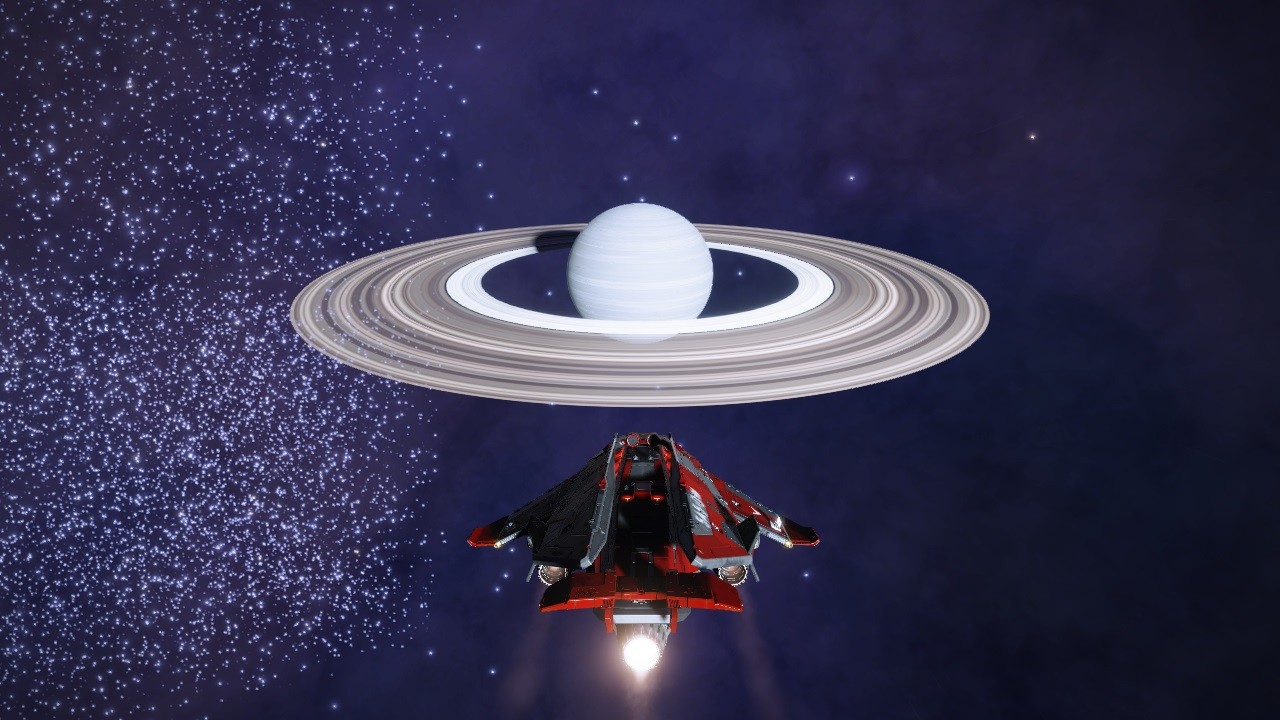
From there, I headed to system Eok Pruae PI-S e4-2295, also known as the Cloverfield Planetary Nebula, a black hole system surrounded by a glowing blue ejected cloud. The density of stars, so close to the core of the galaxy, combined with the blue hue and the light distortion of the black hole creates mesmerizing images.
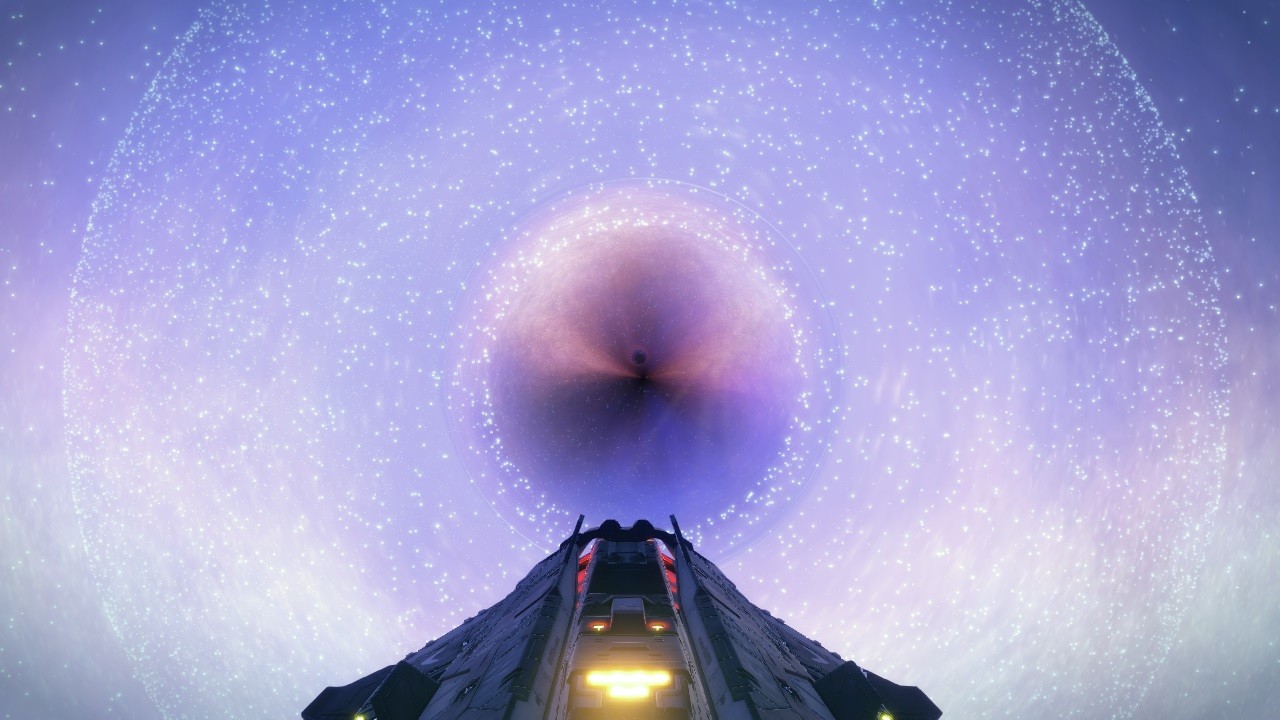
After enjoying the view for a while, I set course for the last waypoint, system Dryau Ausms KG-Y e3390, also known as The Dryau Awesomes, and on the way I made another interesting discovery. A giant ammonia world with twenty four times the mass of Earth. I guess that could be Thargoids paradise. I made a quick recon flight to see the huge yellowish planet and mapped it.
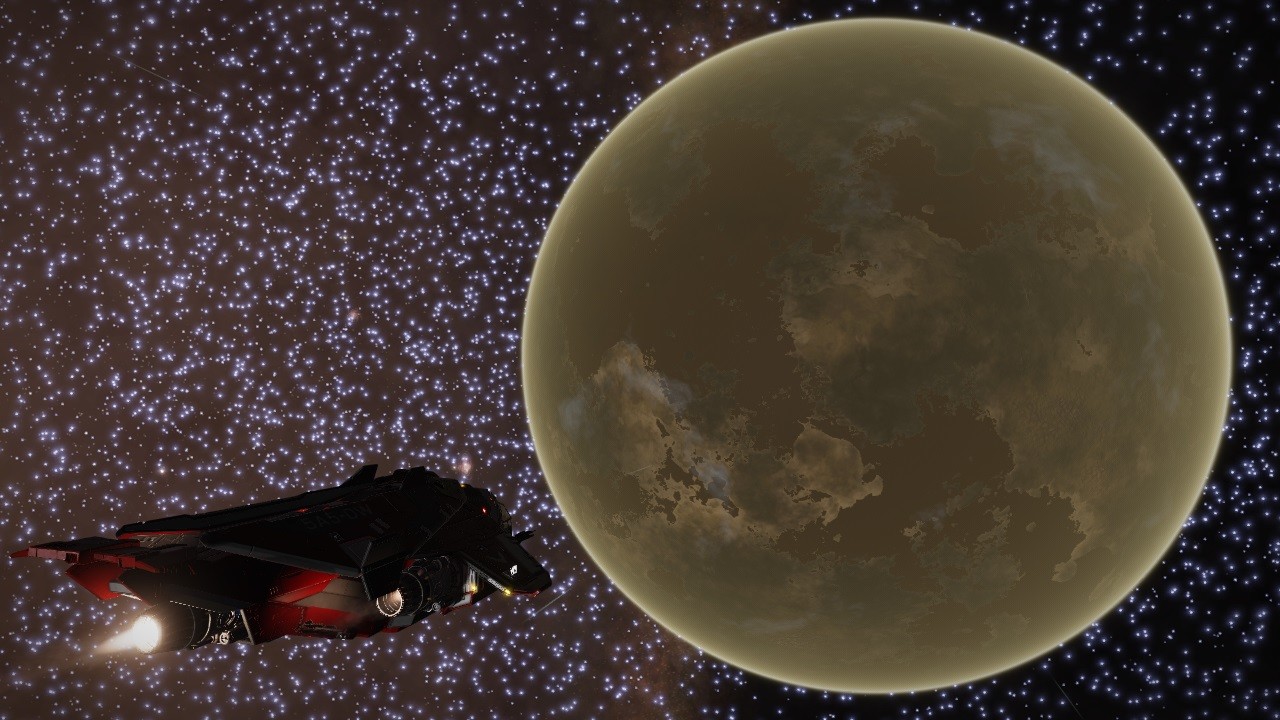
And, at last, after flying thousands of light years barely resting, exploring dozens of systems, with just sixty percent of my hull integrity, I arrived to Dryau Awesomes, where the Distant Worlds 2 basecamp is set. This place is, as described in the Galactic Mapping Project database, an absolute madness from a topology standpoint. The blackhole drop star is in tight binary with a white dwarf, which itself has a gas giant orbiting fully inside its exclusion zone and passing through the cones with a period of fourteen minutes. Less than twenty light seconds away lies a binary of a huge waterworld and a ringed gas giant, the latter of which has two volcanic moons skimming the very edge of the rings on slightly inclined orbits. The views offered from the surface of the landable moons is unlike anything seen elsewhere in the galaxy, and all objects in the inner system have extremely short orbital periods creating a dynamically changing view in the sky.
There were still twenty four hours for the release of the next waypoint, so I decided to see it with my own eyes and approached one of the moons orbiting the gas giant before going to the basecamp. It was amazing! I flew between the gas giant and one of its moons towards the other moon while watching how the first planet of the system eclipsed the white dwarf which jet cone was distorted by the nearby blackhole. I cannot understand how this system holds together.
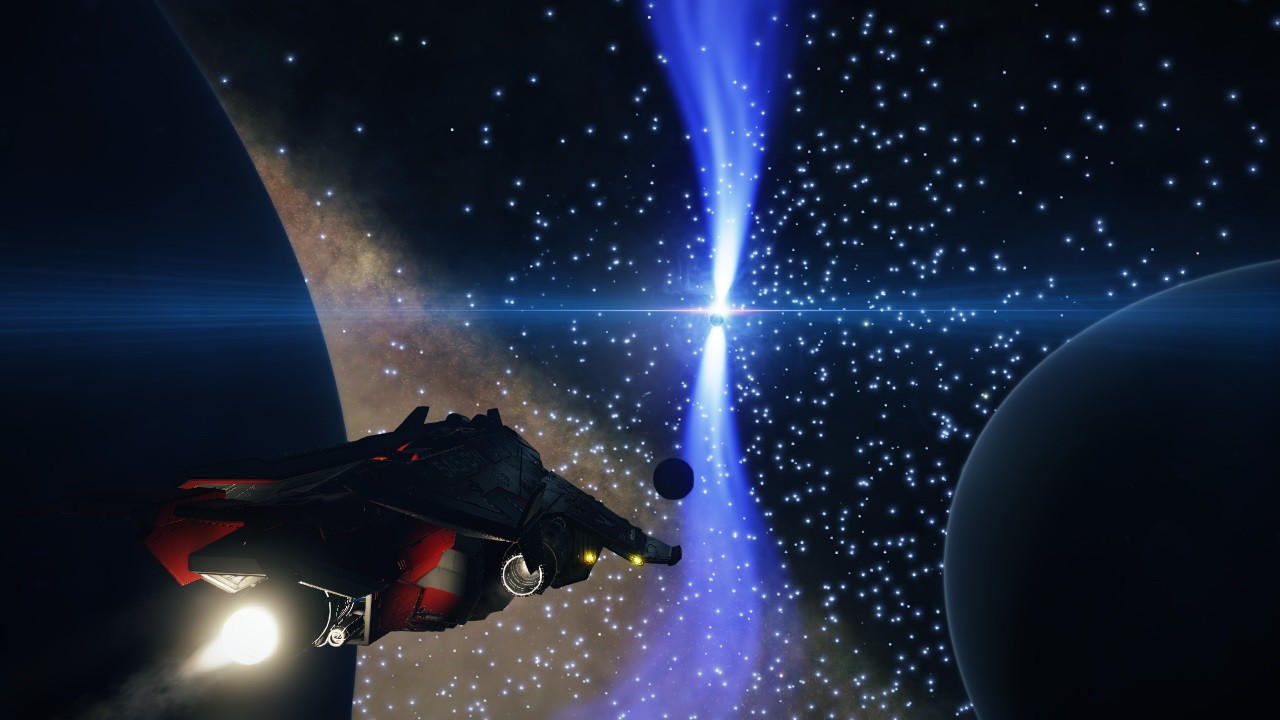
Dryau Ausms KG-Y e3390 AB 2 A has incredible canyons. I followed one until I found a nice place with views to land and rest for the night.
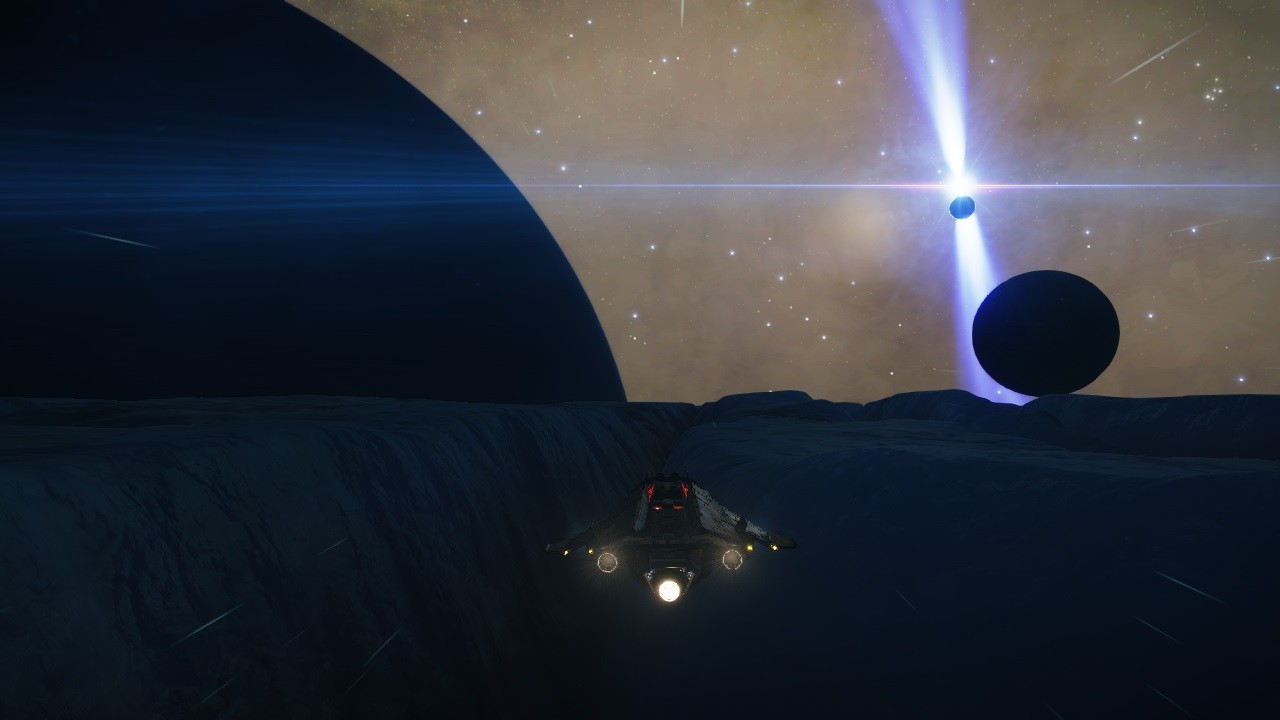
The system was swarming with ships from the expedition. I listened to their comms transmissions for a while, before falling asleep. It seemed that some pilots had already flown to Sagittarius A and landed at Explorer’s Anchorage. The new starport in the galactic core has been deployed, but it is still barely operational. I guess it will be the task of this fleet to help in the construction and deployment of the services of the starport during the next weeks. There are also disturbing rumors coming from the Bubble. The Thargoid raids had increased and they are getting too close to Sol system. They said that Cyllene Orbital in Atlas system is in flames. I know I am not ready to fight the Thargoids, but I feel like I am running on the opposite direction. And many combat able commanders are doing it too. This expedition has provided me the money to build an able anti-xeno combat ship, or at least a passenger ship to help rescuing survivors. I am not sure if I should come back and join the fight against the Thargoids. At this pace, maybe there will not be a Bubble to return when this expedition is over.
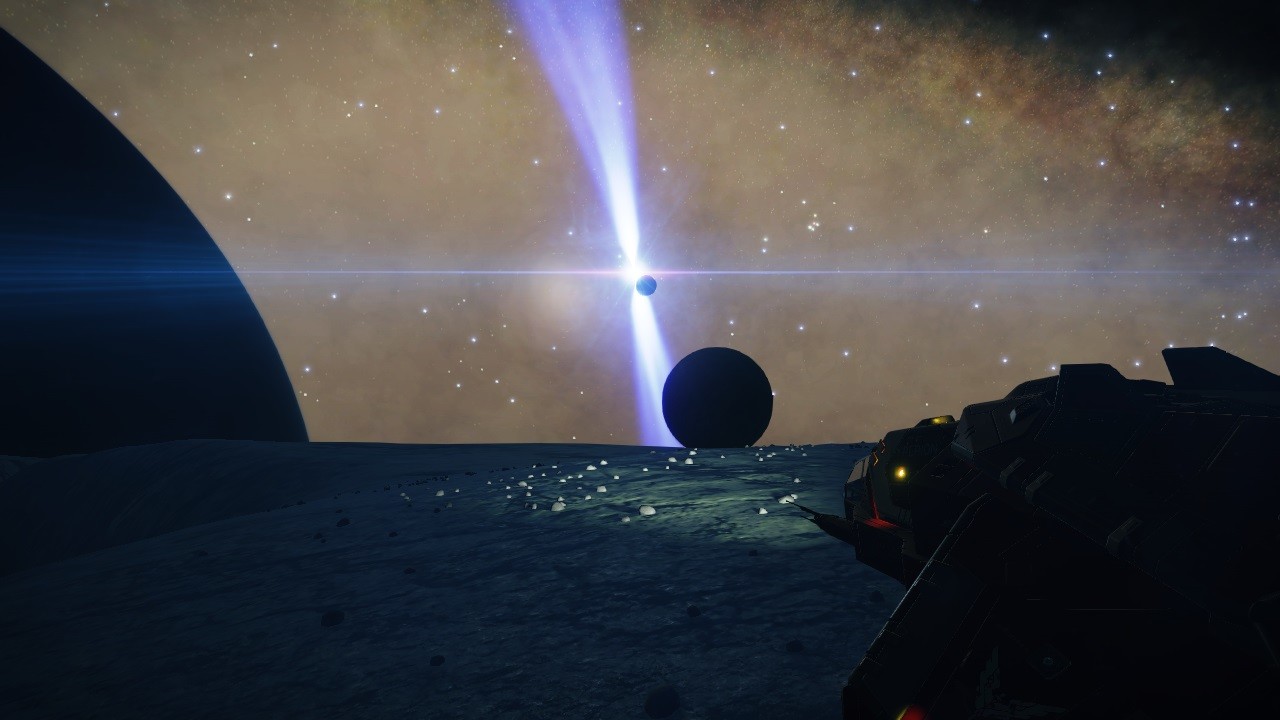
I got up and departed the moon to arrive to the basecamp of “New Aloros Ravine” in planet Dryau Ausms KG-Y e3390 AB 8 A A a couple of hour before the release of the next waypoint. There were some fellow commanders waiting there too.
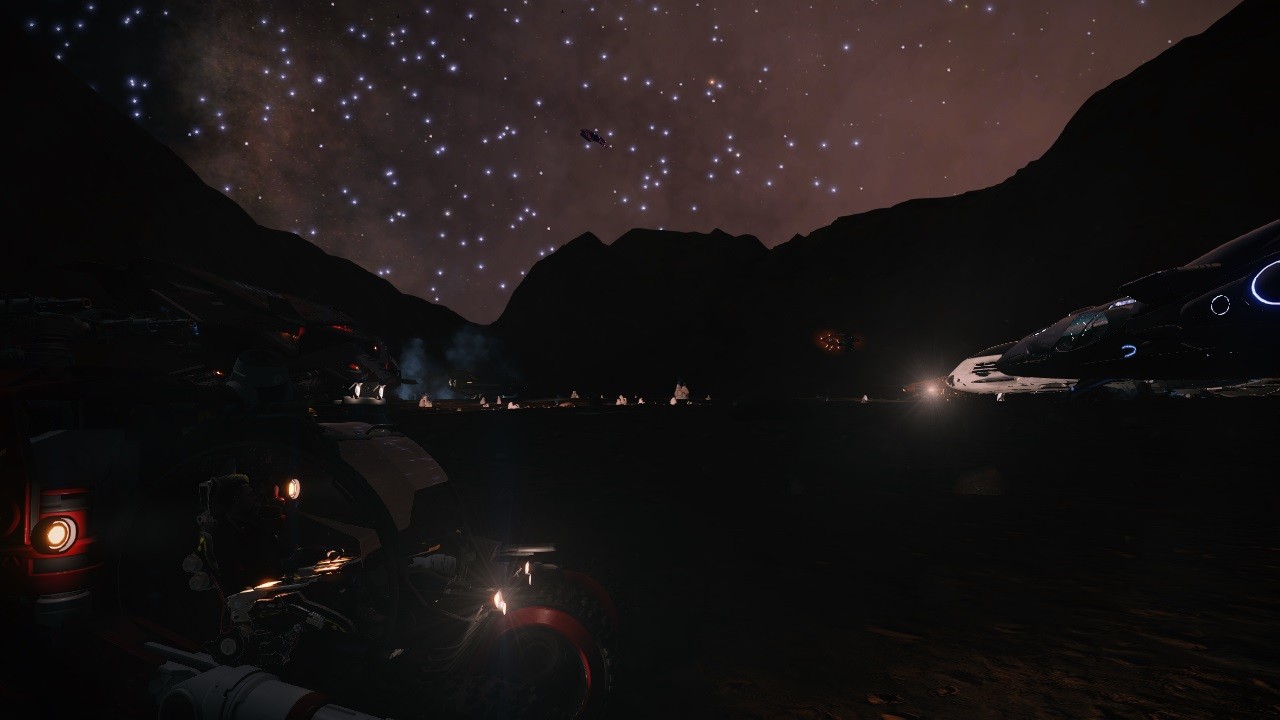
The new itinerary has just been released. We are heading to Sagittarius A, as expected. The fleet will be there for three weeks, contributing to the fully deployment of the new station, Explorer’s Anchorage, the last human outpost. From there we will aim to Beagle Point, in the far reach of the galaxy. A huge travel through the void, full of dangers. And, despite the great task ahead, all my thoughts now are with the brave pilots that are protecting the civilized space from the Thargoids raids. A storm is coming. A huge storm in the form of Thargoid swarm that menaces to wipe out the civilized systems. I fear that storm.
Jav Marlo signing out.
DISTANT WORLDS 2 (PART 7) – THE CRUX, THE CLOCK AND THE BULLET
15 FEB 3305 Polo Harbour (Boewnst KS-S c20-959)
This is commander Jav Marlo, recording this log on route to Gagarin Gate space port in system Gru Hypue KS-T d3-31. I have made up my mind and I must stick to my decision. I will go until the end of this expedition. And I will keep my eyes and ears open just in case any surprises might happen. I must admit that the visit to the Conflux Delta Site affected me more than I expected. The creepy logs and the final fate of the Dinasty Expedition drove me to dig into the GalNet News database looking for clues about them and their connection with the Children of Raxxla, and that did not help to ease my mind. The lies of the Empire and the Federation are so obvious! The rest of information I found in the GalNet did not help either. There are groups there proclaiming all short of conspiracy theories. And, of course, there was Salomé. The saint or the terrorist, depending on who you ask. Well, she was a martyr for sure, and she took many secrets with her. One thing I have learn, besides the fact that I am developing a fascination for her, and it is that I cannot believe in what I read. From now on, I have decided to stick just to the facts, do my own research, and develop my own conclusions.
The first stop on this new stage of the Distant Worlds 2 expedition is a spaceport called Gagarin Gate, in the fourth planet of the Gru Hypue KS-T d3-31 system, that is inside the Vostok-1 nebula. It is part of the Colonia Connection Highway. The place is named after Yuri Gagarin, the first man to fly into outer space and orbit old Earth. Vostok-1 was the name of the vehicle in which he achieved his historic space flight.
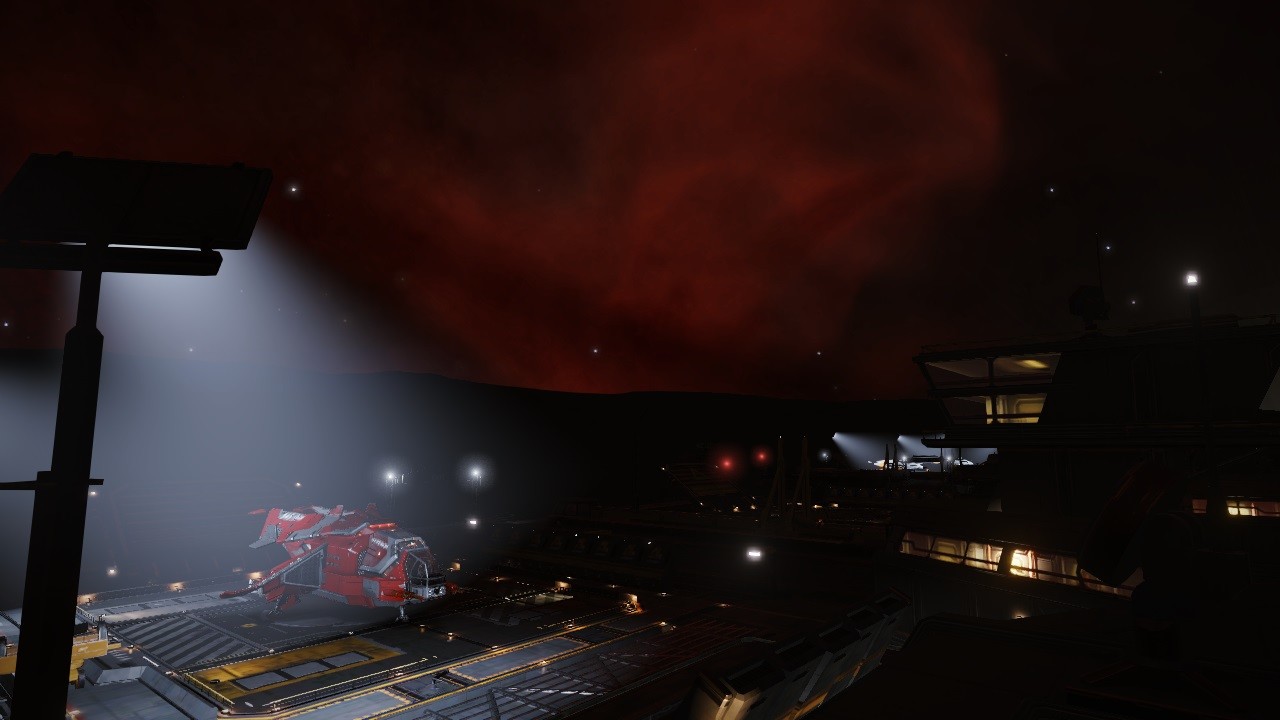
It seems that there are many stations and space ports on this stage of the trip if one has necessity of repairs, resupply or just wants to stretch the legs. But Erimus Kamzel has warned us that the next step will take us coreward, so we should take profit of this last chances before we start to get away from civilisation. At least, if everything goes as planned, there will be space station waiting for us near Sagittarius A. The efforts of the fleet in the Omega Nebula well deserve it.
Resuming log. As usual, I am going to try to visit all the interesting points along the route while exploring the systems where I jump. The first of them is Gru Hypue AA-A g4, also known as Jo Ella’s Flares, a system with three pulsars and a black hole. Of particular interest is the binary orbit of the black hole with one of the pulsars, keeping an orbital period of just five hours. They are really close! The black hole distorts the light and it seems that the Hyperion is flying backwards when approaching at cruise speed.
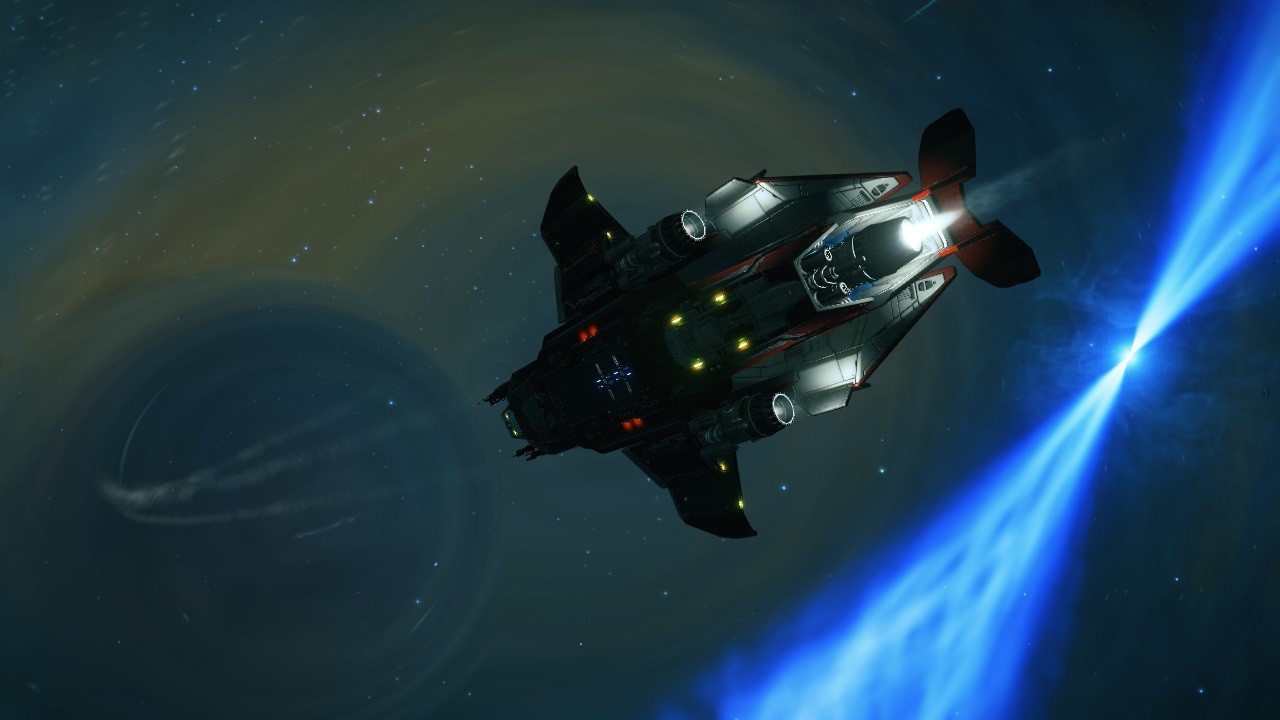
The Frame Shift Drive technology of nowadays allows a ship with a low heat output, like the Hyperion, to navigate between a black hole and a neutron star with a relative safety, but that was a very dangerous business just some years ago. I cannot forget the logs of the Conflux Delta Site warning the explorers of the future about the neutron star there that causes their demise and how they described how it cooked their ship. Well, is getting hot too inside the cockpit, time to aim for Nuekuae AA-A h52, also known as The Crux.
Nuekuae AA-A h52, or The Crux, is a system containing a binary pair of pulsars in a tight orbit with a third pulsar. The jets of the third pulsar point perpendicularly to the binary pair, making them look like a cross when viewed from a determined angle. The main body of the system is a black hole, and there is a ringed brown dwarf too.
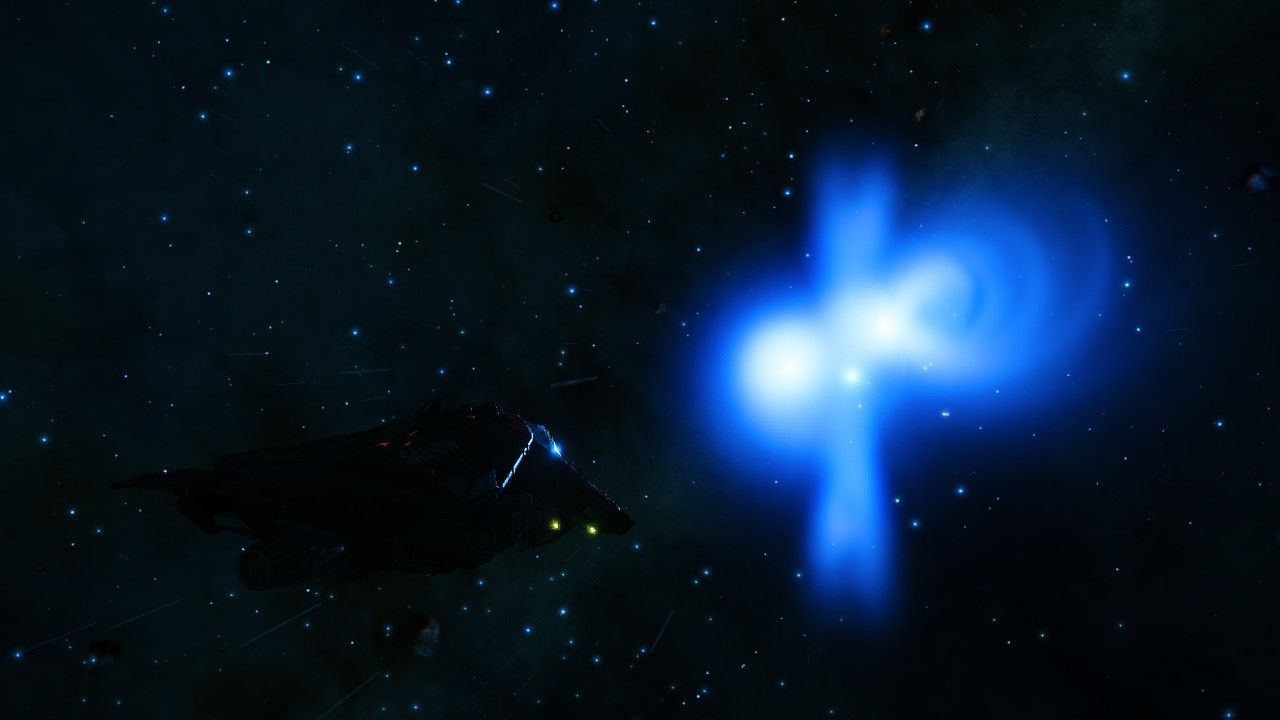
Very close to “The Crux” is the system Gandharvi, where the faction known as the Mercantile Pact of Gandharvi has stablished an Ocellus station, Caravanserai starport, and an outpost by the name of marlin’s reach. I chose to land in the first. All the gravity I can get the better.
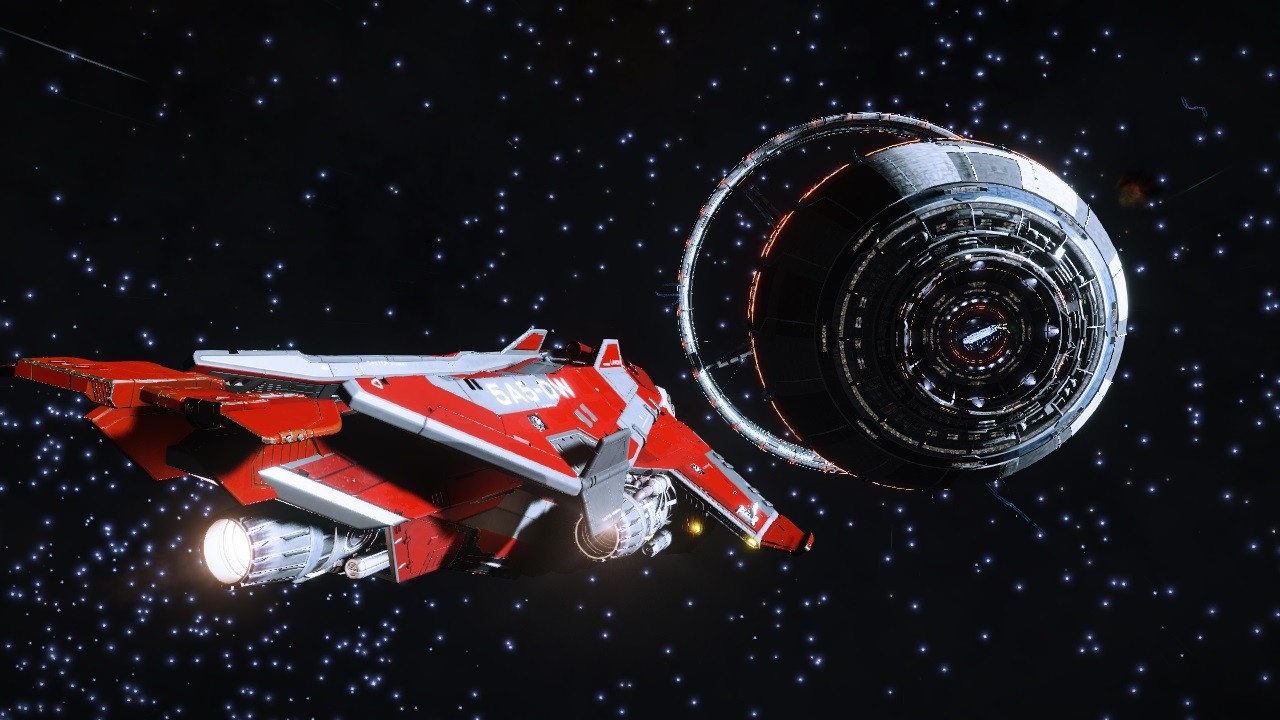
Resuming log. Caravanserai starport is surprisingly well equipped for being so far from the Bubble. The local government is a patronage, and it seems that the Colonia Council is expanding its operations there what has caused a war between them and a local corporation called Scutum-Crux Resources Inc. Despite that, the station has many services, and even high tier ships like the new Krait Mk II can be bought at the shipyard. The local market is also very well provisioned. I took advantage and buy a crate of liquor, to compensate for the one of Lavian Brandy that I lost during the pirate attack I suffered in the Omega Nebula. They also sell food cartridges. I bought one crate in hope it contains some new options for the food printers of the Hyperion. I should have thought about this before leaving The Bubble. I also buy some survival equipment, just in case. Maybe it could help if I have an accident that leaves me stranded in the surface of any remote moon. I am surprise to see that the system sells imperial slaves too. I guess it is a patronage after all. Poor people, I bet they never thought they will end in such a forsaken place so far from the Empire.
Before leaving Caravanserai starport I do something that fills me with pride. I order a decal of Elite in exploration to be painted in the wings of the Hyperion. The original painting has deteriorated, too many fuel scooping I guess, so I make the Hyperion to be repainted too.
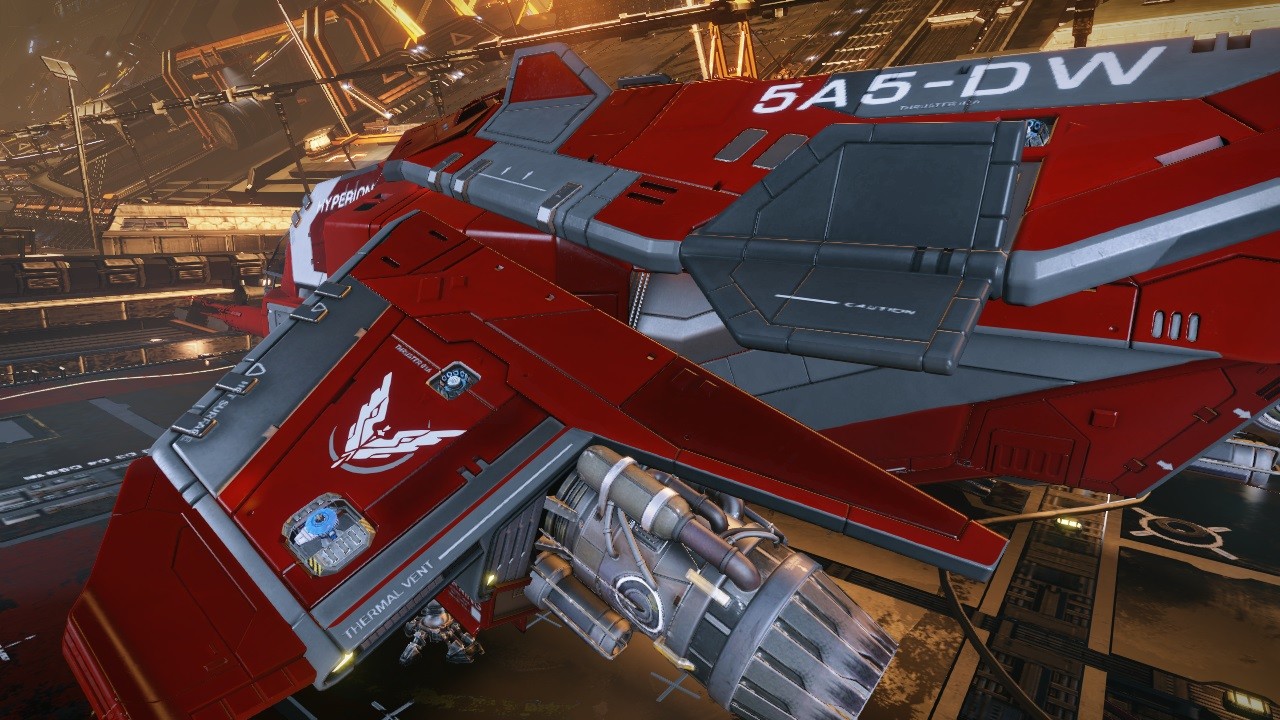
The next stop is known as the Polonium Fields, in the Amaethon Nebula, a small moon that it is said to contain the highest known concentration of Polonium in the Galaxy. The path to system Floalt GO-G d11-9 and the Amaethon Nebula is long, but splattered with many neutron stars that boost my jump range. On the way I discover my first Earth like world of this stage of the expedition. A tiny blue planet with just a third of the mass of the Earth orbiting a star thirteen light years away from the arrival point. The system is Blaa Phoe WA-J c11-61. From above, it looks like a cold planet, with lots of ice plates.

I resumed course and soon I found myself in the Amaethon Nebula with its hues of blue and orange. It was named after Amaethon, the Welsh God of agriculture and, acording to the Galactic Mapping Project database, the region could be a potential location for further human deep space expansion.
Floalt GO-G d11-9 4 E has just five hundred kilometers radius and a 0.03 gravity, making it a challenge to navigate in the scarab. Anyhow, its Polonium is worth the effort, so I choose a plain close to the north pole and carefully drive around looking to increase my jumponium reserves.
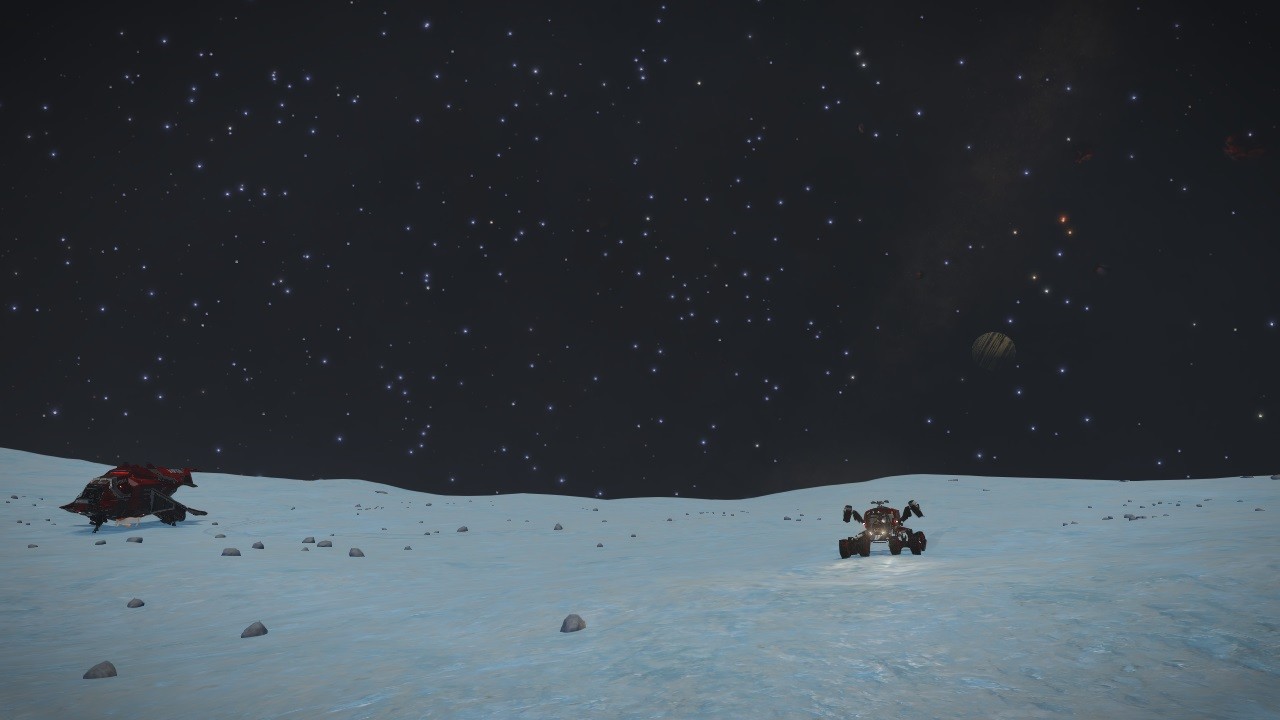
Resuming log. The pit stop at Polonium Fields have been worthwhile. I have collected forty two units of Polonium, and now I could do fourteen FSD premium injections of jumponium if necessary. I am going to need more Arsenic. The resting felt well too.
The next point of interest in the route was the place known as the Death Spiral. What a colorful name! The system Blaa Phoe NC-D d12-230 contains a Class V gas giant in an orbit of just fifteen minutes around the primary White Dwarf. The orbital distance is so tight that gas giant cannot be reached using supercruise. The White Dwarf drops the ships out of supercruise about two light years out. There is also a M Red Dwarf companion very close. According to the Galactic Mapping Project database, the gas giant passes trough the jet of the White Dwarf on its superfast orbit. The planet is so close to the White Dwarf that it is within the Roche Limit and should have been torn apart to form a ring system, and it also orbits faster than the White Dwarf’s rotation period, which it is itself only 16 minutes, therefore is spiralling in to the White Dwarf due to tidal forces. The system is also 7.8 billion years old. How the gas giant continues to survive, how it got into its current orbit around the White Dwarf, and how the White Dwarf and its planet both got so close to the M Red Dwarf star after the end of the White Dwarf's former red giant phase are all deep mysteries!
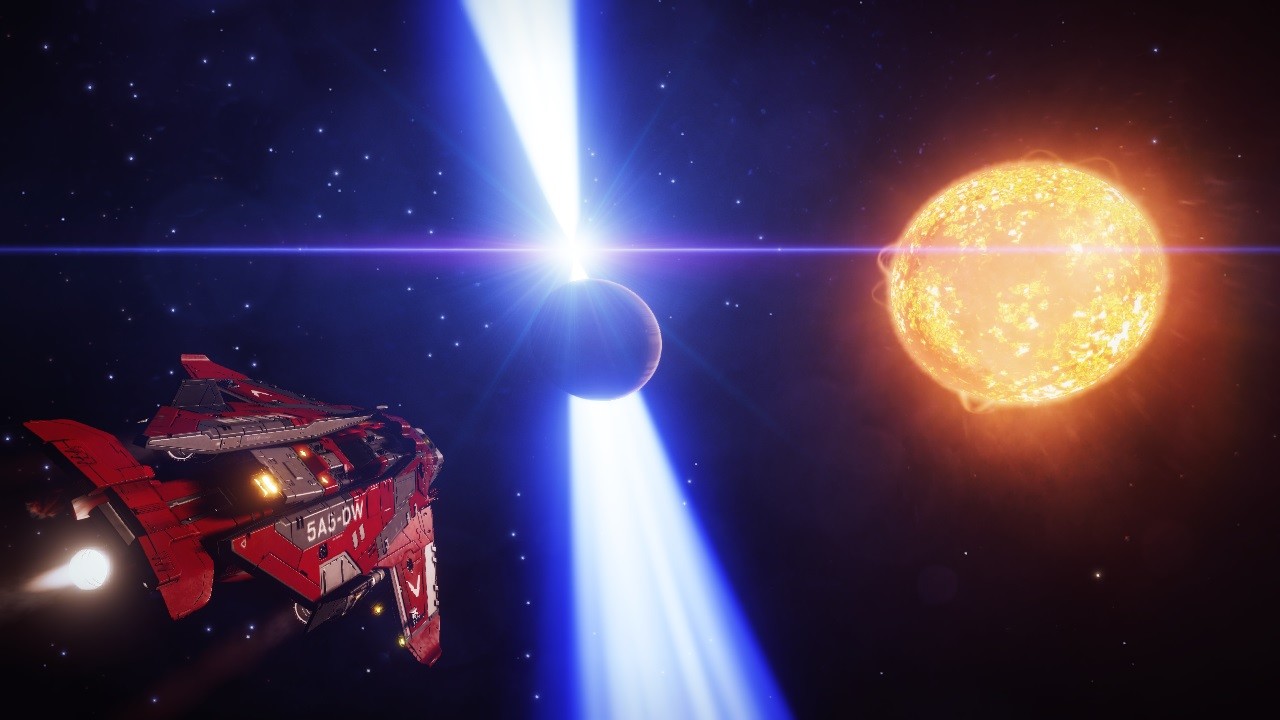
Very close to the Death Spiral is the system Boewnst AA-A h33 also known as Michell’s Legacy, in honour to John Michell who first postulated the existence of black holes back in the eighteenth century. The system contains six black holes. One of the highest concentrations of system-specific black holes currently discovered.
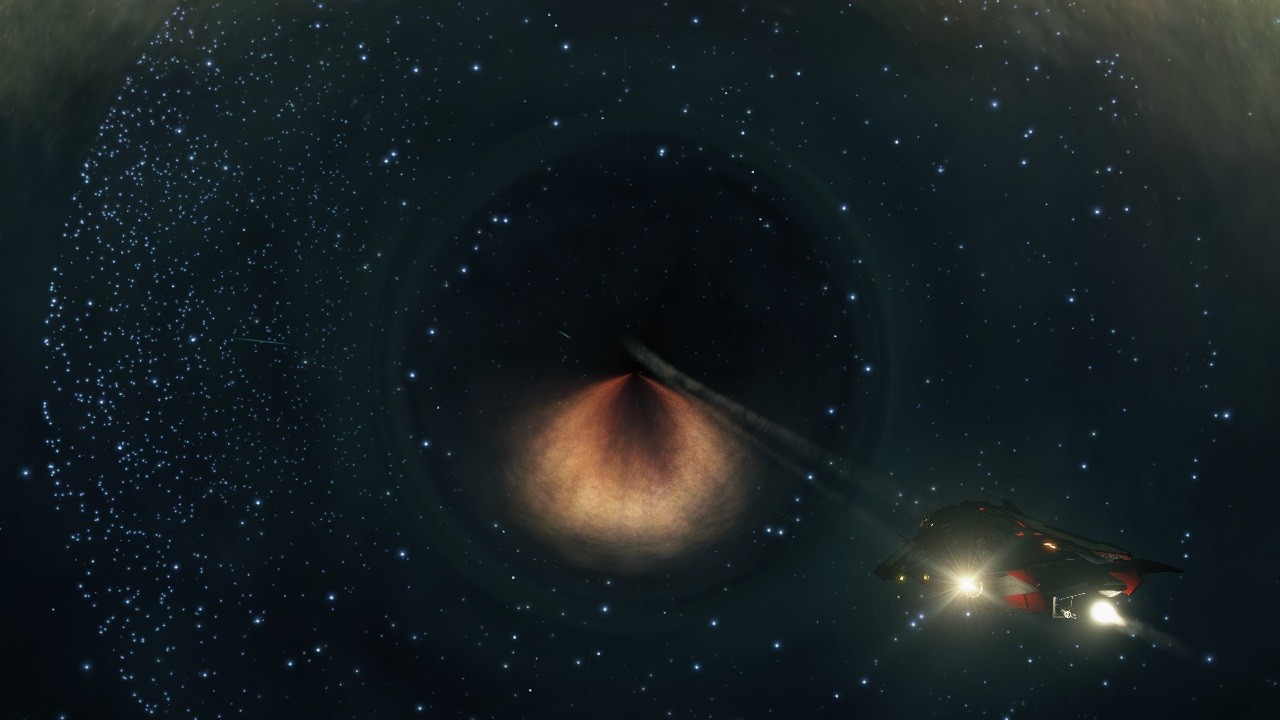
From there I headed for the Crayfish Nebula, with a quick stop planned on the Clockwork Rings. The one thousand eight hundred light years trip proved very profitable. I found a system with three water worlds, Boewnst TI-Z D1-3734, and a beautiful ringed ammonia world with void opals hotspots in Byaa Ain ME-N C8-66. The ammonia world was huge, and I could see perfectly the shape of the continents from above. I have read that the Thargoids fancy this kind of worlds.
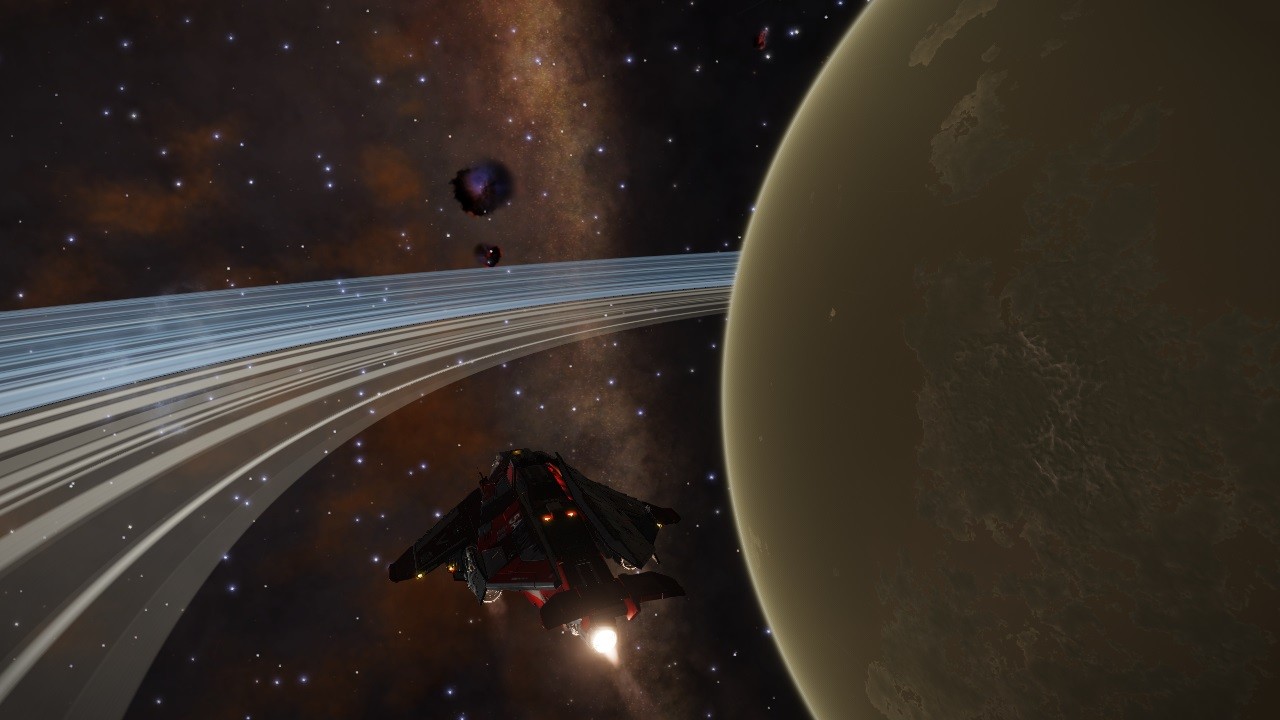
The system Byaa Ain QA-J c11-144 has a couple of twin ringed planets with high metal content orbiting each other less than one light second away. Each planet's rings are perpendicular to other other's, allowing for fascinating views. Just beware the high gravity when landing. The perfect spot for resting some hours.
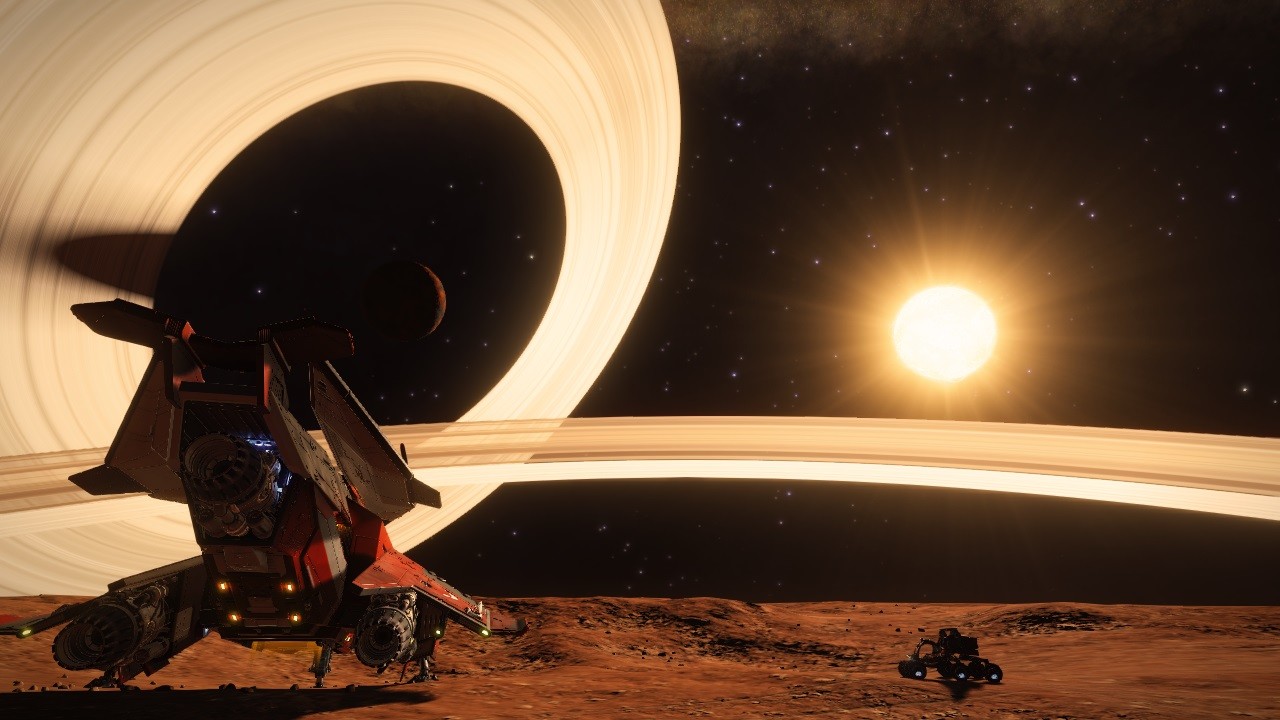
Resuming log. The Crayfish Nebula is a small nebula that glows reds and sits over one thousand one hundred light years above the galactic plane and over sixteen thousand light years from Sol. The system Byaa Ain XK-R c7-65 has a couple of Brown Dwarfs with very thin rings, that adds more red and pink hues to the beautiful colours of the nebula.
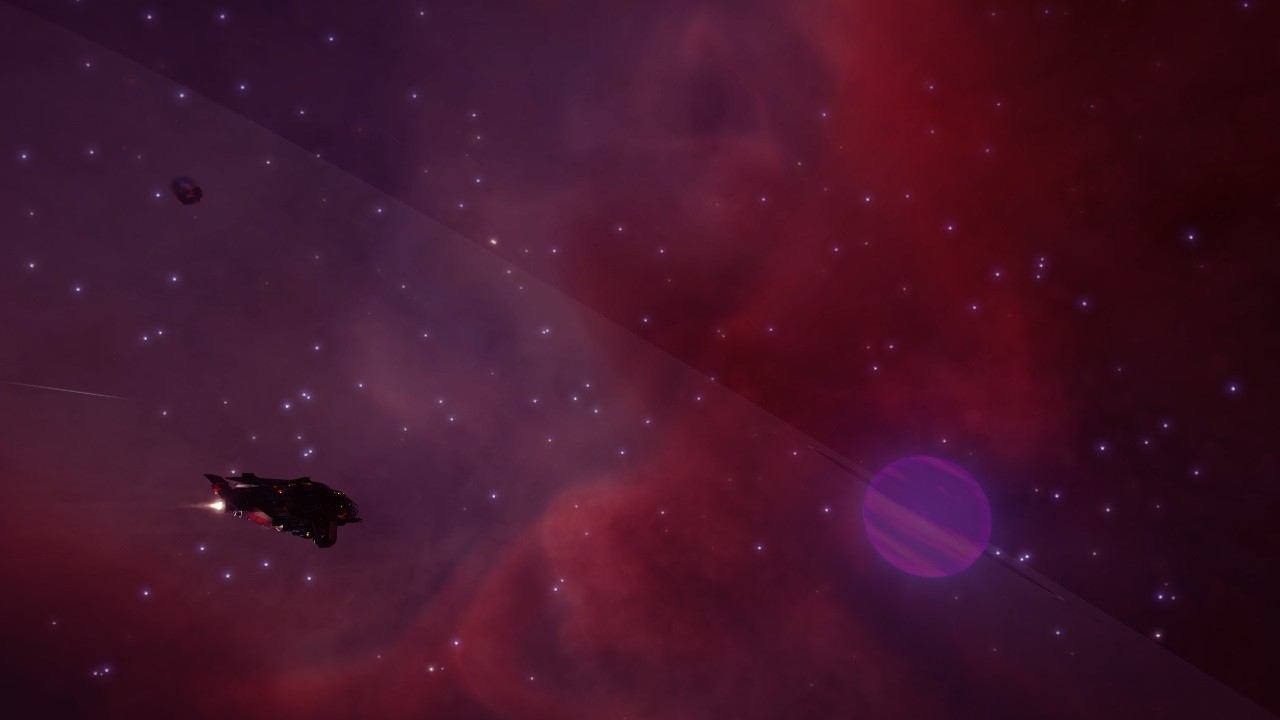
My last stop before the meeting point of Polo Harbour is the Bullet Nebula, more than two thousand eight hundred light years away. I programmed the nav computer to take profit of any neutron stars nearby and, on the way, I discovered a system with a neutron star. I have seen tens of neutron stars on this trip and I usually use them to boost my Frame Shift Drive, a damn dangerous maneuver, but I have never discovered one. Well, Byaa Ain CR-T d4-857 will have my name tagged. I have heard that the Galactic Mapping Project Initiative gives you a badge for this.
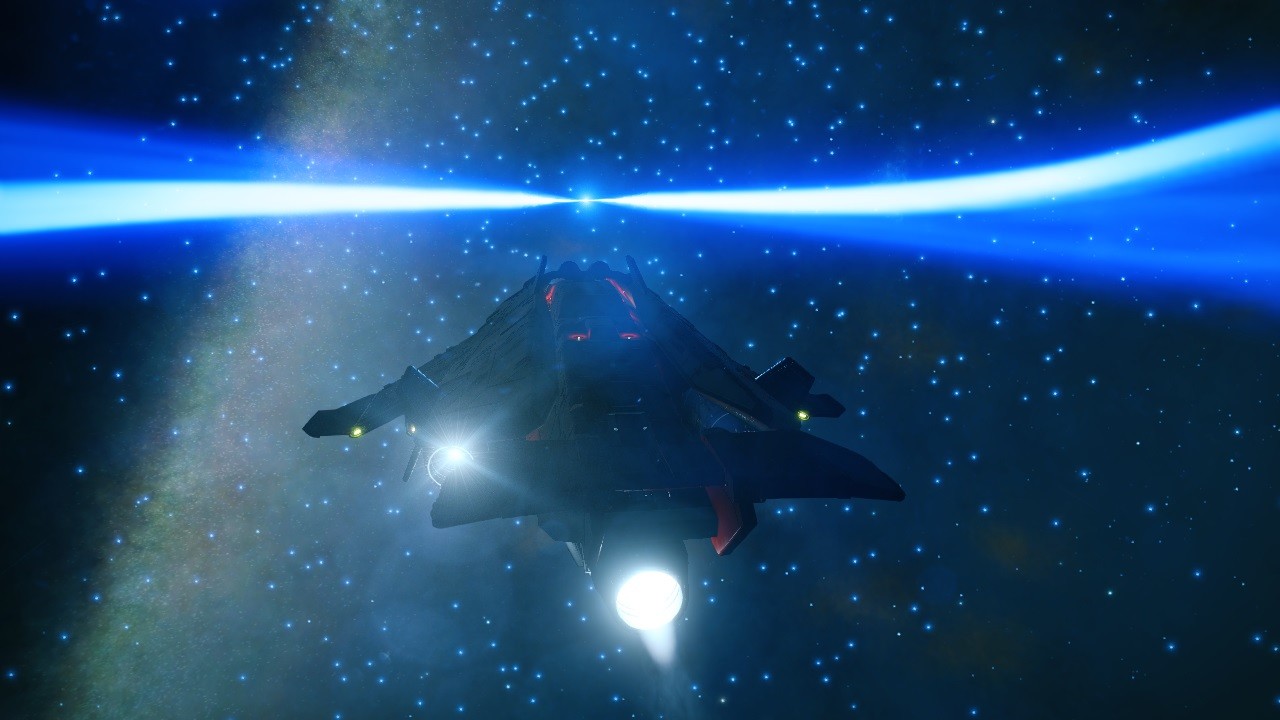
I guess I have pushed too much the Frame Shift Drive overcharging it surfing the jet of neutron stars. I notices that it was bellow eighty percent integrity when I left the Crayfish Nebula, and I hoped that it will resist until I arrive to Polo Harbour for repairs, but it has started to fail. I had to use the Auto Field-Maintenance Unit and do some reparations in space. I have never done it before, and I did not like the idea of switching off the Frame Shift Drive in space, but it was failing too much. I dropped out of supercruise close to the primary star of Byaa Ain TV-H b28-20. I thought that like these it would be easier for a rescue party to find me in case of troubles, and I proceeded with the repairs. Everything went well. These AFMUs are an incredible technology. I wonder how space exploration was before them. I am glad I decided to equip one of them before departing the Bubble.
Some hours later I arrived to system Eor Aoscs VM-W d1-683, from where there is a great view of the tiny Bullet Nebula, that looks like a bullet ripping through space.
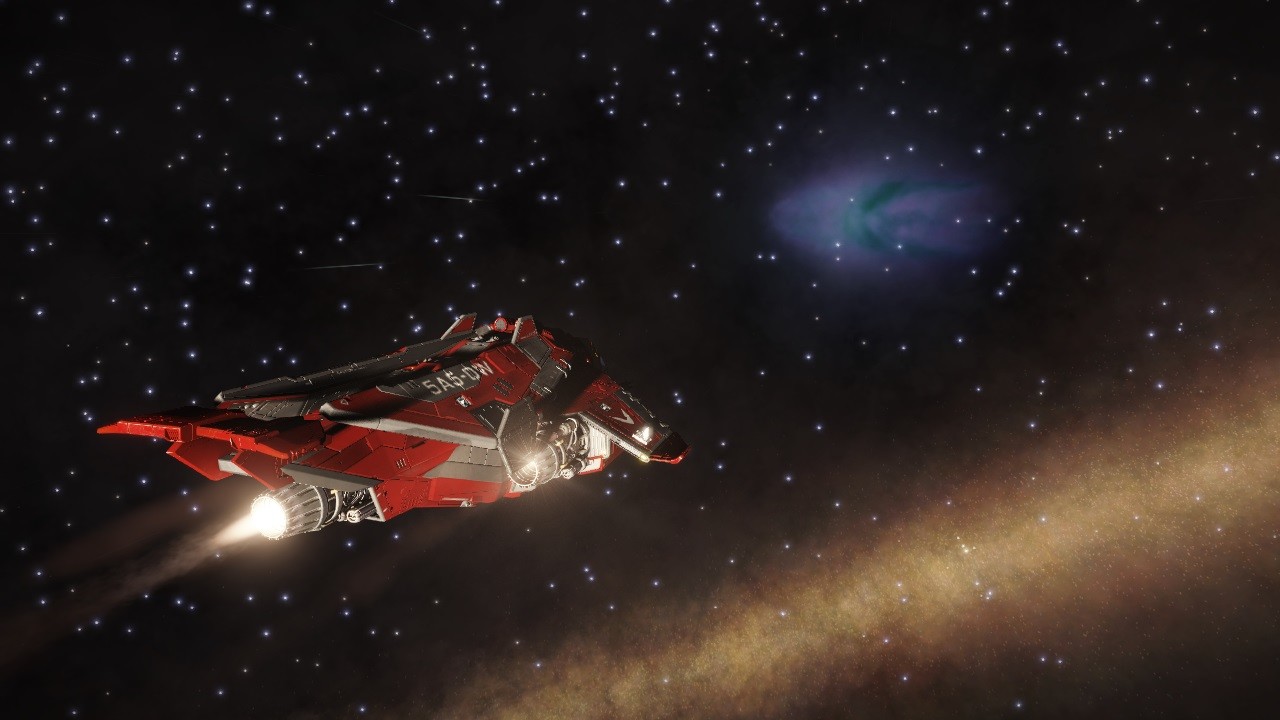
I enjoyed the view for some minutes and changed course for Polo Harbour, one of the Colonia Connection Highway outposts and basecamp of this stage of the route. On this occasion I arrived two days before the releasing of the next waypoint. This will be the last human outpost in while. From now on the expedition will be harder. Looking at the heavy traffic and the activity at the harbor, I can tell that many commanders have think like me and are trying to enjoy as much as the services of a fully doted space port as possible before heading to galactic core. There is word in the bars that several members of the expedition had taken the chance to visit Colonia too, being it less than five thousand light years from here. I would love to visit the place one day and have a drink at the legendary Jacques Station, but I think I will rest here for the time remaining.
This is Commander Jav Marlo, registering this log in Polo Harbour in system (Boewnst KS-S c20-959). I have just collected fifty eight million credits from Universal Cartographics for my exploration data. I also have confirmed that the neutron star I found will have my name tagged.
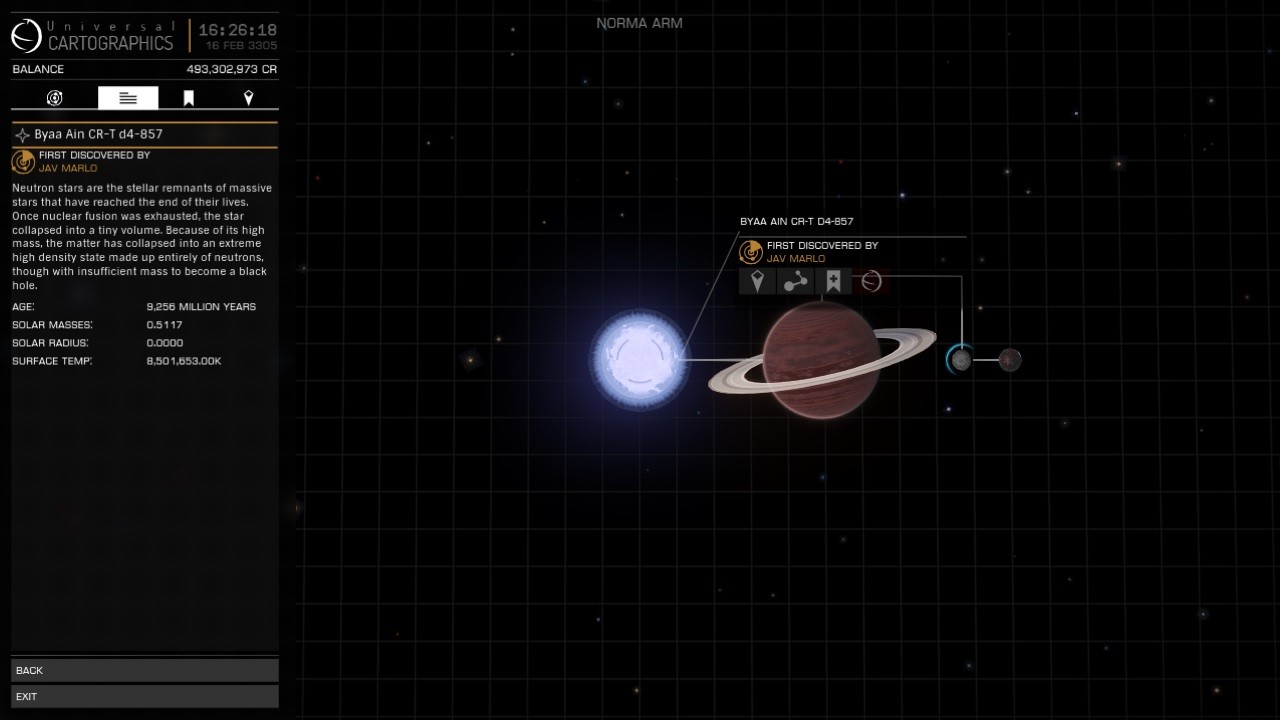
I am heading to the nearest canteen to celebrate. I hope to find more fellow commanders from Distant Worlds 2. The first round is on me.
Jav Marlo signing out.
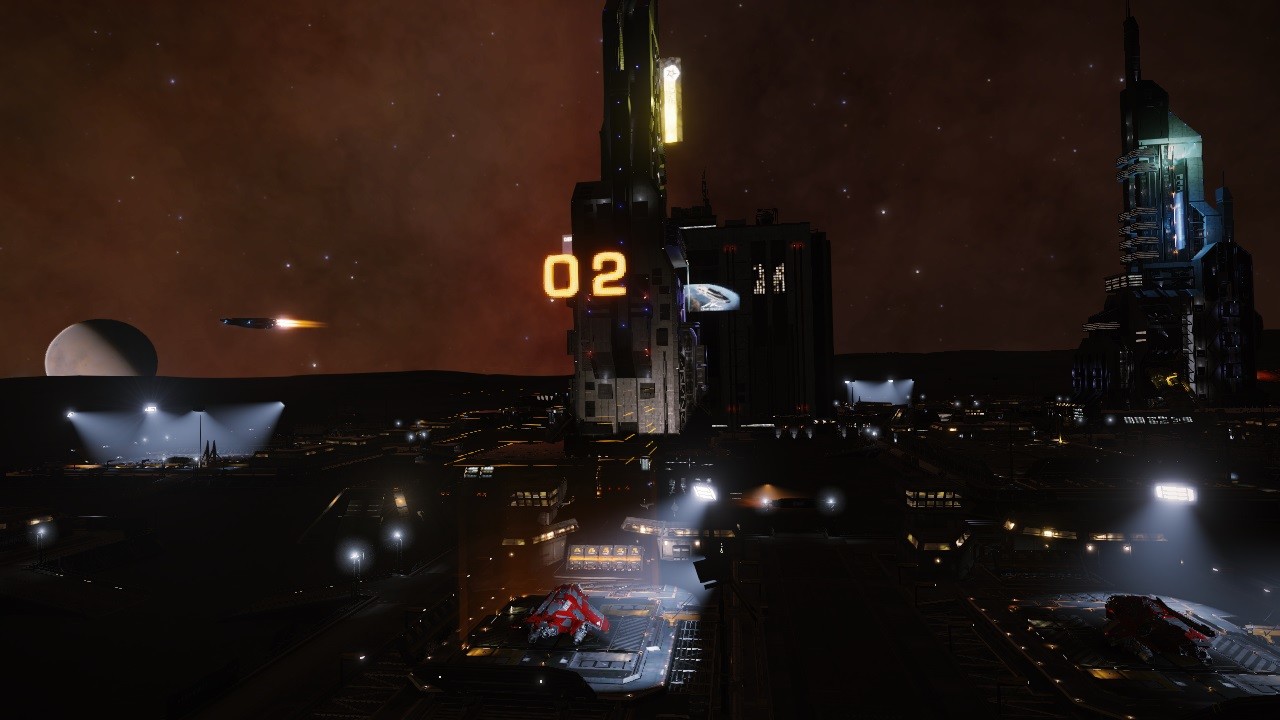
24 DISTANT WORLDS 2 (PART 6) – REFLEXIONS ON SALOMÉ AND THE CHILDREN OF RAXXLA
11 FEB 3305 Shepard Shallows (Clooku EW-Y C3-197)
This is commander Jav Marlo, recording this log onboard the Hyperion, on route to the Rusty Net Nebula in system Skaude AL-X e1-28.
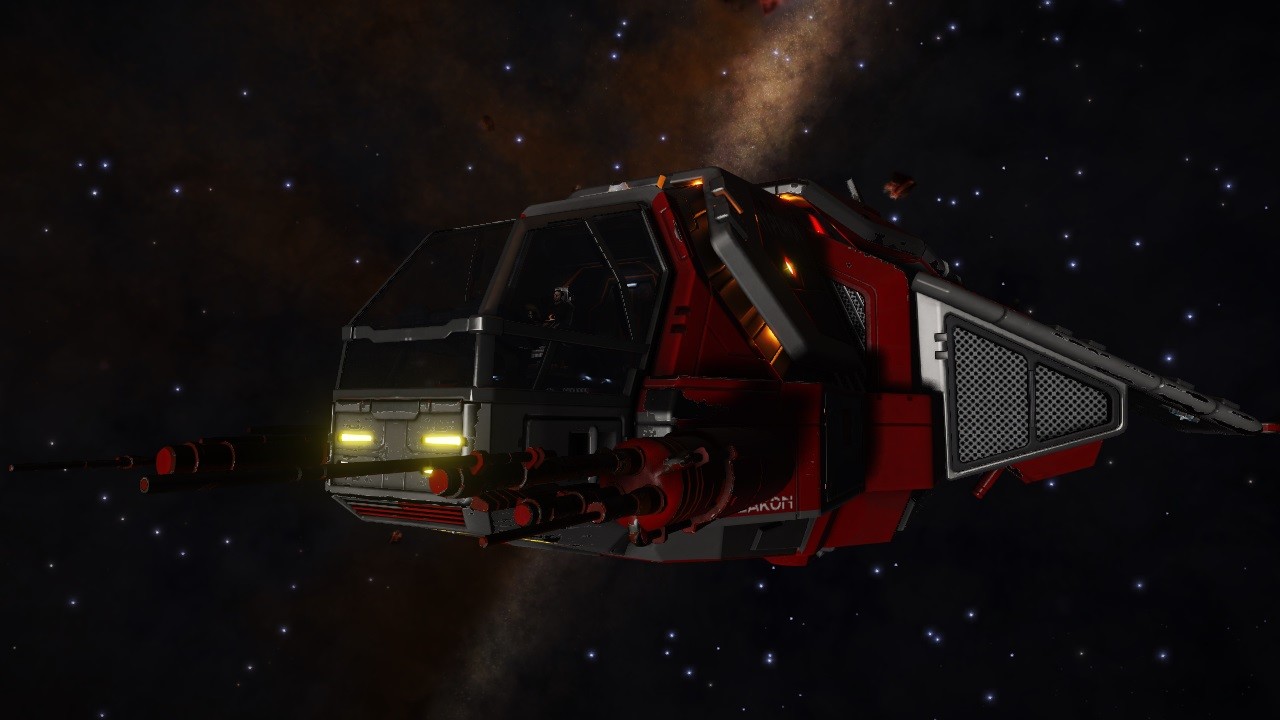
I have been surfing the GalNet News database for the last hours looking for information about the Conflux Delta Site. The extracts of the registers of the settlement still haunt my mind. According to the logs, it seems that some ship was launched on a secret mission thirty five years ago. That was before the actual Frame Shift Drive technology, so it must have taken them several months to come this far from the Bubble. That was a very risky enterprise on that time. They had problems with their hyperdrive. Somehow they arrived to system PRU AESCS NC-M D7-192 and the massive gravity of the neutron star there pulled them in and cooked their ship. They jettisoned their logs and I presume that the survivors built the Conflux Delta Site. They probably were responsible too for deploying the unregistered comms beacon I saw on the system. Its purpose was probably to inform about the demise of the expedition and the position of the campsite, but its message was cyphered. How much secret a mission can be to cypher a SOS beacon? Or maybe it was not a SOS beacon.
This is what I have find the GalNet News database of my ship so far: In NOV 3302, the Federal astrocartography department issued a public request for exploration data. They were looking for information regarding the configurations of systems in a radius of two hundred light years of three very specific points in Hawkin’s Gap, the Conflux and the Formidine Rift regions. One of this systems was PRU AESCS DL-W C15-37, which is very close to PRU AESCS NC-M D7-192. The Tau Ceti Crimson Legal Solutions volunteered to coordinate the Federal Operation. Meanwhile, the mysterious organization known as The Children of Raaxxla issued an identical request claiming the data will be used to prove the innocence of their leader, Kahina Loren, also known as Salomé.
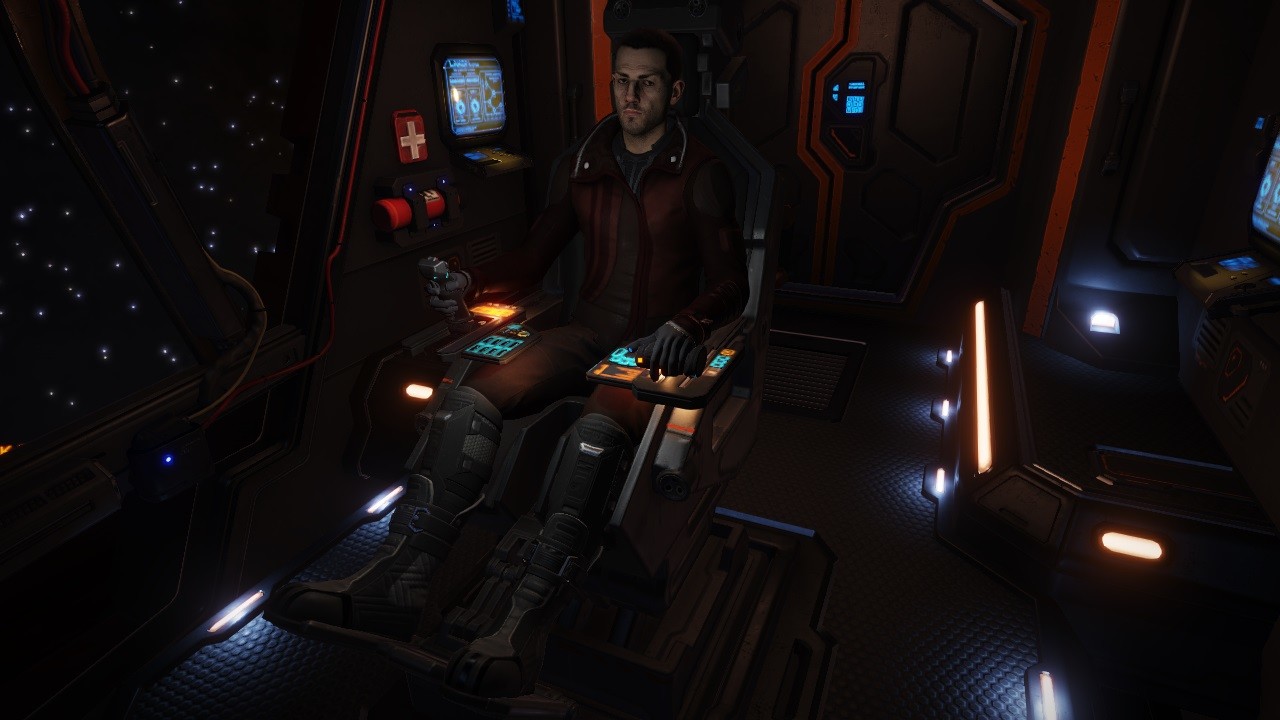
That was it! Salomé again. I cannot keep her out of my mind since I first heard how they talked about her in Darnielle’s Progress. And then again the miners of Hind Mine told me a hundred times about the mission that lead to her utterly death and how thousands of commanders rallied to try to protect her. Such a religious devotion. In every place, when someone talked about her I could read in their eyes that they will be willing to die for her.
I have been looking for information too about the Children of Raxxla in the GalNet News database. It seems that most of the independent pilots sided with the Children and delivered large quantities of astronomical data to their base of Sereborv Terminal. The Federation was not very happy about the disarray of their exploration programme and accused the Children of manipulating the galactic community. The Empire went further and accused the Children of being criminals and proposed that they should be deal with.
Some weeks later a spokesperson of the Children of Raxxla released some information based on the exploration data about a massive undertaking comprising a fleet deployed to install a series of beacons in the regions of Hawkin’s Gap, the Conflux and the Formidine Rift. They said that Salomé knew about the importance of these sectors. The mission was called “The Dinasty Project”.
A year later, a group of the Tionisla system that call themselves the Hamsters said that they have found a hidden message in one of the beacon modulator wave harmonics, adding even more confusion to the whole issue.
The message was a rhyme:
The river to the underworld
Gaia’s daughter all unfurled
Fourth minor bear in vain
By viper’s sting was slain
Also known as Nemesis
The doom of Chimera
She is tasked with soothing pain
Suckling Odysseus from afar
Mother of the mother of
Leader of the Titans
He transformed into a hawk
A daughter of Daedalion’s
The piercer was how he was known
Mother of Ulysses
Ruler of the winds
God of night, primordial flees
Zeus’ namesake now lies in Sol
Achilles’ favoured horse
Women of vengeance infernal
The vain queen rides not forth
A final word, a course to follow, a poor miser’s sum
If you would understand it all, seek Fibonacci’s Zephyrum
A combined effort of the Hamsters and The Children of Raxxla was able to decode this message that pointed to the Syreadiae JX-F c0 system in the so-called Formidine Rift. Travelling to the system, pilots discovered a huge bulk cruiser called the Zurara. The ship’s logs painted a haunting picture, indicating that the ship’s crew sabotaged the vessel before killing themselves. The Zurara had been adrift in the system ever since. I have to go there when I return and see it by myself.
Days after the discovery of the Zurara Salomé was killed and became even more legendary.
I was so distracted with the story of the Conflux Delta Site that I almost crash with the neutron star in the middle of the Rusty Net Nebula. That would have been quite ironic, after knowing what happened to them.
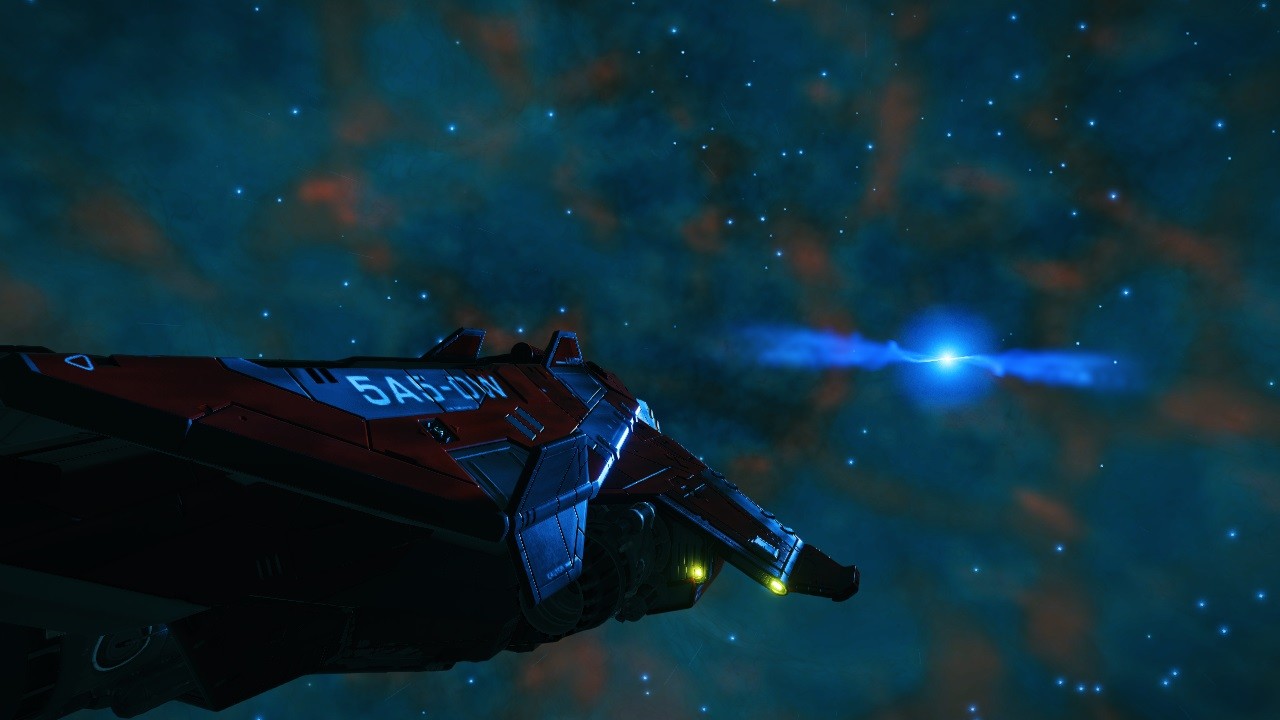
Resuming log. The Rusty Net Nebula is created by a neutron star in system Skaude AL-X e1-28, very close to the Colonia Connection Highway. It is very visually striking due to the deep red stellar remnant that gives it its name. Along with the neutron star there is a G class secondary with two life bearing waterworlds and two rocky terraformables.
I surfed the neutron star for a boost and headed to the Fish Eye Nebula in system Flyiedgai ST-R e4-8, a slight detour before going to Sacaqawea Space Port.
On the way, I continued exploring every system while searching in the GalNet News database for information about the Zurara. It seems that, in April 3303, a similar starship called the Lycaor was found in the Alaunus system. The article says that before the development of faster-than-light travel, colonizing distant star systems depended on vast interstellar arks known as generation ships. There are believed to be more than seventy thousand of these ships in the galaxy, the location of many of which is not known. Tragically, after accessing the Lycaor’s medical logs it appears that the crew was killed by an unidentified pathogen many centuries ago. Another expedition with a creepy end!
Regarding the Dinasty Project, I could not find many more information in the GalNet News database. I will have to dig deeper when I land in any station. But I found two very interesting entries in the Codex. The first one was about the legend of Raxxla. There is no consensus about what Raxxla is, it has been suggested that it could be a planet, an unremarkable moon or just a state of cosmic enlightenment. The legends on Raxxla even mentions an alien artifact, the Omphalos Rift, that is described as a gateway through which parallel universes could be accessed. The only clear thing is that the legend of Raxxla has lured adventurers and treasure seekers for centuries, and generates all kind of conspiracy theories.
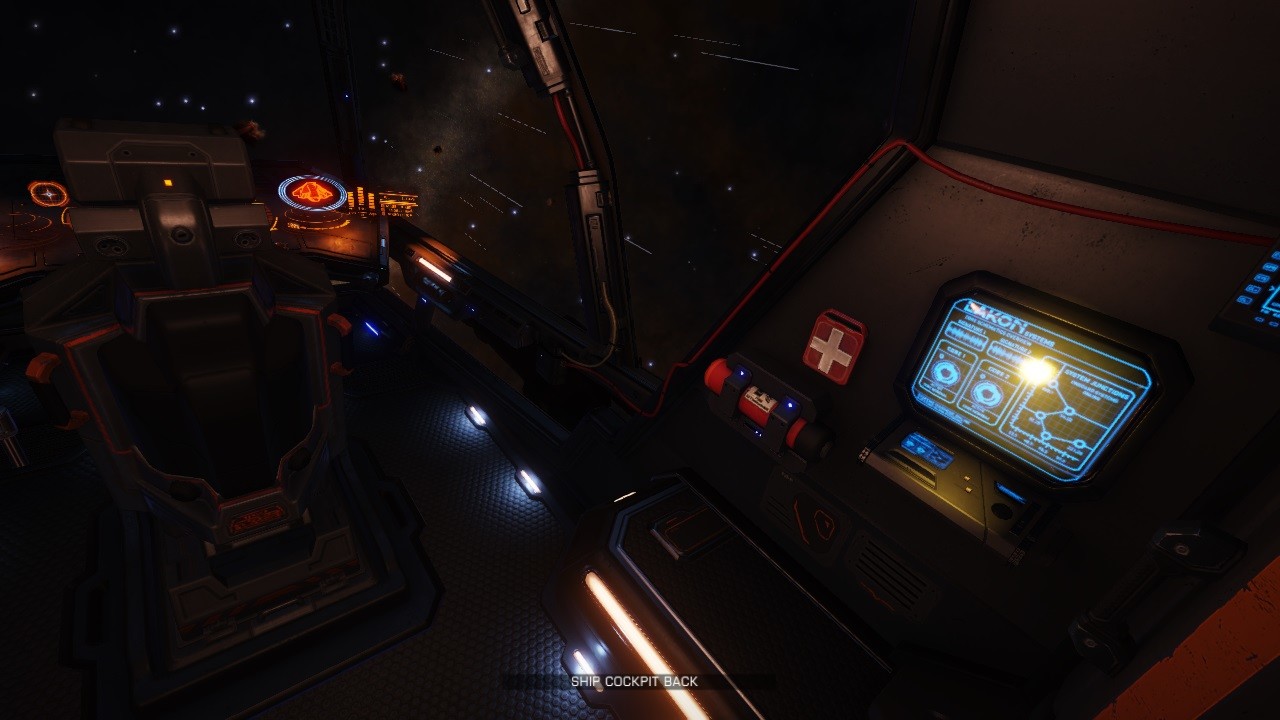
The second entry was more unsettling. It talked about a mythical group of adventurers, explorers, investigators and treasure hunters which existence has never been corroborated and that are somehow connected to the legend of Raxxla. They are known as the Dark Wheel, because it is believed that they operate from a station which toroid is kept with minimal power output, hence dark, to avoid detection, from there their name, but this place has never been found. The entry also says that there is a group by the name of the Dark Wheel in the Shinrarta Dezhra, but it is not clear if they are real or just opportunistic imitators. Anyway, Shinrarta Dezhra is just accessible for Elite pilots and out of my reach.
Conspiracies, mysteries and misinformation. Nothing of this answers my questions.
Who were the people that participated in this so called Dinasty Project? What was their mission? Why so much secrecy? And the most important, why Erimus Kamzel and Dr. Kaii had chosen the Conflux Delta Site as the campsite for the expedition? What was the point of luring so many commanders there? Was that casual, or they wanted to expose something? We have been jumping from nebula to nebula, like the old time explorers and, suddenly, they ask us to camp in a place with such a dark story.
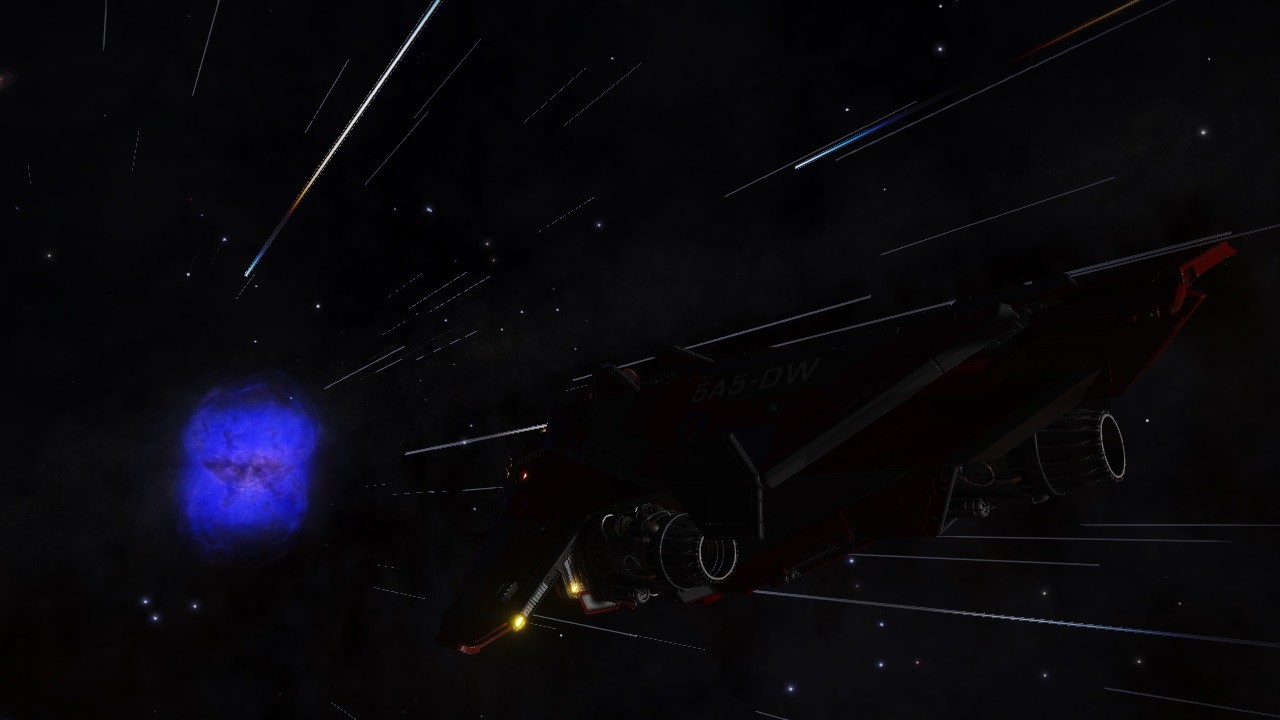
I feel like if my head is going to explode. I need to rest. I am close to the Fish Eye Nebula but, wait, I have seen a landable high metal content world with 0.7 gravity here, in system Skaude AS-Y C2-40. That would be perfect.
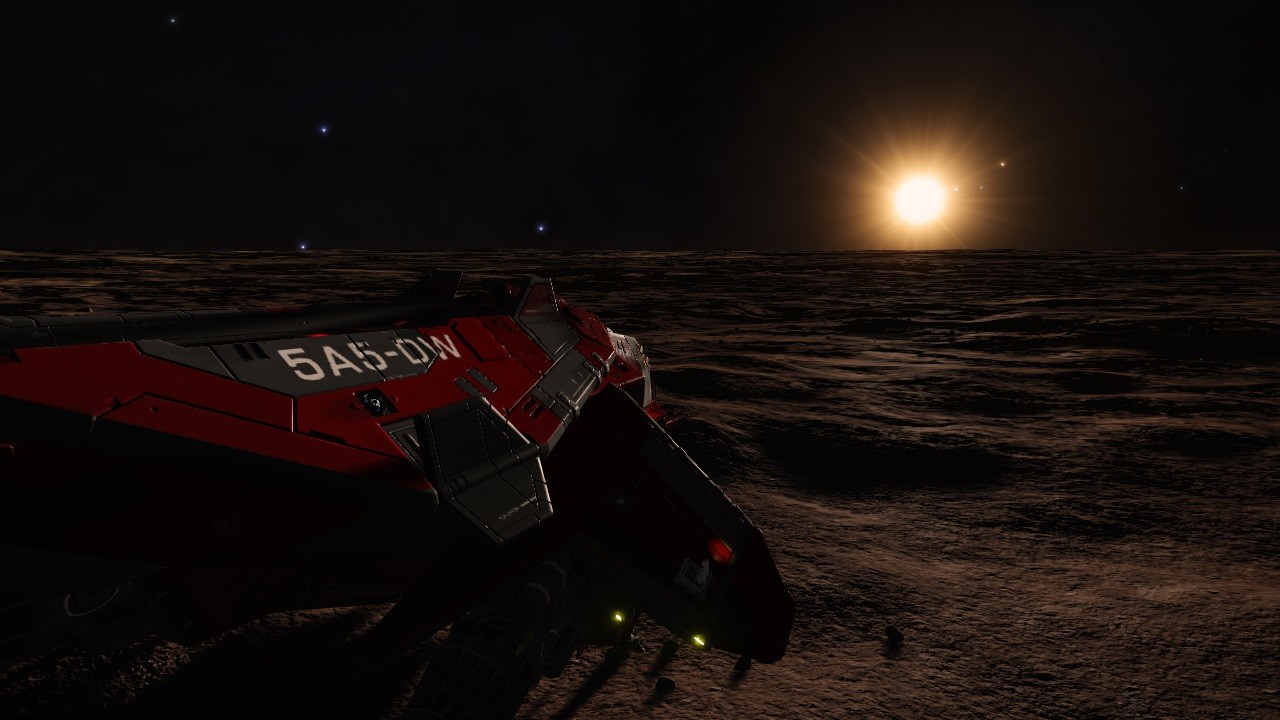
Resuming log. The Fish Eye Nebula is the apparent remnant of a supernova; all bodies inside the nebula are only two hundred fify six million years old. The nebula contains a neutron star, two main-sequence stars, and a host of smaller bodies. A waterworld, with life, can be found in orbit between the two stars and is unusual given the young age of the system.

I took profit of the boost provided by the neutron star and headed for the nearby Flyiedgai Nebula.
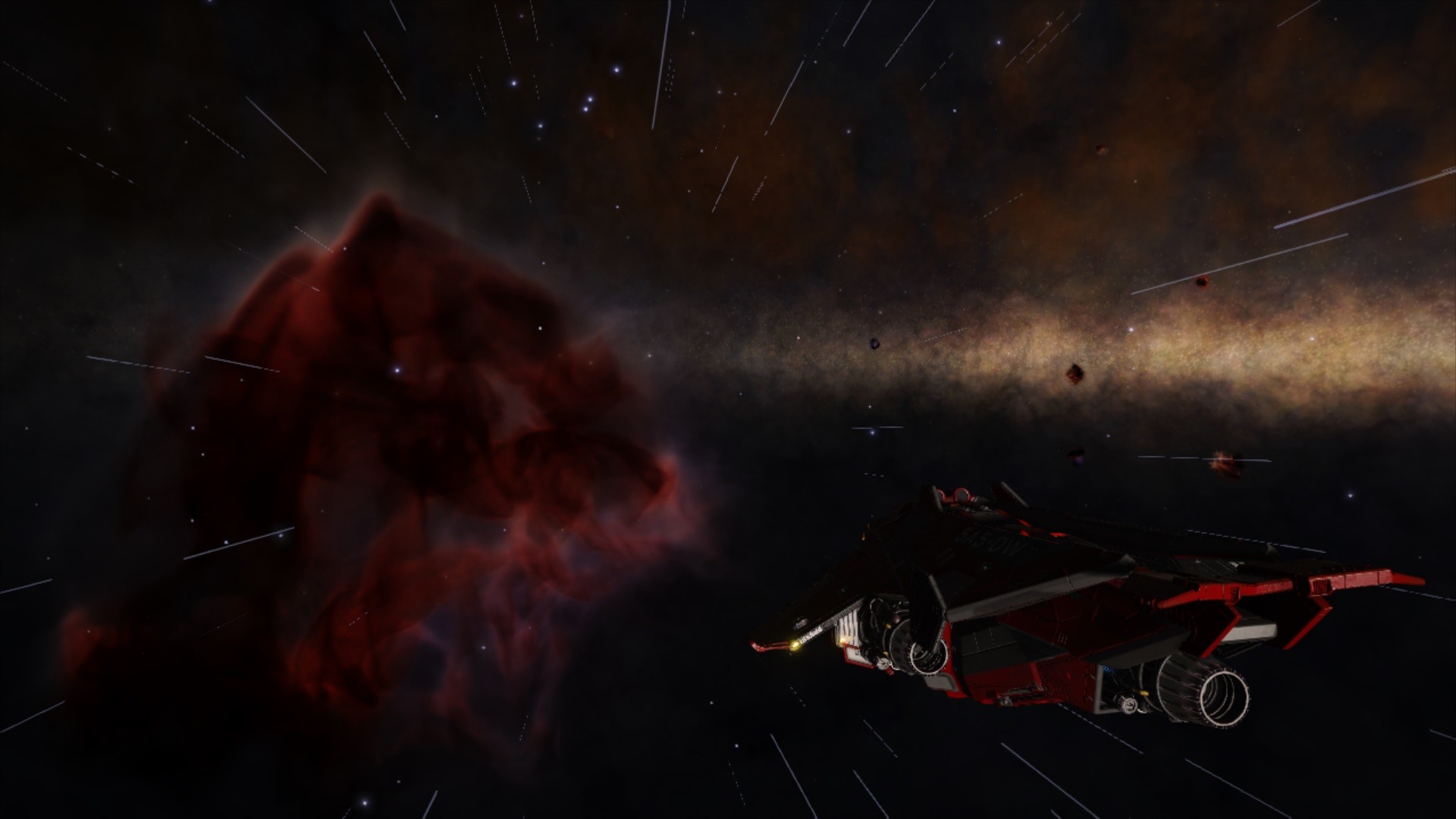
On the way, I searched about the Conflux Delta Site in the Galactic Mapping Project database in hope that it contained more information than that revealed in the GalNet News. It said that the unregistered comms beacon I found was part of a net of several navigational beacons in the regions of Hawkin’s Gap, the Conflux and the Formidine Rift set to provide the planetary location of several settlements. These settlements turned out to be staging posts for the mysterious Dinasty Expedition that had traversed the location three decades earlier and had set up bases there. Well, at last some concrete information about the sites! The database provides too the location of the other sites. I took mental note to visit them when able. I want to hear what it is in their logs. And, furthermore, the Galactic Mapping Project database said also who was the spokesperson of the secretive Children of Raxxla, a commander by the name Alesia Verdi. I took mental note of that name too.
The Flyiedgai Nebula in system Flyiedgai UL-C d13-41 is small, but turned out to be a mesmerizing place with its pink and red halo and four stars. Two of them orbit very close one to the other and cast a beautiful light on the nebula that I found very soothing.
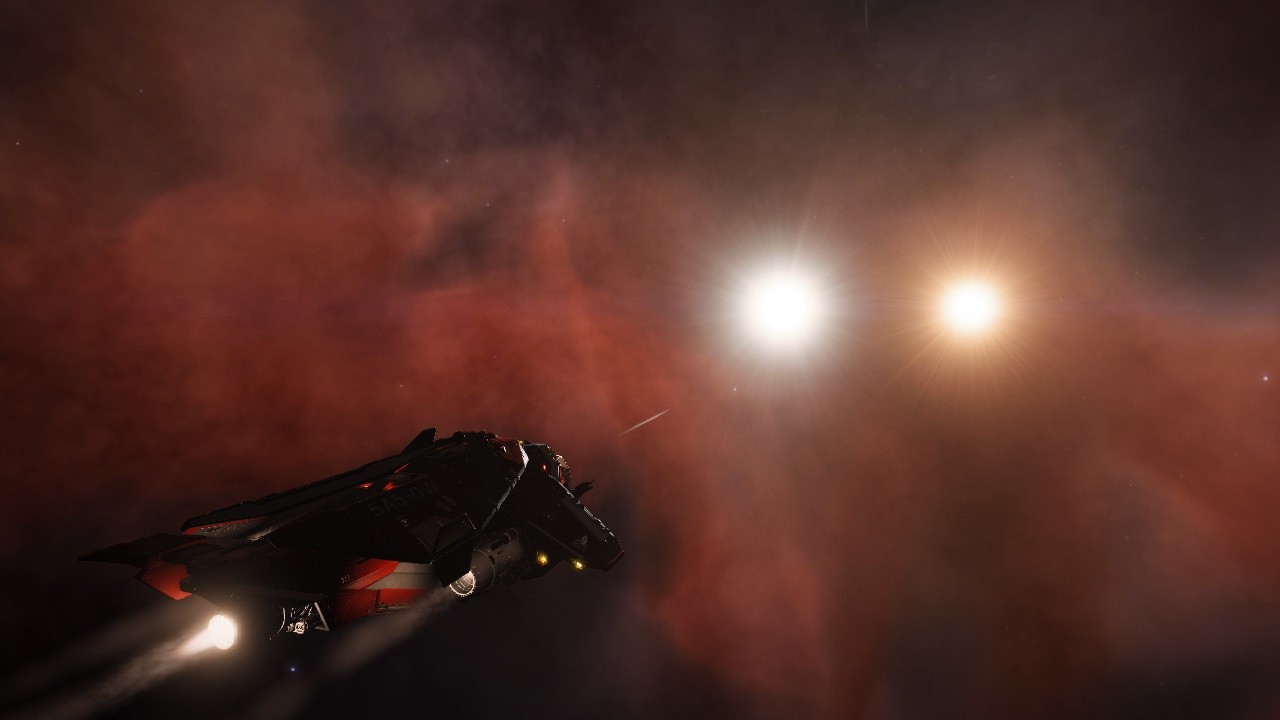
My next destination was the nebula known as Ellaisms Remnant. It was quite a trip because I use to explore in deep every system I jump. While I was flying from one body to another in order to map them I read everything that was in GalNet News database about Salomé. From the conflict of the Prism system, that nearly caused a war between the Empire and the Federation, to her posterior reclamation of her rights as a senator. After that moment, she gained constant presence in the news. I read about all her diplomatic voyages. All the perils she faced on that trips and how, even then, commanders of all kind of allegiances offered to follow and protect her in all her endeavors. She inspired loyalty, and her popularity and presence in the news matched that of princess Aisling Duval herself. She was Lady Kahina Tijani Loren then, an imperial senator. It is said that she escaped a hardened gang of freedom fighters and faced down a notorious pirate lord. It is also said that she colluded with these terrorists to murder her family so she could become a senator. I also read about rumors of her slaughtering her mentor, and that she did that with a sword, for more details. Many sworn her loyalty, particularly those disaffected by the politics of powers of the core worlds; while these same powers accused her of being bloodthirsty, selfish and a manipulative individual who will stop at nothing to achieve her goals, whatever they were. There are some pictures of her too. Well, she was beautiful and charismatic, that is for sure.
I was reading about all this life of turmoil when I reached a system, Skaudai OE-T c6-13, with an Earth like world. It was very tiny, just one quarter the size of Earth, but it was close to the Colonia Connection Highway, so a suitable candidate for future colonization, thus I took a closer look.
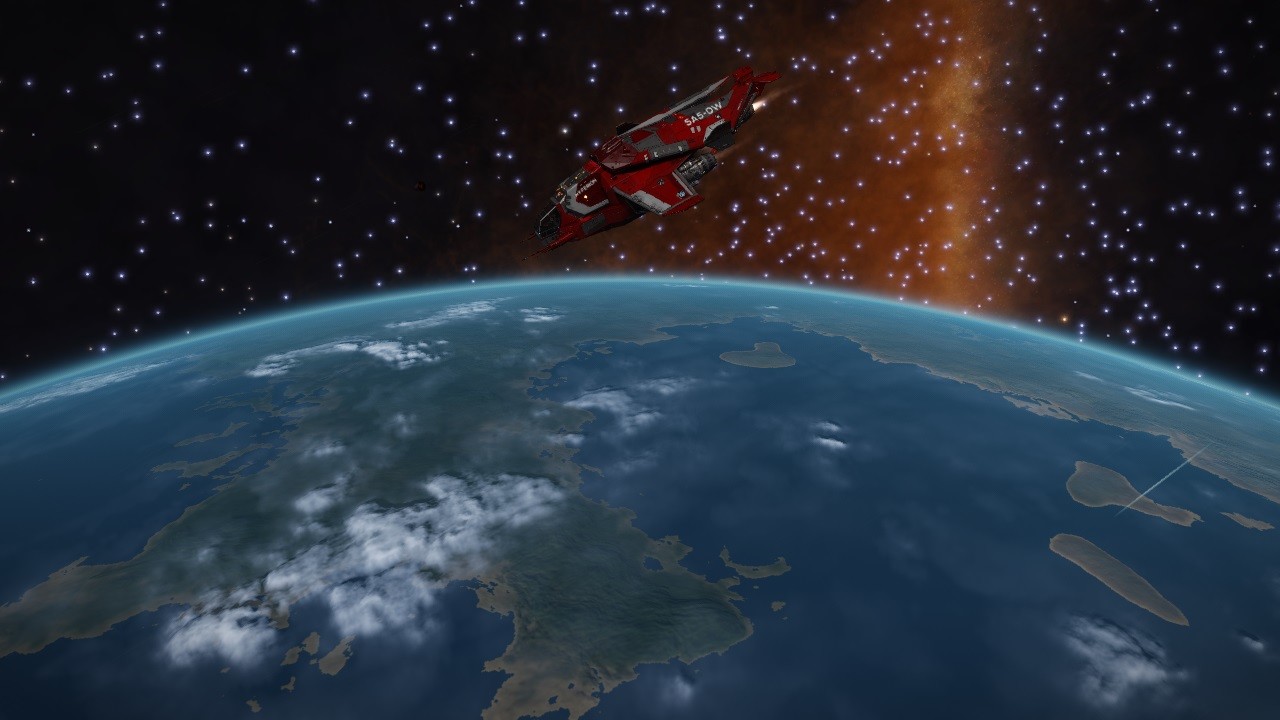
I needed a rest, so I decided to stop at the first opportunity. A couple of jumps later I arrived to system Skaudai RP-R c7-9, where I found a tiny rocky body with a tenth of the gravity of Earth and lots of volcanic activity. I landed on a field of fumaroles. Time to sleep.
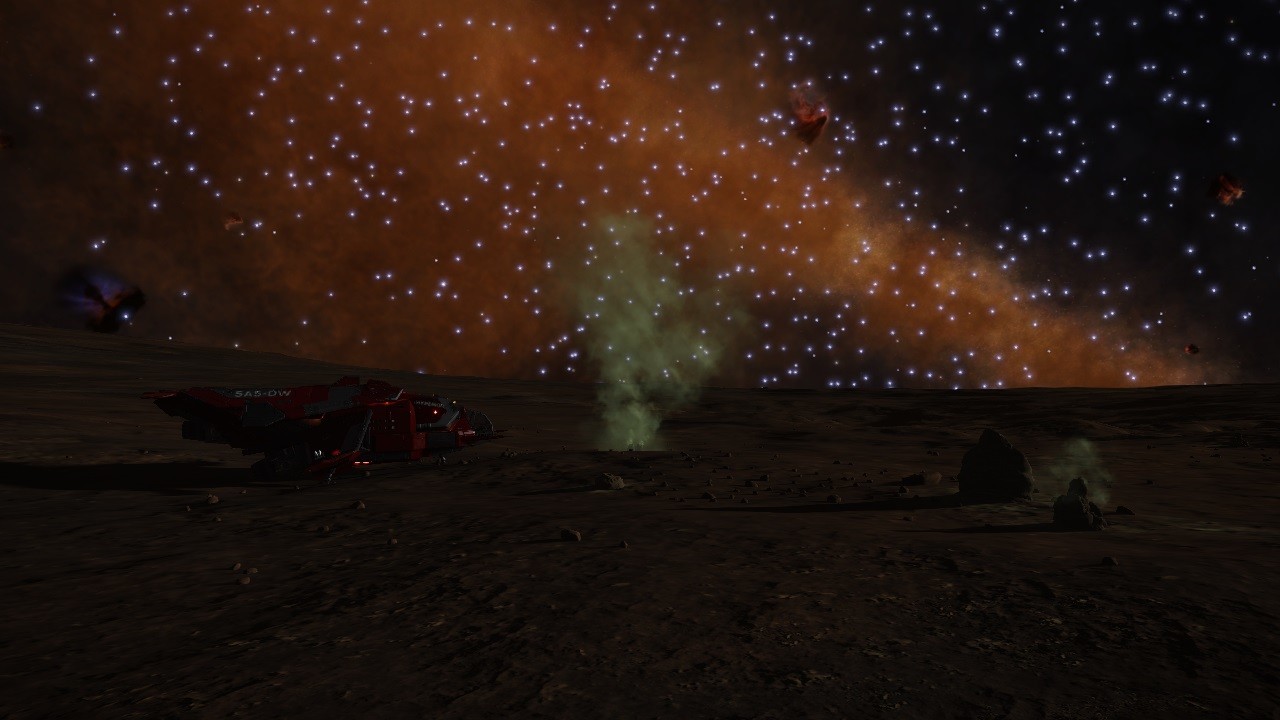
Resuming log. Back on track to Ellaisms Remnant. Almost there. I read in the Galactic Mapping Project database that it is a typical double-lobed blue planetary nebula surrounding a neutron star that was the result of a supernova approximately two hundred ninety six million years ago. The fourth planet is waterworld, so life has managed to survive through this cataclysm.
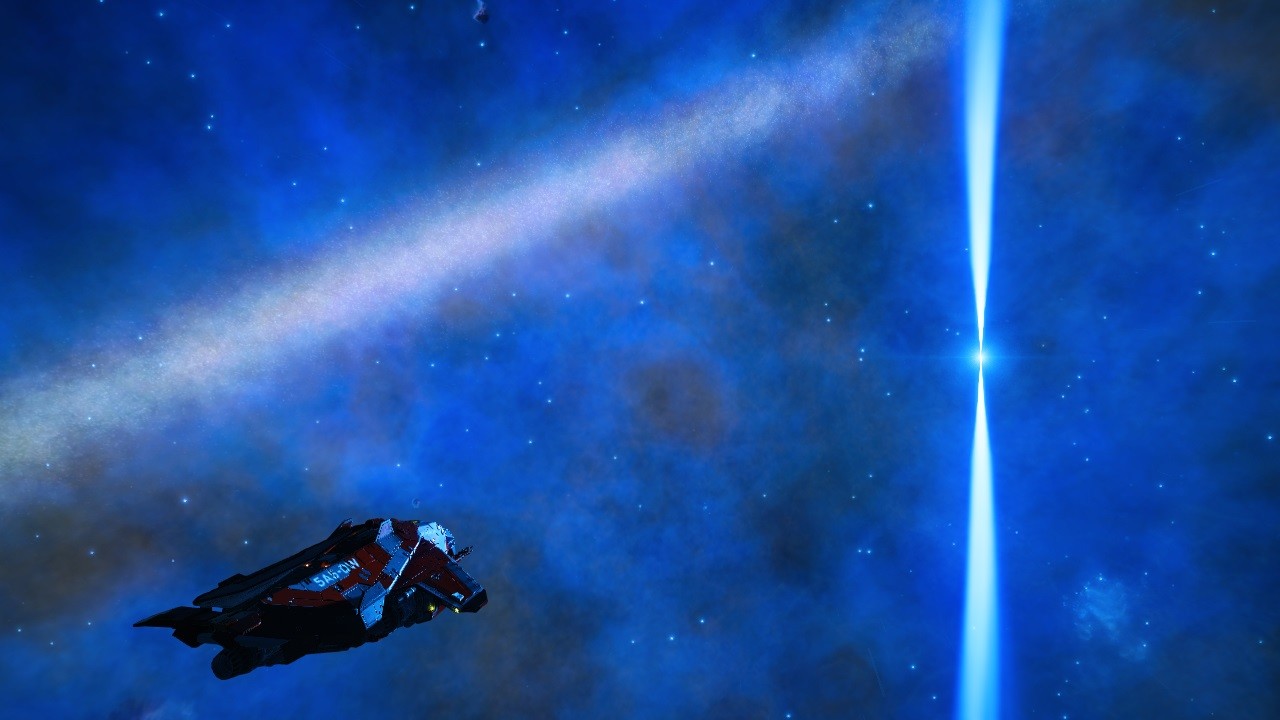
I can see in the scanner that the waterworld is ringed. I have never seen one like this, so I approach to take a closer look.
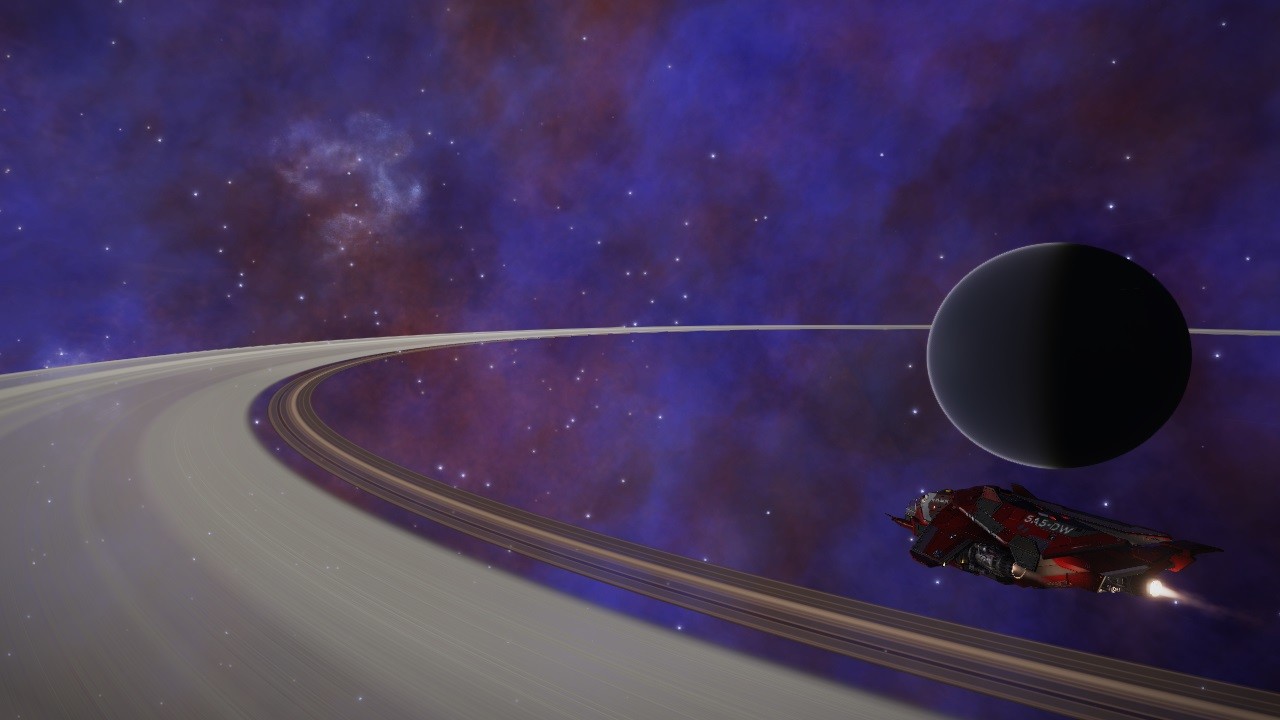
My next destination is known as The Collection of Wonders. Catchy name! I resume course and soon I find another treasure. It seems that system Skaude IO-H c26-13 contains several high metal content worlds, most of them landable, a waterworld, an Earth like world and an icy body with a pristine ring; all of them orbiting a white-yellow scoopable star. What a prize! I guess that the exploration of this system is going to make me a lot of money. As usual, I do a close reconnaissance flight around the ELW.
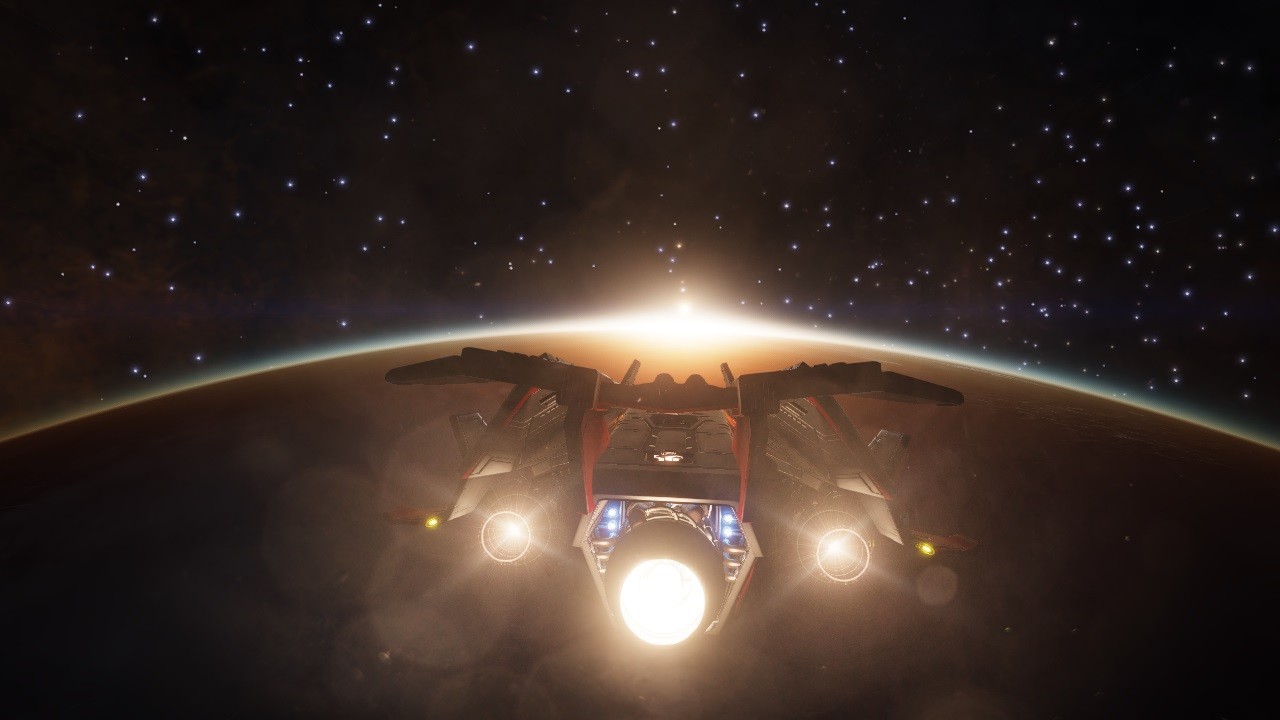
I am back on course to the Collection of Wonders in system Skaude AA-A h294 and back too to the GalNet News database looking for more clues about Salomé and The Children of Raxxla.
That it is! I think I have found something. The connection I was seeking. GalNet News says that Lady Kahina Tijani Loren disappeared for several months in 3302 to reappear on the other side of the galaxy “as if she were the patron saint of explorers”. That is how they say that. And, most important, this was during the original Distant Worlds Expedition. She referred to herself as Commander Salomé She even sent a transmission congratulating commanders Erimus Kamzel and Dr. Kaii for their achievement in leading such a colossal task. This confirms that she was there the first time! But, what is exactly her relation with commanders Erimus Kamzel and Dr. Kaii?
After that, her name, Salomé, was linked to several revolutionary organisations, including the Children of Raxxla, the Phoenix Group, the Dark Wheel and the Emperor’s Dawn. Soon it was revealed that she was indeed Lady Kahina Tijani Loren. At that time, her ship was attacked by unknown forces in the imperial Cemiess system and Salomé was presumably hijacked. Her last message was a call for the Children of Raxxla to be informed about the attack. In that message she claimed too that she had sensible information about the Rift, Hawkin's Gap and the Conflux, and that something in this regions was connected with the strange happenings in the Pleiades. I guess that the happenings in the Pleiades are referred to the appearance of the unknown artifacts that preceded the Thargoid invasion. Now we have the Thargoids as part of this mystery too!
And talking about the Thargoids, I do not feel comfortable at all about the idea of thousands of combat able commander leaving the Bubble precisely when it is being attacked by an alien invasion. Just for the record.
The Children of Raxxla, a very obscure organization on that time, became very notorious suddenly. The motive, according to GalNet, is that they tried to destabilize the imperial system of Cemiess in order to force the authorities to reveal the whereabouts of Salomé after the attack on her ship and posterior hijacking. One month later, the attempted assassination of Admiral Denton Patreus occurred and Salomé was accused of promoting it. That is very odd!
I think that is the point that marks the beginning of her demise. Stripped of her rank, she was submitted to a farce of a trial and found, of course, guilty. She had motives to want Patreus death, after all he took control over Prism system without her permission once the conflict with The Reclamists was ended. The sentence was life imprisonment at Koontz Asylum in the Daibo system. A death sentence in fact, as no one has ever returned from there.
The Children of Raxxla response to the verdict was attacking senator Patreus flagship. The attack did not serve to free Salomé, but it was a blow to Admiral Patreus's ambitions to strengthen the Imperial fleet, exposing the battleships vulnerability to attacks from well organised independent forces. Some weeks before, admiral Patreus had declared his intention of building as many capital ships as possible. That caused the abolishing of the London Treaty, the agreement signed in 3302 by the Federation, the Empire and the Alliance to limit the tonnage for capital ships in each of their fleets that was meant for preventing an uncontrolled arms race.
Anyhow, as a result of all this actions the Children of Raxxla were marked as a terrorist organization. And that is when they made their request for exploration data of the systems in Hawkin’s Gap, the Conflux and the Formidine Rift regions, conflicting with the goals of the Federal astrocartography department and thus angering the Federation too. The Children claimed it was to prove the innocence of the group’s leader, Kahina Loren. The circle closes. They claimed that Salomé was their leader.
And that brings again to my mind the same questions: Why Erimus Kamzel and Dr. Kaii, who clearly have some relation with Salomé, chose the Conflux Delta site as campsite of the expedition? Was it by chance? Is this just a Journey of Discovery? Or are thousands of commanders being lured through the whole galaxy with a more hidden purpose?
Sunk in those dark thoughts I arrive to system Skaude AA-A h294 where I discover it is truly a Collection of Wonders. First of all, it contains two black holes. Second, it contains too a ringed M-class star, a ringed white dwarf, and a ringed neutron star. According to the Galactic Mapping Project database, the M-class star is one of the largest known stellar bodies containing a ring system, and a tourist beacon marks the best place to behold it.
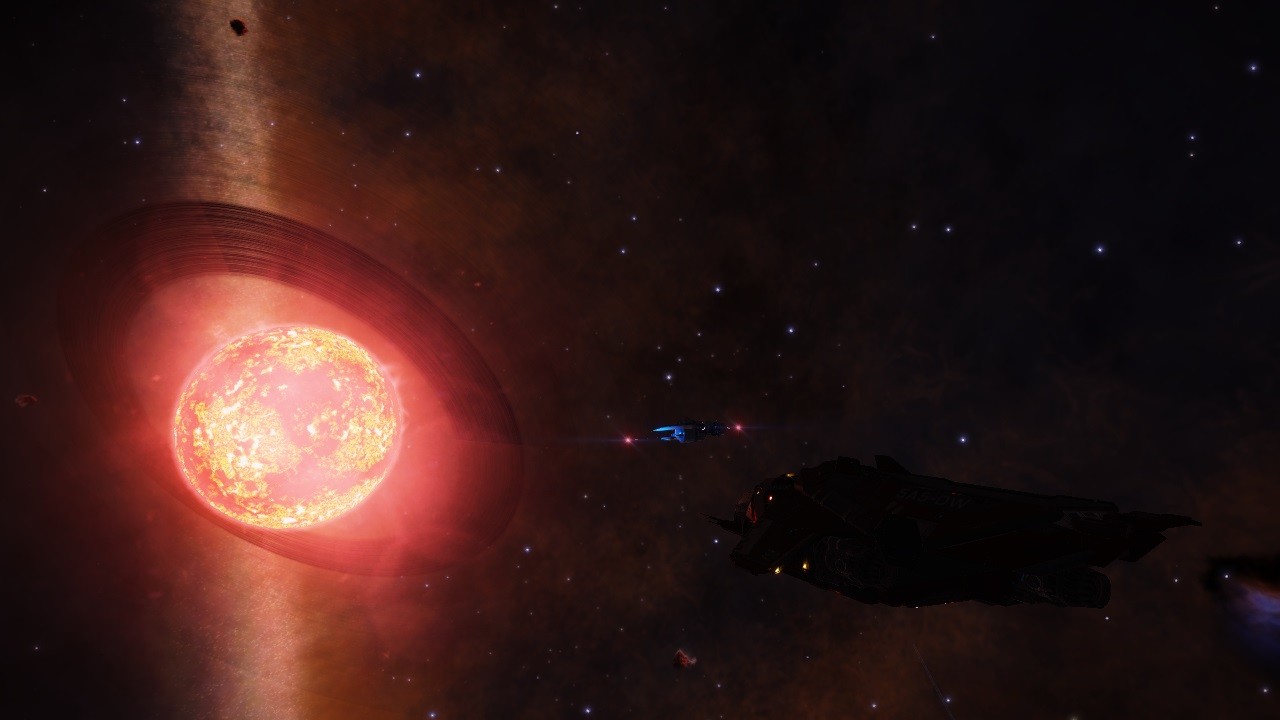
The ringed neutron star was worth a visit too. With its massive gravity, the neutron star has created a huge ring of asteroids, the biggest I have ever seen.
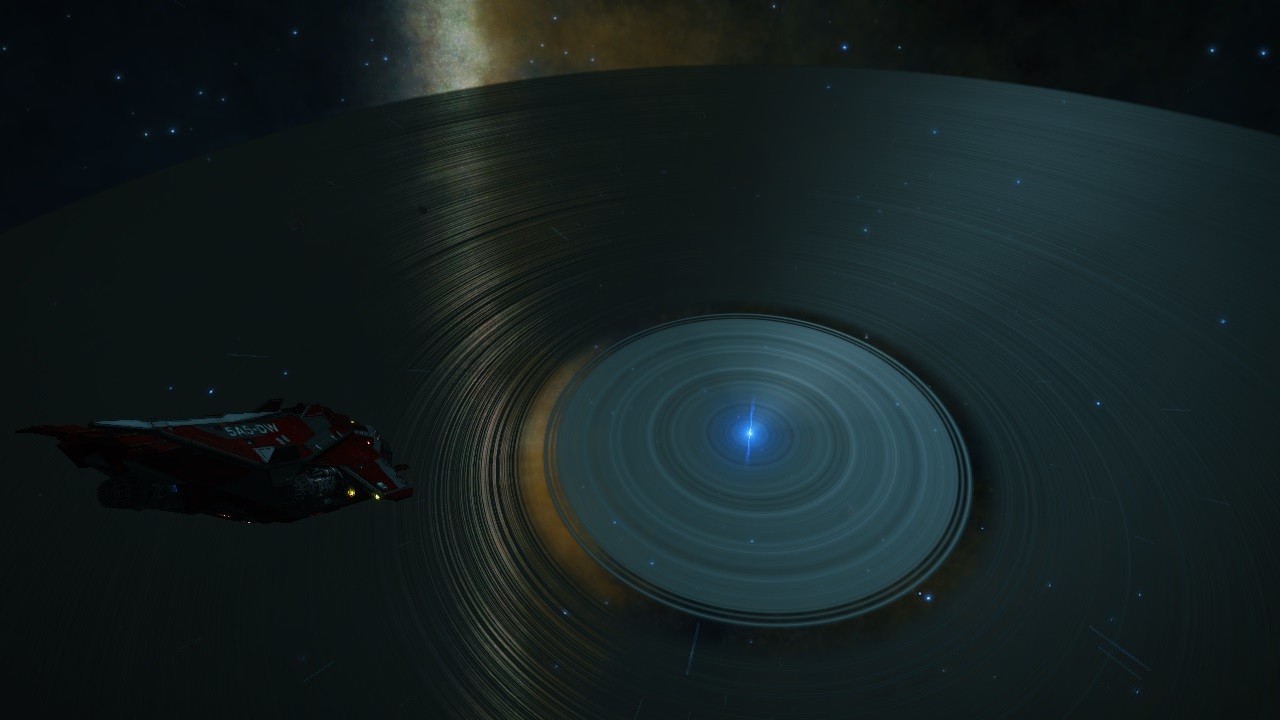
I wanted to fly among the asteroids, but I hesitated when I approached the ring. The incredible power of the neutron star makes the inner ring spin at a tremendous speed. I decided to take the risk and approached slowly holding my breath thinking that I could be crushed at any moment by a superfast travelling asteroid, when the gravity of the ring trapped me too and I found myself right over the asteroids that seemed to be floating gently while spinning around the star.
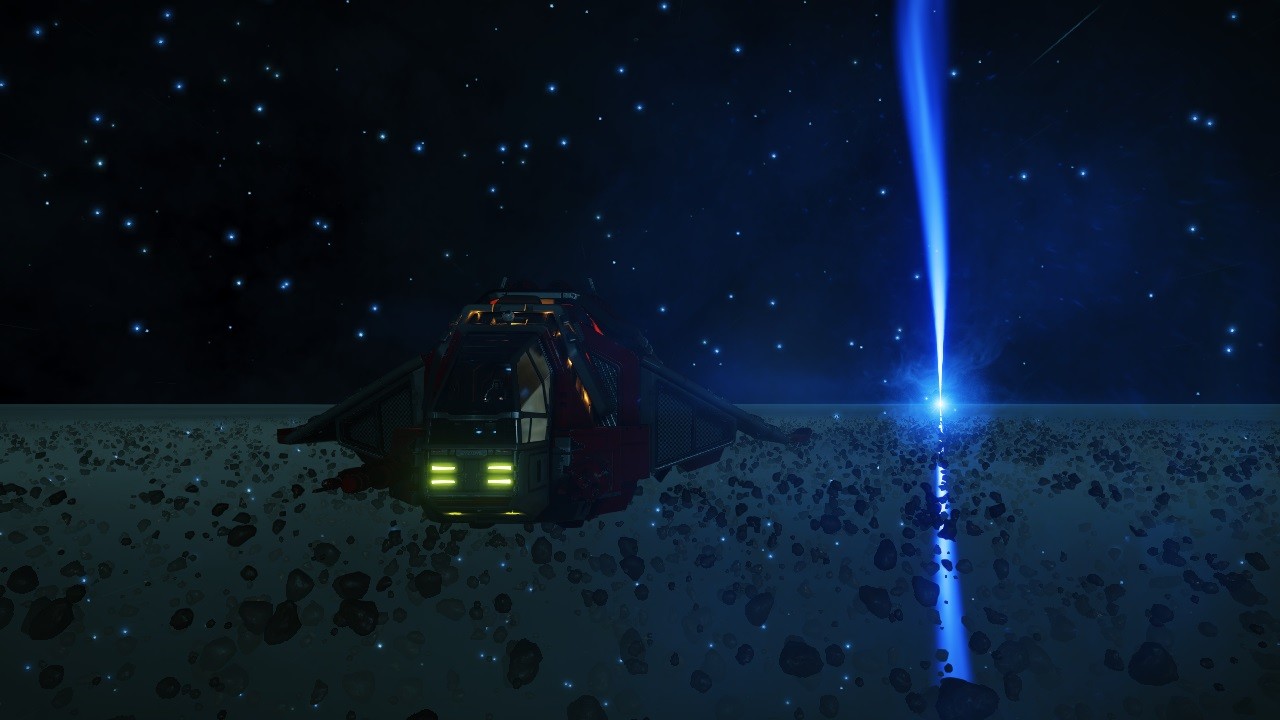
I left The Collection of Wonders and headed for the next stop of the itinerary, system Skaudai AM-B d14-138. On the way, I finished reading in the GalNet News the sad conclusion of Salomé’s story. Despite the efforts of the Children of Raxxla to free her, Salomé was sent to Koontz Asylum in the Daibo system. And, when on route, somehow the prisoner convoy that was carrying her was interdicted and destroyed by unknown forces. No survivors were found. Even the scape pods and the black boxes were blasted. And, like that, Salomé disappeared without a trace. But not for long.
In March 3303, Salomé was identified as one of the perpetrators of a heist of meta-alloys in Darnielle’s Progress base in Maia system. Responding to the news, Imperial authorities promptly placed a galaxy-wide bounty on Salomé to the tune of five hundred thousand credits. After that, she presumably fled the core systems. Many commanders, including imperial pilots, defied the standing kill-on-sight order issued by the Empire and pledge their loyalty to Salomé.
In April 3303, a signal from the Col 70 Sector was detected by listening posts in both Federal and Imperial space. The message was not clear, but it appeared to pertain to some kind of rally point. Meanwhile, Federal and Imperial intelligence services confirmed that thousands of covert and coded messages were recently been transmitted in the vicinity of the Col 70 Sector. Something big was happening there, and the Imperial Intelligence thought that it was connected somehow to Salomé. The bounty on her raised to five million credits, an enormous sum of money for a fugitive. The news mention too two other fugitives that were, presumably working with Salomé: Tsu Annabelle Singh and Raan Corsen.
For the record, I have tried to lock the Col 70 Sector in the nav map and it says that this system is “permit only”. For some reason, the Pilots Federation does not want that any commander flies there.
And we come to the end of this story. It seems that Salomé tried to come back to the Bubble with her allies carrying some kind of secret vital message that she discovered in the Col 70 Sector. Hundreds of bounty hunters tried to shoot her down. Thousands of commanders rallied to protect her. And she found her demise in the Arumclaw system when the notorious commander Besieger obliterated her Imperial Clipper, The Seven Veils.
In the aftermath of these events, Salomé’s companions run away and remain at large today. The fleet gathered to defend her fell into disarray afterwards. The Children of Raxxla had remained very silent since then. And a transmission was detected in the Teorge system, leading to the discovery of a series of logs. The logs, which apparently date from 3275, contain nebulous assertions regarding a scheme from an unidentified super organisation to manipulate the Empire, the Federation and the Alliance.
Well. I guess that is as far as I can go at the moment. I can access in the memory banks of the Hyperion the GalNet News database, the Galactic Mapping Project database and the Codex, but to dig deeper in the GalNet I need to be landed on a station.
I have arrived to system Skaudai AM-B d14-138. The Galactic Mapping Project Database says that there are Guardian ruins here. Guardians! As far as I know, the Guardians were an alien humanoid species that became extinct two million years ago. Their first ancient ruins were discovered in 3302, and many more followed. In 3303, the engineer known as Ram Tah directed a research project that involved many commanders to decipher the data from the ruins, and he discovered many things about the history and the culture of the Guardians. Most of this information is in the Codex now. It also says that the Guardians were at war with the Thargoids at some moment of their history. I need to do more research on this when I am able. I have seen commanders of the expedition flying in hybrid human-guardian fighters. Some of even have performed guardian technology enhancements to their ships with the help of certain individuals called tech brokers. But first things first. Let’s scan this system and see what is on it.
The first thing I find is a notable stellar phenomena signal, so there I head. The system has a lot of bodies. In the rings of one of the gas giants I find a collection of purpureum and rubeum metallic crystals.
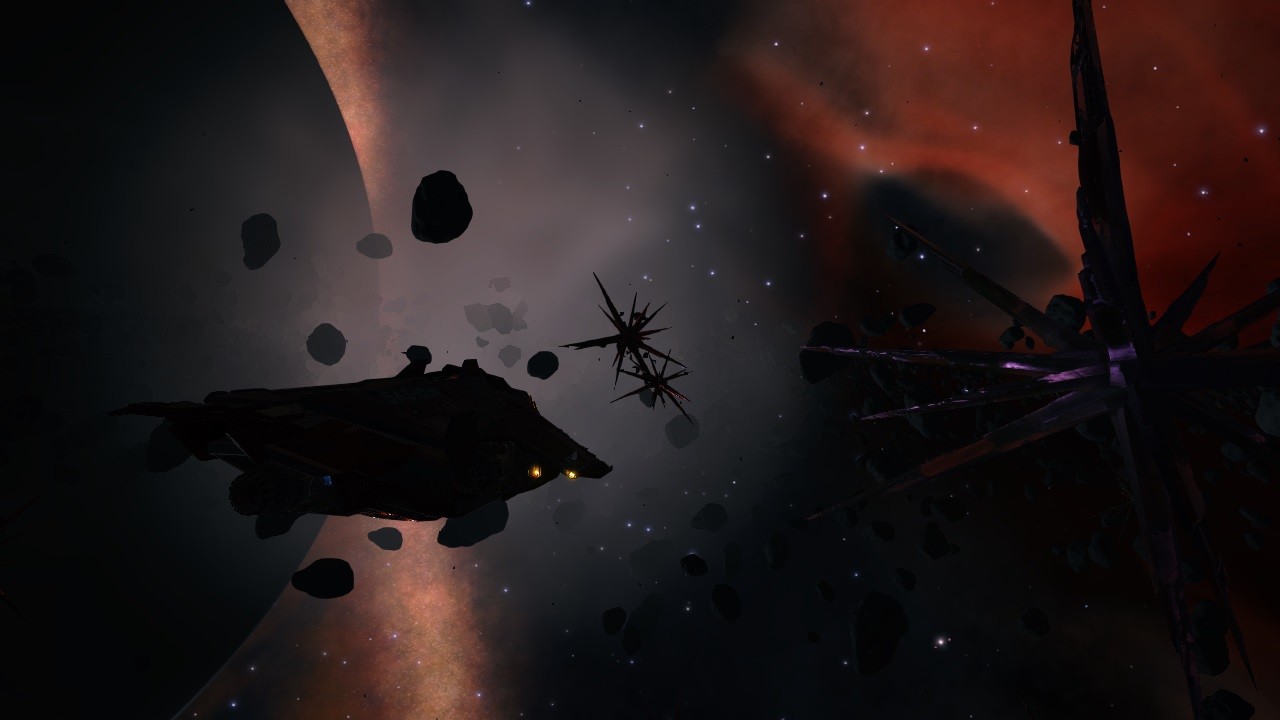
Skaudai AM-B d14-138 AB 7, the moon with the Guardian ruins is very close. It is a tiny planetoid with just two thousand kilometers radius, but after mapping it I see that there are three different complexes of ruins on the surface. I choose one and land the Hyperion there. Other commanders of the expedition are wandering around too. The place is crowded with some kind of obelisk fields. Some of them can be scanned for data. There are also some kind of monoliths that emerge out of earth when I approach them. It seems that they keep some kind of artifact on top that casts a blue light.
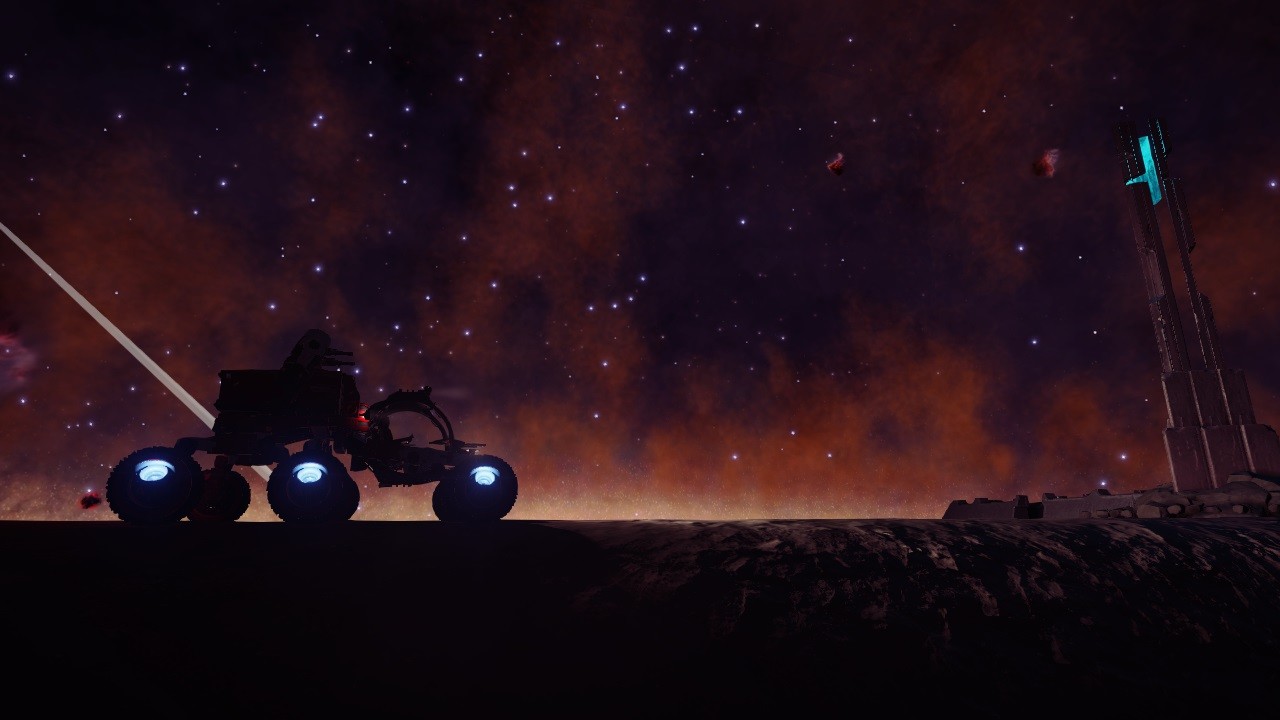
I fly to the second ruins and observe that they are very close to a third complex of ruins. Upon arrival, I meet Commander Douchy. He approaches and greet me with his scarab. He tells me that he flies a Krait MKII called Elisabeth Bathory that has been improved with Guardian Technology to increase its jump range and gives me some clues about how to do it. I take mental note to try that once I came back to the Bubble.

Before leaving, Douchy and I exchange the data of our ships beacons in case we want to meet again during the expedition.
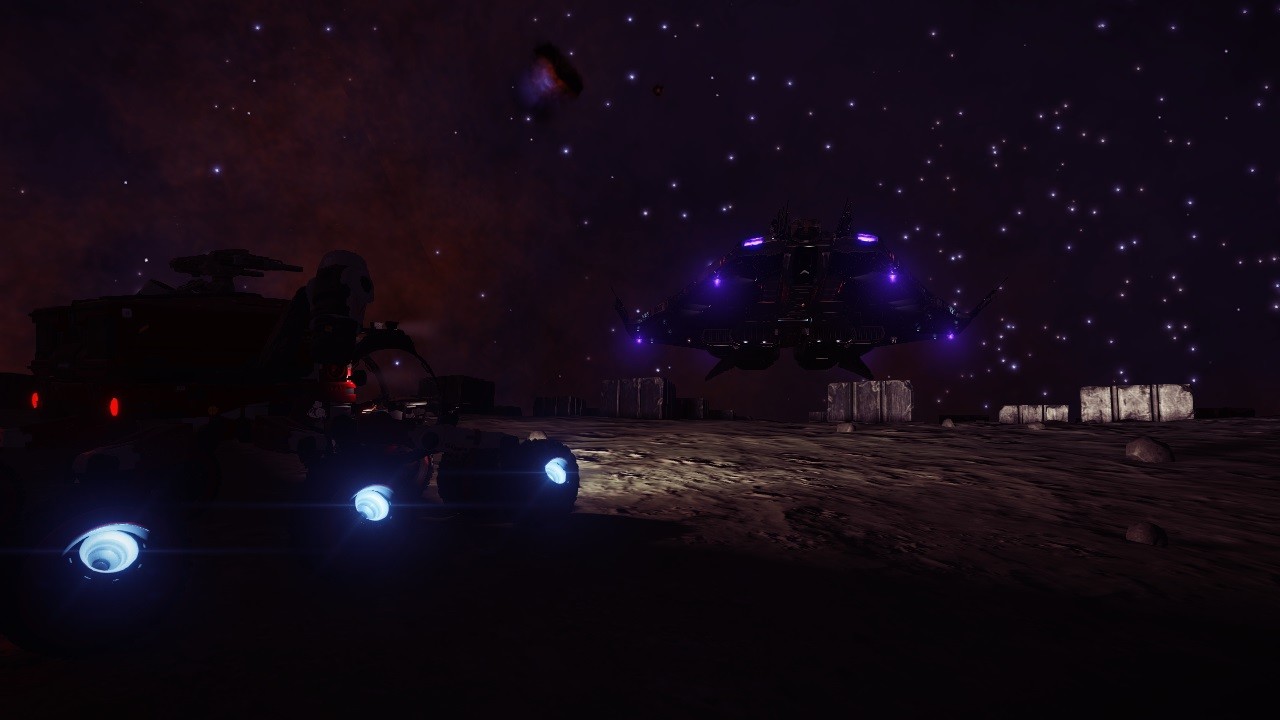
I scan the active obelisks I find and head for the last location. I want to gather all the information I can from these obelisks. It seems that religious orders took over the Guardian’s society and exiled a group of them. These ruins, so far from other Guardian sites, are speculated to be final resting place of those exiles.
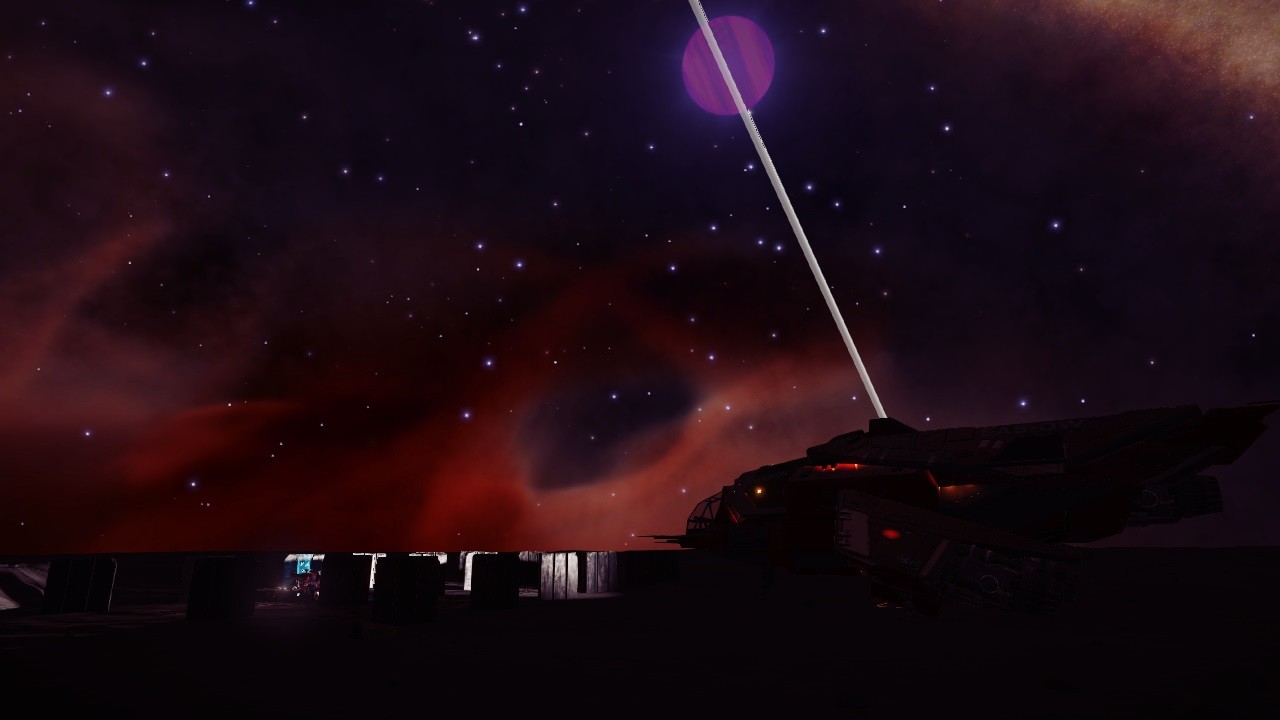
Sacaqawea Space Port is very close, in the nearby Skaudai CH-B d14-34 system. The place is part of the Colonia Connection Highway and, according to the Galactic Mapping Project database, it is named after 'Sacagawea' of old Earth. She was a Lemhi Shoshone woman who helped the Lewis and Clark Expedition achieve each of its chartered mission objectives exploring the Louisiana Purchase. With the expedition, between 1804 and 1806 (old Earth years), Sacaqawea travelled thousands of miles from North Dakota to the Pacific Ocean, established cultural contacts with the Native American populations, and researched natural history.
I land the Hyperion, ask the deck crews to check the ship and head for the nearest canteen.
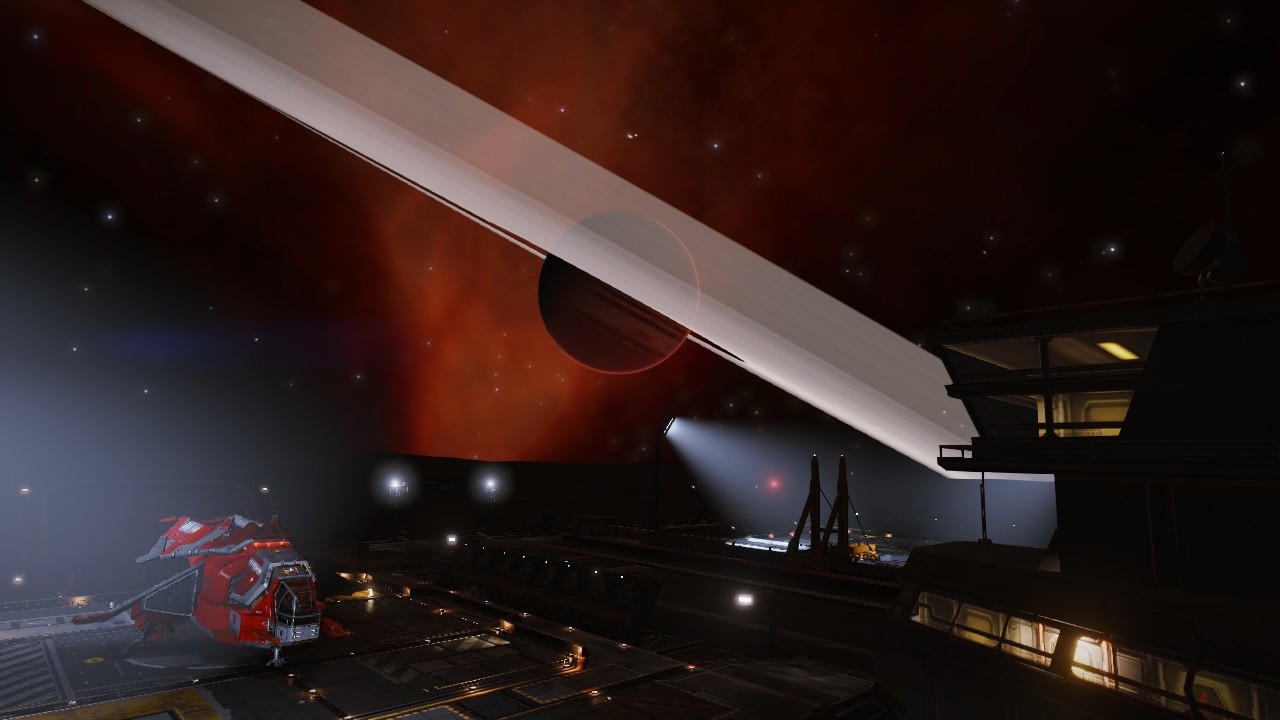
I got up in one rented room in Sacaqawea Space Port with a little bit of hangover. First thing I did was going to the Universal Cartographics office to deliver my exploration data. It was worth more than ninety two million credits. They informed too that I had been awarded the rank of Elite in exploration by the Pilots Federation. That sobered me up. I am Elite now! That means I can access to Shinrarta Dezhra. Amazing! It seems that I also earned some kind of silver award for my efforts in the field of exploration, but I could not collect it there. I could not believe it. All this money and renown opens a new world of possibilities for me. Exulting, I departed Sacaqawea Space Port to continue with the expedition but, before that, I searched in the GalNet through the base looking for more information about Salomé and the Children of Raxxla and downloaded everything I found, that was not much, into the Hyperion’s memory banks. I wanted to continue digging in the mystery of the Conflux Delta Site and its connection with Children and Salomé.
My next stop was the Hammer Nebula. According to the Galactic Mapping Project database, the Hammer Nebula sits in the Peae Ain area, one thousand light years above the path between The Bubble and Colonia. It has a T-shaped pattern of purples, blues and blacks, and contains a plethora of stars, most main sequence and capable of refueling. The glowing purples and blues of the nebula serve as a stark contrast to the darker gases that give the nebula its hammer like appearance, from a certain point of view.
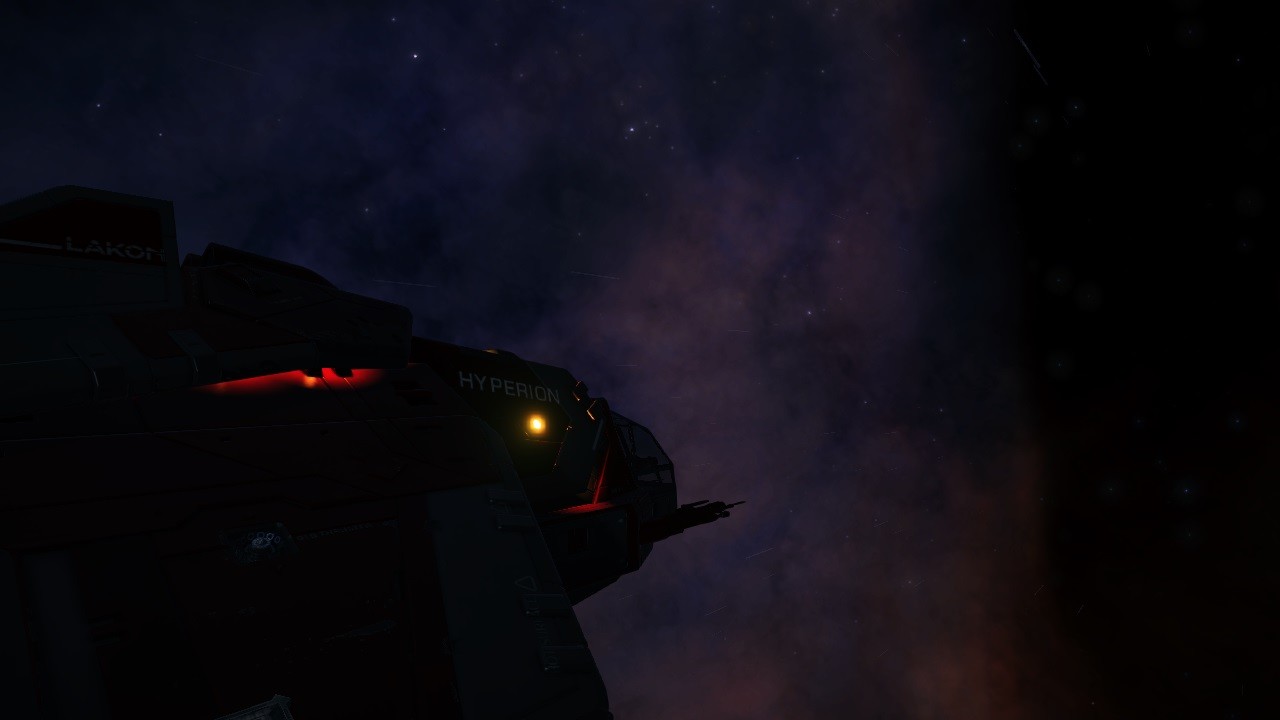
From there, there was quite a trip to system Eodgorph PI-T e3-21 and the Spear Thistle Nebula. I tried to use that time to dig more in the mystery surrounding the Children of Raxxla and the death of Salomé, but the information I found in the GalNet when landed on Sacaqawea Space Port is very confusing. I have read that the INRA’s mission to defeat the Thargoids using the mycoid virus and the Dinasty Project may be connected. I remember reading about the scandal when the INRA’s outposts were discovered. And then, we had the terrorist attacks of the League of Reparation, murdering dozens of people that were descendants of the INRA operatives. How can they be linked? Some people claim that the Children of Raxxla are just a group of independent pilots fighting for freedom and peace, that their only mission is to discover the mysteries of the galaxy and expose them for the benefit of all citizens. Many calls them terrorists. And some go even further and accuse them of being Thargoid lovers. The same happens with Salomé. She is considered a saint in some circles, a martyr that died for a greater cause, and some others call her a warmonger terrorist that only wanted to destabilize the galaxy. And there is vast unprecise information about conspiracies and cabal groups that may be manipulating the Federation, the Empire and the Alliance. And there are the aliens too. The Thargoids are invading The Bubble and recently we discovered the Guardian ruins too. There is a faction called the Cannon Research Group that is providing tons of information regarding the Thargoids and the Guardians. Most of it has been added to the Codex. I am afraid that is too much to handle for me. I do not know what to believe. I need to focus in what I know or what I have seen.
I have jumped into a very interesting system. Preae Ain AB-W d2-197 contains seventeen ringed bodies. One of them is a terraformable waterworld. It is halfway to Colonia and the Bubble, and very near to Sacaqawea Space Port, so I guess it could be an attractive place for a mining colony in the future.

I have arrived to the system Eodgorph PI-T e3-21 in the Spear Thistle Nebula. According to the Galactic Mapping Project database, this purple planetary nebula is centred on a black hole. The low mass of the black hole makes it possible to experience lensing effects while travelling under normal propulsion. Combined with the bluish-purple background and the view towards the nearby Octopus Nebula this makes for quite a scenery. I drop out of supercruise and see how the black hole distorts the light reflected by the nearby stars and the Octopus Nebula.
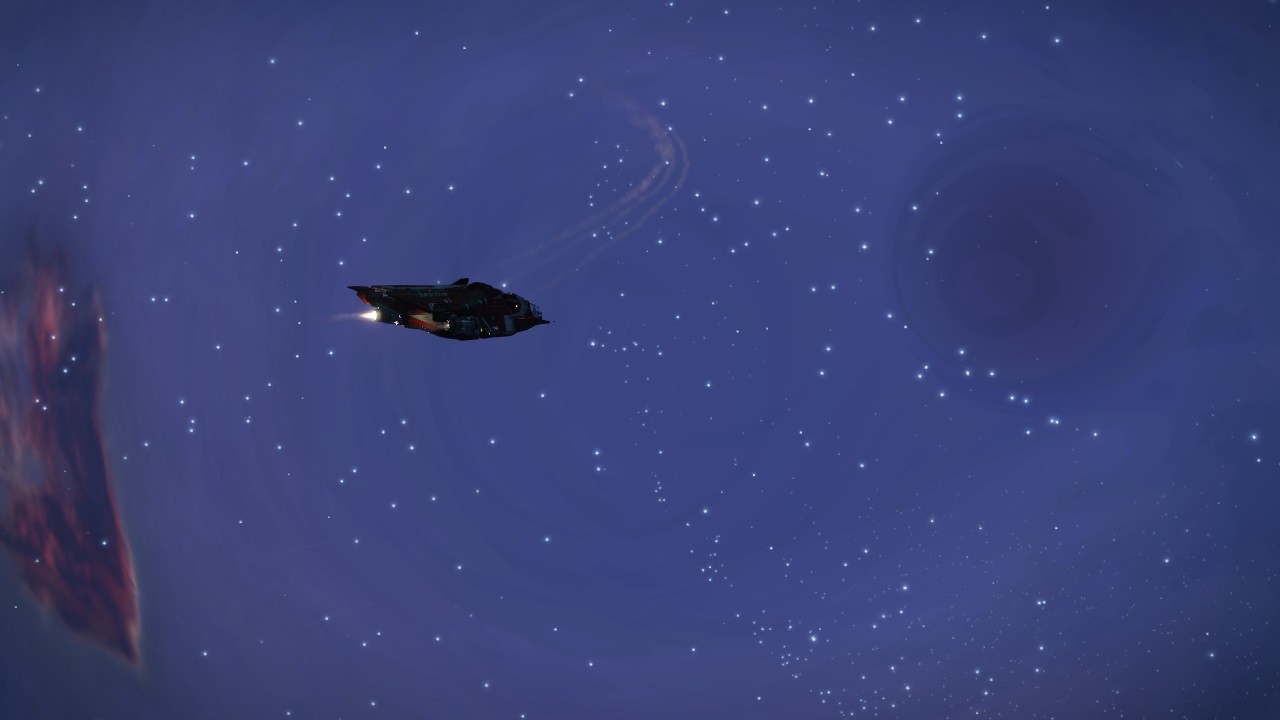
I am on route now to the system Prua Phoe TK-M d8-36 in the Octopus Nebula, trying to recap what I have learn from all this digging in the old news records. I think that is clear that there is a connection between Salomé and the Distant Worlds original expedition. Salomé was the former leader of the Children of Raxxla. The Conflux Delta Site and the other sites linked to the Dinasty Project were discovered thanks to the efforts of hundreds of independent pilots that rallied to the call of the Children of Raxxla and Salomé. Based in all this, I think that there may be a connection between our mysterious leaders, commanders Erimus Kamzel and Dr. Kaii, with the Children of Raxxla. And furthermore, based on everything I have been reading, I think that I have been making the wrong questions, that the most important questions would be: Who ordered the Dinasty Project mission? What is the connection of the Dinasty Project with the unknown artefact and the Thargoids? Was the secret Salomé was trying to disclose when she was killed related to the Dinasty Project? What there is in the Col 70 Sector system? And did Salomé know who ordered the Dinasty Project?
I need to reflect on all this and decide what to do next. I have arrived to the Octopus Nebula. According to the Galactic Mapping Project database, this Red and White nebula is best characterized by its tendril like hydrogen clouds, which wrap themselves like tentacles around a large white core. It's location between Colonia and The Bubble makes for a great roadside pit stop as the main sequence stars here are plentiful. I need to sleep for a couple of hours before continuing. I do not land on this occasion. I just walk using the mag boots to my bunk and lay on there, floating on zero gravity.
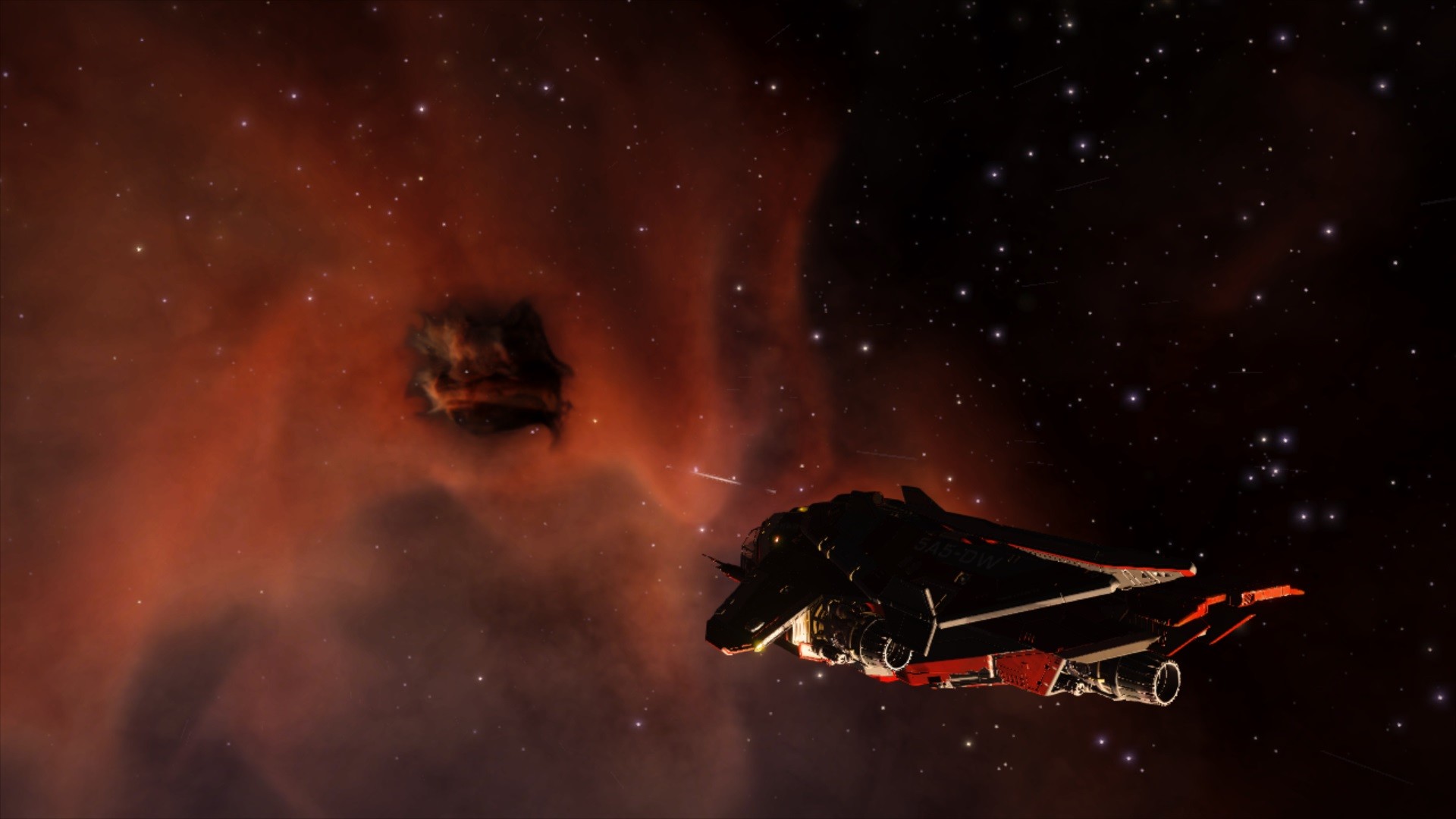
The time for the big decisions has come. I am on route to system Clooku EW-Y C3-197, near the Llyn Tegid Nebula, where the base camp of the fleet is, and I feel tempted to abandon the expedition and head back to the Bubble. On one hand, my first motivation to come on this trip was to achieve the rank of Elite in exploration and thus gain access to Shinrarta Dezhra and Lori Jameson, and that I have already. Furthermore, now I have the resources to invest in a bigger and more able ship and resume the quest to know what happened to my father. I have access now too to Selene Jean, which means that I am one less step to meet Bill Turner and, maybe, discover why professor Palin warned me about him. On the other hand, this expedition is fulfilling my dreams of exploring the galaxy. I guess it comes from family. My father was an explorer before his disappearance in the Merope system years ago. And any time I discover something new, unique or strange on this expedition I experience a feeling of proud that is becoming quit addictive. I guess I will decide when I arrive to the fleet campsite.
I think I will be late for the release of the next waypoint. I am very near to the Clooku EW-Y C3-197 sytem, but I have found a system, Prua Phoe AC-J d10-1586, with two water giants, and I have never seen one of those, so a closer look is mandatory. The evaporated ice of the thick atmosphere creates incredible huge whirlwind storms. The planet has more than one hundred thirty six Earth masses and a gravity of near nine times Earth’s.
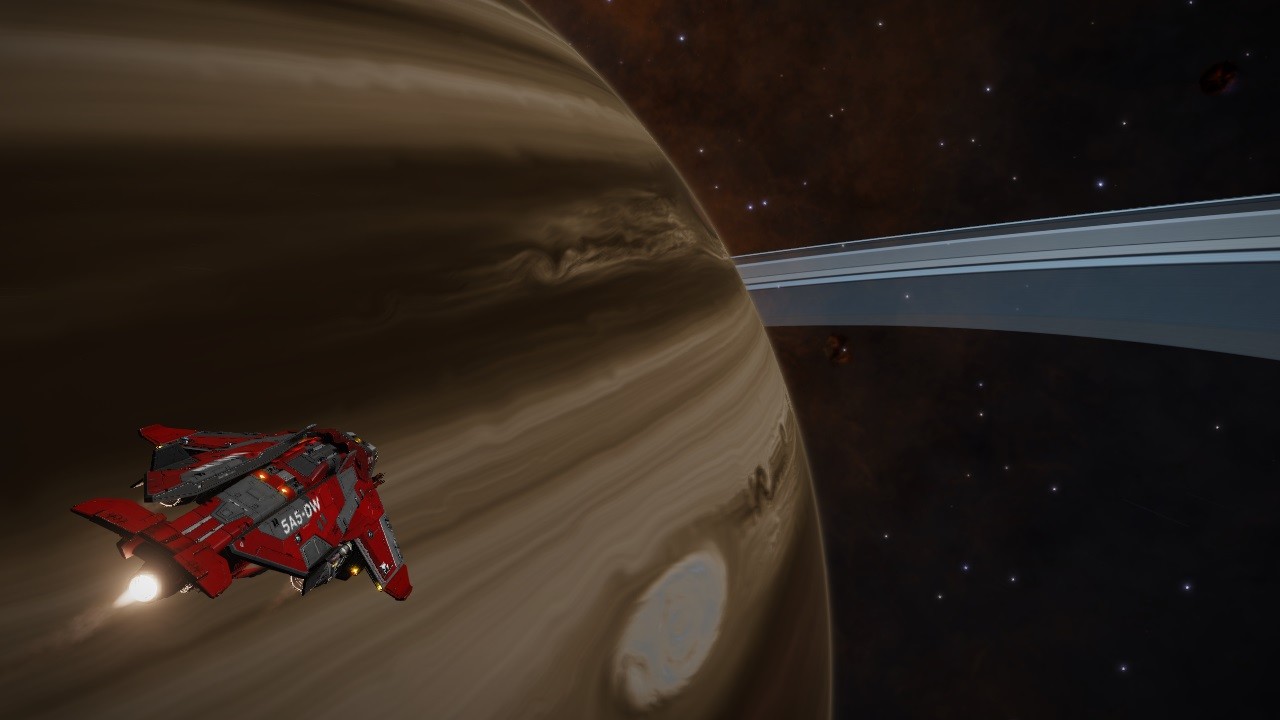
I made it finally to the fleet camp site in the Llyn Tegid Nebula. According to the Galactic Mapping Project database, it is a wondrous blue planetary nebula that is illuminated by a neutron star and a class F Star in combination. It was named after Llyn Tegid, the original Welsh name for Lake Bala in Wales, a place rich in folklore and legends. When I arrived, the next waypoint had recently been released, and I can see many commanders gathering to start the next stage of the expedition. I think I will find no one landed at the basecamp. It seems that Distant Worlds 2 is heading to Polo Harbour, very close to Colonia.
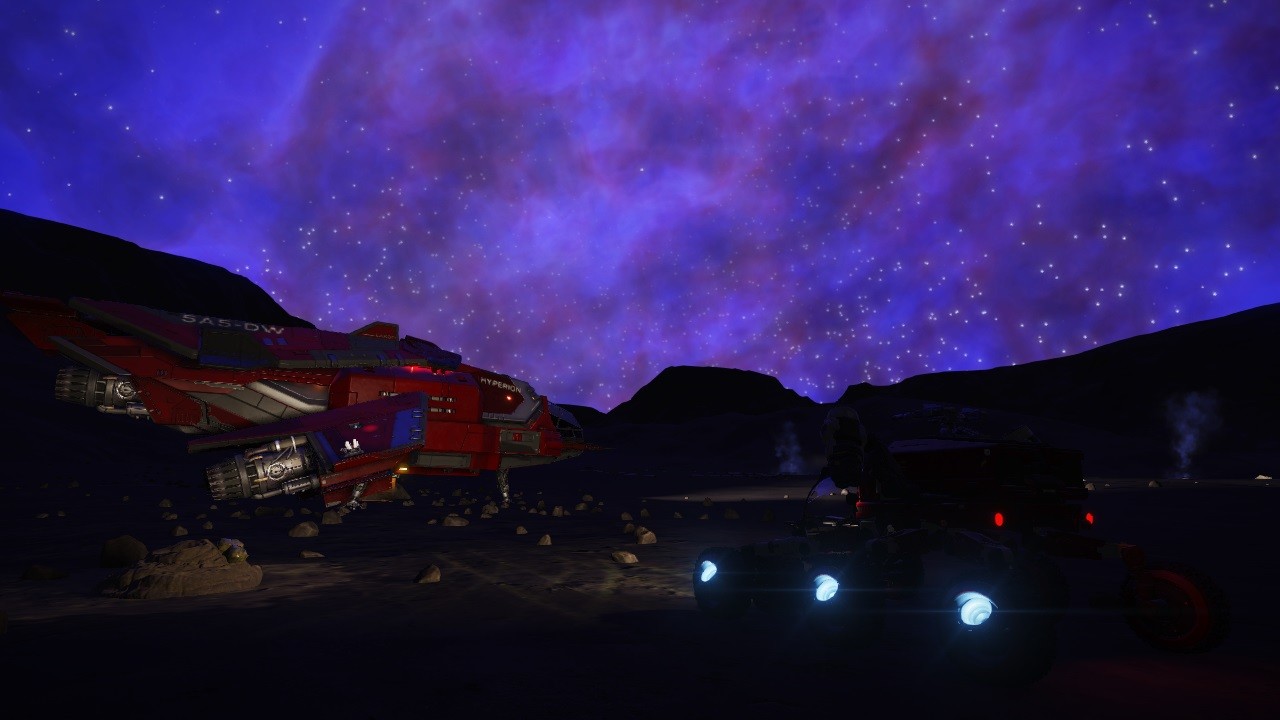
This is commander Jav Marlo, registering this log onboard the Hyperion, landed in Shepard Shallows, basecamp of the Distant Worlds 2 expedition in the Llyn Tegid Nebula. I have decided to go on with this trip. I feel that I am becoming a better pilot and explorer by the days. It has been just four months since I qualified to be a Commander of the Pilots Federation, and I thought then that my life would consist on transporting cargo from one remote outpost to another. Who would have imagined all the adventures I have lived since that moment? And Distant Worlds 2 expedition is the biggest adventure of all. I am determined to go till the end. Who knows what can I discover on the way? I have promised myself that I will go back to the Bubble and finish what I started. I will discover what happened to my father. But I am an explorer now. A true one. I have become part of the Elite of exploration. It is my duty to unfold the mysteries of the galaxy, and there are so many of them. I have received the call of the black. And I am going to follow it.
Jav Marlo signing out.